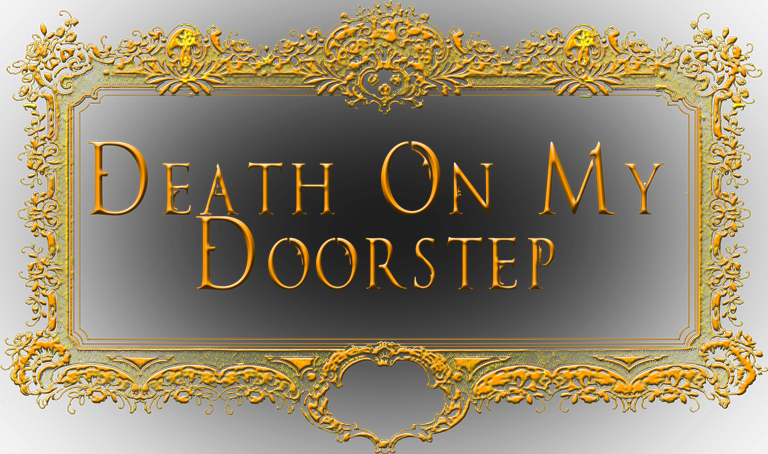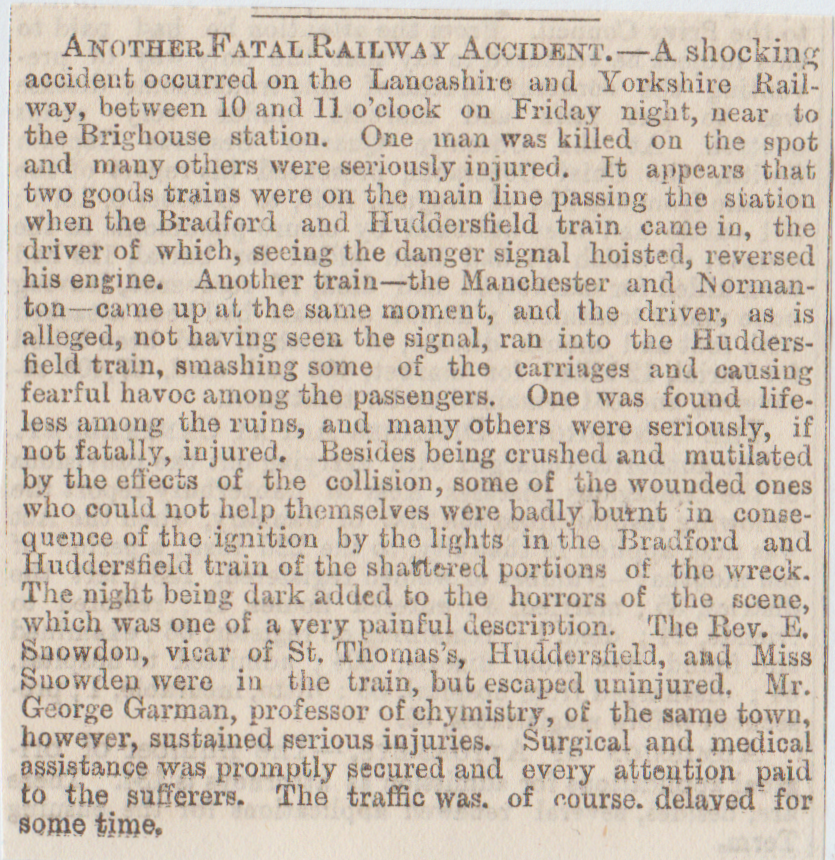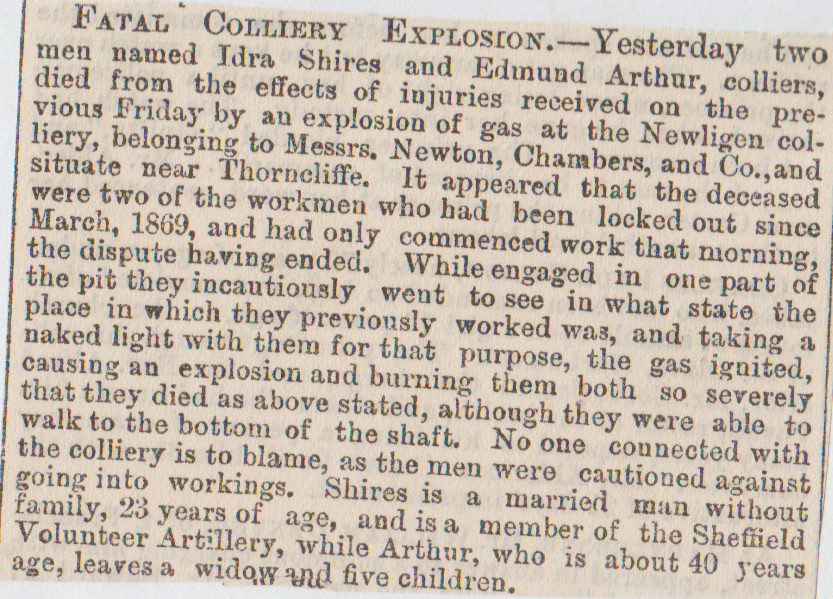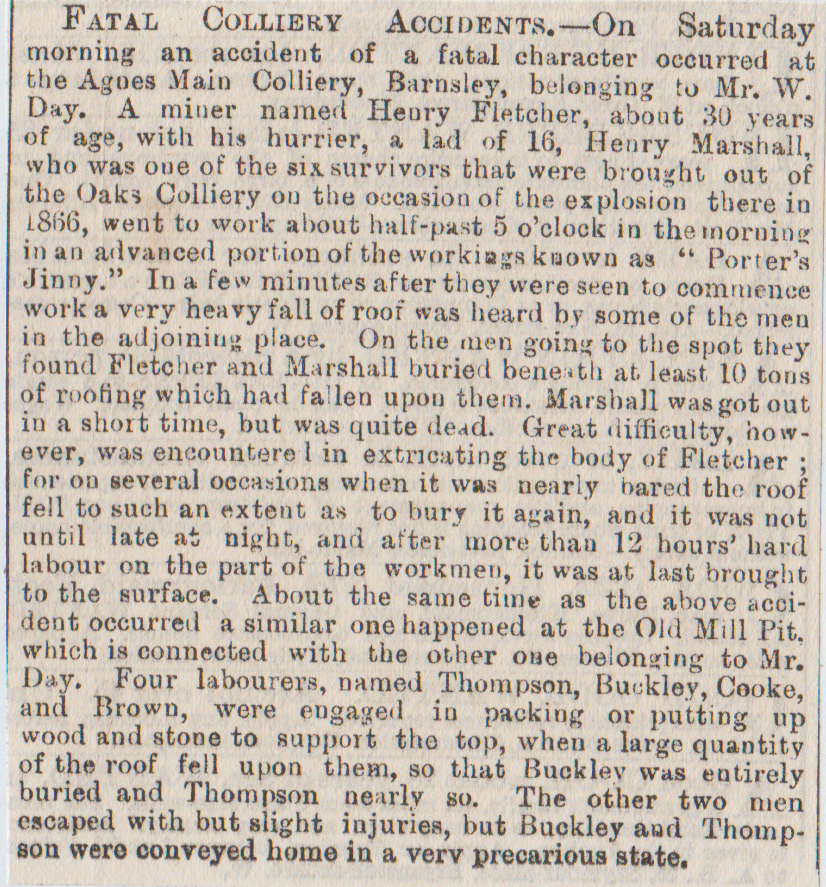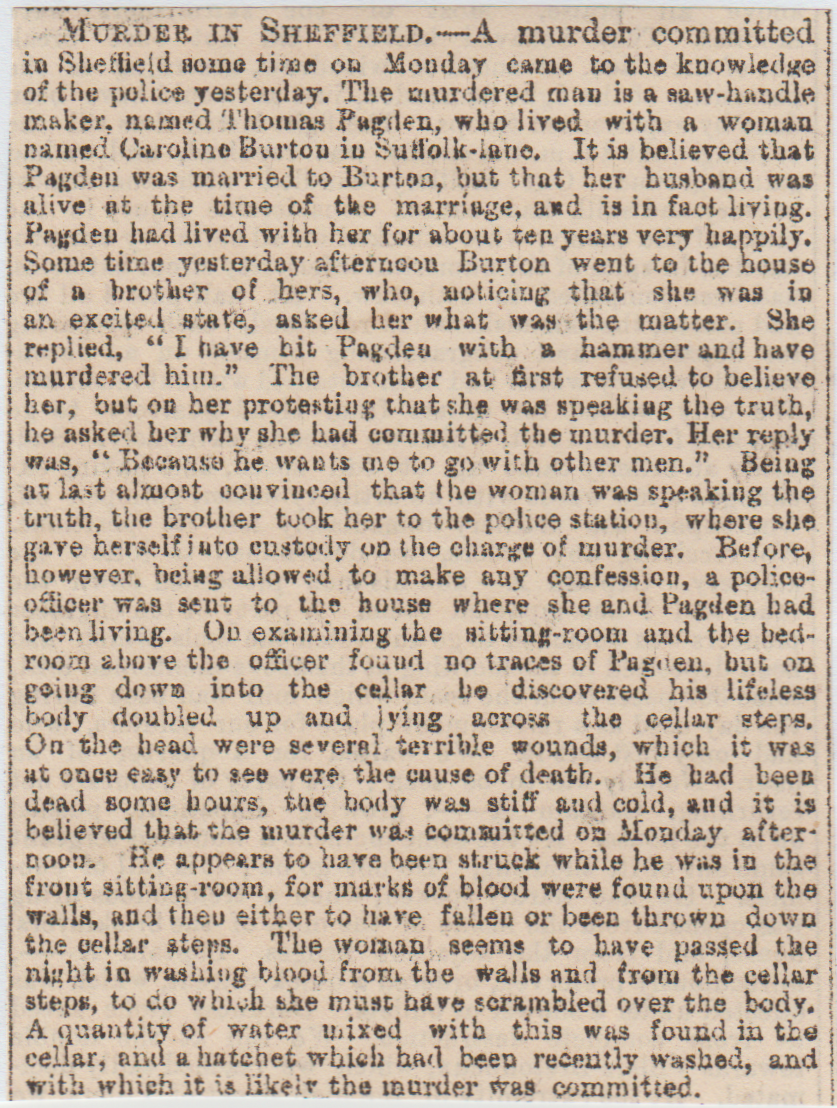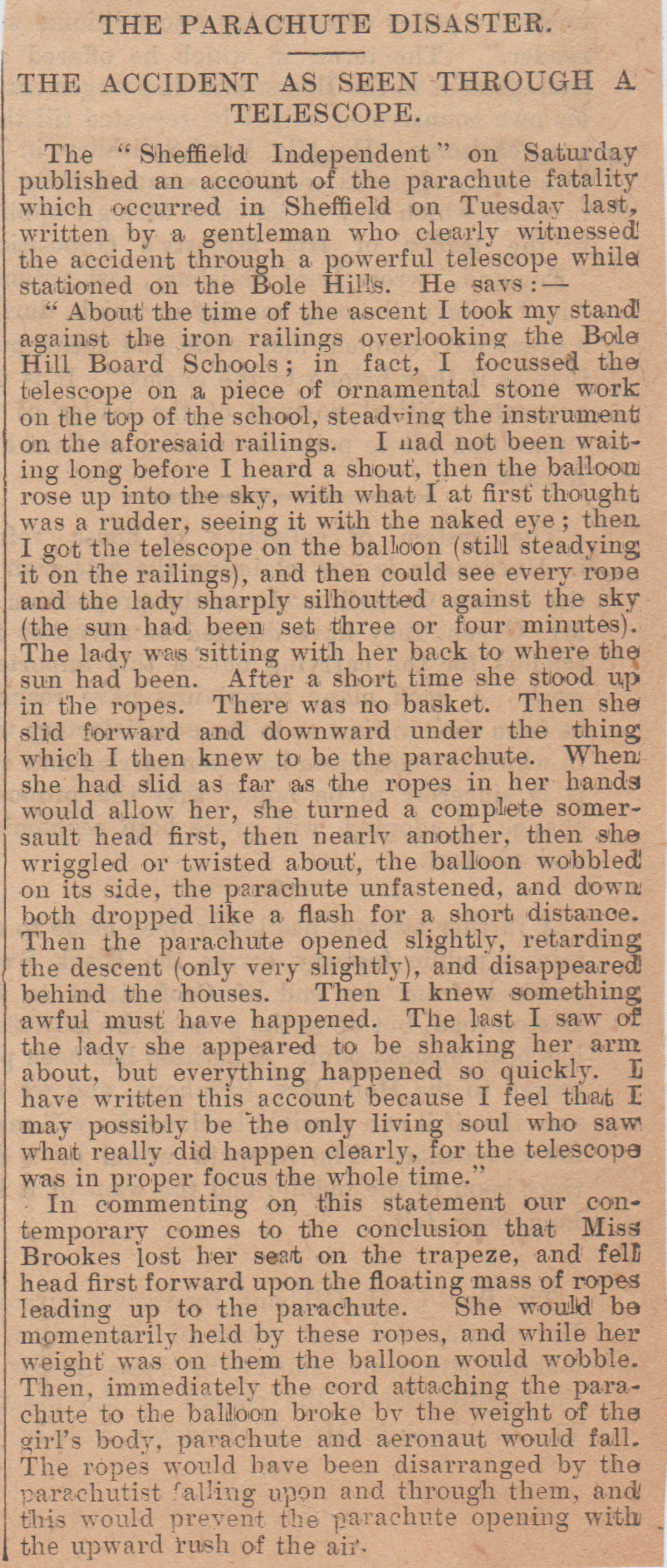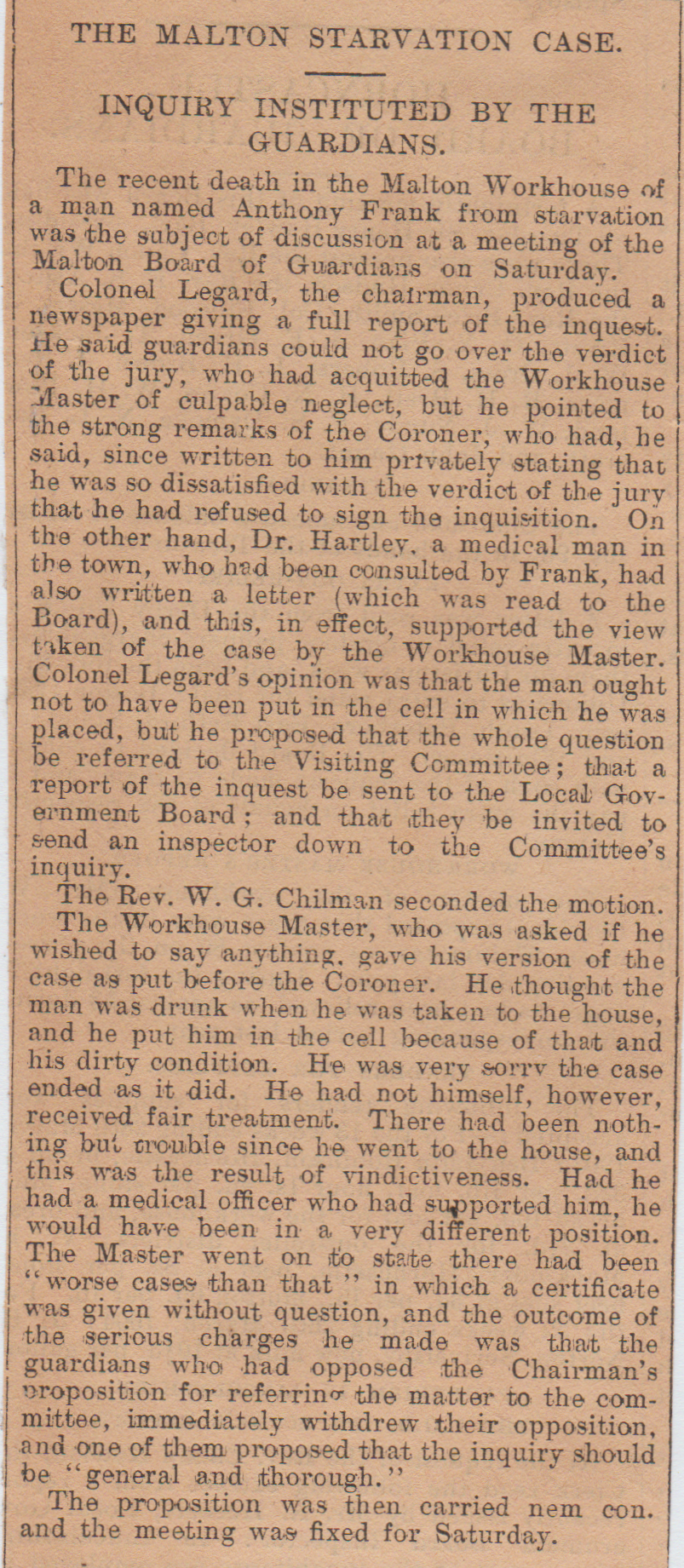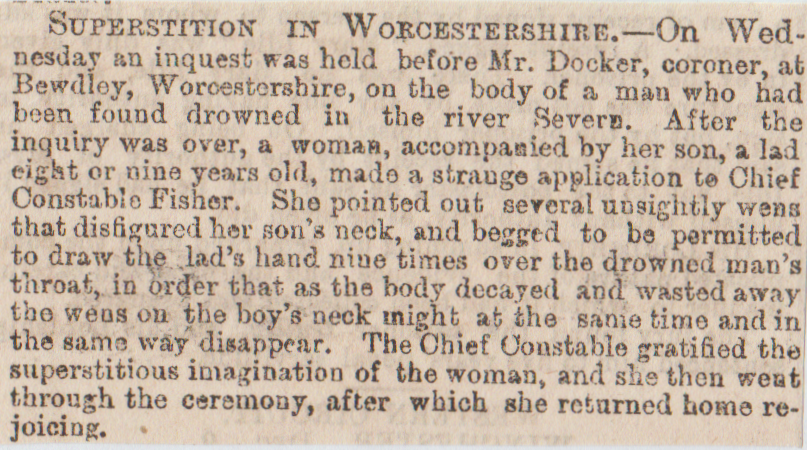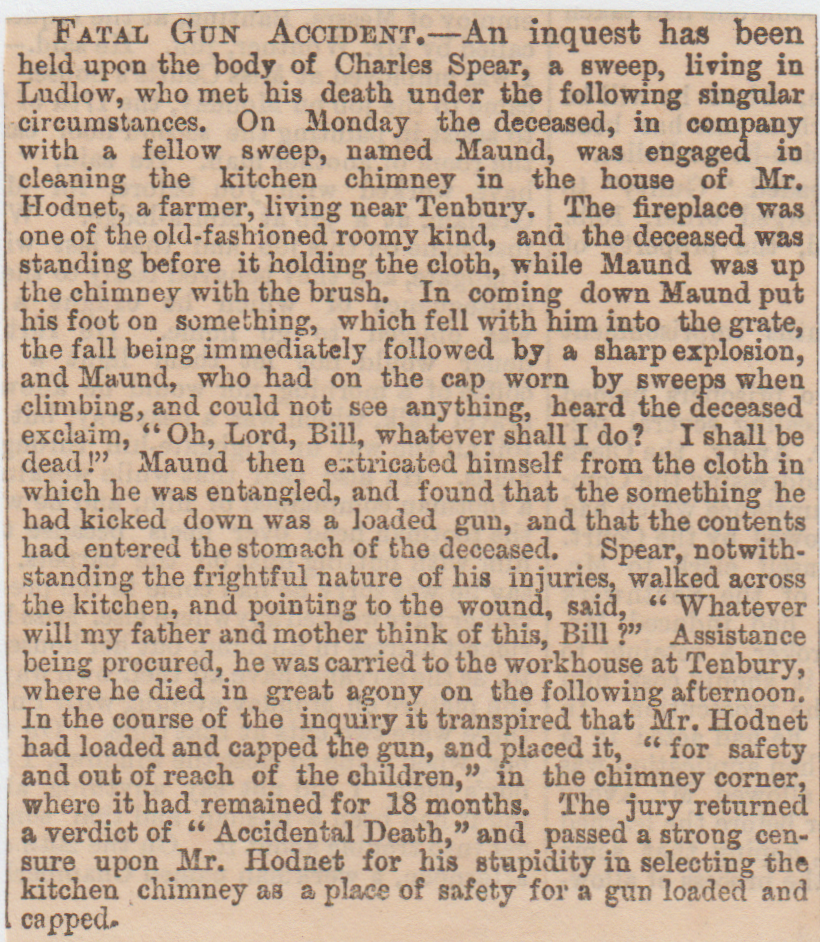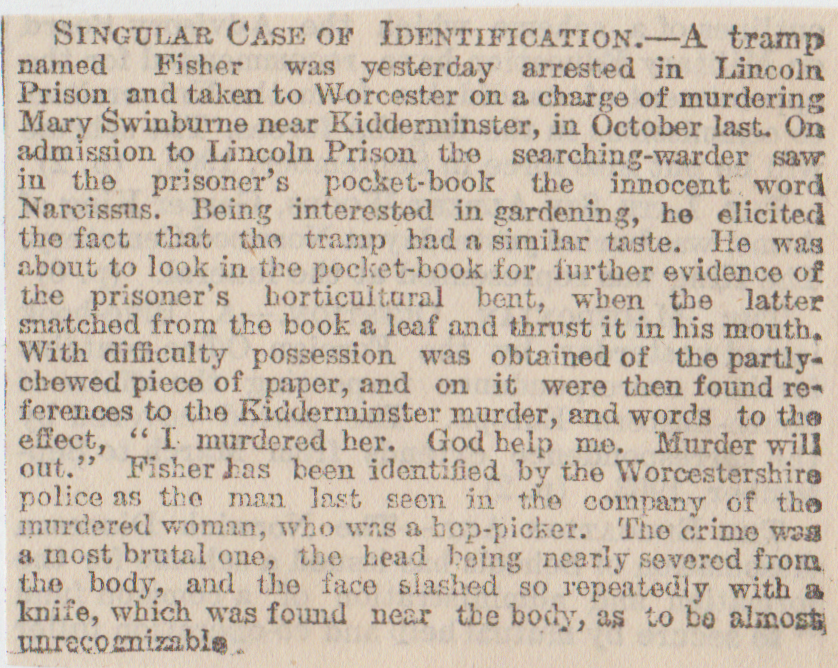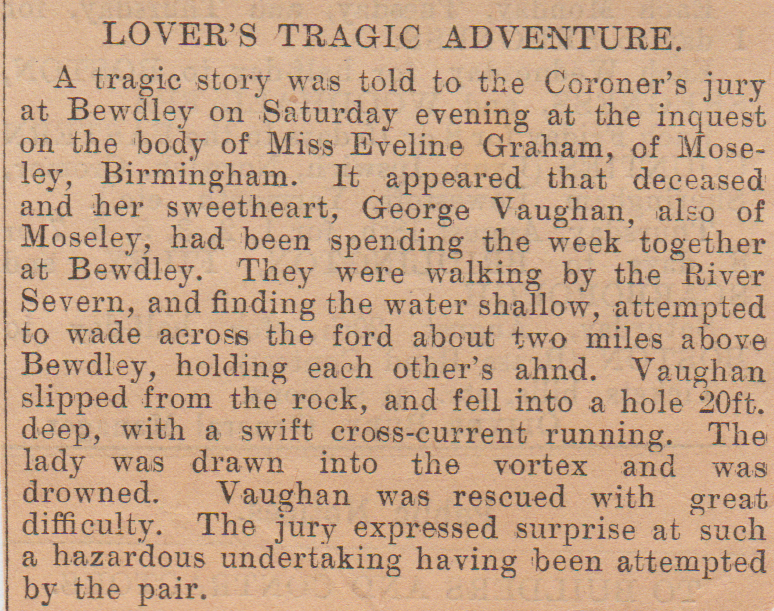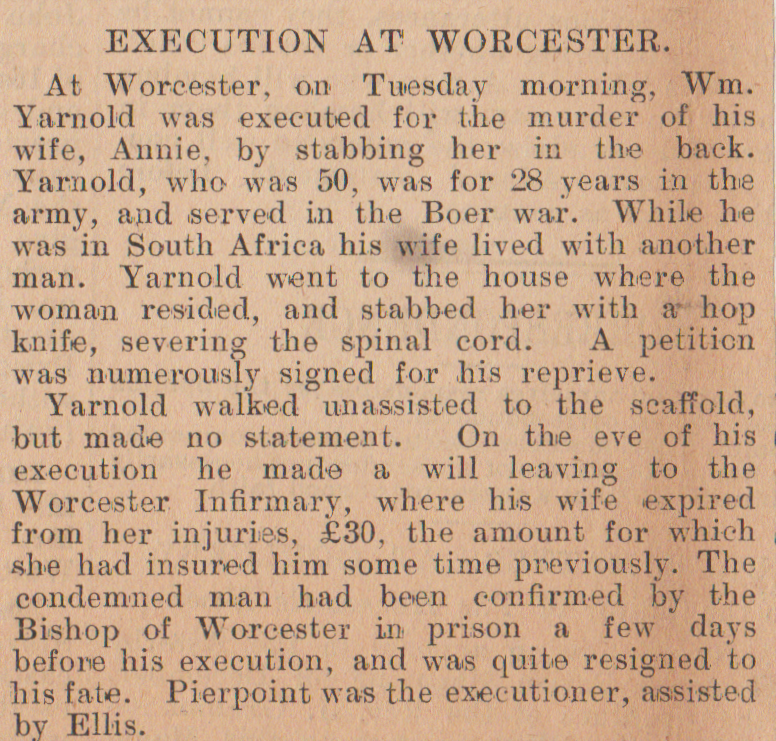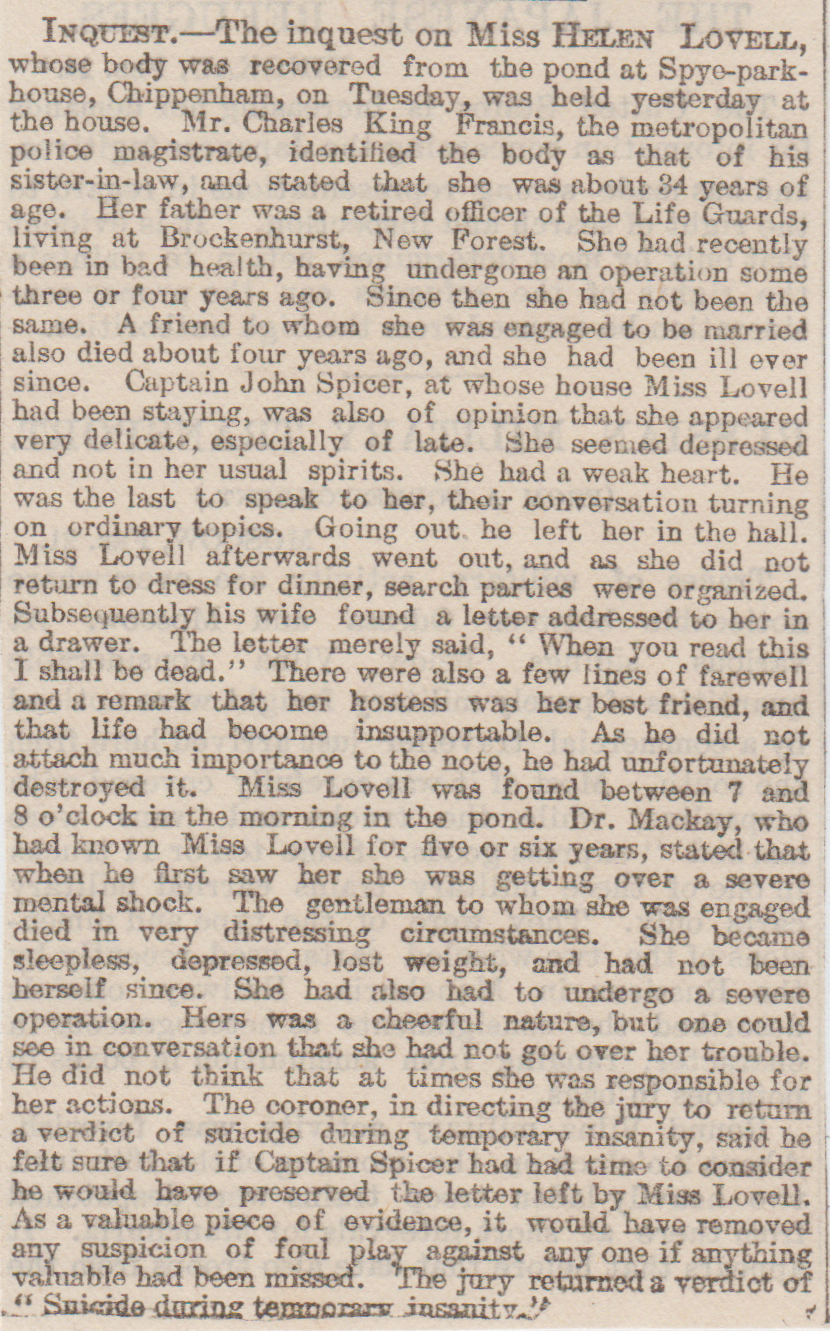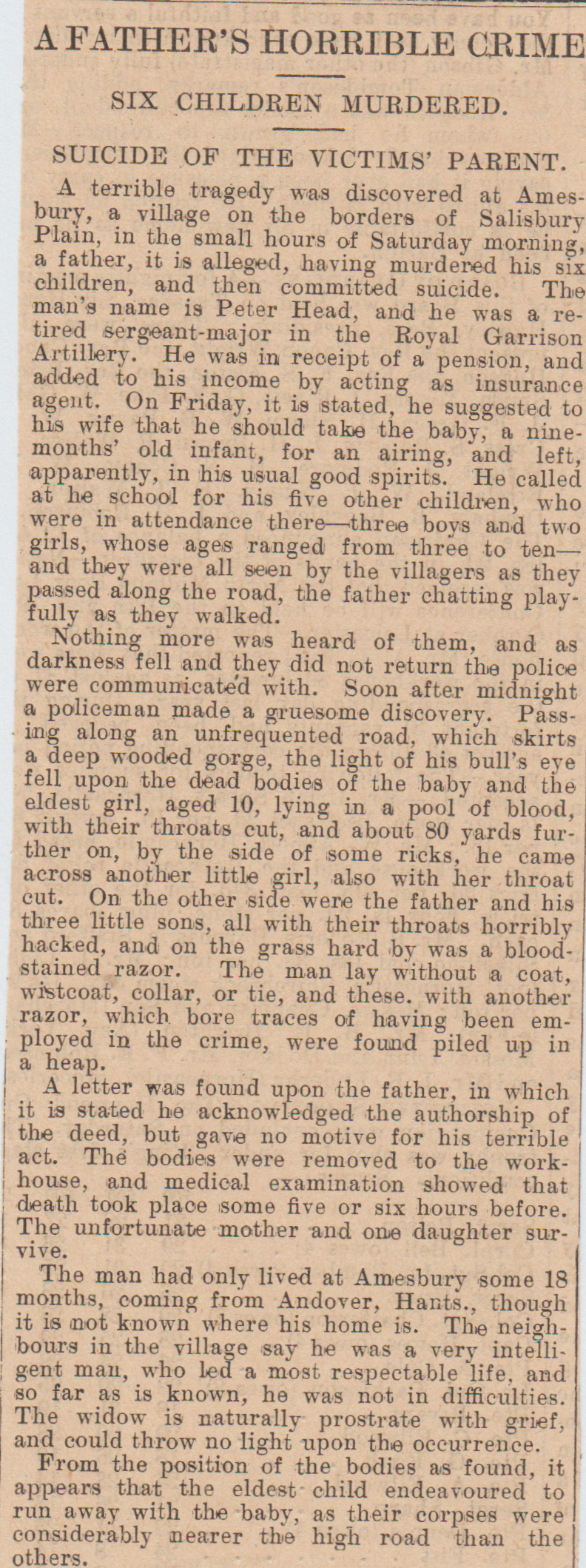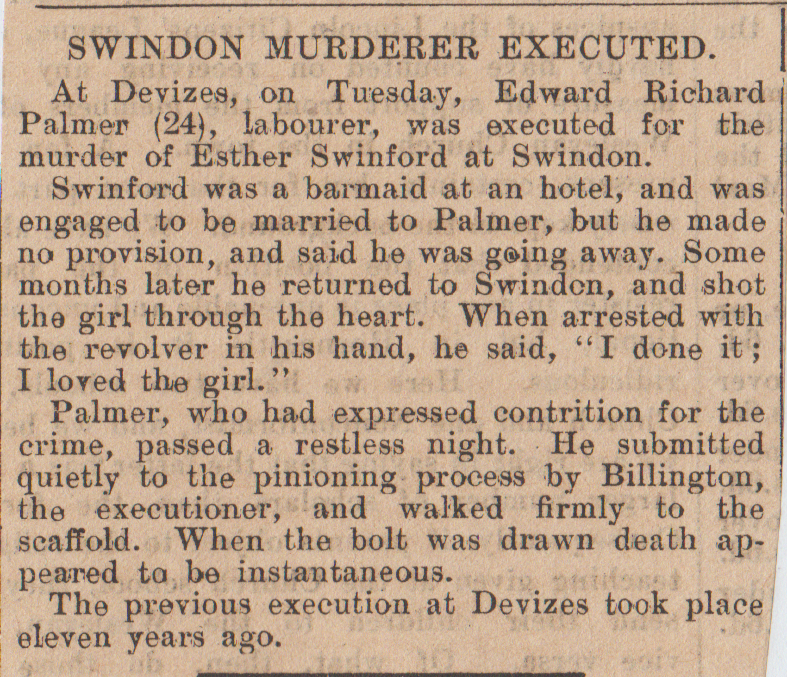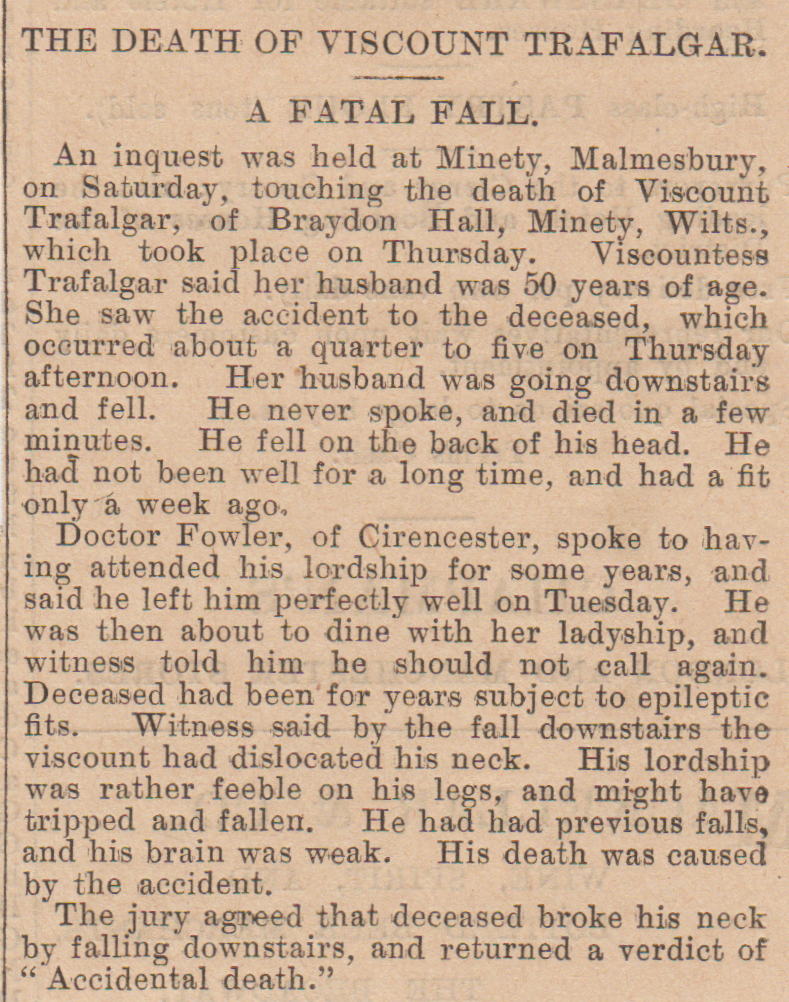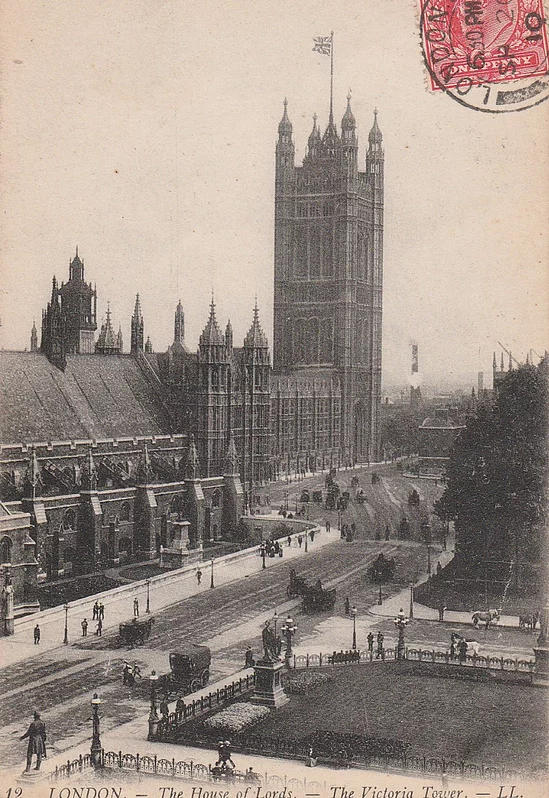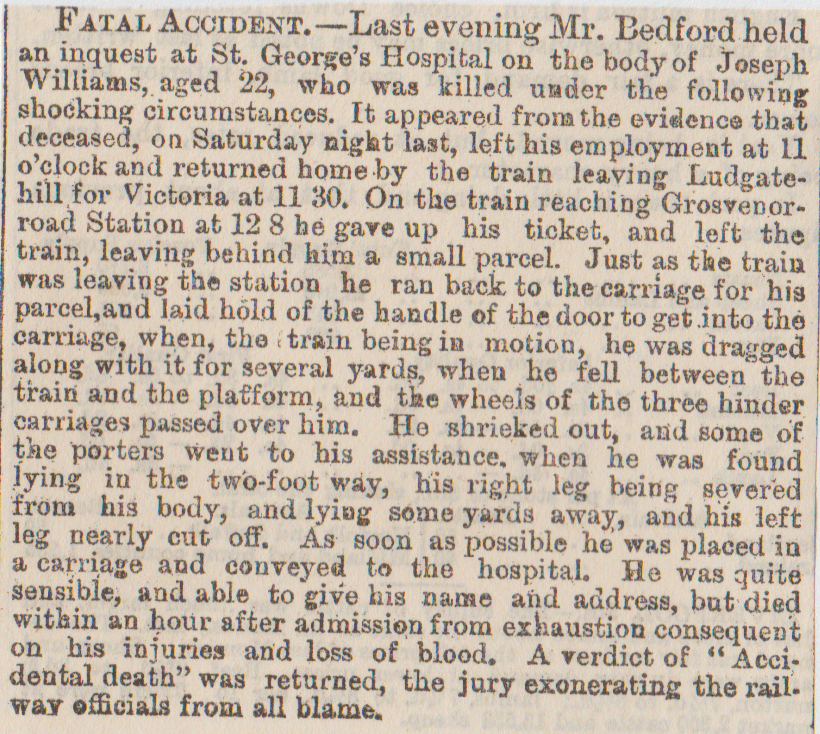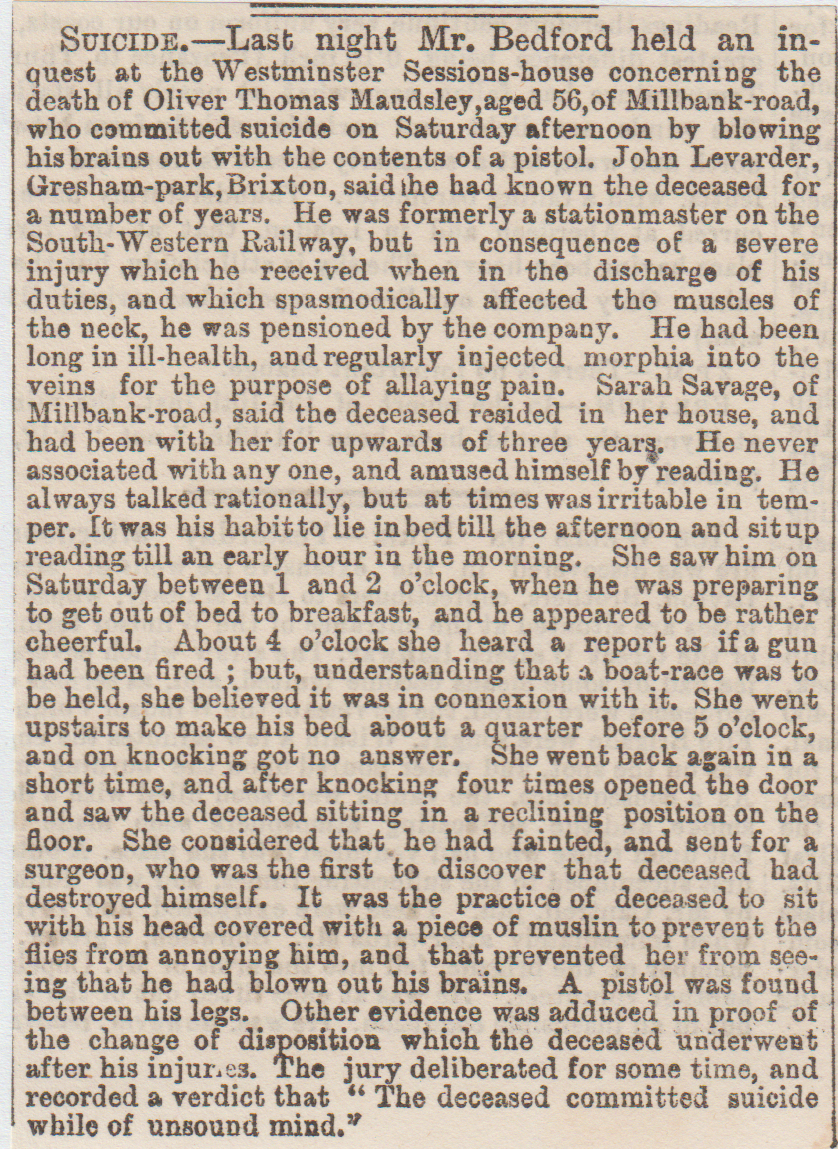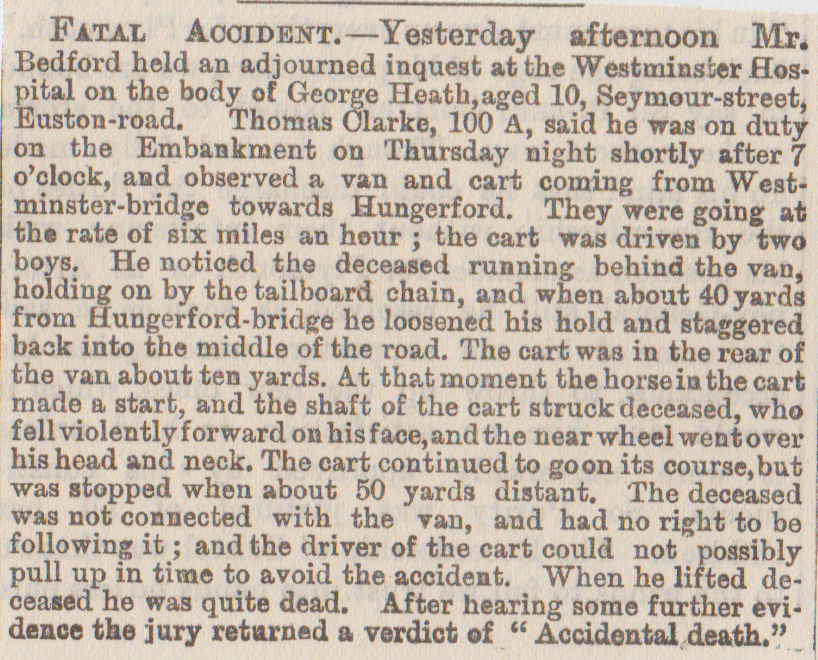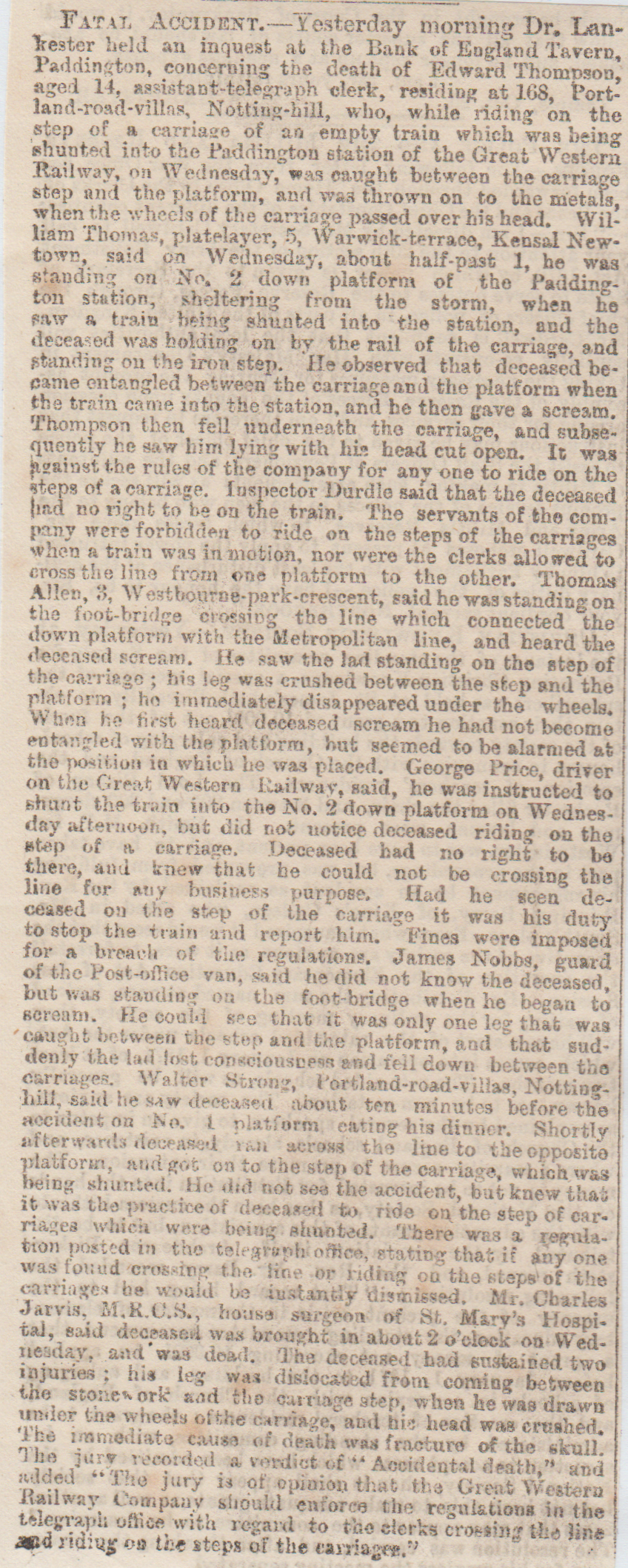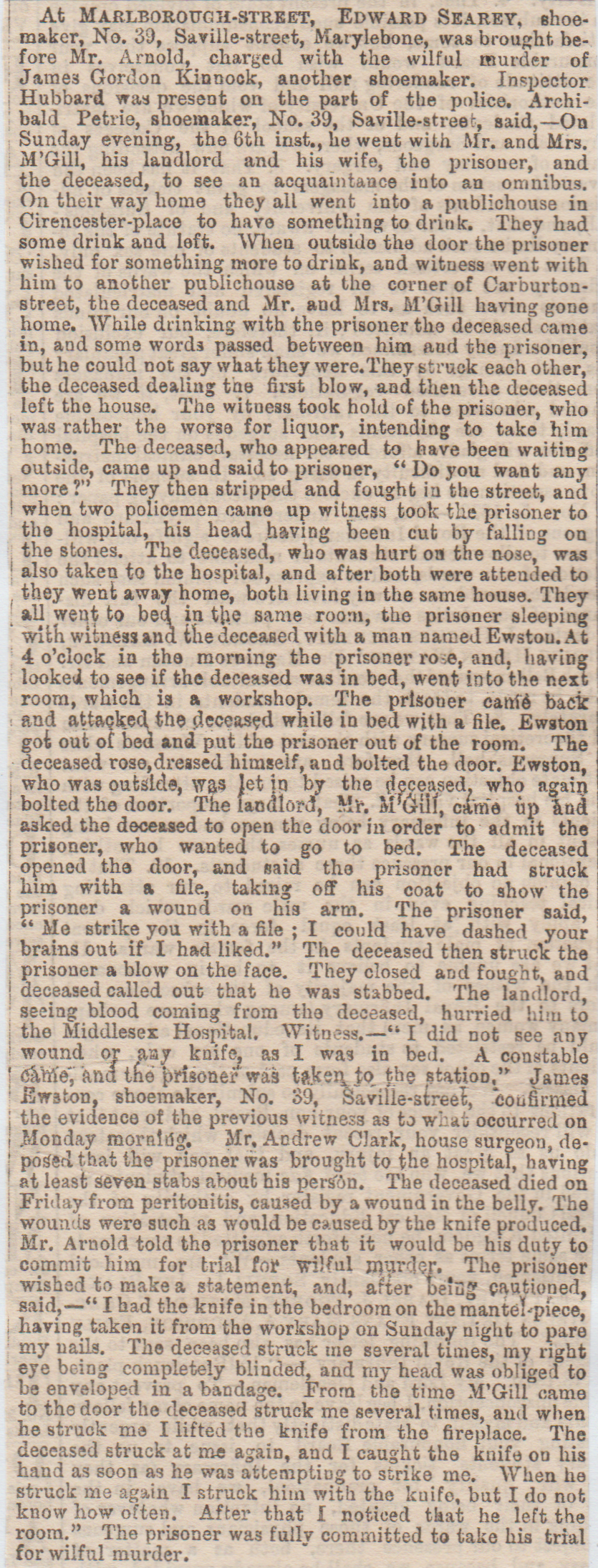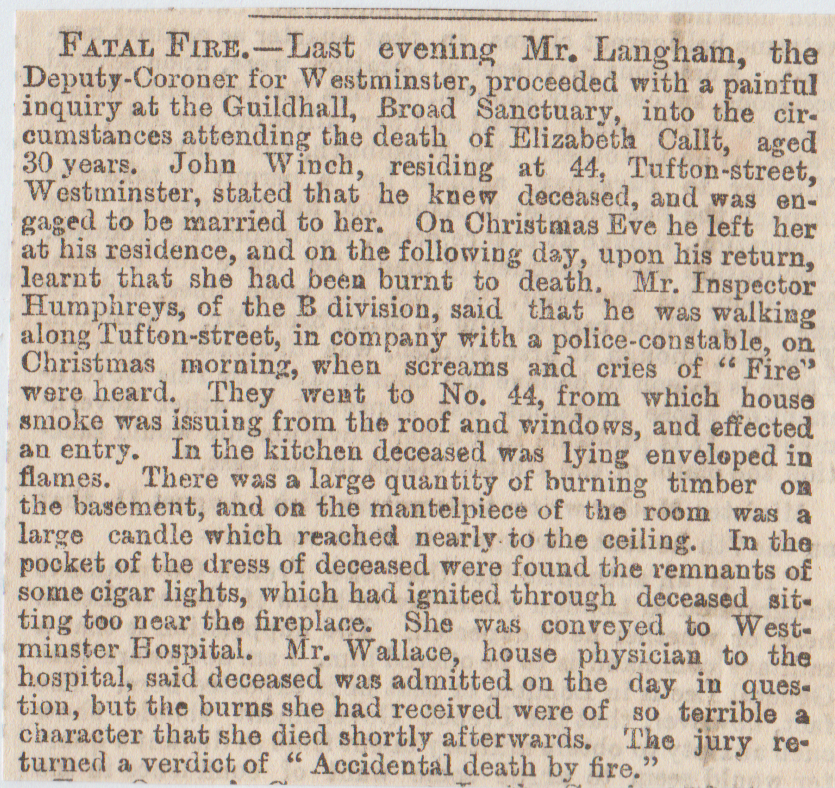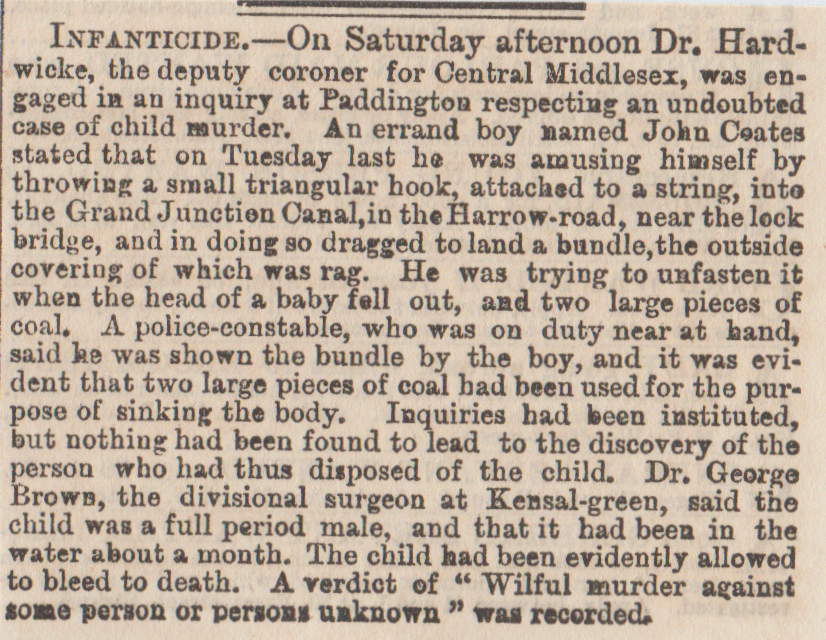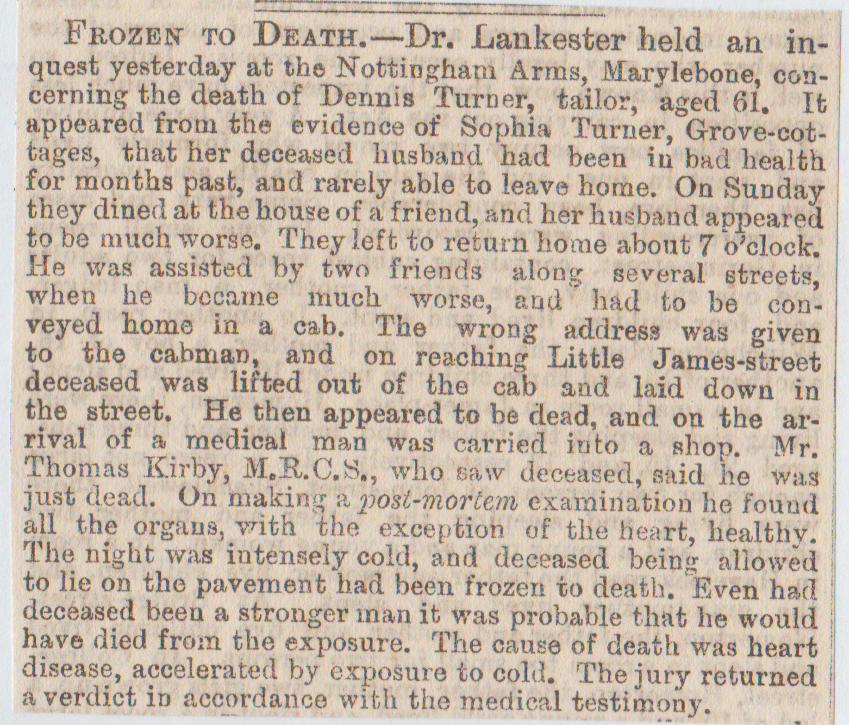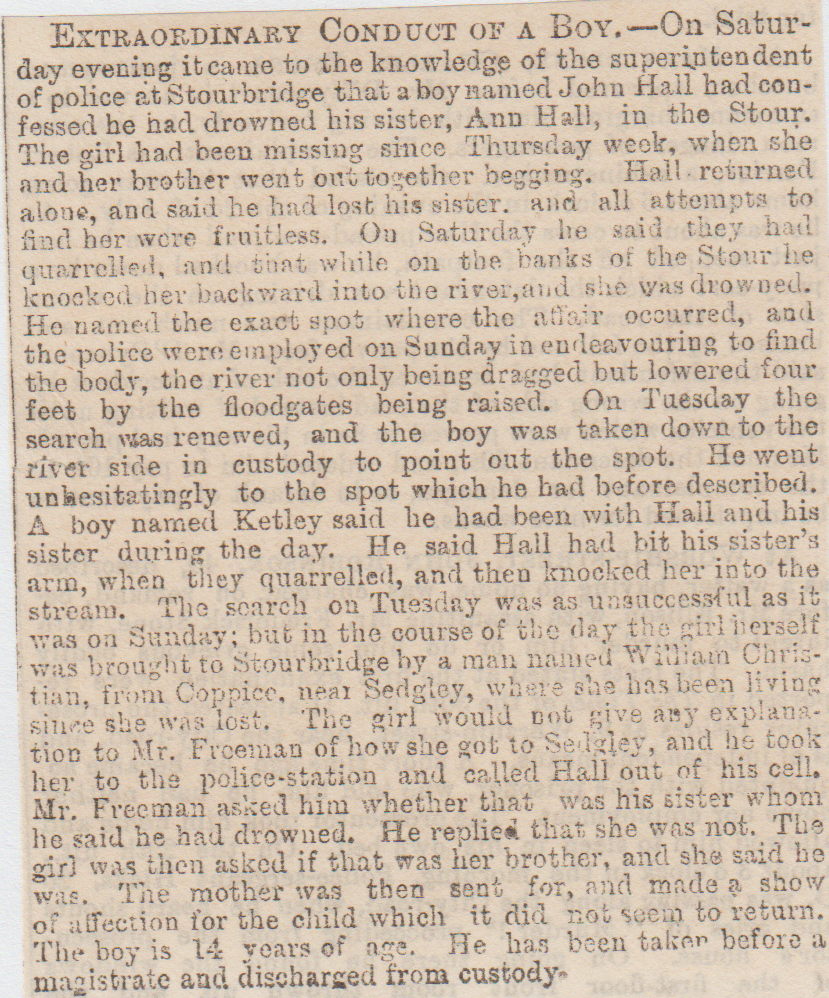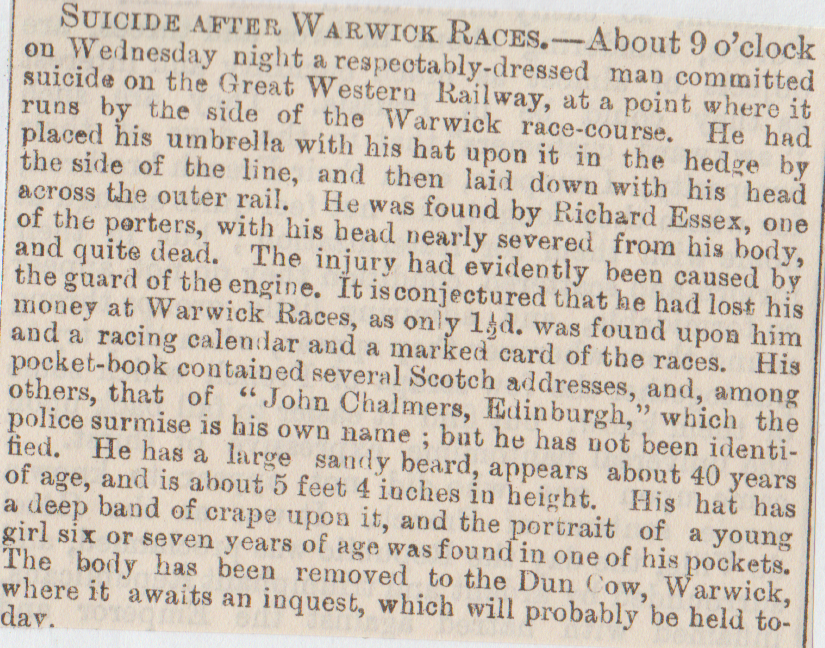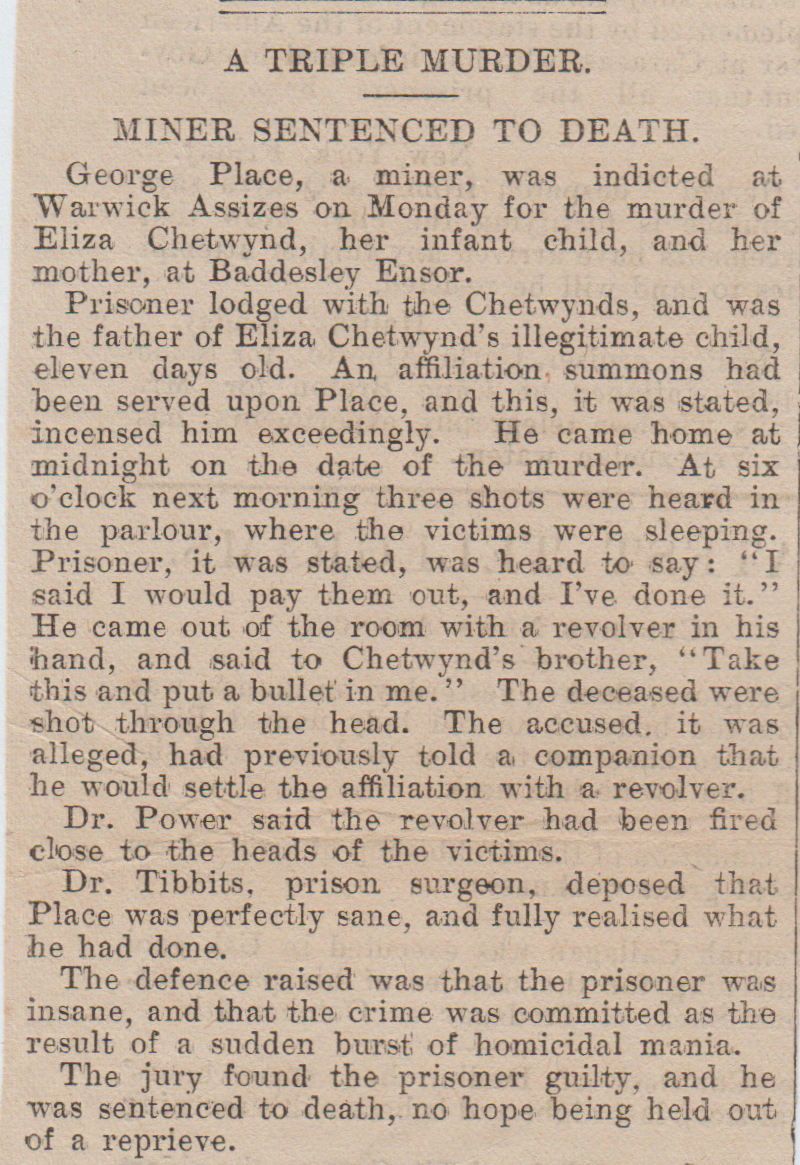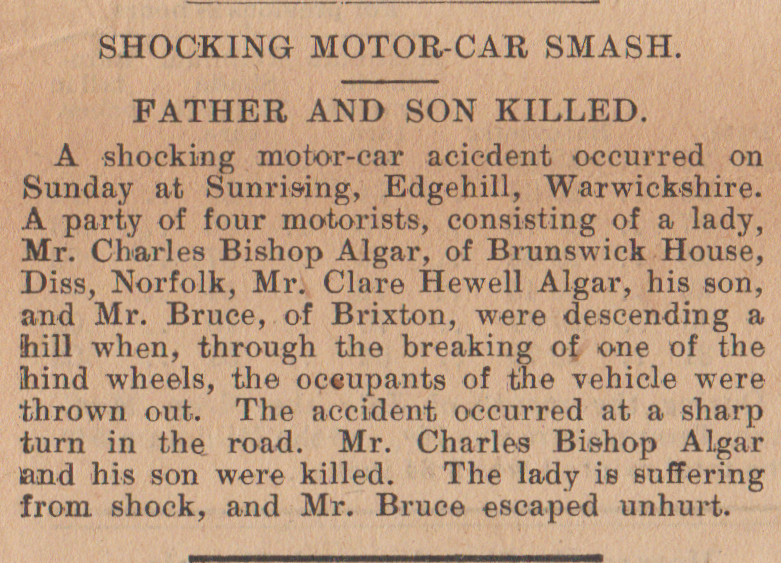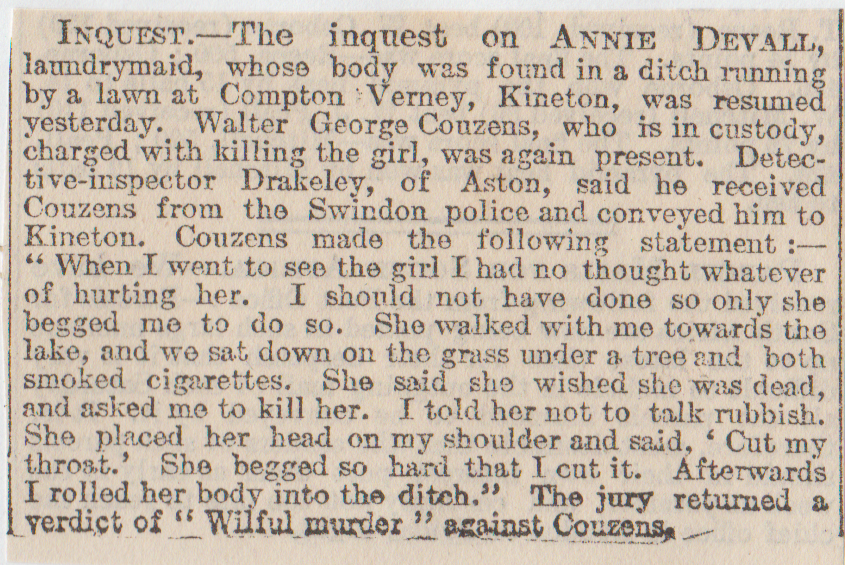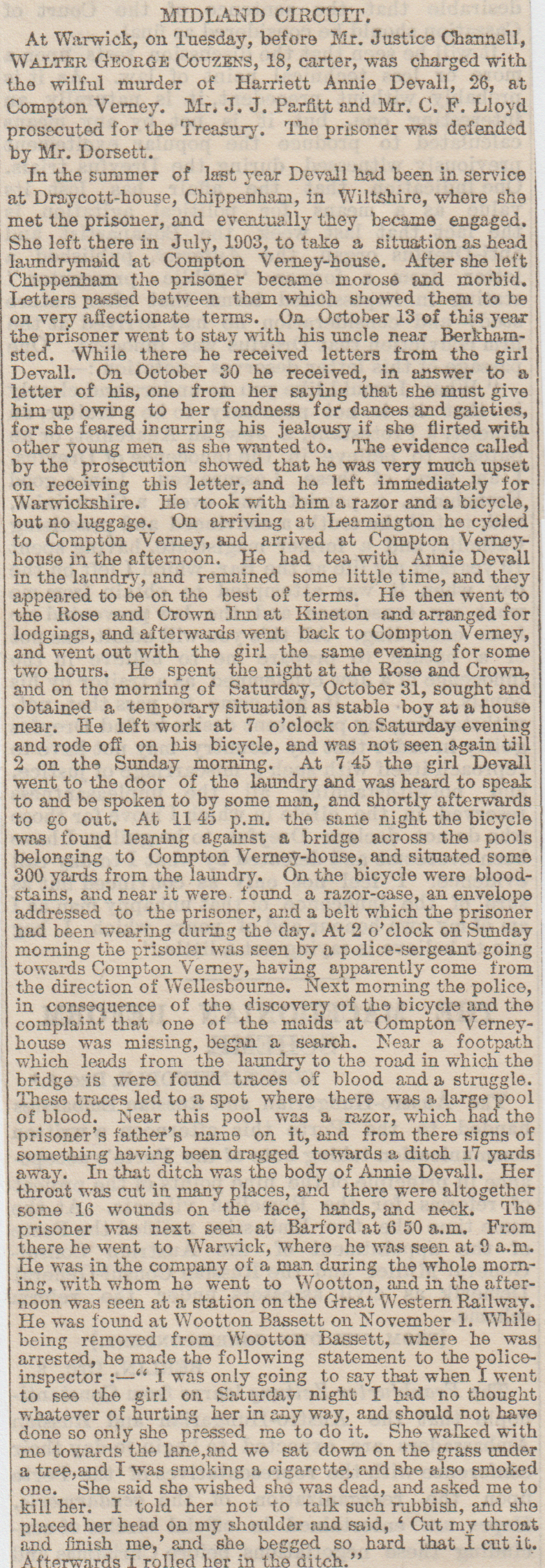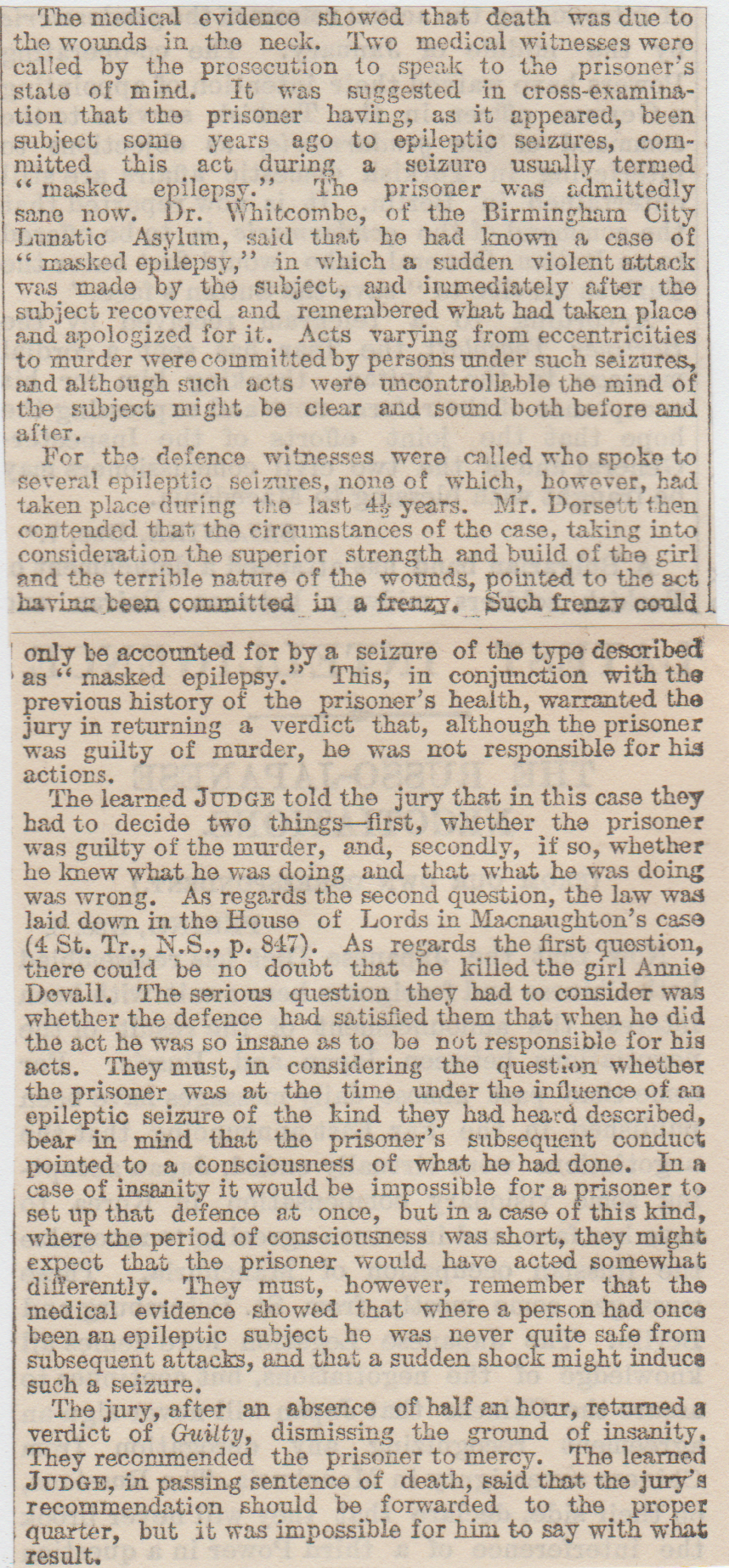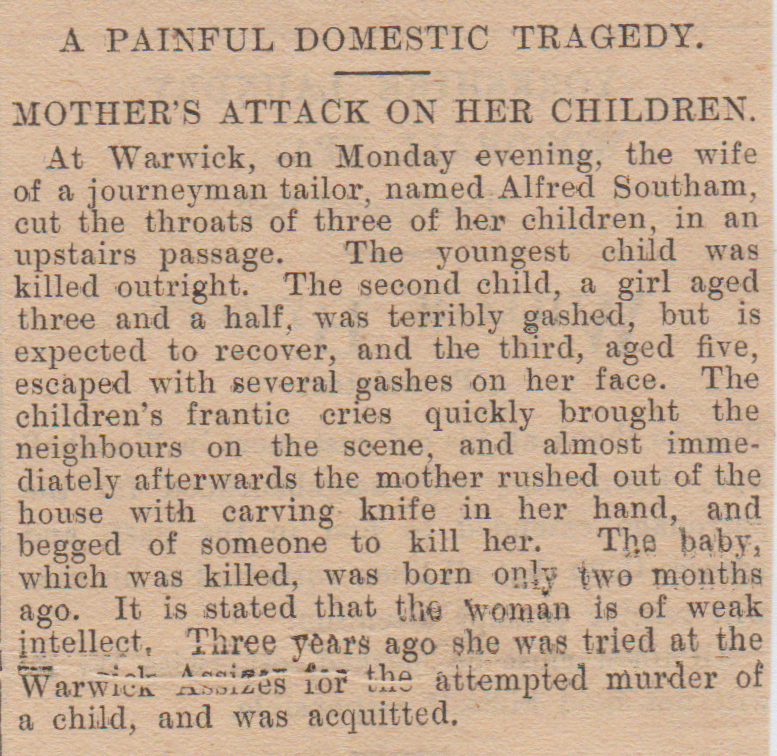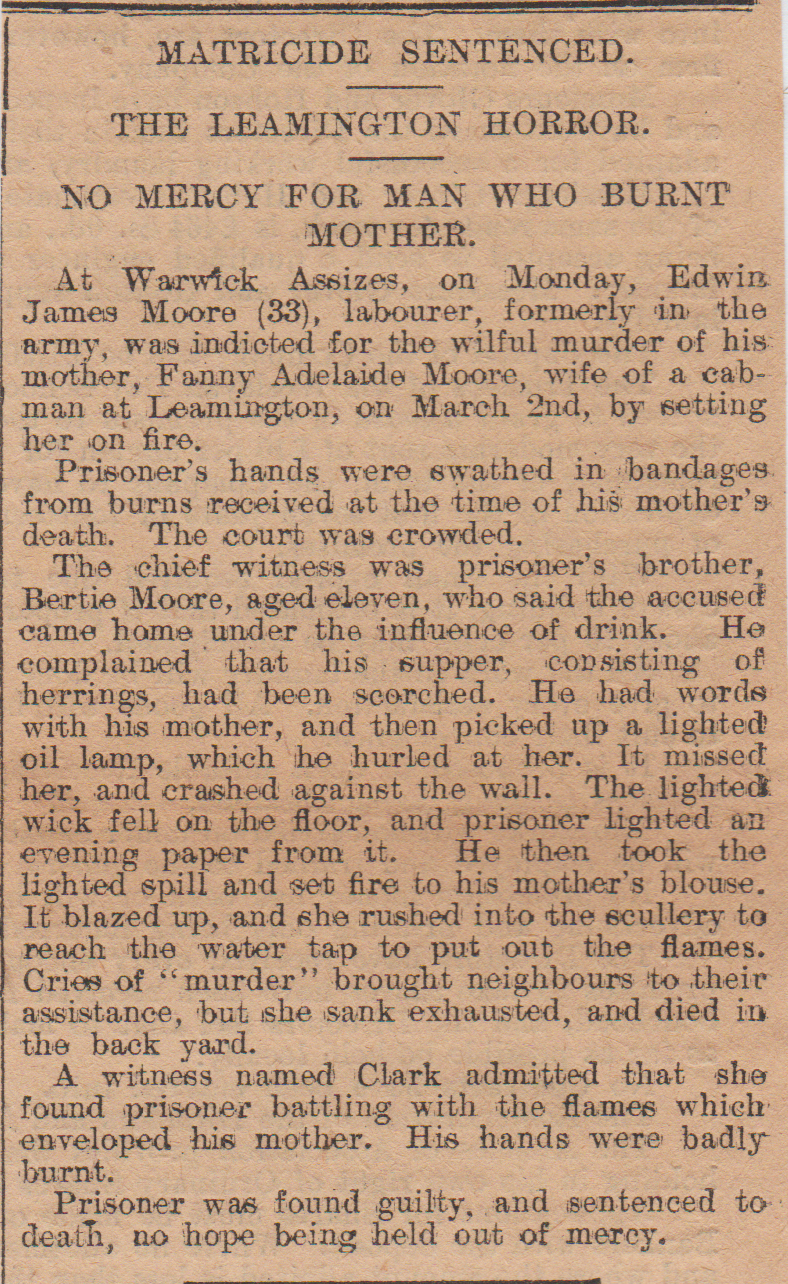Liverpool
Yorkshire (West)
1/ Leeds Double Murder/Suicide, December 1882
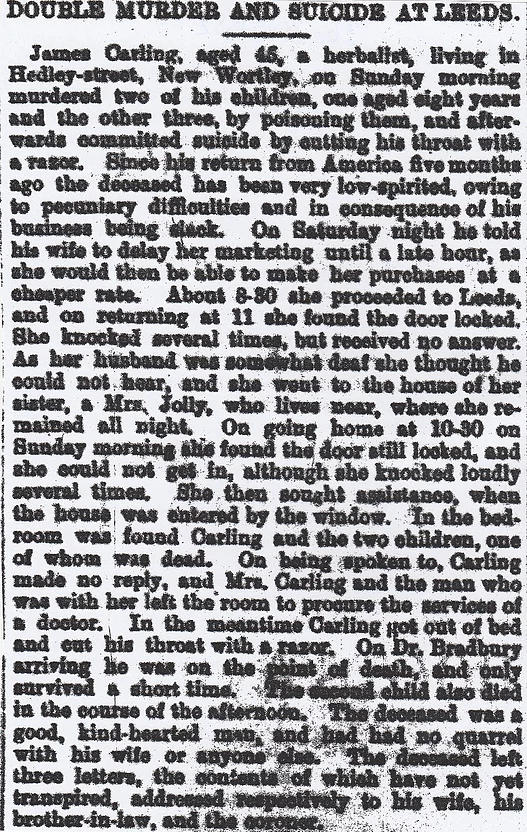
Roundhay Park, Leeds – Drownings, Suicides and Accidents. (See No.43 also)
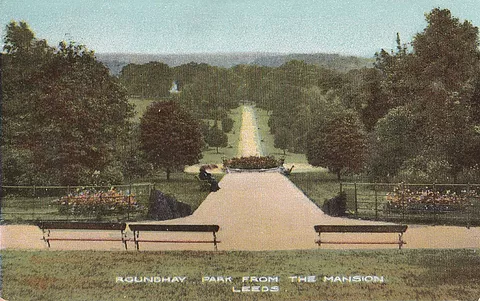
2/ August 1896 (Waterfall Death)
At a hospital gala, a bloke named Fox was looking over the edge of the waterfall, when he accidentally slipped and fell. He was killed on the spot.
3/ August 1907 (Boat Fatalities)
Abraham Cohen aged nineteen with a mate of his from Stockton, went for a boat ride on the lake when one of them dipped his oar in the lake to see how deep it was. The boat tipped over and both were thrown into the water. It was obviously quite deep because one of them was waving for help. Help arrived, but too late. One of the bodies was recovered a couple of hours later.
4/ December 1896 (Waterloo Lake Suicide)
A well-known Leeds businessman, Mr Andrew Wilson, a partner in a firm of wool-combers of Charlestown Mills, was in his carriage on his way to see his brother for dinner. He suddenly told the coachman to stop the carriage, whereupon he got out and told him to carry on without him. Coachman thought he was just behind him, but when he failed to arrive, a search party was organized. His lifeless body was found next to the Waterloo Lake in Roundhay Park with his throat cut.
5/ November 1901
“I leave this world without sigh or regret- cool, calm and collected. I have taken four dozen opium pills & a dose of belladonna liniment, so there is no necessity for a post-mortem”. This was the note left by Fred Dyson who committed suicide in Roundhay Park.
6/ December 1887 (Football Death)
George Harper Houghton from Leeds was injured while playing in a football match at Roundhay Park. He was knocked down and his spinal chord was damaged. He died at Leeds Infirmary from his injuries.
7/ Wakefield, (Charred Corpse in Barn) May 1885
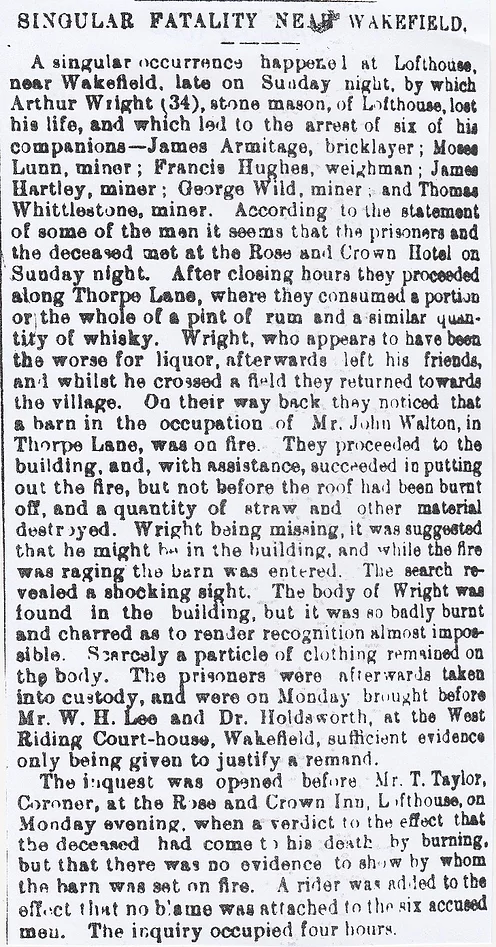
8/ Otley Double Murder, November 1887
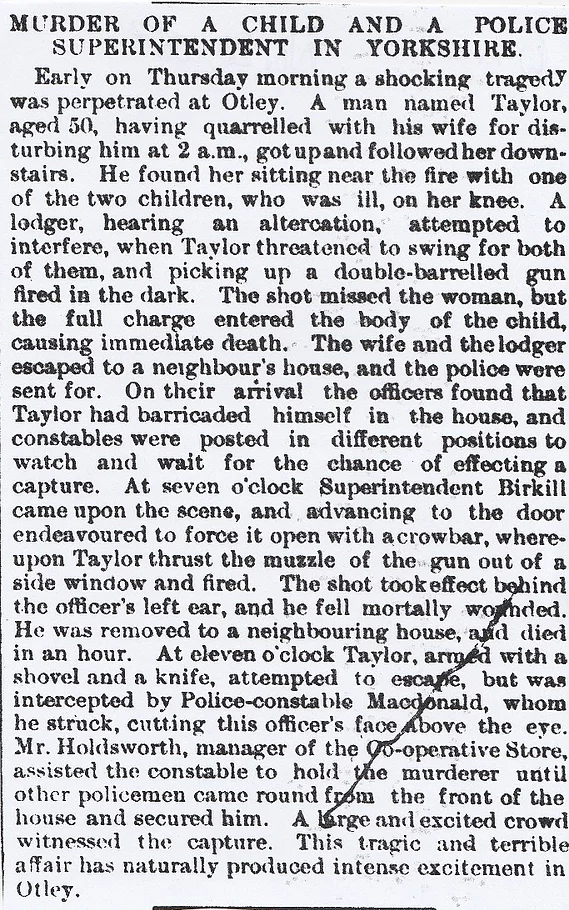
9/ Armley Gaol Murder, Leeds, March 1888
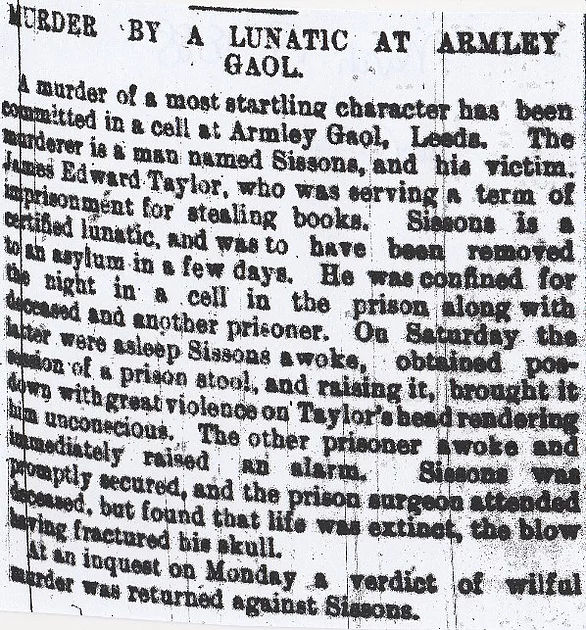
10/ Leeds Town Hall Suicide, June 1877
A labourer by the name of Bean was committed for trial at the Assizes on a charge of robbery with violence. Bean was waiting to be taken to Armley Gaol when he saw a prisoner decorating one of the corridors, so he asked if he could borrow a knife. The bloke lent him one and within a couple of seconds, he had sliced open his windpipe. He was dead in a few minutes and at the inquest there will be serious questions asked about how this could have happened so easily.
11/ Normanton,Wakefield ?- 1883
John Reaves of Hopetown, Normanton, expired through injuries received at Messrs.H.Briggs and Sons and Co’s Haigh Moor Pit at Whitwood. Deceased was quarrelling with a fellow workman and was struck with the endless rope on the temple. He became unconscious and was conveyed home and attended by Dr Kemp of Castleford but died on Saturday.
12/ Knowles Brothers Brewery, Denholme Suicide, (Bradford) ?-1883 (Boiled to Death)
An extraordinary suicide is reported from Bradford. John Hey aged thirty-three, who was employed as a night-watchman at Knowles Brothers Brewery. One night Hey, who had been out of sorts for some time, proceeded to his duty. The following morning he could not be found and on a search being made it was found he had partially divested himself of his clothing, removed the man-hole cover of a large boiler and jumped in, literally boiling himself to death. The body when removed was in a sickening condition.
13/ Brighouse, (Wedding Death) March 1885
At Brighouse on Monday, a Miss Beaumont was married. The wedding party was largely attended and in the afternoon Mrs Beaumont, the bride’s mother aged forty-six, who had been taking an active part in all that was going on, laid down to rest. When called upon some hours later to rejoin in the dances it was found that she was quite dead.
14/ Featherstone Main Colliery Explosion, near Pontefract ?-1883

15/ Kirkgate Railway Station Fatality, Wakefield, July 1901
A terrible accident happened at Kirkgate Railway Station when John Henderson from Driffield backed his horse and dray into the railway sidings and the vehicle dropped into the lower sidings, pulling the horse with it. Henderson was catapulted over the horse’s head and was killed instantly.
16/ Bradford F.C. Ghost, January 1905
This is early 20th-century rugby, I think! The Bradford Football Club was reported as having a ghost at the Park Avenue ground. It was seen by John Jennings the groundsman at Park Avenue on the outskirts of Bradford itself. His house looks over the ground and one Friday night he saw a light burning in the pavilion. He had checked over the pavilion only an hour ago, so he thought that burglars were inside, so he got dressed and went to where the light was still burning brightly. He peeped through a window and saw a man in a red, amber and black jersey- the colour’s of Bradford F.C. Jennings ran to get a policeman and when he returned with an officer, the light had gone and the intruder had vanished. The door was locked and when the place was examined, they found nothing either out of place or missing. At the match on Saturday, it was the talk of the crowd and someone recalled the story that a few days ago, a well-known former three-quarter for Bradford by the name of Jack Hawkeridge had died in San Francisco from typhoid fever. Was it “Joe” looking around the place one last time, reliving past glories at the club? Bradford won the match on Saturday 33-2. Was Joe helping?
17/ Leeds Murder/Suicide, June 1895
Joseph Walker of Dolly Lane, Newtown, went home and tried the door. It was locked, so he forced an entrance and went straight upstairs, where he found his 8-year-old daughter dead in bed and properly laid out. Beside her was the mother and on the floor was a tumbler that reeked of carbolic acid. She died at the hospital later on and the husband told police that she’d been behaving weirdly of late and having hallucinations. She thought everyone was trying to have her put in the Lunatic Asylum. The wife had left a couple of letters explaining what she had done and made allegations, which he denies.
18/ Dewsbury Colliery, (Six Dead) August 6th, 1892
A colliery catastrophe occurred late last night at Dewsbury, resulting in the loss of six lives. Seven men and boys were in the pit and only one escaped, only because he was near the shaft. The accident was caused by a sudden inrush of water from some old workings.
Dewsbury Colliery Flood, August 13th, 1892
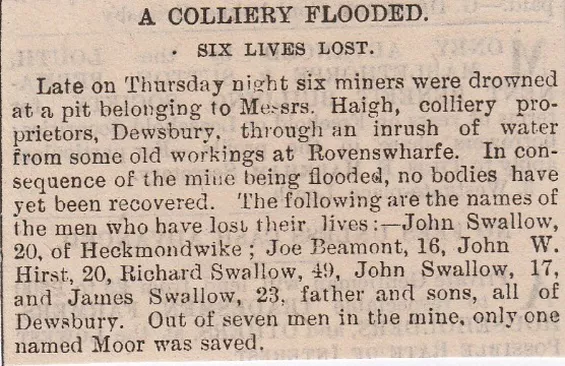
19/ Holmfirth Wife Murder/Suicide, April 1900
A tragedy occurred at Holmfirth near Huddersfield to a fifty-year-old woollen weaver called Jonas Ramsden and his missus, while the kids were at school. Jonas had six kids, three at school and three working. When they all walked out the front door that morning they didn’t expect both parents to be dead when they came back for dinner break. The mother was lying on the bedroom floor and Jonas had hung himself from the ceiling. The wife had been poisoned with ammonia and a quick glance around the room suggested that there had been a struggle between the two of them, and also the fact that her arms were badly blistered.
20/ Leeds Abortion Death, August 1892

21/ Saltaire, (Hall Collapsed) April 1889
The floor of a hall taken by the Bradford Coffee Tavern at Saltaire, fell on Monday during alterations, killing one man and injuring three others, it is feared, fatally. (How many died altogether?)
22/ Otley Baptist Chapel, (Body Found) April 1894
A dreadful discovery was made at the Otley Baptist Chapel one morning, when the body of a widow named Mrs Leech, was found in the baptistry. Eighty-four-year-old Mrs Leech had been a volunteer there for several years and was the chapel-keeper. The theory is that she went to clean the baptismal place and there met with a sad end. (Is chapel still there?)
23/ Theatre Royal, Halifax, (Man Blinded) December 1859
An appalling accident happened at the Theatre Royal in Halifax on Monday night to a comedian named Mr Watson. It was the play “William Tell” which was being performed and it was the part where William Tell teaches his son how to use the bow and arrow by shooting at a target. Today’s “Health and Safety Inspectorate” would have a field day here, because a piece of sheepskin was held near the steps to prevent a stray arrow going into the audience. Watson had already given the audience a heads up, but an arrow flew towards him and penetrated his left eyeball. He is now blind in that eye, but lucky to be alive!
24/ George Street, Bradford, (Attempted Murders) August 1889
One night during a wake in a lodging-house at George Street in Bradford, a man named Emanuel Sugden died from the injuries he sustained when two other lodgers started kicking him. These are allegations at the moment, but a couple of hours later, also in George Street, a woman was found unconscious with deep head wounds.
25/ Castleford, (Father Drowns after Two Children Year Before) June 1899

26/ Hunslet Railway Suicide, near Leeds, July 1845
As the seven a.m. train approached the bridge over the river at Hunslet, the stoker spotted a bloke lie down on the train-tracks. As he put the brakes on he blew his whistle for him to move out of the way. The train and carriages drove over him and when they examined the body there was little left of him. It was John Sutcliffe, a married warehouseman from North Town End in Leeds, who left a wife and seven kids to fend for themselves. At the inquest, his wife stated that he been drinking heavily for the past few weeks and had been down in the dumps for some reason or other.
27/ Rawdon Baptist College, (Haunted?) August 1909
Here’s a strange tale from a college in Leeds that could mean that it is haunted. It is holiday time at Rawdon Baptist College and only four people are still on the premises. These four have, during the past week or so, been disturbed by knocking and banging from within the walls of the college. They happen at night mostly but also have occurred during daylight hours and they have been verified by several outsiders who didn’t believe it. Plants were carefully moved from desks and tables and placed on the floors. The gardener went round with a loaded shotgun but found no intruders of any kind.
28/ Keighley/Bingley, (Cyclist Killed) June 1895
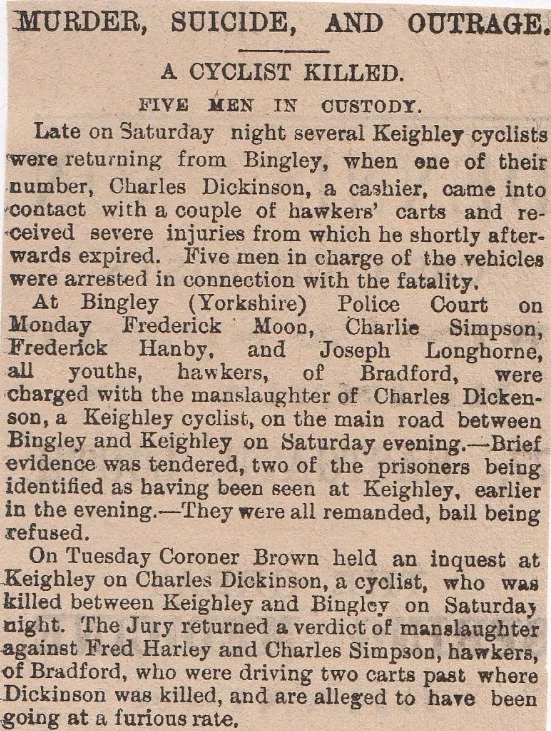
29/ Huddersfield, (Crossland Reservoir Suicide) July 1889
Twenty-four-year-old Margaret Lees was discovered in the mill reservoir of Messrs.B.Crossland and Sons, drowned. Originally from Greenfield, she had lived in Huddersfield for two years due to work commitments. Charles North of Lindley, whose house she lodged at, found a letter on the table stating that she’d be found in Crosslands Reservoir. Lees had been seeing for a few months, and Albert Robinson, a joiner from Birkby, but this was at least five months ago. They were engaged but she broke it off and then he’d got a letter from her saying that he shouldn’t have asked her to meet him, when his heart with another girl. It carried on that if this had not happened it would have saved her a great deal of pain and worry. Robinson said he was amazed at receiving the letter. It seems that she still held a torch for him, but he wasn’t too bothered.
30/ Wakefield, (Fatal Scalding) November 1859
Alice Goldthorpe was watching her mother make a pot of tea and then she let it “mash” in the teapot on the kitchen table. Being very young she didn’t comprehend the fact that it was boiling hot, so she grabbed spout when her mother’s back was turned and took a huge gulp. There was a horrendous scream, then as her throat began to swell, she started to convulse with the poor girl eventually dying in terrible agony. A verdict of “Accidentally Scalded” was returned.
31/ Armitage Bridge near Huddersfield, (Work Fatality) March 1885
John Cunliffe aged twenty-eight, who was a labourer in the service of the Huddersfield Corporation, was ascending a hoist which works by steam at the premises of Messrs. John Brooks and Sons, Armitage Bridge, woollen manufacturers, when he put his head out of the cage and a descending weight caught him and he was killed on the spot.
32/ Darley Street Manslaughter, Bradford, June 1888

33/ Liversedge Station Fatality, September 1906
The stationmaster at Liversedge Station, Thomas Mann, died in a freak accident on the Lancashire and Yorkshire Railway. The train was in Liversedge Station, when he stepped on a footboard to give a passenger a bunch of flowers that he had personally grown. The train shunted forward, he stepped back and fell between the platform and footboard. The train came to an immediate halt, but his body was totally crushed under the weight.
34/ Leeds Double Murder/Suicide, February 1899
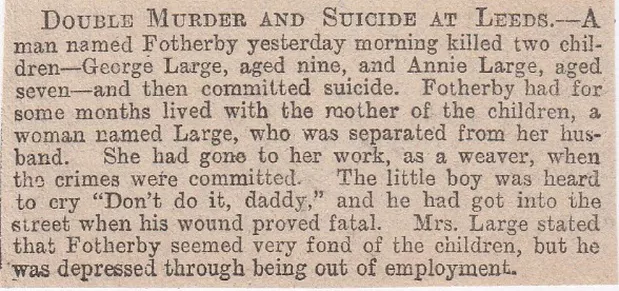
35/ Slaithwaite Railway Fatalities, April 1885
Two men were run over and killed by an express train whilst crossing the London and North-Western line at Slaithwaite yesterday afternoon.
36/ Gatland Infanticide, near Halifax, August 1897
On a Thursday night P.C. Hart was brought to the house of Annie Dickenson (who was a single lady) and found her in her bedroom with her dead baby. Annie was semi-naked but her clothes were soaking wet. She explained that she had gone to the nearby mill-dam and had tied the child to her back and jumped in intending to kill them. She kept floating up to the top and she climbed out, but the child was already dead. She went back home and before P.C.Hart arrived, she had given birth to another illegitimate child. The little girl who drowned was only fourteen-months-old and also named Annie Dickenson.
37/ Bunkers Hill Quarry, Dewsbury, (Fatality) January 1858
Two daughters of Mr Benjamin Exley of White Lee were coming back from Dewsbury Independent Chapel when they got lost in the dark at Staincliffe and they both fell into Bunkers Hill Quarry. One of the girls was killed on the spot, but the other managed to get to a nearby cottage after four hours of crawling on her hands and knees. She is in a precarious condition, but there are signs that she will make a full recovery.
38/ Wyke near Cleckheaton, (Fatal Procession) March 1885

39/ Alverthorpe, March 1898 (Death on the Football Field)
During the progress of a football match at Alverthorpe near Waterfield on Saturday, between the Alverthorpe and Normanton clubs in the Yorkshire Challenge Cup competition, William Edward Kaye, the oldest member of the home team, slipped and fell with his neck on the knee of a Normanton player. He injured his spine and death ensued some hours later.
40/ Ossett, (Self Immolation) February 1869
Thomas Illingworth from Ossett killed himself by self-immolation. Passers by saw a glare of light emanating from the kitchen window of his house and went to investigate. In an amazing spectacle, they observed Illingworth sat on a huge pile of burning coal in his hearth. They managed to drag him off and extinguish the flames and they heard him whisper- “I sat down on the fire. It was my own evil deeds that caused me to do it”. He died soon afterwards.
41/ Todmorden Drowning, August 1892
Late on Tuesday evening, Edward Barritt aged nineteen-years, a shoemaker’s apprentice from Beanhole Head, Cross Stone, was drowned in a pond near to Harley House, Hole Bottom, Todmorden. About eight p.m. deceased was seen to enter and swim about halfway across; he then appeared to dive but did not come up again. The water was drawn off and the body was recovered about nine o’clock.
42/ Armley Gaol Suicide, Leeds, March 1898

43/ Herbert Terrace/Roundhay Park Suicide, Leeds, November 1889
Mrs Watson, who lived at Herbert Terrace in Leeds, made a determined effort at suicide, by first cutting her throat open at her house, then wrapping up the wounds and walking three miles to Roundhay Park and then jumping into the lake and drowning herself. When police examined the home they found two blood-soaked knives and spattering in the kitchen and scullery. The cause of this was that she had lost her little boy who was scalded to death and was depressed and missed the child.
44/ Great Horton, Bradford, (Dies From Pea in Ear) December 1850
Richard Bolton’s son from Great Horton was messing about a few days ago with a mate of his who was pretending to put a pea in his ear and then make it come out of his mouth. Bolton thought the trick was genuine, tried to perform the trick himself and thrust a pea so far in his ear that it got stuck fast. A medical man tried to prize it out, but actually shoved it further in and four days later the young chap died from the effects.
45/ Aire and Calder Canal, Castleford, (Body Found) March 1892
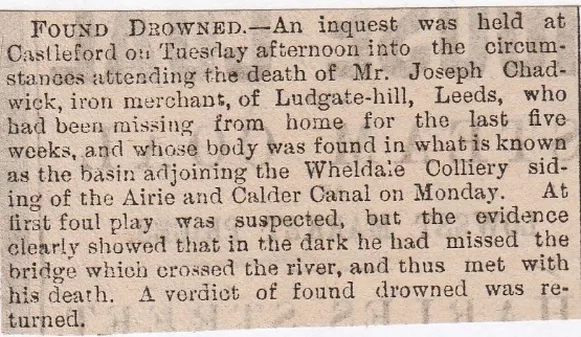
46/ New Station, Leeds, (Childs Body in Bag) March 1878
The body of a newborn child was discovered inside a carpet-bag at the New Station in Leeds. The body of the infant was wrapped in a scrap of an old shirt and the bag was addressed to “Mr Anderson, Kings Cross”
47/ Dewsbury Manslaughter? May 1885
At an inquest held at Dewsbury yesterday on the body of William Gibbs who was fatally stabbed on Friday night during a quarrel. The jury returned a verdict of wilful murder against Daniel Lee. From the evidence, it appeared that Lee was first struck and kicked by the deceased, and Lee, being drunk, stabbed him in the thigh, inflicting a wound from which he bled to death. The knife has not yet been found.
48/ River Aire, Saltaire, (Body Found) June 1899
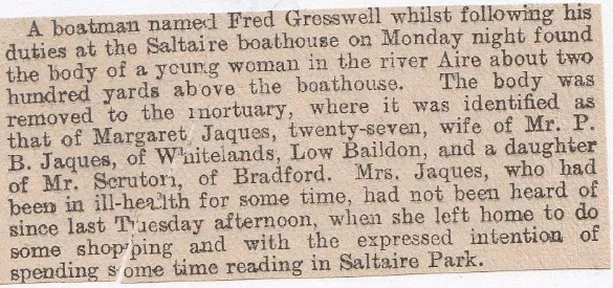
49/ Wakefield, May 1885
Yesterday morning, about four o’clock, the body of a man was found on the Great Northern Railway at Wakefield in a shockingly mutilated state. The head and left foot had been cut off and it was clear that the man must have been killed by a passing train as he was walking on the railway. The body has not yet been identified.
50/ Beeston Pit Suicide, near Leeds, February 1866
At Beeston near Leeds, Sarah Twidell, the wife of a collier, but who had been for quite some time been separated from her husband, committed suicide by jumping down the shaft of a coal-pit. The shaft was of a considerable depth and she was killed instantaneously. Her body was terribly mutilated. (What pit-shaft was it?)
51/ Furnace Inn Murder? Low Moor, (Bradford) June 1891

52/ Wakefield, (Building Collapsed) May 1885
A fatal accident occurred at Wakefield last evening. Whilst some buildings belonging to Mr Wade, flour dealer, were being altered, a portion of the old wall fell and also a large beam of wood. Mr Edward Fawcett, a master builder, was shockingly injured and he died at the hospital in the course of the night. One of the workmen was also injured.
53/ Manningham, Bradford, (Childs Body in Sewer) April 1896
The remains of a fully developed child have been found in a sewer at Manningham, a fashionable suburb of Bradford. It is thought that a dreadful murder has been committed, as the child’s head was missing from the body and the arms and legs have been torn asunder. An inquest is due on Tuesday night and police are conducting inquiries.
54/ Farnley and Wortley Station Death, Leeds, July 1895
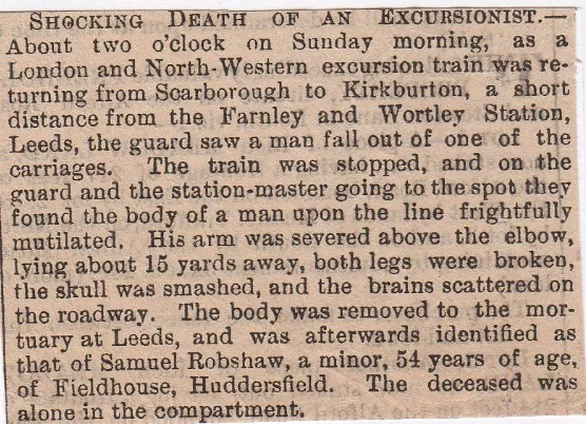
55/ Midland Hotel, Bradford, (Double Suicide or Accident?) August 1894
At midnight on Friday, a shocking discovery was made in the Midland Hotel at Bradford. The dead bodies of a waiter named Shilter and a maid named Peniston being found in the basement under the dinner-lift, with their heads smashed in. They had been missing for a few hours, but the question remains is, how did they get in this position in the first place. The lift-well is narrow and the entrance is guarded on each floor. (What did happen here?)
56/ Longwall near Elland, Leeds, May 1885
On Saturday afternoon a youth named Milner Noble, the son of Thomas Noble, cotton spinner in West Vale was killed by falling down the rocks at Long Wall. He and another youth named Swallow, climbed up the cliff about eight yards and in coming down again Noble detached a large piece of rock and fell to the ground. The rock fell upon him and he died in a few minutes.
57/ King Street Chambers Suicide, Wakefield, August 1890
On Wednesday evening Mr John Masterman, accountant of King Street Chambers in Wakefield, committed suicide by poisoning. He had taken an ounce of laudanum and was found in his offices. Mr Masterman was clerk to Stanley School Board.
58/ Free School Lane, Halifax. (Dynamite Death) March 1885
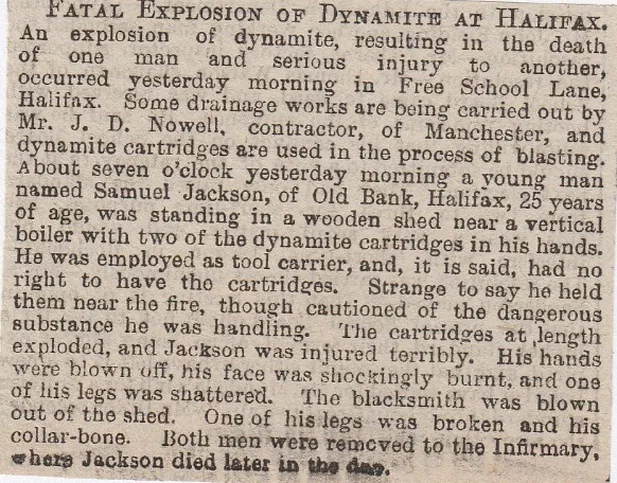
59/ Holbeck Railway Station Fatality, August 1885
On Saturday morning, while a number of men were employed upon the alterations at Holbeck Railway Station in Leeds, some of the props of the roof gave way, killing one man and injuring several others, though not seriously.
60/ Leeds, August 1889 (Strange Suicide Note)
Twenty-one-year-old Charles Edward Eatch, killed himself in Leeds and left a strange suicide note to a woman named Morley. It read: “I am going to commit suicide on Friday morning, as I want to be buried on Bank Holiday Monday, so that I shall disappoint my cousin Annie, who is to be married that day, so there will be a funeral instead of a wedding! I hope you will attend my funeral. I will meet you in Heaven.” Verdict: Suicide whilst of unsound mind.
61/ Bradford Murder/Suicide, May 1857
An assistant bailiff named Samuel Charlton aged fifty-eight fell in love with a widow from Lidget Green named Mrs Hannah Holroyd aged forty-two. Hannah’s friends told her to stay away from Charlton, he was a weirdo they said, and besides a bloke by the name of Normanton was interested in dating her. One evening Charlton and Holroyd went to a temperance meeting and were walking back to her home when Normanton stopped to have a chat. Charlton carried on to her house and waited there, while her children were asleep in bed. She finally returned and he killed her in the front room in a fit of jealousy. He then rushed home and told his kids that he wouldn’t see them again and then ran out the door. The police meanwhile had found Holroyd dead on the floor and they were now looking for him. He had gone to a local suicide hot-spot, New Miller’s Dam, and drowned himself.
62/ Summit Tunnel Suicide, May 1861
James Rawson, 22, of Handle Hall near Littleborough was sliced in two by a goods train on the Lancashire and Yorkshire Railway not far from the Summit Tunnel. Rawson had been to the Summit Inn on Friday night getting drunk and was seen at 5-30 a.m. wavering about on the line by the driver of the train. The driver stated that Rawson simply shook his head, then laid across the rails. The driver slammed on the brakes, but to no avail and the train cut him in half.
63/ Albion Glass Works, Castleford, (Awful Death) October 1889
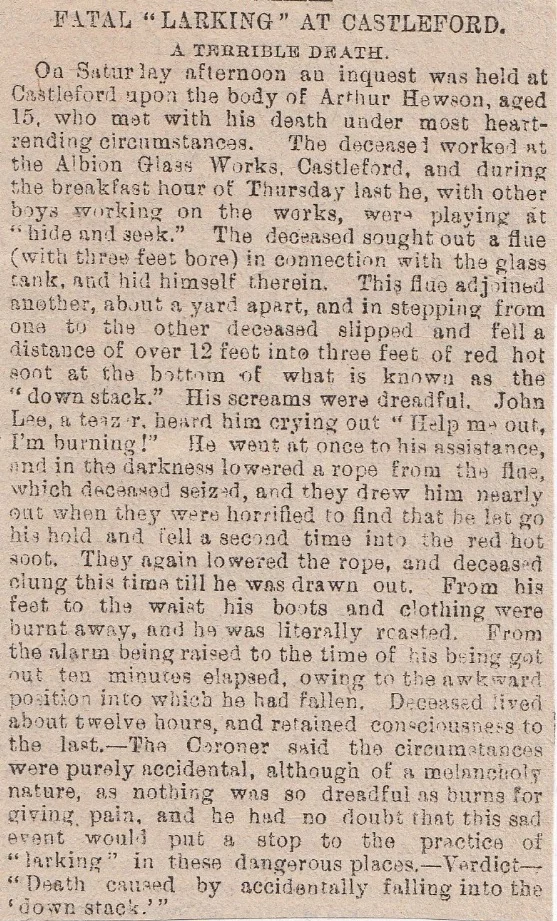
64/ Huddersfield Suicide, February 1862
Sixteen-year-old Mary Blackburn worked as a steam-loom weaver at Messrs Lockwood and Keighley’s factory in Upperhead Row, Huddersfield. She was coming back from work one night, with two of her work colleagues, when she told that an over-looker had found fault with her work and if she wasn’t at the mill at six a.m., then she had better drowned herself. They all turned onto the canal bank towards Lower Houses where Blackburn lived, when she suddenly exclaimed- “I’ll leap in- I’ll do it right now” and before they had a chance to grab her or talk her down, there was a splash. She floated away and eventually sank and when she was taken out, she was quite dead.
65/ Holmfirth Suicide, April 1889
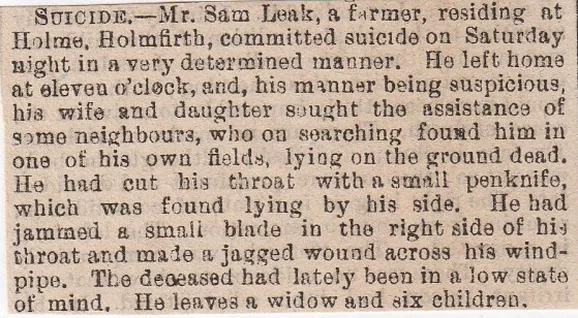
66/ Waverley Temperance Hotel Suicide, Leeds, February 1910
Evidence at the inquest into the death of Glaswegian Charlotte Lebo, who was staying at Waverley Temperance Hotel in Leeds and who went to solicitors and left all her money, £388 in total, to the Leeds Infirmary, then poisoned herself in her room. A laudanum bottle was by her side in the hotel bedroom and she was rushed to the hospital but died shortly after being admitted. The papers that were discovered in the room were addressed to a Miss Charlotte Driver and the Inland Revenue papers were addressed to Charlotte Lebo. The Clyde Navigation Co. and the Charing Cross Bank in Glasgow also had receipts in her paperwork, plus £88 in the Glasgow Savings Bank. Confusing, but it is obvious she was using two names, so police are trying to find out the proper identity of the woman.
67/ Hoyland Nether Suicide, July 1889
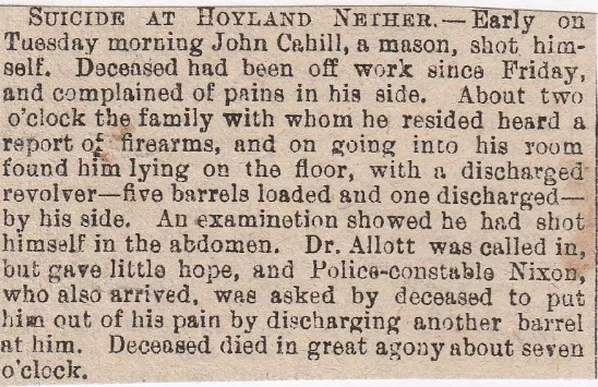
68/ Bowling Old Lane, Bradford, November 1895 (Press-box Death)
Reporters attending the Bowling Old Lane versus Outwood Church at Bowling, got a strange reception when they arrived there. A crowd was gathered around the press-box and inside was the dead corpse of a man. The gates were opened at 2-15 p.m. and the reporters had gone up to the press-box to write down the proceedings. Twelve-year-old William Hargreaves saw a bloke curled up in the corner and on further inspection found him to be totally lifeless. He told the gateman and the police were fetched. The deceased’s name was Thomas Paterson aged forty-one, who had been hitting the bottle recently. Someone had seen him on Monday night, but when they looked for him they searched everywhere but the press-box. Now five days later, they came across the body. Nobody can explain why he was in the press-box.
69/ Robin Hood, Leeds, February 1892
A blacksmith named Hartley aged thirty-six-years-old and employed at Messrs.Charlesworth’s Colliery, Robin Hood, Leeds, was taken home intoxicated on Saturday night. He lived alone. On his house being entered on Sunday by neighbours, Hartley was found in the last agonies of death, being severely burned all over the body. Before assistance could be obtained he expired.
70/ West Riding Asylum Manslaughter, Wakefield, May 1897
A dreadful attack on a fellow inmate at West Riding Asylum resulted in the death of one of them. Annie Eastwood, a young lass from Halifax, was in the bathroom at 8-45 one morning when Louisa Westerman grabbed her by the hair and booted her in the head and face. She was grappled to the ground by attendants and Eastwood was taken to the Infirmary, where she remained unconscious until her death the following day.
71/ Pontefract Park, (Murderous Attack) March 1890

72/ “Weekly News” Office Suicide, Huddersfield, April 1894
The chief reporter for the “Weekly News”, Mr J.L. Crowther, a paper based in Huddersfield, was found to have killed himself in the office in the Market Place. He is supposed to have poisoned himself by taking some arsenic, but why he did is not entirely clear. He leaves a widow and one child. It could have been through stress and overworking.
73/ Bradford, (Horrific Death) November 1859
A young lad named Robert Blezzard was busy in Victoria Mill, Bowling near Bradford. The lad was oiling a shaft when his work-gear got snagged in the machinery and he was viciously rotated around the shaft at 95 revs per minute. His head was smashed to bits, brain matter spread throughout the area and all over the ceiling. His wife was working underneath the shaft when she heard the commotion, so she left her room to see what was the matter. Parts of her husband ended up in the fabric she was weaving, and to make it worse, she was expecting a child very soon.
74/ Hebden Bridge, (Bodies Found) January 1870
On December 11th, 1869, a boy named Samuel Thomas Townsend aged eight-years was emptying some ashes into the River Hebden at Hebden Bridge when he was swept away by a strong current and swollen river. Attempts were made to find him but they were futile. The Saturday afterwards another lad named Samuel Pearson aged nine was crossing the River Hebble at Lower Shaw Hill, Halifax when the plank gave way and he was swept away by the fast-moving current and his body was not found either. Now six weeks later on, both the bodies have been found in the River Calder near to Cooper Bridge. They were so decomposed and mutilated it was best not to let the parents have them in their homes. They were buried at Bradley churchyard straight away.
75/ Wm Crabtree and Sons Boiler Explosion, Dewsbury Moor, March 1878
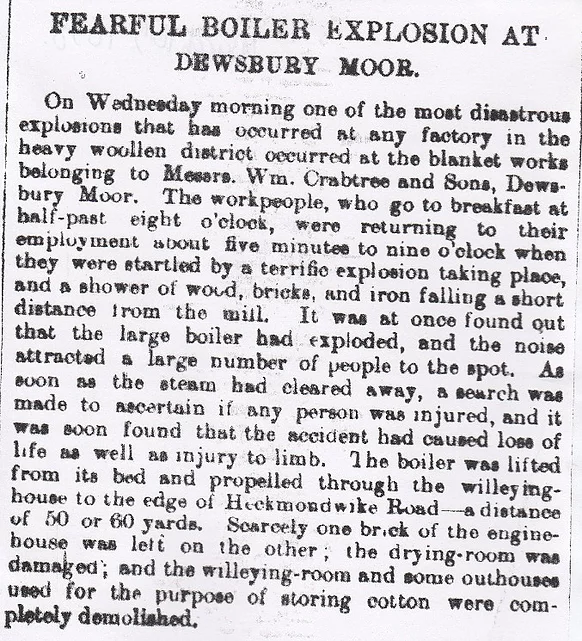
76/ Leeds May 1892 (Sad Suicide Letter)
The thing I find so fascinating about these paper clippings from the Victorian era is that the reporters managed to get hold of every detail, they saw the crime scene, post-mortem reports, court proceedings word for word and slightly disturbing is that they were given the suicide notes to copy down or read themselves. This is one of those badly spelled, sad letters of a teenager about to meet her maker. Elizabeth Taylor Jackson aged nineteen killed herself in Leeds and it describes what she is going through and how she thinks that suicide is the only way to cope with the situation. It’s fairly short but oh-so-sad.
“Dear mother and step-father,
i hope you will forgive me what i am goinge to do. i cannot help it as a suden impulse that i cannot resist. i am doing it because i am disatisfied with my home. i am only to sorry to leave it and i am going to try hanging. i think it will be succeedful it will be better than trying anything else and having to go to an asylum and causing trouble. it is true i never intended to do it if i could help but if i have to do it i might as well try to do it right. i cannot always trust myself, i told mother so when she came to see me when i was away so good by”.
77/ Wakefield Lunatic Asylum Murder, June 1889
A patient at the Wakefield Lunatic Asylum named Hirst, was with another inmate mopping the floors when he suddenly cracked him over the head with a large piece of wood. The injuries sustained were horrendous and his death must have been immediate. The inquest evidence proved that they were both troublesome inmates. About six weeks ago the deceased had tried to strangle another patient to death. Hirst thought that unseen agents were trying to get him.
78/ Thackley Canal Drowning, June 1899

79/ Ogden Lane Suicide, Brighouse, March 1894
John Edward Horsfall was found hanging in his house and was last seen about two weeks ago at the end of February. He lived on his own in Ogden Lane and the neighbours were getting quite concerned for John’s whereabouts, so a man named Edmondson had a peep in the window and saw him hanging from a cupboard door. They broke in and cut him down but he was dreadfully decomposed. The post-mortem proved he’d been up there for the full two weeks or more. He was in a good frame of mind when last seen but it was the verdict of “Suicide by hanging, but there was no evidence to show the state of mind at the time”.
80/ Halifax Murder, December 1908
Hannah Maria Whiteley aged twenty-nine was found on Christmas Day stabbed to death at 20, Great Albion Street in Halifax. There seems to have been a frenzied attack in the head, chest and neck area, and the gashes are wide and deep, which would suggest a butcher’s knife of some description. The bloke she lived with was a twenty-five-year-old butcher, Ernest Hutchinson. The neighbours heard the two arguing and shouting at each other and on Christmas Day he was stood at the window shouting “Maria is dead”. Blood was oozing under the doorstep, so the neighbours smashed a window and climbed in. Mrs Whiteley was dead, lying in a heap on the floor and Hutchinson was on the stairs, sitting bolt upright with a knife in his hand and his throat slashed. In a room near the murder scene was Mrs Whiteley’s five-year-old daughter who was extremely frightened and dazed by what she had witnessed. Mr Whiteley works away in Cumbria. Hutchinson was moved to the hospital where he is expected to make a full recovery. (Did Hutchinson survive?/ Was he a lodger or lover?)
81/ Clarence Ironworks, Hunslet, (Fatal Quarrel) May 1891
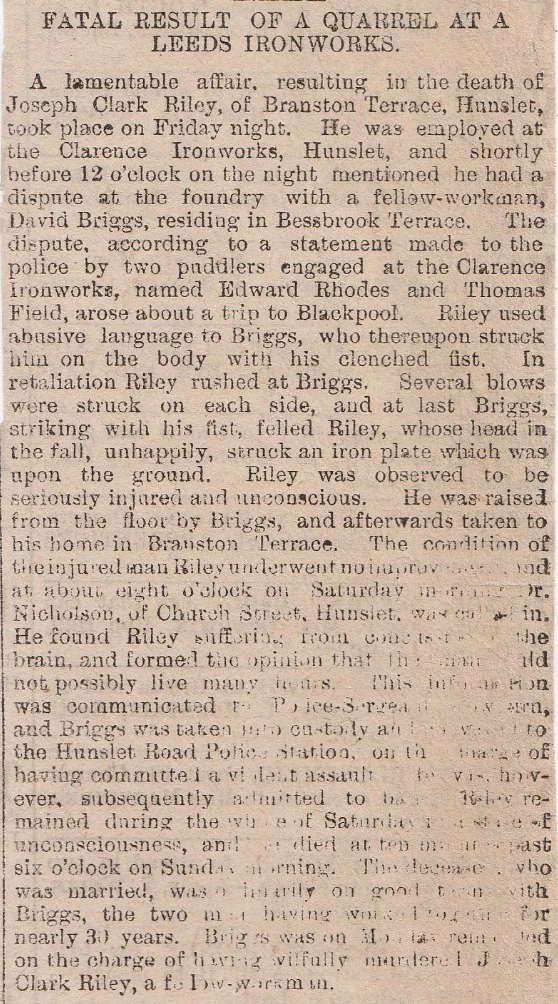
82/ Near Bradford (Kids Mutilated by Train) July 1859
This is a tragic accident that occurred near Bradford and resulted in the deaths of three children. The kids had been playing near a narrow arched tunnel when a train approached they entered the tunnel and squeezed up to the sides to let it pass through. The guard had put a wooden bar in one of the wheels, to act as a break, and the children were in the direct line of it and they were struck. The little ones stood no chance as the bar ploughed through them. One was decapitated and the others were just a pile of flesh and bones and barely resembled children. Accidental death.(Names?/Tunnel?)
83/ Leeds Accidents and Fatalities, November 1901
Another typical week in Leeds in the winter period. A Hunslet miner killed his wife and then committed suicide. On the same day, a young school-teacher threw herself in front of an oncoming train and was killed instantly. In Armley, the wife of a commercial traveller had an epileptic seizure and fell into the fire. Her face is dreadfully burned. Also in Armley, a moulder stabbed his missus with a pen-knife during a heated argument. She remains in a serious condition. Then a woman leapt from a window in Meanwood Road and she too is in a precarious condition and has serious head wounds.
84/ Huddersfield, (Hoist Death) January 1885

85/ Spink Street Murder, White Abbey, Bradford, December 1907
A young married woman named Mary Risden was found dead on the floor of her house, beaten to death with a poker. The murder weapon was lying by her side when police entered the building. Her husband, George Risden, has been arrested and charged with her murder. Apparently, on Friday night they had been out for a drink and something triggered off an argument, this turned violent as he beat her with the poker. He went to a hospital to get his wound dressed and he was arrested as he was legging it down the road trying to escape.
86/ Grantham Arms Suicide, Leeds, December 1855
On Sunday the 23rd December, a scruffy young man walked into the Grantham Arms in Leeds and called for a pipe, then sat in front of the fire. He put the poker in the fire and sat there staring into the flames for about ten minutes. Then he pulled out the poker, now glowing red-hot, and shoved it down his throat. The injuries were severe burns to his tongue and throat and these proved to be fatal. All that is known about the fella is that his name was Thomas Barker and he was from Bolton.
87/ Wakefield, March 1885
Yesterday the inquiry was resumed at the Wakefield Police Station on the body of Mary Aldane, widow of John Aldane, a fish merchant and smack owner from Hull, which was found in the River Calder at Wakefield last Saturday bearing marks of violence. The jury returned a verdict to the effect that there was no evidence to show the cause of death.
88/ Baildon near Bradford, (Wife Murder/Suicide) April 1885

89/ Leeds, (Corpse Springs to Life) March 1847
Cracking story of a police surgeon being called to examine the dead body of a woman who had cut her own throat open. She was on the bed, he pronounced her dead and she was left on the bed in readiness for the coroner’s jury to view it. One of the policemen on duty asked to see the “dead body”. On seeing the body breathing, she was whisked off to the hospital and is now doing quite well. If the young copper hadn’t been so eager to view a dead body, she would have literally lay there and bled to death. But then again she wanted to die so it could be said that he has not helped her in the slightest.
90/ Albert Buildings Lift Death, Bradford May 1902
Three workmen were ascending in a lift to the top-floor of Albert Buildings in Bradford when the wire rope snapped and the men and the cage dropped from the fourth floor to the basement. Daniel Judge was killed, but the other two have sustained no serious injuries at all. (Is it still there?)
91/ York Street, Leeds, (Nightie Set Alight) August 1889
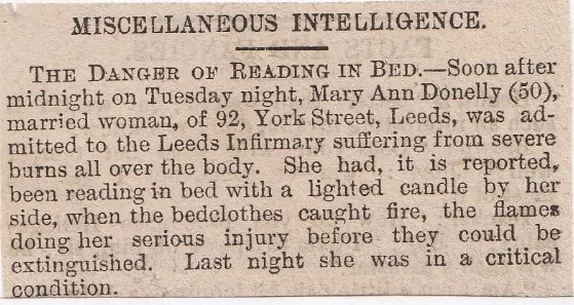
92/ Spinkwell Tavern Manslaughter, Bradford, July 1880
An argument got out of control at the Spinkwell Tavern in Bradford one Saturday night. One man named Horsfall and another named Newton were arguing about a game, when Horsfall said that he would blind Newton with a pint glass. They both faced off to each other and Newton punched Horsfall twice in the face. Horsfall dropped like a stone with his head on the table and within ten minutes he was dead. Newton was arrested by police and is custody.
93/ Keighley, (Footballer Died while Playing) December 1906 (Ten Thousand Mourners)
The funeral of the late captain of Keighley Football Club, Harry Myers, who died from injuries sustained whilst playing, evoked a huge public outpouring of grief as an estimated 10,000 people lined the streets to pay their respects. The two-mile route from Ingrow to the cemetery was packed solid with mourners and the Mayor of Keighley, members of the Referees Society, players from Dewsbury, Bradford, Bramley and others also came. The Keighley team were the bearers and the service was held at Keighley Parish Church.
94/ Elland near Halifax, (Man Dies in Roof Collapse) December 1885
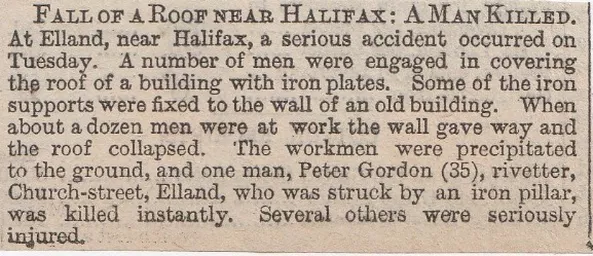
95/ Bradford Midland Station, (Childs Body in Box) February 1895
A shocking discovery was made at Bradford Midland Station one morning. The eight o’clock London express had just trundled into the station when an unaddressed cardboard box was found under a seat and was dropped off at the cloak-room. Several days later a porter tried to obtain some sort of clue as to the owner, so he opened it. Inside was fully developed child wrapped up in fine linen. Police are investigating.
96/ Kirkstall Road Murder, Leeds, October 1893
On the premises of Messrs.Nichols and Beckworth’s tannery lived a husband and wife by the name of Thompson, who were sort of caretakers. One morning the milkman found Mr Thompson lying in a pool of blood and Mrs Thompson by his side, unconscious, but still breathing. Also nearby was a blood-spattered hammer which was the weapon with which they were attacked. Thompson was already dead, with his skull smashed to pieces and she also had head trauma, with furniture covered in blood, showing that a struggle had taken place. When I said the hammer was nearby, it was actually in another room altogether, the scullery. Police still couldn’t work out what exactly had happened here. It seems that the couple had gone to bed then there was a knock on the door, Mr Thompson went to see who it was and was attacked and battered to death. Then Mrs Thompson was attacked by the same assailant. (Was it ever solved?)
97/ Honley, near Huddersfield, (Gets Off a Murder Charge) April 1892
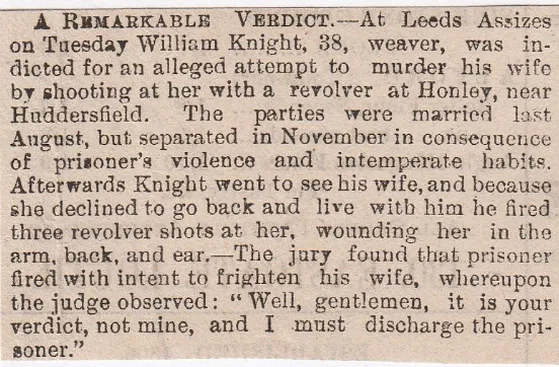
98/ Bradford Double Suicide, October 1886
Sixty-six-year-old Hetty Robinson and 21-year-old Elizabeth Ann Hirst, mother and daughter, were both discovered drowned in the canal. Hirst, who was married a short while ago, left her husband a note saying she was unable to make him happy and that both she and her Mum had arranged a suicide pact.
99/ Leeds Murder/Suicide, November 1901
John William Langley aged thirty-five of 14, Disraeli Street on Dewsbury Road, killed his wife by slitting her throat with a razor. He then cut his own throat but survived until he was rushed to a hospital, where he died in the operating room. They had separated but then reunited together again. There was a third person involved in this tragedy, and it was another woman in the house at the time Langley did this and she too was threatened with the same fate if she interfered. When Langley cut his throat she ran out and started screaming “Murder!”. Who was the woman? An ex of Langley’s?
100/ Hebden Bridge/Mytholmroyd, (Mutilated Body) November 1876
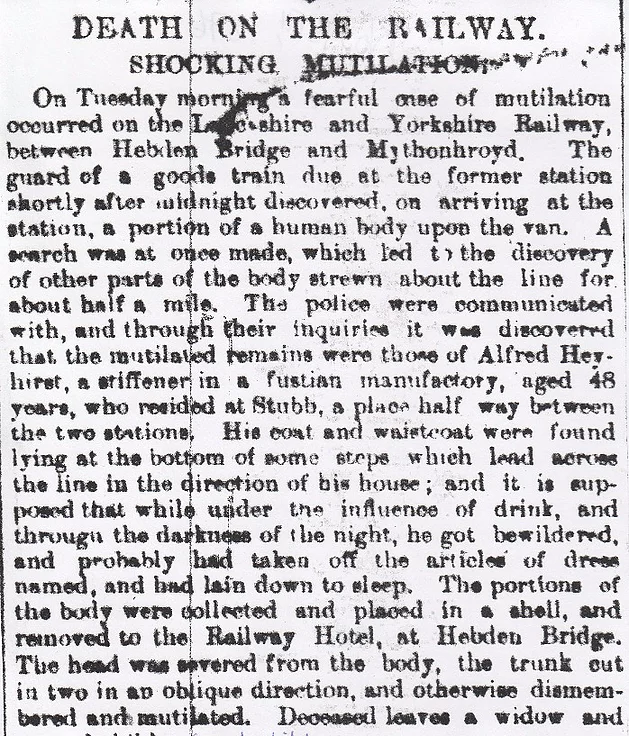
several children.
101/ Wakefield Prison Suicide, June 1887
Thomas Redfearn was a cattle drover from Penistone was up on a charge of sheep-stealing he was sent to Wakefield Prison. He seemed to be in an OK mood, or so the warder seemed to have thought, because next morning he was hanging in his cell from a gas pipe on the wall, with a noose made from his handkerchief. He wrote these few misspelt lines to his Mum:-
“Eliza Redfearn, the Old Crown Inn- My der mother, I rit thes few lines to you oping find you in good elth as levs me at present, give my best luv to you all. You come and see me sone as you can, I ma not see you a gain from youre affectnot sone, Thomas Redfearn”.
102/ Otley Triple Murder/Suicide, May 1905
At Otley, one Sunday morning, the wife of a police-sergeant named Carter, came running out of her house holding her hands against an awful gash in her throat. Neighbours rushed to her aid and went inside to find the children. All three were dead, with their throats cut by their father and when they found him he lifted the razor and sliced his own throat. The children aged seven, five and three, had their heads smashed in first, then their throats cut. The man and woman were rushed to the hospital and will both survive. Carter got promoted to police-sergeant last month and was sent for an assessment at Menston Asylum. Doctors gave him a clean bill of health and sent him home. (Did they survive?)
103/ Halifax Gasworks Fatality, June 1885

104/ Between Armley/Kirkstall, (Suicide Letter) November 1877
Luke Ripley, a book-keeper, worked for Clough Bros, corn millers of Farnley. He went missing two weeks previously and he had been down in spirits for this period. Sarah Graham, his sister and housekeeper was sent a note by him, which read:
“October 20th, 1877- My Dearest Sarah,- I am an honest man. I had an arrear in my cash last Saturday of 21 shillings, which I can’t make out. I wanted to give it to Mr Clough tonight, but he would not take it, and from the manner in which he spoke to me I fear he suspected me of dishonesty. That I cannot bear. If, after seventeen years of faithful services, he will declare it, I shall soon have to meet my Lord and Judge, who knoweth all things. I trust in him whom I have loved and served, though imperfectly. Dear Sarah, you must struggle on, but it will not be long. I hope and believe we shall meet in heaven. The Lord bless you- Your dear brother, as ever, L.Ripley”. He was found in the river between Armley and Kirkstall.
105/ Harrogate/Leeds, (Death Through Eating Vanilla Sandwich) June 1885
Yesterday morning Emily Chappell aged seventeen, the daughter of a Harrogate draper, died, it is alleged, through eating vanilla sandwiches purchased in Leeds. Mrs Chapell and her youngest children, Annie and Charles, also became ill after partaking of them. The last named soon recovered, but the others remain in a dangerous state.
106/ Whitwood Square Wife Murder, near Wakefield, June 1885

107/ Aire and Calder Canal, near Barnsley, July 1885
Tom Lundy, assistant lineman, employed in the Manchester, Sheffield and Lincolnshire Telegraph Department at Barnsley, died yesterday at Becket Hospital from injuries received on the previous afternoon whilst bathing in the Aire and Calder near Barnsley. The deceased dived into the water and coming into contact with some hard substance injured his spine.He was single and aged twenty-seven.
108/ Huddersfield Railway Death, August 1885
On Saturday night Tom Parker, a cleaner at the Huddersfield tram-sheds, met with his death in a shocking manner. One of the engines had come into the shed but had got on the wrong line and while it was being shunted onto the right line, Parker somehow got into the pit as the engine being passed over it and before he had time to get out of the way, the engine crushed him so badly that he died on his way to the Infirmary.
109/ Bradford, August 1884 (19th Century Sawn-Off)
A policeman in the Barkerend part of town heard a gunshot at about 5-20 p.m. When he got to the spot where the sound came from, there was a man lying in the road in a pool of blood. He had a gun in his hand, but it never had a barrel. What had happened was, that the gun was put in his mouth and had been loaded so full that the whole back of his head was completely blown away. The barrel was several yards away. The post-mortem examination revealed half a pound of gunpowder in his pocket and a piece of paper with,”Joseph Richard Denton, late of Little Horton” written on it. He was a grey-haired gentleman, about sixty-years-old and smartly dressed.
110/ Fulstone near Holmfirth, (Triple Murder/Suicide) December 1881
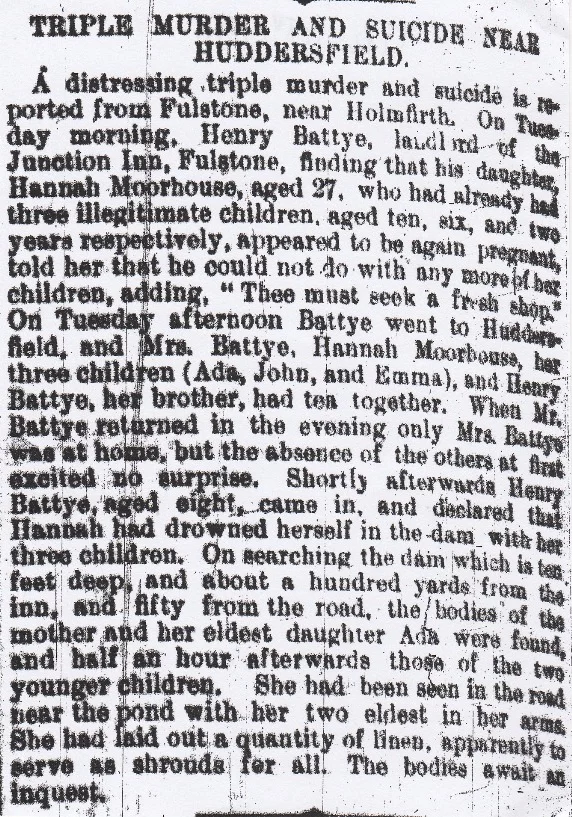
111/ Liversedge near Cleckheaton, (Body Found in Mill) October 1883
A mill that was ravaged by fire three years ago and lay in ruins, had two men trespassing in it, for the purpose of getting an old boiler out of it. The grating in front of the boiler had been moved and on checking the inside, they thought it was a dog’s skeleton. They pulled it out and were horrified to see it was human. They fetched police to examine it and it was dressed in women’s clothing and was taken to a nearby inn to await further examination. About two years ago a young lass who worked at a neighbouring mill and who lodged nearby, suddenly vanished off the face of the earth. The persons that she hung around with have all left the district at the same time she disappeared and police are looking for those people to help with their inquiries. (Who was it?)
112/ Bingley Railway Fatality, December 1885
Yesterday afternoon a shocking accident happened on the railway at Bingley near Bradford. As the Barrow express came in, a young woman named Haxby, a servant in the employment of Mr Wildman, manufacturer, was trying to save her dog from harm when she was knocked down by the express and killed instantly. A foreman porter had his arms broken in attempting to save her. The dog was also killed.
113/ Windhill, Bradford,(Teenage Girls in Canal) November 1891
An inquest was held on the bodies of Minnie Toulmin aged fifteen of Baildon and Alice Worrall aged fourteen from Windhill. Minnie was fired from her job on October 5th and went straight down to the river and dived in and drowned herself. Worrall went to church at eight o’clock on Sunday evening and was seen chatting with a young man. Her father told her to go home, but she didn’t go and was afraid of the consequences. She told others that she would rather drown herself rather than face the wrath of her father. She was later found floating face down in the canal.
114/ Leeds Child Murder, June 1891
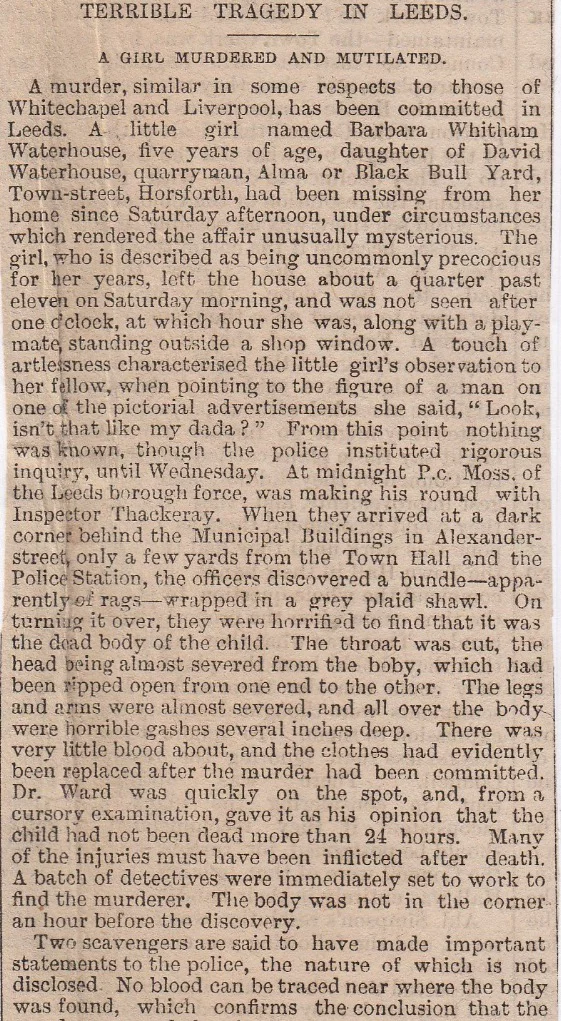
murder occurred elsewhere.
115/ East Parade Mills Suicide, Huddersfield, September 1885
On Wednesday afternoon Isaac Swallow aged forty-five-years, the station-master at Kirkburton near Huddersfield on the London and North-Western system, went into the yard of East Parade Mills in Huddersfield and there committed suicide by shooting himself with a pistol. Deceased, who was a single man, resided with his father at Deighton.
116/ Farnley Forge, Leeds, (Molten Metal Suicide) November 1854
George Towler of Parnley Wood, who was single and twenty-two-years of age had been labouring under insanity for some time.This manifested itself when on a Saturday night when two workmen at the Farnley forge heard a noise at the front of the furnace and looking out the window they saw Towler, stark naked. They tried to grab hold of him but he leapt head-first into the furnace, which had fifty tons of molten metal in it. Try as they might to extract him, it was a few minutes before they pulled out his spinal column and skull. These were charred black and were not even recognisable as being human.
117/ Brotherton Drownings, Pontefract, August 1885
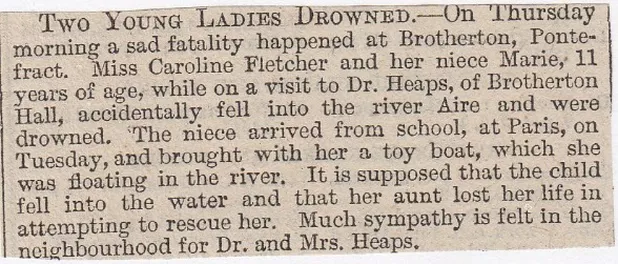
118/ Bradford Teenage Suicide, November 1891
Eliza Keighley aged seventeen from Cowley Road, Windhill, was found drowned in the canal at Windhill. One of her co-workers at the mill, Bertha Holden, said she was going to look at the body of Alice Worrall (see Windhill, just above). Keighley said in a calm and straightforward voice- “I’m going to drown myself in a day or two” and then made her promise to go and view her body when she was found in the canal. Another witness said she said the same to her and that this was all down to getting paid three shillings instead of eight shillings. She was suspected of fraudulently obtaining a ticket to get the other five shillings, which was being paid back anyway. Keighley refused the money that Mr Ogden, the owner of the mill, was going to give her and he thought that she was acting suspiciously, already having a ticket and told her it didn’t look good against her name. That same day she went and drowned herself.
119/ Leeds, December 1880 (Victorian Immorality)
A couple of cases went through the Leeds Corporation (Watch Committee) that sort of defy belief. The first one was a fourteen-year-old girl whose own father was the parent of her child! Even worse was to follow when a girl of sixteen, who shared a room with her Dad and brother, also became pregnant. The father of the child was either her father or the brother, she didn’t know which! These are times when women or girls had very little say in society and children were seen in most cases as a hindrance to the family. There was no contraception of any kind as we know it today and abortions would be some kind of back-street operation, that sometimes ended in death as they were botched up.
120/ Leeds Fatal Shootings, May 1885
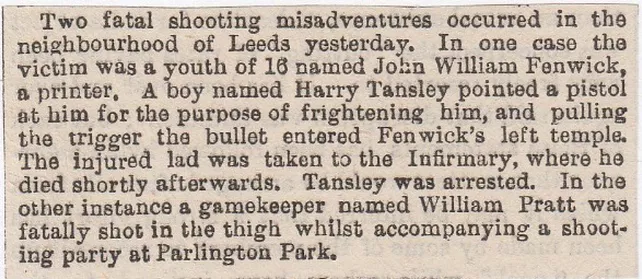
121/ Roebuck Inn Human Remains, Bradford, July 1870
Workmen were knocking down some old buildings near to Market Street and Ivegate. One of the men was helping to demolish one that was adjoining the Roebuck Inn when his pick-axe went through the floor of the old inn and into an upper room used as a waste-room. He spotted a pair of human skeletons and he carried on chipping away, eventually, they were reduced to small pieces among the rest of the rubbish. Two human skulls remained intact, one female and one male, and a pair of arm bones. (Does anyone know who or where the skeletons now are?)
122/ Kirkstall Forge Ironworks near Leeds, (Shocking Death) March 1853
A horrific accident occurred at the Kirkstall Forge Ironworks near Leeds, to twenty-eight-year-old William Merritt, who worked near a steam-powered shaft that rotated a piece of metal for some purpose or other. Merritts clothes got snagged on this rotating shaft and he was spun round and round at a heel of a rate of knots. When he was taken from the machinery, the trunk of his body was in one part of the room and his head was in another. Also, one of his arms was torn off.
123/ Leeds Manslaughter, March 1885
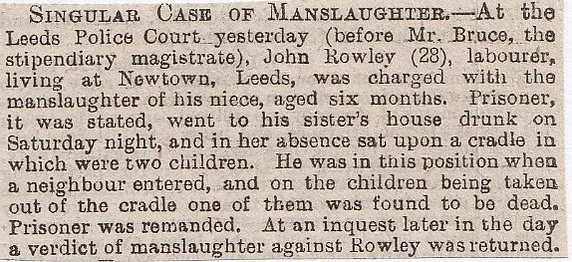
124/ Bradford Teenage Suicide, November 1892
Fourteen-year-old Edith Walker Bell committed suicide by drowning herself in the canal, all for the love of a boy her own age. She had been seeing the boy next door for quite a while, but when she strolled in late one night she told her Dad that she had been kept behind at work. The father shouted at her that he’d seen her with the boy and not to lie to him, also stating that she was far too young for this type of thing and told her to split up with the boy the very next day. While at work the following day she told a mate of hers that she was off down to the canal, and left a letter addressed to the boy telling him to stay away from her house as her father would “give him a good hiding”. That was the last time anyone saw her alive.
125/ Halifax, (Love-sick Suicide) December 1893
A twenty-two-year-old shop assistant Blanche Edith Shackleton was taken ill one day, then was found dead the following day. On a search of her things, there was a bottle marked “Poison”, which was now empty. The previous day it was three-quarters full and was in a cupboard in the house. Obviously, for young Victorian suicides, it was all down to the love of a man. This man had now left the Halifax area. She left a melancholy letter explaining the situation and her feelings.It read:
“Dear Father and Mother- My punishment is greater than I can bear. I know that I do not deserve any sympathy, but I cannot face this terrible disgrace. Try and think of me kindly. I am not all to blame, although I confess I have sinned past forgiveness. I will try to atone in the other world. When you find this I shall have gone to meet my maker. I have been very happy with you, and have only myself to blame in one respect. Use all my things as you think best. All that is left is yours…..Please pay my doctor’s bill, and try to think kindly of me, Goodbye.- Your broken-hearted, Edith”. (I think she was pregnant as well)
126/ Wakefield, (Carefully Planned Double Suicide) February 1847
George Hampson aged twenty-five, tin-plate worker, had been seeing Susan Morton, twenty-one years of age, for three years and they both lived in Wakefield.
Hampson went to see his girlfriend one evening, but she was feeling ill and she was subject to fainting fits anyway. She asked her sister, Fanny, and Hampson who had hung around, if they wanted to go for a breath of fresh air at around ten p.m. All three went out and Fanny left them alone and went to stay with a friend after half an hour or so, then Hampson and Morton went back to her house. On Saturday morning, a hat and two coats were found on the banks of the Barnsley Canal near the bridge which crosses to Heath Wood. The bodies were close by and they were tied together with four handkerchiefs, embraced in each other’s arms. The knots were behind the girl’s back, which means he tied them up and in his pocket was a pistol loaded with two bullets, powder etc., and a soft paste-like substance was found as well. This all seems to have been carefully planned by the two of them and they took all the options with them to commit suicide.
127/ Leeds Executions, January 1890
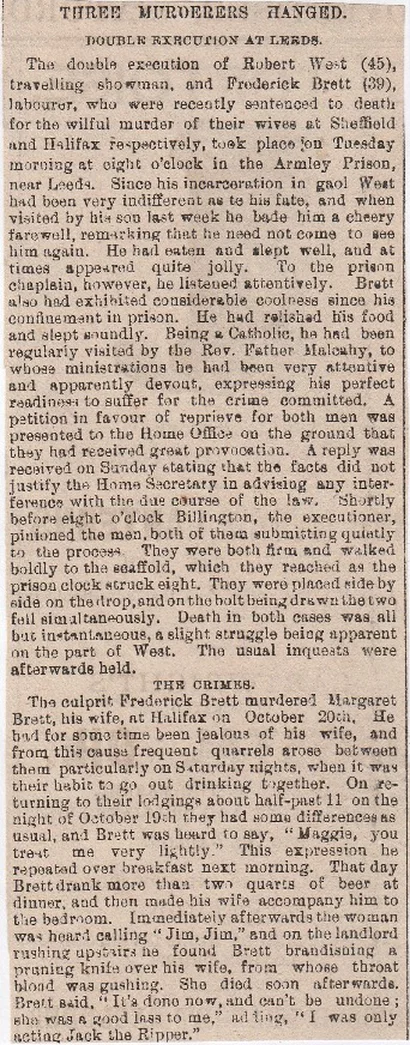

128/ Holmestyes Reservoir, Holmfirth, (Suicide Before Wedding) October 1880
23-year-old Amos Sykes from Holme near Holmfirth had been working at Oughty Bridge and came home on Friday morning, as the Saturday was his wedding day. His mother said that he seemed quieter than usual but there was no indication that he would do anything to himself. Elizabeth Bennett saw him near Holmestyes Reservoir at two p.m on Friday and he was not seen again till the Saturday morning when Ben Earnshaw saw him floating on top of Reservoir. The body was taken to the Moss Hotel where an inquest was held. On Saturday, the wedding party got together, but the groom didn’t appear and the wedding was cancelled. Apparently, insanity ran in the family, as about six years ago an uncle drowned himself in the same reservoir. On the body of Amos Sykes was a pen-knife and it was the same pen-knife that was found on his uncle when they dragged him out of the reservoir.
129/ Stanningley/Farsley, September 1869

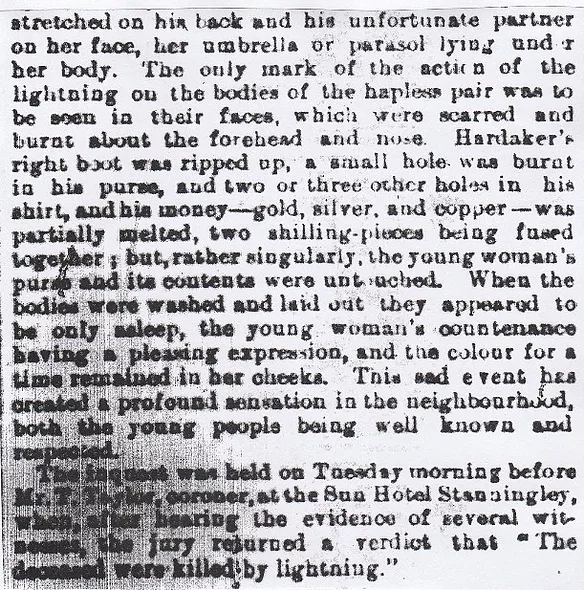
130/ Bingley Child Murder, April 1894
It never ceases to amaze me, how bloody callous and cruel some of the Victorian parents were to their children. I know it happens today, but they just killed new-born children and dumped them like an old mattress would be dumped nowadays. This one is no different. Ruth Ann Oddy and Martha M.Newall both from Shipley and both married, decided to get rid of Oddy’s child in just such a fashion. The poor little creature was strangled by a piece of twine around its neck, then dumped in the canal at Bingley. When they were questioned about the child they confessed immediately. They also told how they put the infant in a basket in a cellar while they decided what to do with it. Oddy tried to smother it first, then after this failed she tied the twine around its neck and strangled it. Then she gave Newall a shilling to dump it in a canal, as far away as possible.
131/ Burley near Otley, (Asylum Escapee’s Suicide) December 1862
A female lunatic named Hodgson from Bradford, made a daring escape from the asylum where she was an inmate. She evaded her attendants and ran towards the River Wharfe going past the lodge which leads to the asylum. The woman who lives there heard the gate close and thought it was her daughter coming back, but then she saw the image of a female running across the road from Burley to Ilkley, then jump into the River Wharfe. She went to look for her but found nothing. A bit further up the river, a man named Mason and some mates of his, saw some female attire by the river-side. They saw her flapping about and threw her a leather strap but she shoved it away, screamed a few more times and then sank. She was discovered next day near to the place she jumped in.
132/ Dean St.Mills, Leeds, (Boiler Explosion) September 1885

133/ Lowmoor Coal & Iron Company Suicide, Bradford, November 1882
An awful case of suicide was discovered at the Lowmoor Coal and Iron Company at Bradford, the victim being 28-year-old William Clegg. He was a boiler-firer at the works but had been depressed about something recently. He got to work at about two a.m. he got to work and stoked up the boiler to get the steam going, they went to his brother’s house, where he resided and had a sleep. His brother went to his work at 6-15 a.m. and told William to have a lie-in, but at 6-40 a.m. a workman by the name of Crowther saw him climbing a ladder to the blast furnace. He shouted up at him, but Clegg ignored him, so Crowther went to get his brother. When they got there he’d disappeared, so John Collins went up to have a look. He recoiled in horror and he saw the skull, teeth and larger bones were floating on the top of the fire. They tried to save portions of the man but as soon as it was picked out, the bones simply crumbled to bits.
134/ Hunslet Lane, Leeds, (Dreadful Death) July 1858
An appalling accident happened at Mr Pratt’s Timber Yard in Hunslet Lane, when James McDonald, a workman there, was torn to shreds. McDonald worked in the saw-mill and he was there on Saturday afternoon trying to replace a strap on one of the drums. He tried this while it was in motion, so it was kind of his own fault, but his arm got entangled and he got pulled around the shaft. His body was mangled and torn to bits. They tried to get the body out in one piece but the legs fell off as soon as he was removed and both arms were crushed, as was the rest of the body. There wasn’t a bone that was not broken or smashed up, by the poor fellow’s terrible ending.
135/ Marsh Mills Foundry (Chimney Fall), Cleckheaton, February 1892

The workmen on the foundry and machinery side of the estate having escaped injury, they at once
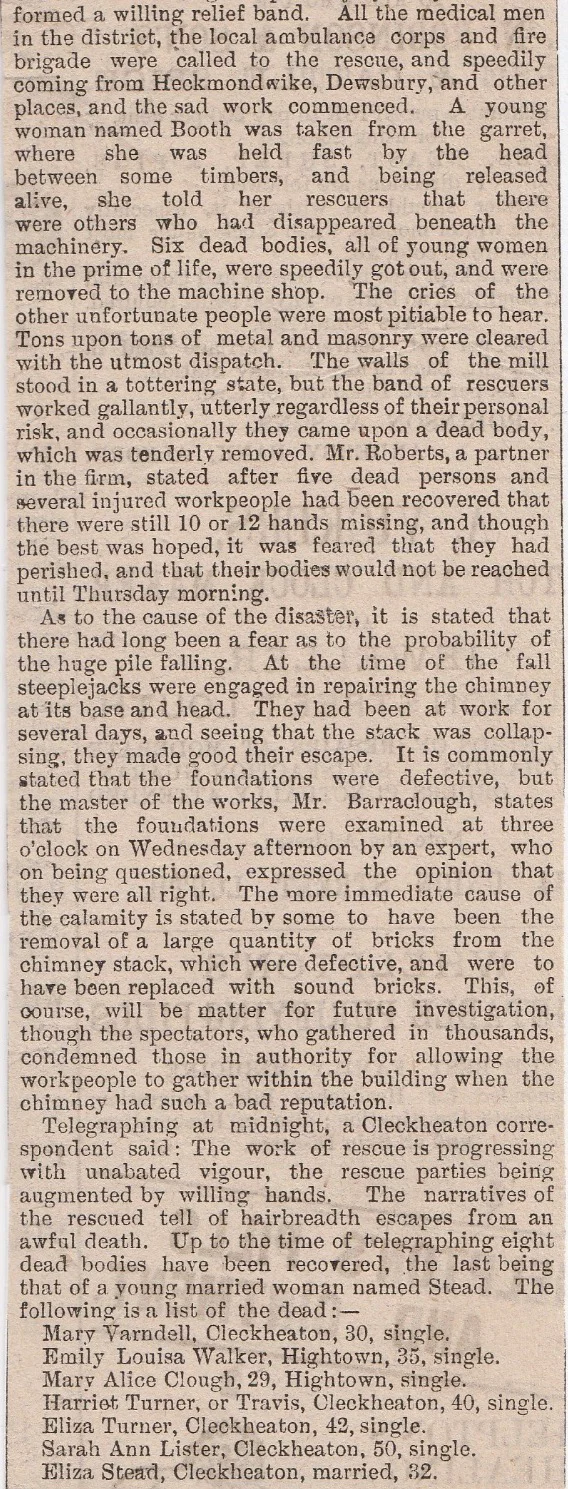
136/ Bradford, (Overkill Suicide) November 1891
This is a sad story of the suicide of an 18-year-old woman named Louisa Wade who poisoned herself at Bradford. She was seeing a school-master named Harry Turner for around six months, but about a week ago she got a letter from Turner saying that he wanted to break up with her. The doctor was told by the girl that she took a teaspoonful of strychnine, which could easily kill a hundred people or more. This is the fourth case of suicide of a girl in Bradford within the past week.
137/ Ivegate, Bradford, (Suicide) November 1870
Rose Hannah Atkinson aged eighteen came from Liverpool to Bradford as she had got a job as a chambermaid at Joseph Hartley’s eating house at Ivegate in Bradford. She had a terrible habit of not putting the money the customers gave her for their meals in the till, but keeping it for herself. Mrs Hartley told her that enough was enough and to leave the premises the next day. Atkinson became depressed at the fact that she was miles from home, no money and no job. While she was packing her stuff she thought that suicide was the best option and she plummeted from the sixth storey window onto the pavement below. When lifted up, her right arm was fractured and she had a stocking fastened around her neck, and one leg was bare, the other on her leg. She was taken to hospital but died half an hour after being admitted. “Temporary Insanity.”
138/ Leeds Bank Murder, March 1920

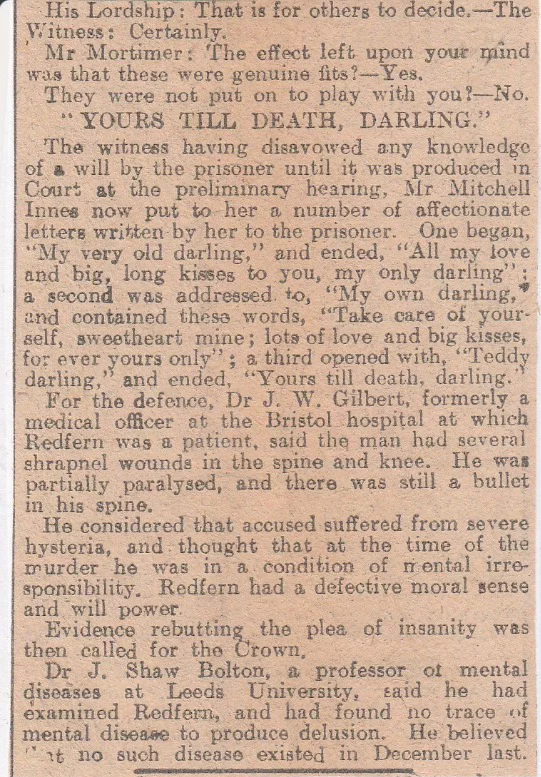
139/ Princess’s Concert Hall Cannonball Accident, Leeds, February 1880
John Holtum, a gymnast, who is widely known as the “King of the Cannon”, laid down a bet of £50 to anyone who could do what he does and catch a cannon-ball fired from a cannon. Yes it’s true! Elijah Fenton was in the Princess’s Concert Hall one night and he thought he could do it. Three men stood up with him and Elijah went first. The seven-pound cannonball was fired at him, while he was six yards away and he gave the ready call, but this cannon-ball smacked him on the head and knocked him unconscious. He was taken to hospital as a precaution but he seemed to deteriorate quickly. It was discovered that his skull had been fractured and the chances of him living were remote. Holtum ended up in court promising not to do the act again, but he mentioned that he’d been doing it for several years and nobody was ever injured. (Did Fenton die?)
140/ Bradford Tram Accident, November 1885
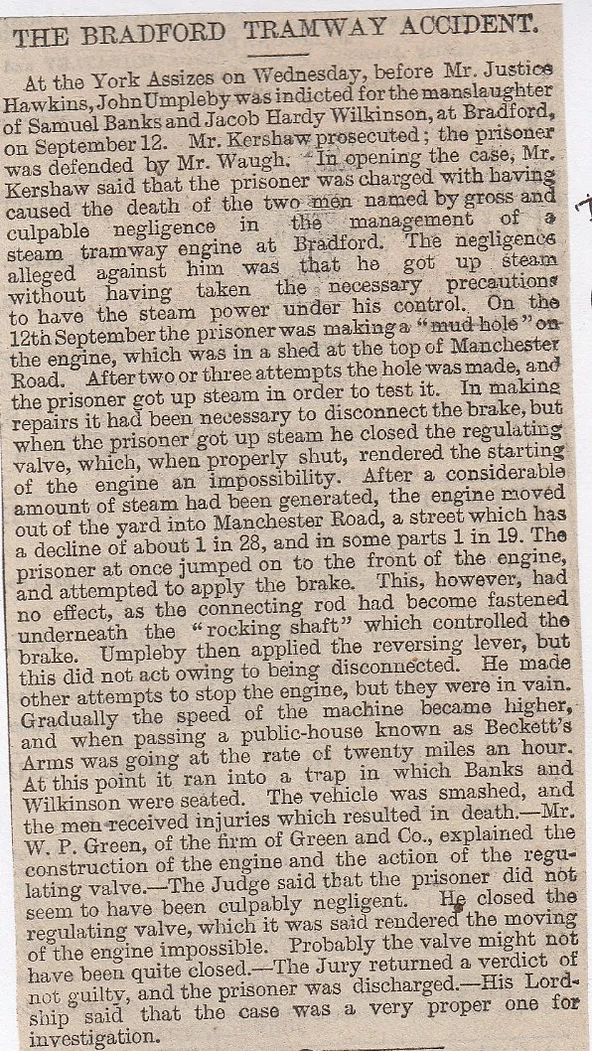
141/ Gelderd Road Suicide, Leeds, November 1864
Twenty-two-year-old George Hibbert Lawton was a hotel waiter at Garrett’s Boarding House in Wellington Street, Leeds. Here he met one of the maid’s, Priscilla Garnett, and they soon became an item. A couple of months ago they got jobs elsewhere, he went to the Saddle Hotel and she went to the Wellington Hotel in Leeds. He had asked her to marry him a couple of times but she said no, due to a lack of a roof over their head. He went to the Wellington Hotel to ask her a third, and last, time. Again she refused his offer and this time he completely lost it, saying that she was lucky to be on her boss’s premises otherwise he “would have made an end of her”. Lawton stormed out saying that she would never see him again, and Priscilla thought no more of it and went back to work. His body was found on the line on the railway bridge which crosses Gelderd Road in Leeds. He calmly laid his cap at the side of the rails, placed his head on the line and let the engine run over his head. The skull popped like a zit and brain matter was found a couple of yards away. In his pocket was a letter to “J.H.Lawton, Wellington Hotel, Wellington St, Leeds”.
“9, Wellington street, Mrs Wood’s Temperance Hotel-
Whoever finds this my Boady make it none at wonce and convey it To the Wellington Hotel, Wellington Street, Leeds and My god have Mercy on My soul and My god grant my power Father soport under this Afflection. Priscilla Garnett is the cause of this. I will aunt her at night she as something To answer for-signed G.H.Lawton.
The father who lives in Cheshire and was in such poverty that he had to walk to the inquiry, said that he’d always been of weak mind and an illness three months ago made him worse.
142/ Kirkgate Railway Station Suicide, Wakefield, February 1882
A complete stranger to the area of Wakefield aged in his mid-thirties went into a waiting room at Kirkgate Railway Station and proceeded to blow his brains out with a revolver. One clue to his identity was the buttons on his trousers had a tailors address in Ludgate Hill, London plus a couple of bills with London addresses on them. On the Sunday at 3-45 p.m. he asked the porter, James Clarke, where there was a fire at the station as he was freezing cold. He told him to go to the waiting room and he followed the instructions. John Longbottom, another porter, was lighting the gas-lamps when he heard a gunshot from the waiting room. He was found on the floor, groaning in agony, with a large hole in his forehead and blood oozing from the wound. Dr Hollings was summoned to examine the body, which had pieces of the brain that had gone through the hole into his hat. He lingered on till about 6-45, then passed away, with the body whisked off to the Mortuary. There was no letter or identification left on the body, but some loose change, a box of cartridges, notebook, purse and a photo of a female. It was premeditated suicide and he was determined that he wouldn’t be identified after his death. (Who was he?)
143/ Huddersfield Railway Station Death, August 1885
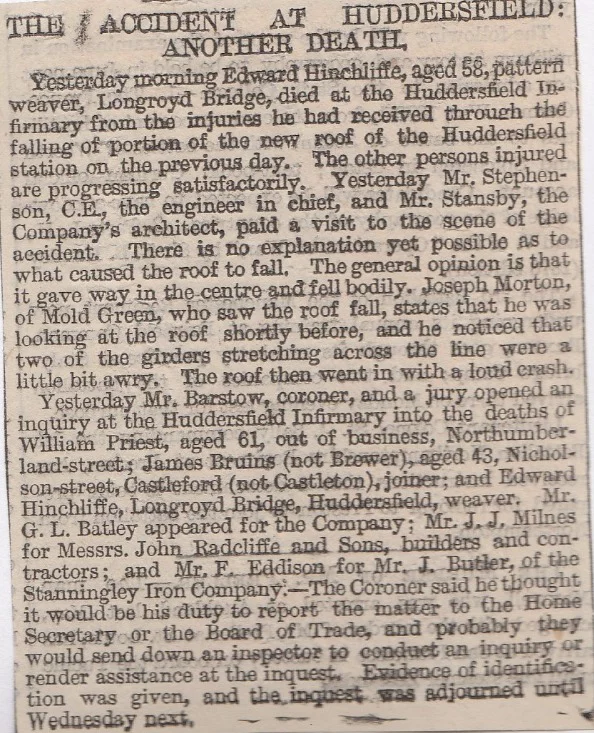
144/ Leeds Wife Murder, August 1890
At Leeds Assizes on Monday, Samuel Harris aged thirty was charged with the murder of his wife at Leeds on the 9th of May. The prisoner and his wife had lived unhappily together and he had been in prison for assaulting her. On the day named, he suddenly attacked her with a knife, inflicting seventeen wounds. He also attempted to murder his child. He was found guilty and sentenced to death.
145/ Berry Brow, Huddersfield, (Attempted Murder/Suicide) July 1895
Berry Brow, a suburb of Huddersfield, was the scene on Tuesday of an attempted murder and suicide of a fish-hawker, named Fenton Rowbottom aged fifty-six. He had been married thirty years and was separated from his wife whom he assaulted and threatened on several occasions. He went to the cottage where she was living with her three daughters. Being foiled in an attempt to gain admission, he waited until his wife opened an upstairs window to tell him that she would have nothing more to do with him and he then discharged a pistol full in her face. He ran off and was subsequently found in a lonely lane quite dead, having shot himself through the head. The pistol was loaded with gravel instead of shot. Mrs Rowbottom will survive.
146/ Walsden near Todmorden, (Three Lads Drown) July 1889
Early on Saturday morning, three little boys named James Stephenson, Abraham Crossley and Ernest Greenwood were found dead at Gadden’s Mill dam near Walsden. The boys were last seen alive on Friday at noon by their parents who thought they were going to gather bilberries. It is presumed that they fell into the water accidentally.
147/ Holme Lane Chapel Death, Bradford, December 1885

148/ Saltaire near Bradford (Horrific Accident) August 1870.
149/ Brighouse Railway Death, October 1870.
150/ Murder in Bradford, December 1870 ( Patrick Riley was found guilty and was sentenced to death a couple of days later)
151/ Four Die in Hunslet Gas Accident, November 1870. (Jury Verdict, later on, deemed it to be “Accidental Death”)
Yorkshire (South)
1/ Oaks Colliery Disaster, Barnsley, December 1866
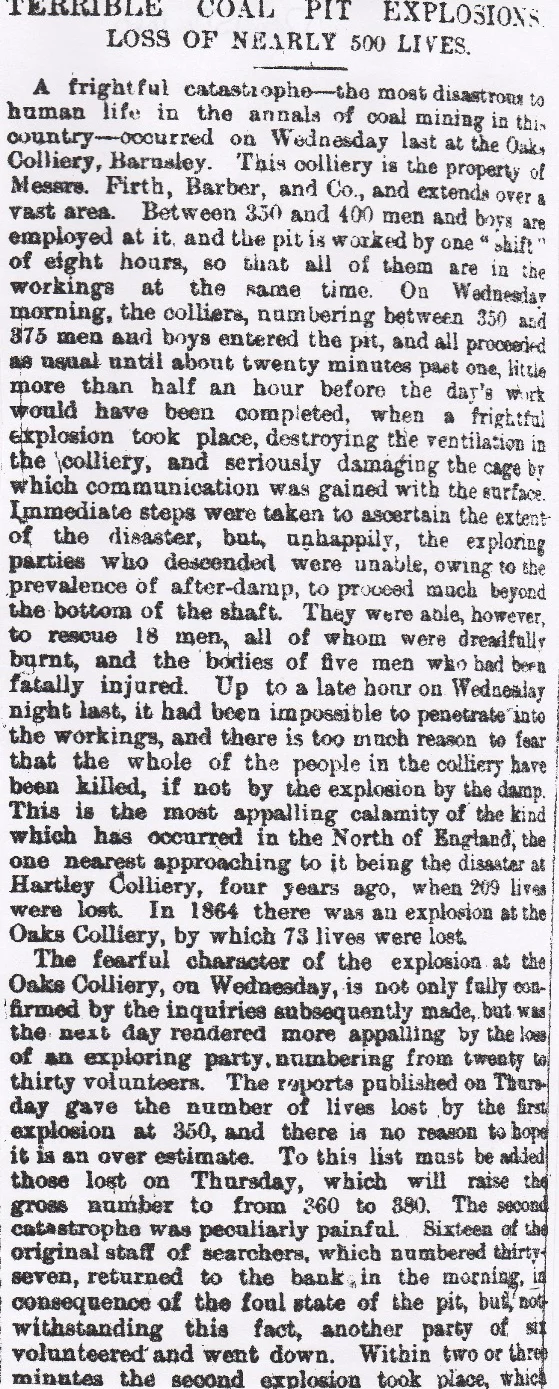
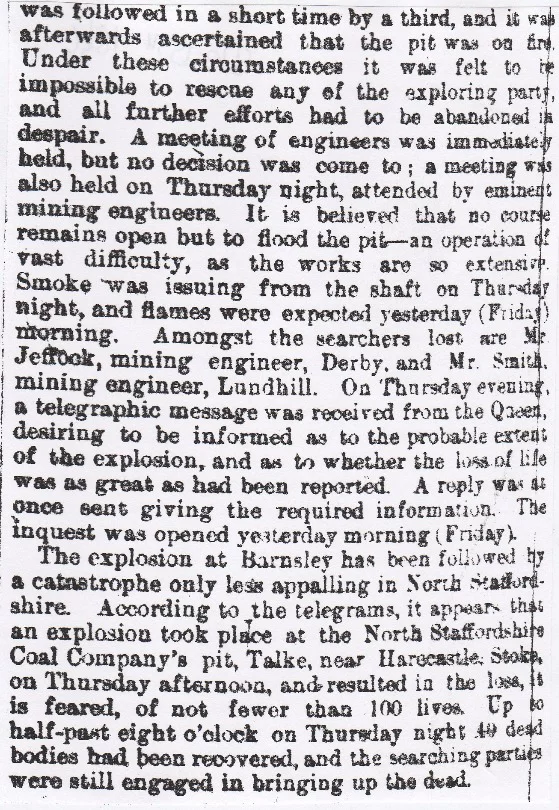
2/ Masborough near Rotherham, (Hotel Death) December 1916
At the Queen’s Hotel, Masborough near Rotherham, Mrs Laura Athey, the landlord’s married daughter was found dead, sprawled across the fireplace in her bedroom. (Is it still there?)
3/ Victoria Station, Sheffield, (Child Remains) August 1876
The mutilated remains of a ten-month-old child were discovered in one of the waiting rooms at Victoria Station in Sheffield. The limbs had been severed from the body and are missing. It was wrapped in a shawl and was very decomposed.
4/ South Yorkshire Asylum Manslaughter, Wadsley, October 1885
An inquest was held at the South Yorkshire Asylum, Wadsley, on the body of John Manley, a lunatic who was found dead in bed with his head pressed between the wall and the bedstead. The post-mortem revealed that he died from strangulation. Another inmate was witness to what happened and he stated that another inmate named Brookes rose from his bed in the night and strangled Manley. The coroner said that the law held Brookes to be irresponsible and a verdict of manslaughter could not be returned against him. The jury found the evidence was insufficient to show how death was caused.
5/ Barnsley Murder, July 1887
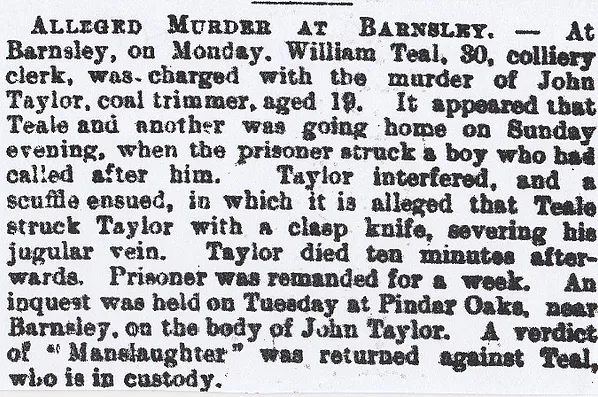
6/ Sheffield Steel Factory Explosion, September 1887
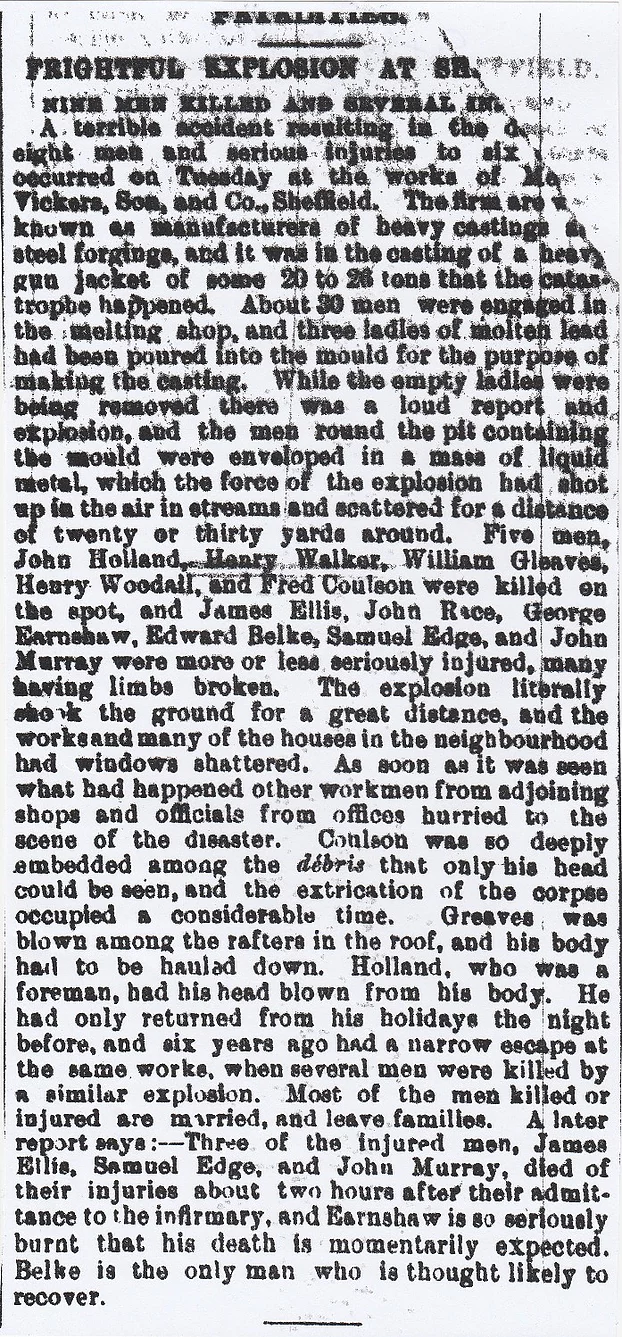
7/ Monk Bretton Murder, near Barnsley, April 3rd, 1899
Yesterday forenoon the body of a widow named Mary Ann Whitehead aged fifty-eight, of Barnsley, was found in a disused quarry at Monk Bretton near Barnsley under circumstance which points to murder. The woman was last seen at nine p.m. on Saturday, being then intoxicated. There are marks on her throat suggesting strangulation and her purse and money have been taken. Her hat was found several yards from the body.
April 4th, 1899
At Barnsley yesterday Richard Thomas Wormald, glass hand of Monk Bretton was remanded on a charge of wilfully murdering Ann Whitehead, widow, of Barnsley. It is alleged that the parties were seen together on Saturday night and the woman was found dead on Sunday morning, having been strangled and robbed.
April 11th 1899
Yesterday at Barnsley, a glassblower named Richard Thomas Wormald was committed for trial on a charge of murdering a widow named Whitehead aged sixty-two on Saturday the 1st at Monk Bretton, a colliery village near Barnsley. it was stated for the prosecution that Mrs Whitehead and Wormald were seen to leave a pub at Monk Bretton and walk together in the direction of a disused quarry where on the following morning the woman’s body was found, having been found strangled and robbed. The accused protested his innocence saying he left the house after the woman and went for a walk in the village.
8/ Holbrooke Colliery, Killamarsh, March 1885 (Any deaths?)
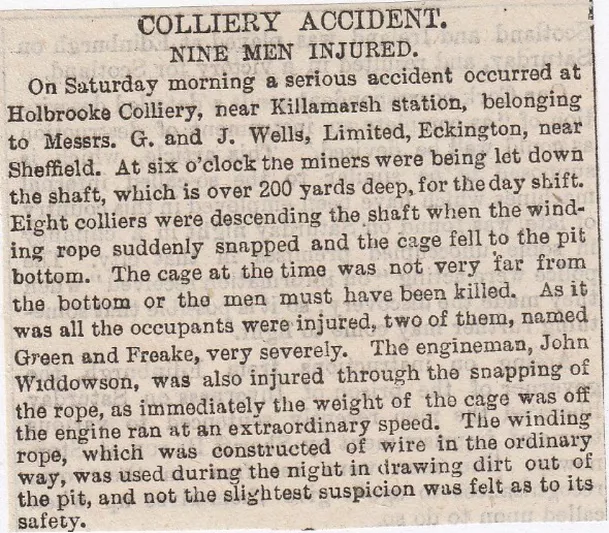
9/ Sheffield Suicide, December 1851
This is the story of a suicide of a young girl in Sheffield who was charged with pinching an accordion from a playmate, which she denied ever happened. Her parents told her off and read her the riot-act, so she walked into the garden and committed suicide by drowning herself in a well.
10/ Greaseborough near Rotherham, (Air-Raid Suicide) May 1919
An engine driver named Richard Seddons from Greaseborough near Rotherham had been suffering from a nervous breakdown which was caused by worrying about the German air-raids over Yorkshire towns and cities, was discovered drowned in a dam. Apparently, he had threatened to do himself in before, so the verdict of “Suicide during Temporary insanity” was returned.
11/ Wincobank Station Fatalities, March 1885

12/ Mexborough, (Triple Murder/Suicide) November 1904
Here’s a man with a great Northern name of Walter Trubshaw. He was a 35-year-old commercial traveller who resided at Mexborough and battered his wife and two kids to death with a policeman’s truncheon and then slit his own throat with a razor. Trubshaw died on the spot, but the other victims clung on to life for a while and then died from their injuries. Ethel Hill, a fifteen-year-old servant heard screaming and shouting and her mistress yelling “Ethel, come quick!”. She found Trubshaw beating his missus with a truncheon, then when he spotted Hill, he went for her. She managed to evade him but also heard the four and two-year-olds crying out “Oh, Dada!”. Hill managed to raise the alarm with Mr Ellis, a neighbour. What brought this on is a complete mystery as he absolutely adored his wife and children, but it is thought he had become insane.
13/ Doncaster Racecourse, (Death from Excitement) October 1875
On Monday afternoon at the Grimsby and Cleethorpes race just before the final event was announced to take place, the treasurer to the race fund, Mr John Hailstone, fell down in what was supposed to be a fit and died almost immediately. Disease of the heart is said to be the cause of death. Deceased had just won, having backed the first horse- Murino, in the race for the Member’s Plate. He was about forty-years-old, married and leaves a widow and family. It is thought that his untimely death was produced by excitement. The last race for the Scurry Stakes, was not, of course, run.
14/ Sandall Drownings, near Doncaster, December 1900
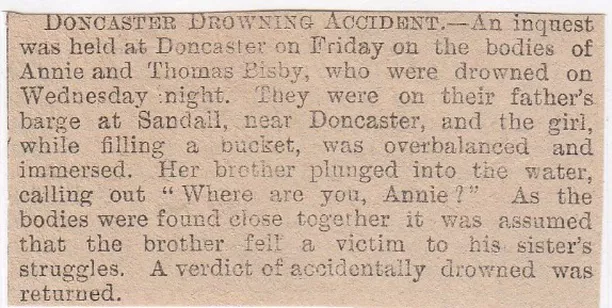
15/ Kiveton Park Railway Fatality, Rotherham, December 1876
On Monday morning the mutilated remains of a man were found lying on the main line of the Manchester, Sheffield and Lincolnshire Railway, near Kiveton Park. The arms and legs are completely cut off and the body shockingly disfigured. The remains are believed to be those of a miner named George Brown of Shireoaks, who must have been trespassing on the line at the time he was killed.
16/ Sheffield, December 1860
A man named Wilcock was staying at Sheffield in order to prosecute a man for robbery, but word came back that he was going to produce witnesses to show that he visited brothels and hung around with the criminal fraternity. This preyed on his mind so much, that he decided to commit suicide rather than stand up at the trial and endure the questioning.
17/ Wombwell Station Fatality, February 1899
A fatal accident occurred yesterday at Wombwell main station on the new Midland line from Sheffield to Barnsley. The unfortunate man was Arthur Gray aged twenty-one-years, single and a porter employed at the station. At the time of the accident, he was assisting in shunting operations near the station when he was knocked down and killed.
18/ Cadeby Colliery Explosion, near Doncaster, March 1899

19/ Pogmoor Child Murder, near Barnsley, September 1894
John Smith was committed for trial at Barnsley, charged with murdering his two-year-old daughter in the village of Pogmoor near Barnsley, (now part of the town). He got a shoemaker’s knife and cut her throat.
20/ Agnes Road School Death, Barnsley, October 1896
On Wednesday morning a shocking accident occurred at Agnes Road Board School in Barnsley, resulting in the death of a boy, named James Norton aged five and serious injuries to four other children. They were at play in the playground, when a stack of floorboards required in the alteration of the schools, fell forward and buried them. Norton was fatally injured and four other children were crushed, one having an ankle broken.
21/ St Matthew’s Church, Sheffield, July 1891 (Steeplejack Killed)
A steeple-jack named Edward Gilbert was doing some decorating work on the weather-cock, atop St Matthew’s Church spire in Sheffield, when the vane to which he was fastened broke off and he fell headlong into the street. The distance he fell was about one hundred and twenty feet. The injuries were too severe for him to survive as his head was totally smashed in.
22/ Sheffield, (Awful Factory Death) June 1888
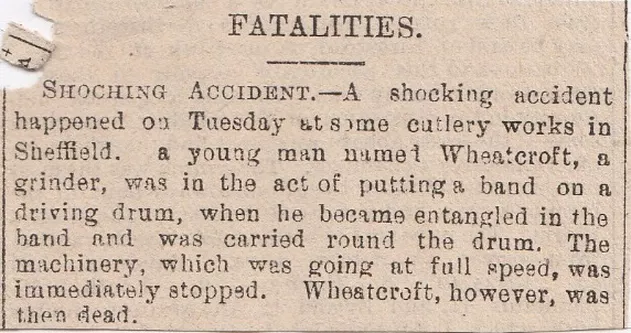
23/ Manvers Main Colliery, (Fatal Accident) December 1872
On Saturday a miner named Benjamin Humphries, living at Swinton and working at Manvers Main Colliery, was killed whilst following his employment. It appears he was engaged removing “props” in his working place when one of the pieces of timber unexpectedly left the coal and struck him so violently on the body as to cause instantaneous death. Deceased was married and has left a widow and several children.
24/ Cudworth South Junction, (Tragic Fatality) May 1885
At Cudworth South Junction on the Midland Railway near Barnsley, a labourer named John Godfrey, who had only just entered the service of the Company, was employed with other men emptying ballast waggons. During a shower, Godfrey sheltered under a waggon and on coming out, unfortunately, stepped in front of the down Scotch mail and was literally cut to pieces.
25/ Totley Tunnel Bodies, near Sheffield, September 1898
The mutilated corpses of two Midland Railway workmen named Partridge and Graham were discovered in the Totley Tunnel near Sheffield. They were meant to pick up wages last night but never arrived and when they searched the place where they were working, the bodies were found. They were cut to shreds and barely recognisable, only the clothing gave a clue as to their identity. They were both married and one was also a newsagent as well as having the railway job.
26/ Parkgate, Rotherham, May 1900

27/ Dalton Brook/Thrybergh near Rotherham, (Murder Confession) May 1882
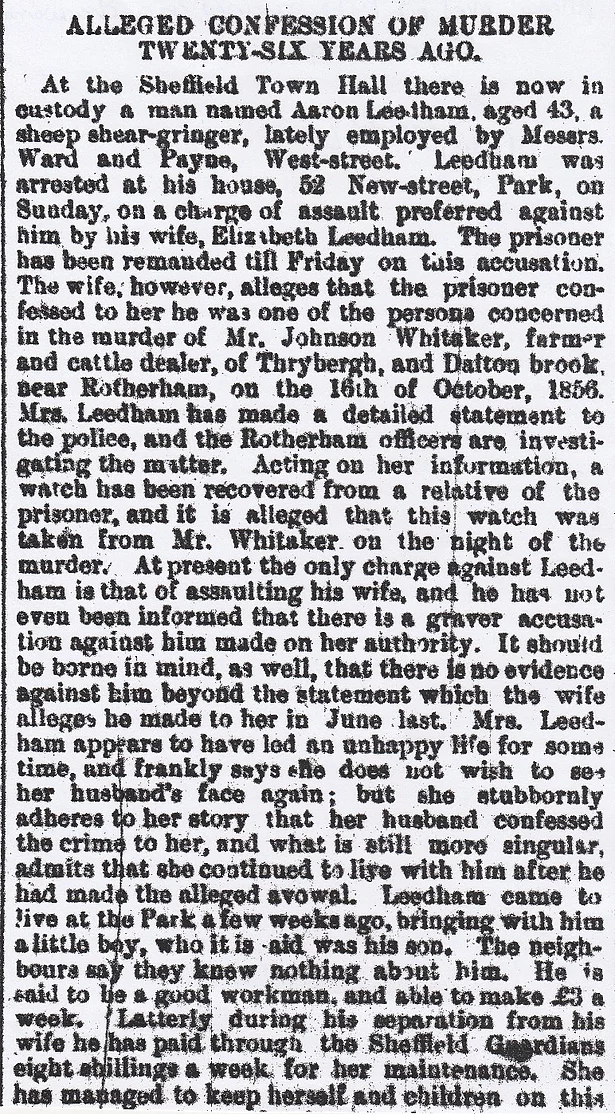
pittance, eked out by her earnings as a charwoman.
28/ Hoyle Mill Murder/Suicide, Barnsley, April 1910
A shocking double tragedy took place in Hoyle Mill, a suburb of Barnsley, when around 2-30 p.m. a policeman was told about the death of a man, thought to be from Halifax. He went to the body and concluded that he had poisoned himself. Another person living in the locality told police that the deceased had told him that he’d murdered his girlfriend, so police straight away began to search the area and question neighbours. Nearby, the body of a woman lay in an outhouse and all indications suggest that she too was poisoned. A letter was found on the bloke and from reading the contents it would seem that she was working as a domestic servant somewhere in the district. (What were the names?)
29/ Micklebring Suicide, near Conisborough, November 1860
A farmer from Micklebring near Conisborough, named Wood, killed himself one morning. He was a tenant of Mr Nicholson and last week the deceased had paid him six months rent in one payment. In the wad of cash was a £5 note which was a fake, so Nicholson sent a servant with the fiver to inform Mr Wood that his money wasn’t kosher. When questioned about the note Wood said he received it from a gentleman in Doncaster on market day. Since being told of this, he really became despondent and told his missus that he was going to do himself in, as he’d been ripped off and lost quite a bit of money in the process. The wife passed them off as idle threats, but she found him hanging in an outhouse soon after. The news reached Doncaster market and the bloke who passed it on to Wood said that he got it from a group of villains in the area, who are using counterfeit money and possibly printing it themselves.
30/ Grimesthorpe Road Murder, Sheffield, August 4th, 1885
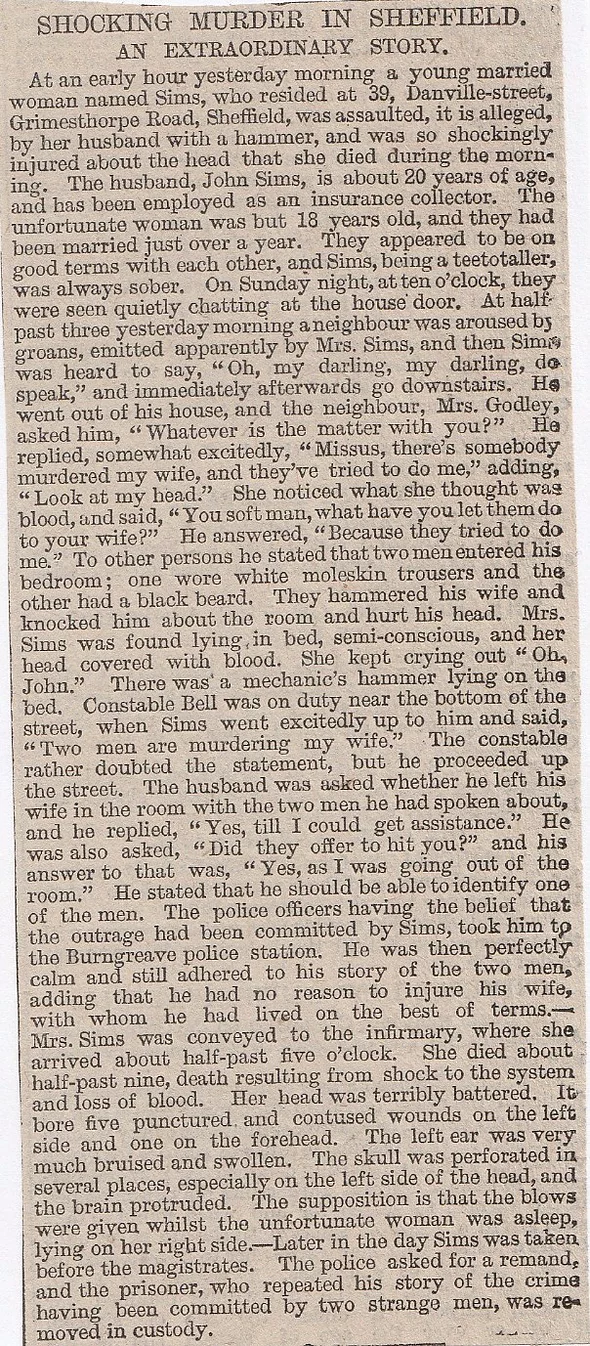
Grimesthorpe Road, Sheffield, (Death Sentence) November 27th, 1885
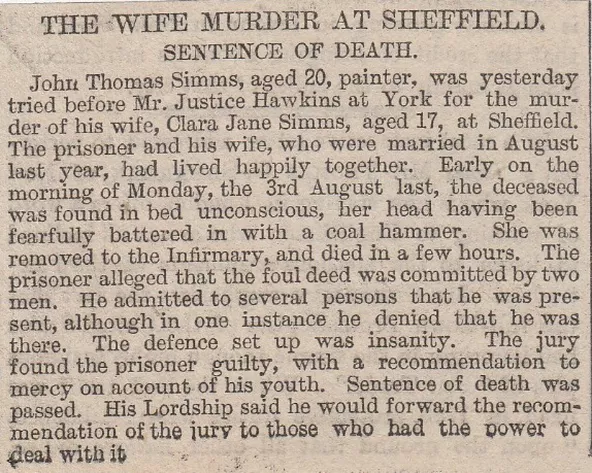
31/ Devil’s Elbow Servant Suicide, Doncaster, February 1873
At two p.m. one Saturday afternoon, a teenage girl was spotted plunging into the river (Don?) at Devil’s Elbow near Doncaster. A boatman rescued her straight away and she was taken to the New River Tavern, where she died shortly after the rescue. The young girl was fourteen-year-old Sarah Ann Stocks, who was a domestic servant for a Mrs Law, getting a shilling a week pay. Recently though, some bits and bobs had gone missing and Mrs Law thought that Sarah had been pilfering from her, so she didn’t give her the usual shilling wages. Sarah was so frightened of her father’s reaction that she decided that suicide was a better option. She left her mistress’s house and went directly to the river and dived in.
32/ Rotherham Murder, May 1880
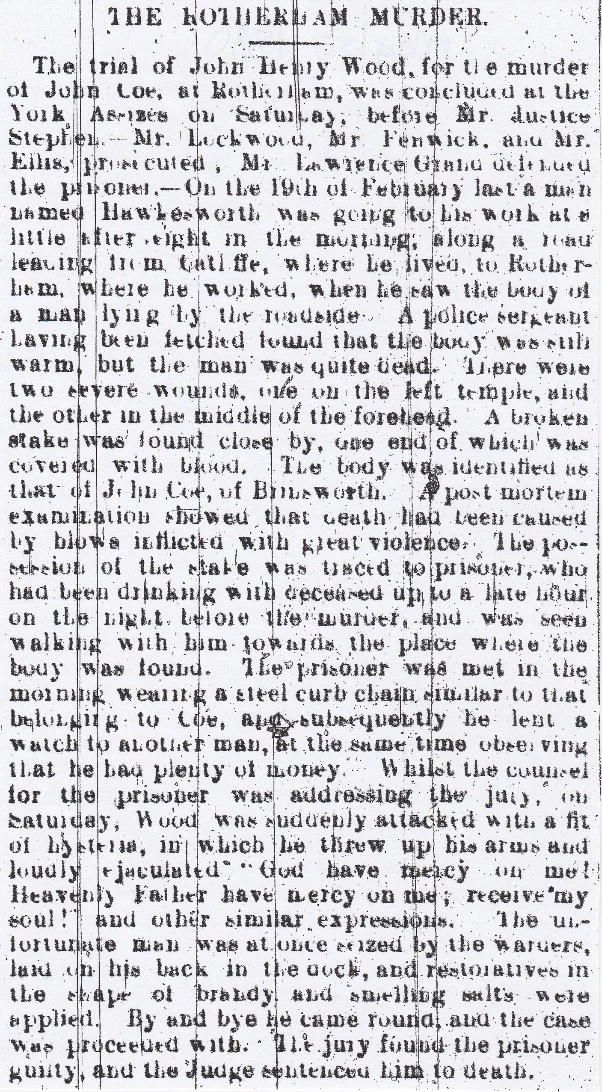
33/ Forge Yard, Wadley Bridge, (Hideous Death) August 1859 (What a way to go!)
William Pickering lived at Forge Yard in Wadley Bridge near Sheffield. He was messing about next to a pond adjoining which is a water-wheel and while walking on a plank, overbalanced and fell in. The wheel was going around at the time and it sucked him into the current. He was lifted by a bucket and precipitated the other side. A lad who was with Pickering started shouting for help and when the poor boy was fished out of the water, his head had been wrenched off. He was also missing his left leg.
34/ Worsborough Bridge Ice Fatality, Barnsley, December 1885
A fatal ice accident occurred at Worsborough Bridge, to a schoolgirl named Sarah Ann Hammond whose parents reside in that hamlet. The deceased and a number of other girls left the Wesleyan day school, Worsborough Bridge, at noon. Instead of going home they went to the canal which is near the school and the water of which was frozen. The girl went on the ice and she fell in and was drowned. Several others were about to get on the ice when it gave way.
35/ Moor End (Fatal Accident), near Thorne, February 1865
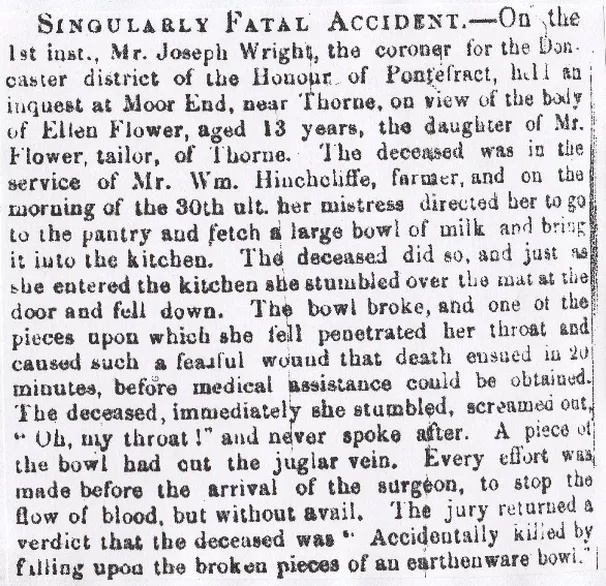
36/ Sheffield, June 1891 (Suicide in Labour)
Clara Steer, whilst in labour, committed suicide by slitting her throat, stabbing herself half a dozen times in the left breast and then attempted to tear open her abdomen. Her neighbours were helping her through the labour and both had left the room for a minute when they heard noises, when on entering the bedroom they found her bleeding profusely lying on the floor. Steer died within a few minutes, and I presume the child died as well.
37/ Rotherham Barber’s Suicide, August 1878
A Rotherham barber named Burton who committed suicide by hanging himself was known throughout the district as an eccentric character-or nutter as we’d call them today. He tried to hang himself before the successful effort but the strap he tried to do it with snapped. Then in chalk on the floor, he’d written “The strap broke”- as though apologising for his first-time failure. He then wrote the following lines for his wife: “August 10th, six a.m.- Dear Wife, Bless you. This is my last wish; The snuffbox must go to the dram-shop, where I have spent many happy hours. My body for cremation; or Barton make the box, but no parson- Robert Burton. Goodbye, I am tired of living, for I am a torment to myself, and everyone else- R.B.”
38/ Sheffield, (Boy and Girl Mutilated) July 1880

39/ Sheffield Infanticide/Suicide, April 1880
In the canal which runs through Sheffield, a woman’s body and a child’s also, where found near the same spot. The woman has been identified as that of Lucy Oldfield, domestic servant and it is believed that the child is hers. Oldfield had been unemployed for some time and belief is that she killed herself and the baby out of want. A man’s corpse was also found near the woman’s and it thought that he was trying to save her life he drowned also. As yet he is unidentified.
40/ Barnsley Suicide, July 1865
A tradesman who was smoking his pipe at a neighbours house at midnight, said to the fourteen-year-old daughter, that if she popped next door with him he’d give her some roast pork (not a euphemism) for her Dad’s supper. She went with him, but when she hadn’t come back soon after, so the father went round and saw “something improper going on”. She was bawling her eyes out when she returned and screamed out that “he was a bad ‘un”, so she ran out and jumped into the nearby reservoir. She was dragged out but then straight away tried to drown herself again. Again she was rescued but she managed to poison herself with an ounce of corrosive sublimate at the same time.
41/ Sheffield, May 1888
The boys named William Plant aged seventeen and Charles Wood aged fifteen were playing at Sheffield on Wednesday, when the former presented a revolver which went off and the bullet entered Wood’s brain, causing instant death.
42/ Stannington Boiler Explosion, near Sheffield, December 1885
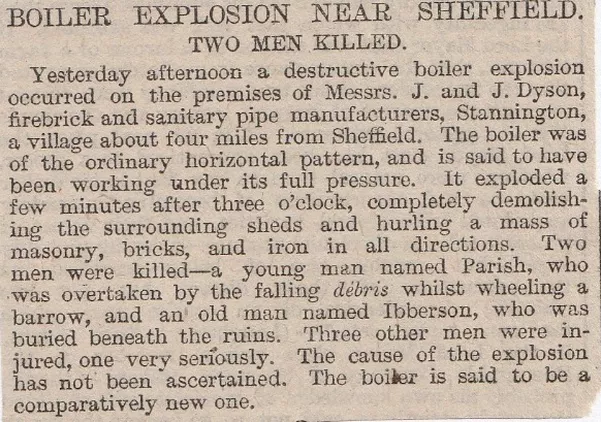
43/ Swallownest, Rotherham, September 1915 (One bullet, two lives)
A mystery of a woman’s death at Swallownest near Rotherham was eventually solved. Mrs Lucy Martin, a collier’s wife and mother of seven kids, was hanging the clothes out to dry in the garden behind her house. All of a sudden a gunshot rang out and she fell down dead from a bullet in the head. A car was passing the scene at the exact time and the neighbours immediately suspected the driver of being involved in some way. The number of the car was taken down and the driver was questioned about the shooting. He denied any knowledge but said he heard the shot of a gun as he drove past. Police then deduced it came from a house overlooking Mrs Martins backyard and they found the body of an old miner, John Johnson with a gun by his side. In a million to one shot, literally, he committed suicide due to lack of work and the bullet passed through himself and into Mrs Martin’s temple.
44/ Black Swan Inn Suicide, Fargate, Sheffield, May 1870
This one holds a special place for me because I suffer from grand mal seizures as well and it proves how far we’ve come in helping to cure epilepsy and the depression so often associated with the condition. That’s my little piece over. This concerns Theresa Davy, daughter of John Davy of the Black Swan Inn, Fargate. She was a gorgeous eighteen-year-old, with one drawback in life- her epileptic seizures. She helped out at the pub occasionally, but the seizures had started to make her somewhat depressed. One Saturday night at eleven p.m., she swallowed a load of vermin killer and ended it there and then. (Is pub still there?)
45/ River Sheaf Drowning, Sheffield, June 1885

46/ Strawberry Island Drowning, River Don, Doncaster, February 1895
On Sunday afternoon a young man named Holland, who lived at Mill Street, Marsh Gate in Doncaster, was drowned in the river at Strawberry Island. The ice at that part has been dangerous for some days and several narrow escapes have taken place.
47/ Stainbrough, (Dead Infant Found) August 1884
Three lads were roaming the area between Locke Park and Stainbrough, when they came to the stream where they were going to bathe. They thought they saw the corpse of a dead dog in the stream, but on closer examination, it proved to be a child with a bit of cloth over its face. It was taken to the Strafford Arms Hotel and found to be a little girl dressed in a night-dress, who was only about a month old.
November 1884
A domestic servant named Ann Parkin was convicted of the murder of her illegitimate five-week-old daughter at Stainbrough. The mother had fractured the skull, then she dumped her in the stream.
48/ St Barnabas Road, Sheffield, December 1885 (Attempted Wife Murder/Suicide)

49/ Dockin Hill Drowning, Doncaster, July 1882
At Doncaster on Monday, an inquest was held respecting the death of Joseph Alfred Martin aged nine, living with his step-father at Gas Row, who fell overboard on Saturday afternoon. The young chap and a couple of others were playing on a barge lying at Dockin Hill when he accidentally fell in and drowned. The body was searched for but not found until Sunday morning. Verdict of “Found Drowned” was returned.
50/ Worsborough Colliery Tragedy, near Barnsley, November 1907
Seven men were killed in a tragic accident at the Barrow Hematite Company’s colliery at Worsborough when the men were precipitated down a shaft, about eighty yards down. It was at No. 3 shaft, which they use for the Parkgate, Thorncliffe and Silkstone seams. Sixteen men climbed in at the Parkgate seam, which is closest to the surface and just as it was being lowered to Thorncliffe seam something went badly wrong, when the foot-plate that the men usually walk out into the pit was not lifted up before the cage was started, then the engine began to wind up the cage, it tilted over and men fell out down the shaft. The names of the dead men are -Walter Goodchild, Thomas Cope, Ben Rooke, Tom Jennings, William Black, Isaac Farren and Frank Ackroyd. There are also three others who are in a critical condition: Charles Wigglesworth from Barnsley, George Hoddle from Worsborodale and Herbert Sanderson from Worsborodale. One of the dead, Isaac Farren, was having his 21st birthday the day he died and his Mum was organizing a party for him when she got word of the tragedy.
51/ Dunlop Street, Attercliffe Common, (Two Suffocated) September 1885

52/ Glossop Road Suicide, Sheffield, March 1884
The professor of languages, Carl Wehnert, left home in Glossop Road in Sheffield and made his way to the Church Institute on St James’s Street, to go and give some lessons. He was old by today’s standards, let alone Victorian ages, at nearly eighty. He went to a shop on Convent Walk and was never seen alive again. There was talk in the area of him being murdered but when some lads who were playing at the Endcliffe Dam saw what they believed to be a dead animal, they threw stones at it. Another bloke coming up saw it was a man’s body. When the pockets were checked they had been fastened together with safety pins and his watch and money were in them. This makes police think that he committed suicide by drowning himself, but he was in good health and was well off, so why he killed himself is a mystery.
53/ Cheswick Street, Walkley, (Child Remains Found) March 1891
Jane Hague lives at No 41, Cheswick Street, Walkley, and when near to her home on a piece of waste ground, she discovered the decomposed remains of a baby. P.C. Taylor lives nearby and was summoned to the scene. He found a straw-covered hole, also missing from the child were the left foot and the right hand. Police think that the child was buried in the hole and a fox or some other creature has dug it up and gnawed on the limbs. The infant was severely decomposed anyway, so it had been there for quite a length of time.
54/ Worsborough Bridge, (Sad Death) March 1892
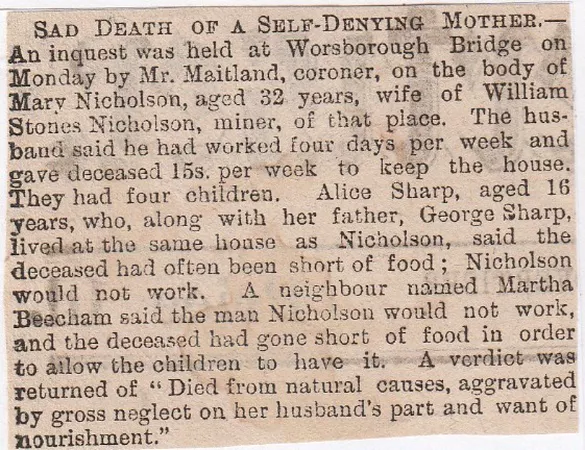
55/ Sheffield, September 1857 (Brothers Suicides)
Two of the sons of John Adams, a furniture dealer from Devonshire Street in Sheffield, have committed suicide in the following manner. Henry was only fifteen and the youngest and his father told him off about something, then boxed him around the ears and said in a deep Yorkshire accent “get out of the shop wit thee”. Henry took it to heart and went to his sister’s and told her “Tell my father I shall never come home again”. He lived up to his word and was found in the canal near Blast Lane on Monday morning. The other brother, William, was slightly older at twenty-one-years of age, but was a weedy chap and was unable to work. The day after Henry’s disappearance the father sent William on an errand to pay a bill. William never came back, instead, the father got a letter in the post, written in William’s handwriting, and saying:
“Money is of no use to me. You will never see me alive again. I have paid this”- William’s body was discovered in Attercliffe, having drowned himself.
56/ Atlas Works Fatality, Sheffield, April 1885
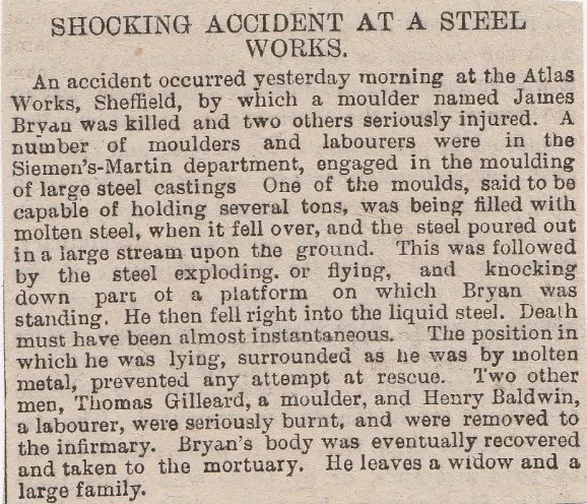
57/ Smithy Bridge Suicide, near Barnsley, July 1884
An inquest on the body of a twenty-one-year-old miner, Robert Palmer of Lundhill near Wombwell, whose body was discovered in the canal near Smithy Bridge late on a Sunday night. The circumstances appear to be that he had a quarrel with his girlfriend and in typical Victorian fashion, over-dramatised the situation. Sarah Wray, a married woman, living at the Old Mill at old bleachworks, claimed that Palmer asked her for a glass of water then sat down and spilt his guts about his girlfriend in Skelmanthorpe. He said he lived at 12, Lundhill Row, and as her father was blown up in the Lundhill explosion, so she made him some dinner and had a cup of tea. He thanked her, then went with her husband to the Tollgate Inn and had four glasses of rum. Next time she heard about him, they were fishing him out of the canal. Police searched his pockets and found; silver watch, that stopped at 8-49, a silver ring, a females portrait, some loose change and a pocketbook. They found a piece of paper in it, with the words- “Hannah Dyson, born 8th April 1864”, and other entries read-
“Skelmanthorpe, July 6th, 1884- Dear Father and mother, I bid you farewell, For with you I can no longer dwell, Having lost the object for which I crave, I commit myself to a watery grave. Goodbye, R.P.”
Well, Robert Palmer, you might as well face it you’re addicted to love- Sorry I couldn’t resist!
58/ Doncaster Street, Sheffield, (Shed Collapsed- Eight Killed) August 1886
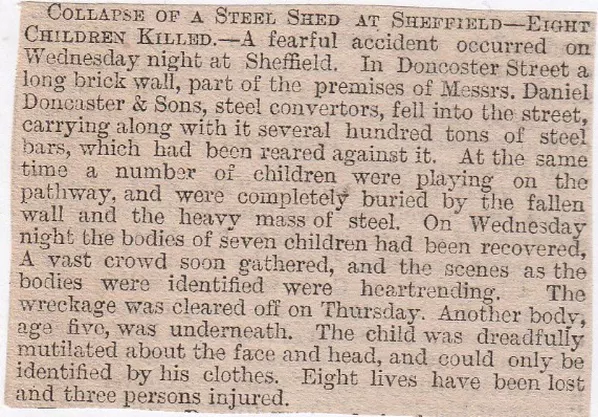
59/ Sheffield, (Insurance Fraud Suicide) September 1879
Edward John Palmer owned a hat business in Snighill, Sheffield. They killed himself in a rather extraordinary manner. It was one Monday night and the shop was ablaze and the entire contents and the stock was a pile of ashes. The insurance agents suspected it of being started deliberately and he became very excited and was “almost beside himself”. They were coming on Saturday to assess the situation in person and Palmer went down into the cellar and hung himself before they came. His wife found his body suspended from the ceiling on a piece of rope.
60/ Silkstone Fatality, near Barnsley, July 1890
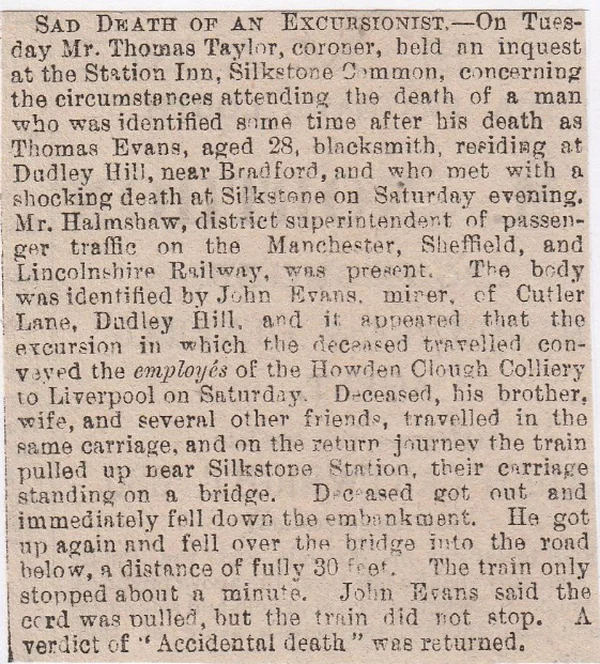
61/ Loxley Valley Double Suicide, Sheffield, May 1881
The dead bodies of a man and woman were discovered in a dam at Loxley Valley, tied together with a piece of cord, by the wrists. They were James Shaw, a married man with three children residing in Rivelin and a young domestic servant named Wagstaffe who worked for a surgeon in Hillsborough. They were an item before Shaw met his present wife, but it appears that they kept seeing each other in secret. They both disappeared on the Wednesday and tongues got wagging and a rumour started up that they’d emigrated to America. They had done nothing of the sort, as they had booked into a room at a public-house on Monday, then spent Tuesday together, then gone to Loxley on Wednesday to kill themselves. There were a couple of letters, a hat, an umbrella and a book and on one of the envelopes Shaw had scribbled: “The end is near- Wagstaffe is the only woman I have ever really loved”.
62/ Corporation Street, Sheffield, (Job Beneath Her) February 1878
A fourteen-year-old lass named Maude Marguerite Orban committed suicide under the strangest of circumstances, thinking that she was too good for working for someone else. She was orphaned as a girl and brought up by her grandparents in Hull, but she was a very good scholar and looked quite a bit older than her fourteen years would suggest. A few months ago the grandparents sent her to a friend in Sheffield so that she might get a job there. They got her a situation but she was totally against working there, saying it was beneath her. On Monday morning she got some “vermin killer” from a chemist and took it. She collapsed on Corporation Street and was taken home in a cab. She told friends that she had swallowed some poison and by eight o’clock that night, she was dead.
63/ Rotherham, (Lark Ends in Death) August 1886
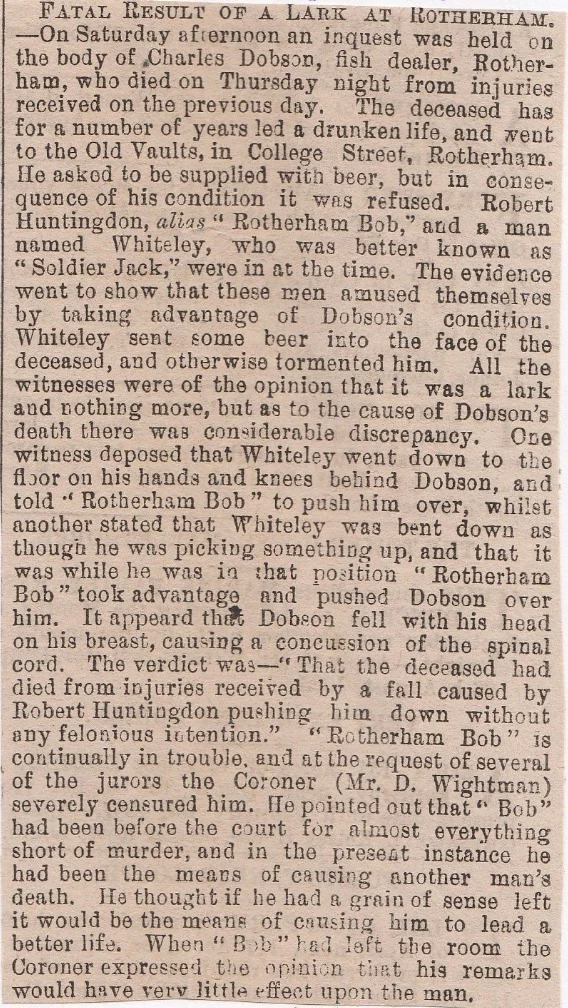
64/ Wesley College Freak Death, Sheffield, March 1854
The chemistry teacher at the Wesley College, Sheffield, named James Haywood died in a freak accident. He was in a laboratory at the college and he was pouring some sulphuric acid into a phial which was in a bottle in a hamper. Somehow the bottle smashed on the floor and he sort of stumbled over and fell on the liquid and glass. A young lad was helping him with the experiment and he was splashed by the acid and ran out of the lab screaming in agony, as the acid started to bubble up on his skin. For a chemistry teacher, Haywood seems to have completely lost the plot and instead of holding his breath and calmly walking out of the room and dousing himself in cold water, he simply lay on the floor inhaling the fumes and being burned by the acid. The other lad was quickly doused in cold water and now only has a few burns that will soon heal. Haywood was taken home, where he died later on that evening.
65/ Doncaster Murder/Suicide? September 1906

66/ The Holmes Blast Furnaces, Rotherham, (Boy’s Suicide) March 1882
Why a ten-year-old boy would want to kill himself is a difficult question in itself, but the way he did it defies belief as well. Charles Taylor of Harrison Street, The Holmes in Rotherham, threw himself into a “goit”,(water channel) near the Holmes Blast Furnaces. His Mum sent him and his brother on an errand to Masbrough, and nothing happened that would cause such a rash decision, although he lost the cash his Mum had given him. Does that warrant suicide? He thought the repercussions would be so severe that he’d rather drown himself. His brother tried to grab him but he slipped through his grasp and jumped into the goit next to the blast furnaces. It is six feet deep and it was dragged at once, but it took two hours to eventually sift his body out.
67/ Hillsborough Police Station Fire, April 1887
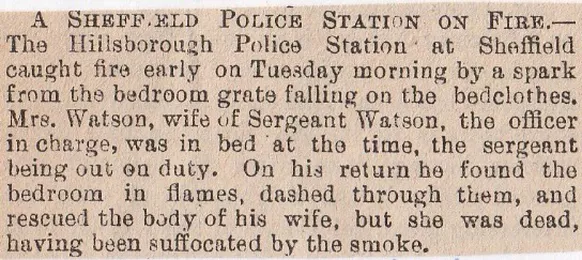
68/ Sheffield Poisoning, January 1865

69/ Rotherham, (Boy’s Suicide) January 1872
This one is very similar to the other Rotherham one, a few stories back. Frederick Dolphin aged seven lived with his parents at Ickles Hall, where his Dad was a labourer. His Mum sent him to Rotherham one day for some groceries and a loaf and he took his satchel and tin can to carry the stuff in. He got to Rotherham alright, bought the stuff, but on the journey home, he met a lad named Edward Thane on a bridge which crosses the River Rother near to town centre. He told Thane that he’d lost his satchel and said he’d get a really good hiding when he got back home with no shopping, so he thought it best to drown himself. He climbed a wall, threw his can in, then his cap and cape and then leapt into the murky waters. About twenty yards from the bridge the Rother flows into the River Don and the current is really strong. The body had not been recovered a few days later and it probably has been swept miles beyond the town.
70/ Sheffield Child Starvation, June 1891
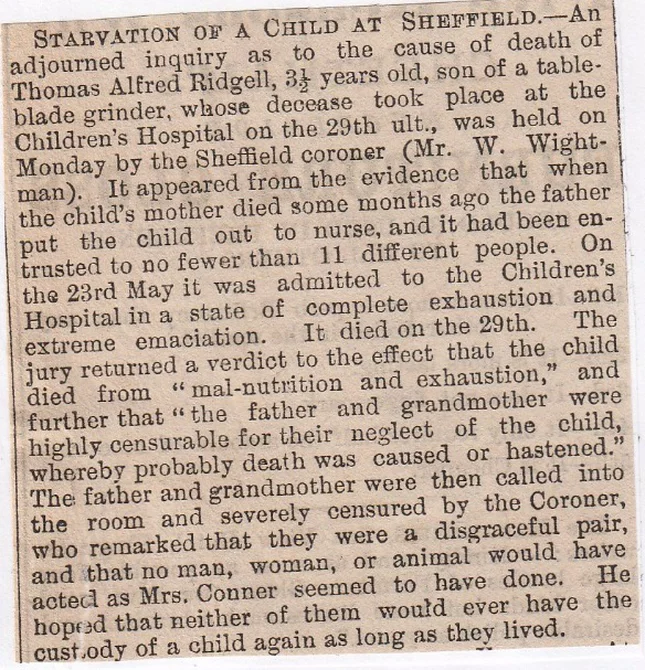
71/ Sheffield Park, (Child Murder Confession) February 1882
This one is an extraordinary confession of a lunatic asylum patient at a Salvation Army meeting in the Mechanics Hall in Nottingham, so should be taken with a pinch of salt! Middle-aged Hannah Froggatt was so affected by the stories she heard, that she piped up and admitted to child murder when she lived in Sheffield. She did it to ease her conscience so she said and was arrested straight away by local police. This is the statement she made at the police station:
“I make this statement of my own free will, because I wish to ease my mind. About the time of the Great Flood at Sheffield, I was living in Sheffield Park with my husband, and I had a nurse child,(foster child?), a girl named Ada North, aged about one year and ten months old, whose mother was Hannah North, a domestic servant, living at Mr White’s Public-house, Basford. I could get no money off the mother for the child’s keep, and it was in my way, as it was ill. After thinking about the matter for a while I decided to kill it. I bought two pennyworth of laudanum, and gave it to the child, a couple of teaspoonfuls at different times, until it was gone, when it died. I called a doctor to see it before it died. He did not say what was the matter with it. I have never told anyone about this until tonight, when I was at a meeting of the Salvation Army at the Mechanics Hall. I told a captain of the Army. I told him because I could not rest. About ten years ago I was sent to Wicklow Lunatic Asylum, and I was there five years before i was discharged.- Signed, Hannah Froggatt”.
When asked what the doctor’s name was she said she had forgotten, but the child was buried in Sheffield she said. Also when asked what part of Sheffield Park she resided in, again she said that she couldn’t remember.
72/ Sheffield Child Murder, August 1890
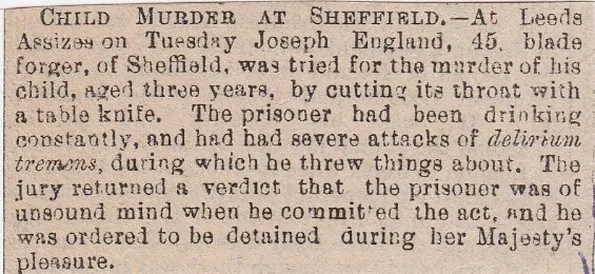
73/ Hadfield Reservoir Child Suicide, August 1884
Henry Mappin aged nine years, residing with his parents at Cobden View Road, Crooks, Sheffield committed suicide one morning. His mother is bed-ridden and when she told him to get ready for school he said it was too late and he didn’t want to go. He walked out the front door, with the mother thinking he had changed his mind. He was spotted by a neighbour, sat on a wall that was next to the Hadfield Reservoir of the Sheffield Water Co., School Lane, opposite the Vicarage as she was dropping her kid off at school. Another neighbour passed him later on and he told her that he was going to drown himself in the Reservoir and to go and tell his sister, Annie. The first neighbour who saw him, was now on her way back after dropping her child off and she mentioned this to the family. A search was made by police and found on the bank of the dam, was his slate, dinner-money and his jacket. They dragged the dam and found his little body after a few minutes of looking. Post-mortem suggests that he hadn’t been dead that long.
74/ Angel Inn, Sheffield, (Fatal Quarrel) August 1892
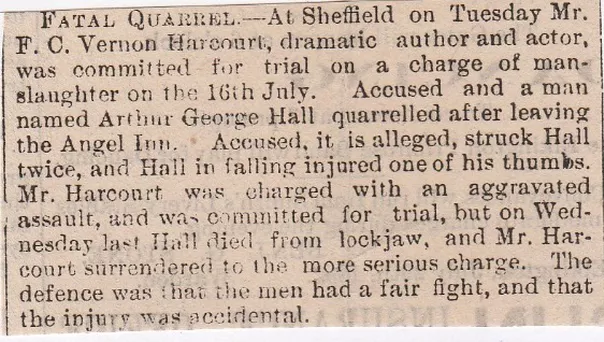
75/ Sheffield, (Child Brutality) October 1906
This is a shocking tale of maltreatment and brutality on a child, so if you’re queasy…go easy. The father’s name was Fred Burrell, who along with his wife were charged with ill-treating his ten-year-old daughter. The N.S.P.C.C. were involved and they adduced that she was the step-mother of the girl, but her brutal treatment had been ongoing for years on end. She was covered in bruises and dozens of sores were found on all parts of her body. Some money went missing and the step-mother wrapped a clothes-line round her neck and told her she would be hanged. She was then smacked and beaten until she confessed to stealing the sixpence, so the punishment was her father’s belt after all that she been through. This was mild in comparison to what was about to happen. The girl had a towel tied around her neck, then she was strung up on the kitchen door. She was there till she lost consciousness and the next thing she knew was the nurse from the society bringing her to, and tending to her wounds. The father’s defence was that he only did it to scare the girl, but he requested a solicitor for his defence against such serious charges.
76/ Woodhouse Wife Murder, Sheffield, August 1889


77/ Barnsley Mill Explosion, December 1907
An explosion of massive proportions happened at Worsborough Dale Powder Mills, which is owned by Messrs Kynoch & Company. Most employees had gone home for dinner, so the death toll could have so much worse than it was. It was a quantity of powder that blew up, then that acted as a catalyst for another huge explosion. Robert Craig and Frank Senior were enjoying their packed lunches in a storage house, when they were blown to bits, with parts of Senior’s body being 400 yards from the spot he was having lunch at. There was shattered glass everywhere and houses with smashed windows a couple of miles away. There is massive damage and the works itself is completely destroyed. (Just the two deaths?)
78/ Penistone Railway Accident, January 1st, 1885




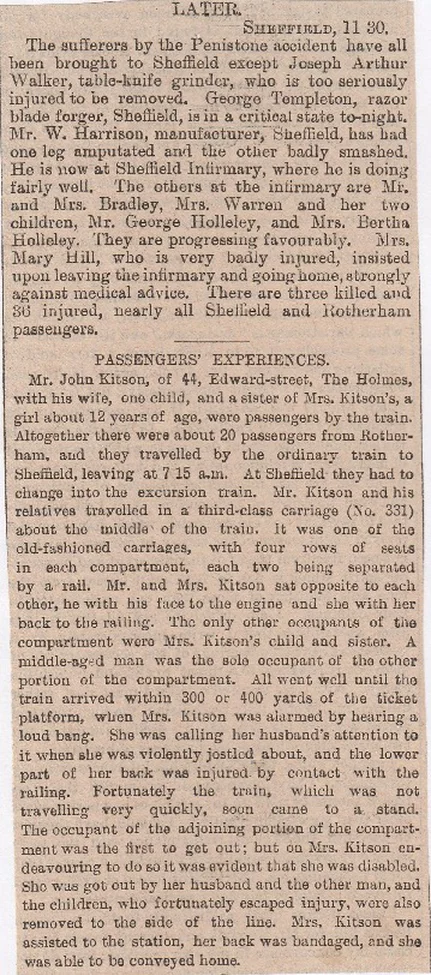
79/ Wombwell Suicide, July 1889

80/ Barnsley, (Housemaid Suicide) December 1882
Thirty-two-year-old Emma Hoyland from Barnsley was for the last fifteen months, the head housemaid at Downham Hall, Clitheroe. Her lifeless corpse was found on the embankment under Victoria Bridge on the outskirts of Barnsley. She had a broken back and arm, plus various cuts and bruises. Hoyland left Downham Hall on Friday or Saturday morning, leaving a note for the under-housemaid on how to pack her clothes and saying that wouldn’t see her ever again, but wishing them all Merry Christmas.
81/ Rotherham, (Attempted Murder/Suicide) July 1895
On Tuesday afternoon a collier named Thomas Lees aged fifty-six of Harthill near Rotherham attempted to murder his wife by striking her with a hatchet and then afterwards committed suicide by cutting his throat with a carving knife. Lees suffered from influenza about six months ago and his health had since been affected. Lately, he had been very depressed.
82/ Sheffield Smallpox Deaths, February 1888
The Registrar General’s report for last week states that smallpox caused thirty-seven deaths in Sheffield, one in Bristol and one in Leeds, but not a single one in London, or in any of the twenty-four other large provincial towns.
83/ Yorkshire Institute for Deaf and Dumb, Doncaster (Singular Death) February 1885

84/ Thorncliffe Colliery Death, Sheffield. August 1870
85/ Sheffield Child Murder, August 1870
At Sheffield, last night, George Hibbershaw, a youth of fifteen years of age, was killed by his step-father. He had given offence to the latter, who is a grinder, by neglecting to deliver a message promptly, and in a sudden fit of anger, he threw a sharp piece of iron at him. The iron struck the boy in the side, and he died three-quarters of an hour afterwards, from the effects of the blow. The father, who is said to have behaved very kindly to the deceased, surrendered voluntarily at the police-station directly after the occurrence.
86/ Barnsley Railway Disaster, December 1870.
87/ Sheffield Shooting Accident, October 1870
A shocking accident occurred at Sheffield on Friday afternoon to Mr Henry Chapman, of that town, who was shooting pigeons with five or six others at the back of the residence of one of the party. Mr Chapman was in the act of firing from the trap, when another from the party, who was standing about thirty or forty yards from Mr Chapman, and from the opposite direction, also fired. Mr Chapman received a large part of the charge in various parts of his face and body. His right eye was completely out, his left eye, it is believed, is also injured, and he lies in a precarious state.
88/ Agnes Main Colliery Fatality, Barnsley. December 5th, 1870 (“Accidental Death” was the jury’s verdict of what happened here)
89/ Sheffield Murder, December 1870 ( Her name was Charlotte Barton in a later edition of the paper. She was found “Not Guilty” on the ground of unsoundness of mind)
90/ Parachute Disaster at Sheffield, May 1902.
91/ Child’s Body in Left Luggage, Great Central Station, Sheffield. May 1902
Yorkshire (North)
1/ Downholme, (Vicar’s Suicide) July 1883
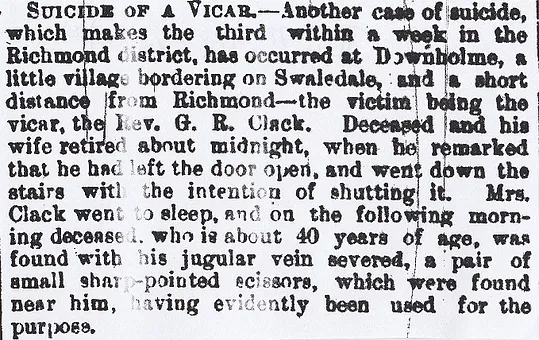
2/ York Minster Fatality, September 1829
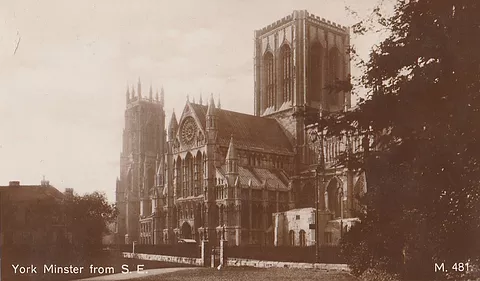
Henry Stranger was on the scaffolding that was used for roof repairs on the Minster. He removed one the twenty-foot planks when he slipped and fell down to the pavement below, causing instant death. It was an eighty-foot drop from the scaffolding to the ground.
3/ St Mary’s Church Fatality, Boston Spa, November 1888
A young man named Thirlwall was suffocated in St.Mary’s Church, Boston Spa, on Saturday afternoon. He had gone into the church and sat down near the heating apparatus and was overpowered by the fumes. (On the High Street, across the road from Crown Hotel)
4/ Scarborough Harbour Drowning, June 1899
On Thursday, a little boy named Bradley, son of Joseph Bradley, from Mosey Hill in Scarborough fell into the harbour and was drowned.
5/ Ripon Child Kidnap, July 1885
At Ripon yesterday Emma Forbes of Sheffield, was committed for trial charged with decoying away the three children, aged ten, eight and six, of Peter Poulton, Ripon, shoemaker. The prisoner had acted as house-keeper from 1st March until last Thursday when she took the children away with her. She was arrested at Knaresborough with them in her charge.
6/ River Ouse Boat Drowning, York, August 1885
James Hazel an excursionist from South Shields, was drowned on Friday in the River Ouse at York. With two companions he hired a pleasure boat and after rowing some distance the men attempted to change seats. The boat was canted over and Hazel, losing his balance, fell into the water and was drowned.
7/ Scarborough Suicide, March 1885
On Saturday, a Scarborough painter named Robert Thompson committed suicide by hanging himself by a cord affixed to a hook in his bedroom door jamb. The deceased had been out of work for some time and he had become destitute. He had frequently expressed his great abhorrence of the workhouse and it is believed that the fear of entering the workhouse caused the unfortunate man to take his own life.
8/ Filey Landslide Fatality, August 1903
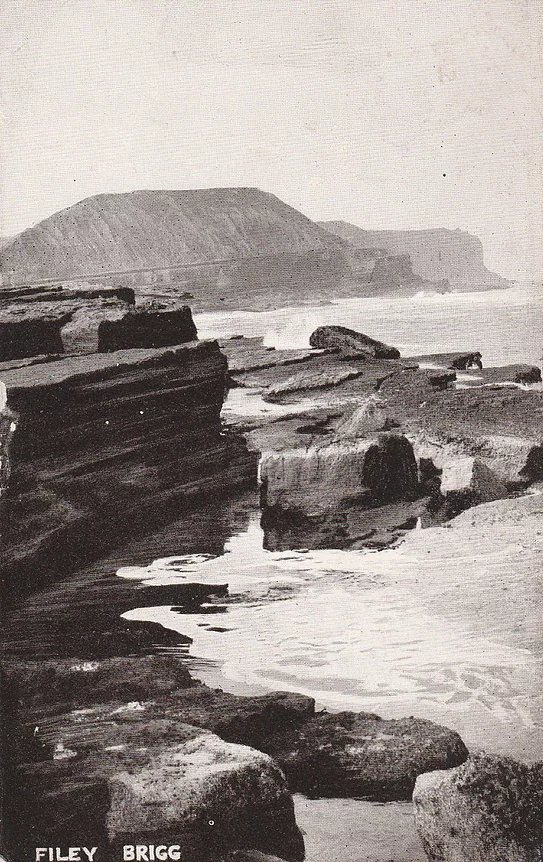
An awful accident occurred at Filey resulting in a fatality. Mrs Dixon, the wife of a civil engineer of Harrogate, was with her kids and the nurse she employed on Filey Sands, along with Mrs Burnett of Harrogate and her children. They had been paddling in the sea and went back to get dried at the foot of the cliffs. The cliff slipped and fell onto Mrs Dixon and her six-year-old boy, John, and the nurse. When they were dug out the boy was terribly crushed, with the face was unrecognisable and the mother unconscious but breathing and the nurse escaped any injury.
9/ Bolton Abbey Fatal Accident, July 1858
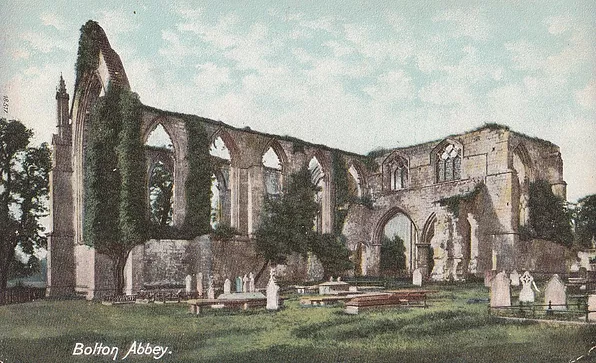
Mr E.J.Greene of Barnsley, met with a fatal accident at Bolton Abbey, while there with a group of day-trippers on a picnic party. Mr Greene left Leeds in the morning with around thirty others and headed for Bolton. They arrived at Skipton and were met by two omnibuses, which took them to the Devonshire Arms, Bolton Bridge where they had lunch, then headed off for the Abbey.(Above) There is a road which skirts the Strid and two omnibuses were trying to pass each other in opposite directions, so some of the passengers got out to stretch their legs. Mr Greene was on the top deck and he got up when the bough of a tree smacked him on the head and knocked him off, landing head-first. He was taken to the Devonshire Arms and after several hours of recuperation and medical assistance, he came to and began to apologise for holding things up. Everyone thought he looked and behaved normally, therefore he was only stunned by the fall and well enough to travel home. On the journey to Leeds, he suddenly worsened and he became delirious. The next morning he died from concussion of the brain.
10/ Staithes Cliff Suicide, August 1892
At Staithes, North Yorkshire, the dead body of Mrs Mildred aged twenty-two-years, who was the wife of a miner, was discovered at the base of a cliff. The cliff was some three hundred feet high, and it is suspected that Mrs Mildred committed suicide by jumping off it.
11/ Middleton Colliery Shaft Suicide, March 1841
A man in Middleton, North Yorkshire, killed himself by leaping down an old colliery shaft. He was depressed and had been ill for a while and his wife spotted him running past the window, then heard him fall. A tub was suspended half-way down the pit and this nearly sliced the fella in two. His name has not been released but he leaves a widow and three children.
12/ Scarborough Castle Cliff Fall, August 1883
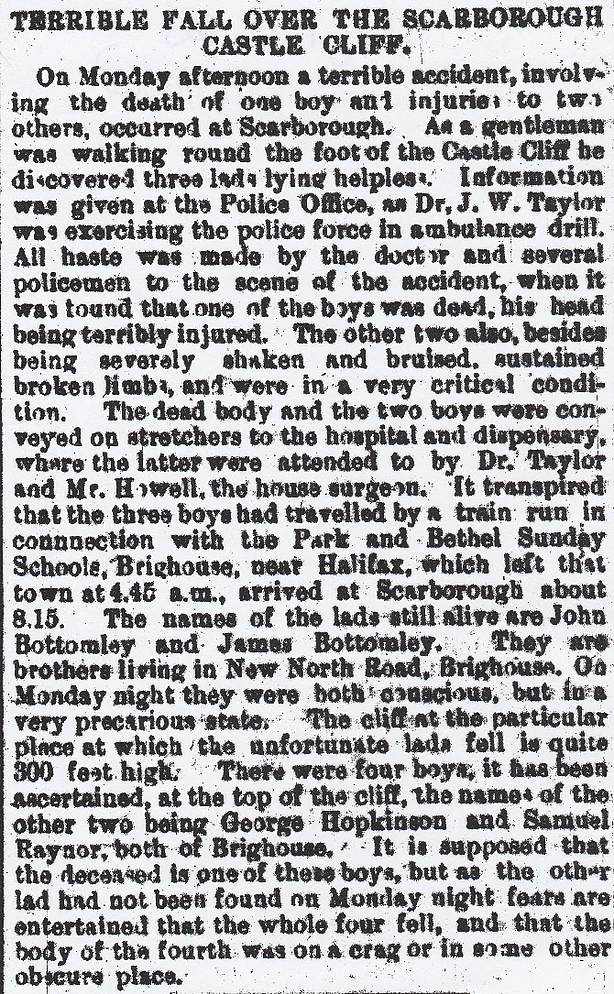
13/ Harrogate Suicide Poisoning, August 1872
An inquest was held at the Alexandra Hotel, Harrogate, regarding the death of 24-year-old Sophia Marshall. She had been staying in Harrogate and was suffering from depression. On Sunday morning she got up bright and early, went downstairs and drank two drachms chloride of zinc from a bottle with a big “poison” label on it. They tried to revive her but she died later on that night. The verdict went accordingly- Died from self-administered poisoning, whilst labouring under temporary insanity.
14/ River Ouse Drownings, York June 1878
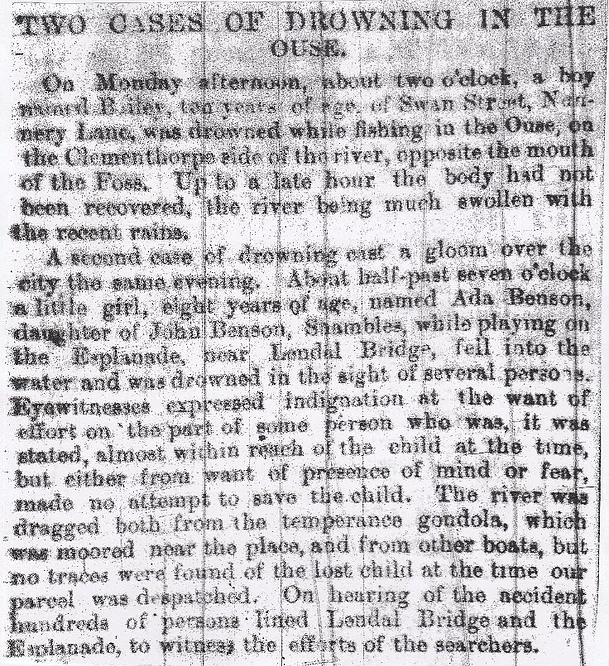
15/ Monk Bridge Suicide, Heworth, April 1860
Mary Lowther of Lyham near Howden, killed herself at Mrs Wray’s house in Heworth where she had been on a visit. Lowther entered into a relationship which her friends did not like in the slightest, and because of this, she had become depressed. On Sunday night she went to bed and then by two a.m.the next morning, she had completely vanished. Her clothes were gone, so she had got dressed and left the house. A search party found her bonnet and skirt on the banks of the River Foss near Monk Bridge and some men dragged the river. After several hours, her body surfaced and it was taken to a nearby inn to await the coroner’s inquest.
16/ Upgang near Whitby Drowning, June 1899

17/ Whitby, (Decomposing Body Found) September 1881
A group of women had gone into a plantation near Whitby to gather in some twigs and sticks for kindling in the winter months, when they stumbled across the decomposed body of a man. The flesh was almost gone from his face, but the clothes were remarkably intact and it is hoped that he can be identified from these. The deputy coroner for Guisborough opened an inquest on Thursday afternoon, but no further evidence had been acquired as to his identity so it was adjourned till Monday. It is believed he was murdered and that some kind of foul play was used. The more likely theory is that it is of John Porritt, a farmer from a place called Buckrush near Whitby. He was last seen alive in July 1880 in a pub at Lythe and from this time on, no-one had seen the bloke again and locals thought he had left the country. (Was it Porritt?)
18/ Yorkshire Coast, (Death from Sea-Sickness) September 1885
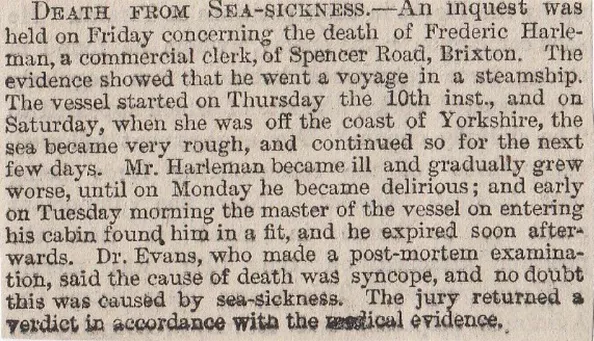
19/ Richmond, August 1917 (Missing Major)
Four miles south of Richmond in North Yorkshire, the body of Major Richardson was discovered on a grouse moor. He was a member of the Highland Light Infantry and was a Glaswegian by birth, where he was a solicitor for quite a while. He was stationed at Richmond and vanished about a week ago. The local heaths and moors were searched but with no success, but a group of soldiers out looking in the bracken, found a corpse. The top part of the head was blown away and a revolver was in the right hand of the body.
20/ Easingwold, December 1837 (Between York and Thirsk)
Eighteen-year-old Mary Peacock was a barmaid at the New Inn, Easingwold. (It is off Long Street and New Inn Lane and is still there) Mary had an argument with her boyfriend a couple of days before and it preyed on her mind so much, she decided to kill herself by hanging from a hook in the wash-house ceiling. She was found almost immediately but she was still dead.
21/ Scarborough Railway Bridge, York, (Two Lads Drowned) February 1885

22/ Middlesbrough, (Circular Saw Death) October 1847
A shocking accident happened to a young lad at Messrs Bolckow & Vaughan’s Ironworks in Middlesbrough. He was lifting one end of an iron bar, which was to be sawn across by a circular saw when his tongs slipped and he fell into the saw. It sliced into his jaw-bone and a huge gash was made on his chest, about a foot long, slicing through all his ribs. There is no hope of him recovering from these dreadful injuries.
23/ Angel Hotel Suicide, Whitby, February 1873
The body of commercial traveller William Savill was discovered in his room at the Angel Hotel in Whitby. He had shot himself in the temple. He worked for Messrs Bourne and Co, who made bonnets, he was only twenty-eight-years-old but had been ill for some time, which could well be the reason for his self-destruction. (The Angel Hotel is still there- it is on New Quay Road near the bridge over the River Esk).
24/ Newton House, Bedale, (Murder/Suicide) May 1841
At the property of the Duke of Cleveland, Newton House, Leeming Lane in Bedale, a murder and suicide took place. The gardener to the Duke, Thomas Robinson, called his 18-year-old son into the greenhouse, then smacked him over the head with a blunt instrument, then stabbed him in the throat and finally, to finish him off, strangled him with a piece of cord. Coolly and calmly Robinson went home and told the missus what he had done and then proceeded to clatter her over the head with the fire-side poker. A relative heard and tried to help, but Robinson put a revolver to his head and pulled the trigger. Robinson had a history of violence, when two years ago he tried to kill a workmate, with the reason for this outburst was that he thought he was in “embarrassing circumstances”. (Is Newton House still there?)
25/ Quarry Moor near Ripon, (Two Drowned) December 25th, 1880
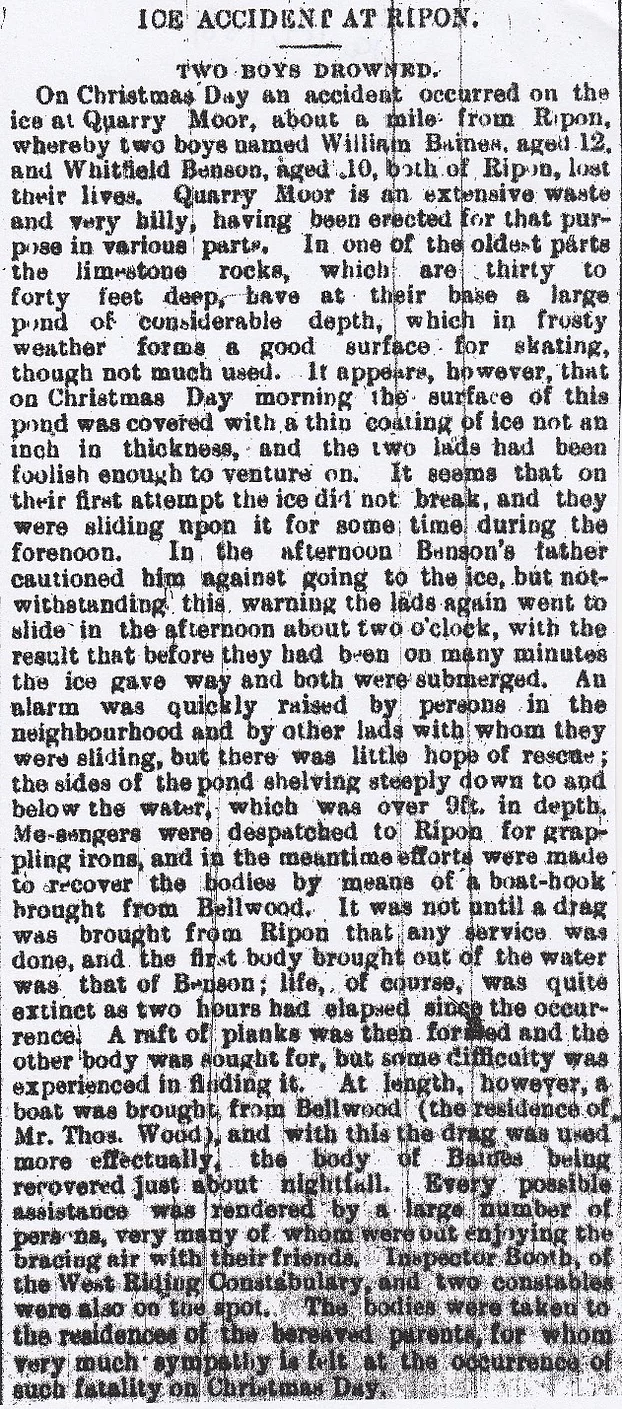
26/ Poppleton Gatehouse, York, (Train Driver Runs over Sister) August 1868
This is a sad story. Mary Ann and Charlotte Burley were up in court, in front of the magistrates, charged with having stolen a purse from a bloke who Charlotte had spent the night. Mary Ann was set free, but obviously, Charlotte was kept behind. Mary Ann was riddled with disgrace and told friends and family that she just couldn’t carry on and said she would do herself in. Here’s where the sad bit comes into the story. Her brother was an engine-driver and the train line passed near to their house, Poppleton Gatehouse, and I think it is still there (On Millgates). It was one evening when the brother was driving the engine that he spotted Mary Ann on the side of the rails. He slammed on the brakes and blew the whistle, but she seemed to fling herself in front of the train and despite his best efforts to stop, the engine ran over her body causing instant death.
27/ Poppleton Bridge Railway Suicide, York, October 1867
The 10-10 from Newcastle was trundling into York, when about a hundred yards from Poppleton Bridge, which crosses the Ouse, a man ran through a gap in the hedge and leaped in front of the train. In a similar story to the above one, which occurred a few hundred yards away, the driver slammed on the brakes but alas he was too late. The body of the man was dragged and churned under the train and carriages for about three hundred yards and finally, it came to a standstill. The remnants of the body were picked from under the engine and the limbs and other portions were taken for a post-mortem examination. The deceased, it turns out, was an escaped lunatic from the North Riding Asylum by the name of Mainprize.
28/ York Castle prison cell, (Attempted Murder/Suicide) September 1885
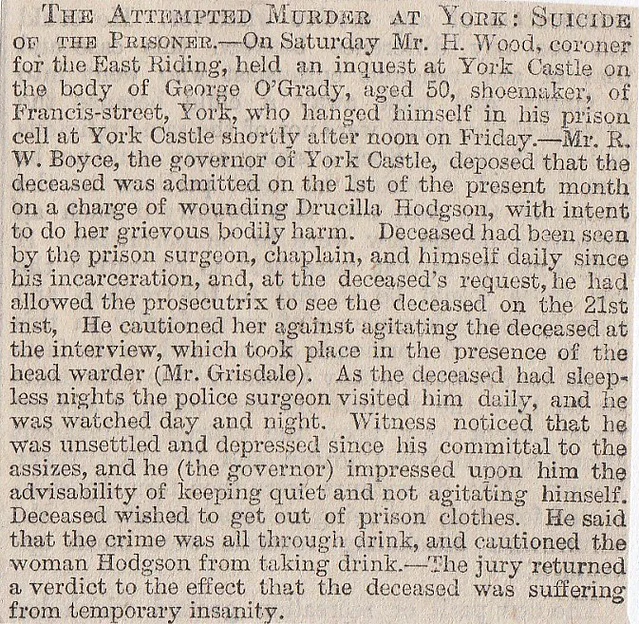
29/ Boltby, March 1863 (Dead Body Dream Comes True)
John Brough from Boltby in North Yorkshire vanished about a month ago, and since then nobody has seen or heard anything of him. Then one evening a neighbour of his had a dream that Brough’s body was in a quarry a few miles away. He told several people about the dream, but they just waved it off as ….a dream. The fellow was adamant that something rang true about the dream, so he set off with his faithful hound to the quarry he had seen. Sure enough, when he arrived there, he found the decomposed remains of Brough with his throat slashed from ear to ear. It was a case of suicide, as Brough had taken off his jacket, rolled up his sleeves and cut his throat with a sharp knife. He was believed to be insane.
30/ York Asylum Suicide, April 1864
Sixty-one-year-old John Tasker was a patient at York Asylum and used to be employed as a magistrates clerk at Liverpool. He was deemed to be a danger to himself, so was put on suicide watch. The attendant who was supposed to be looking after him, a guy named Love, left him alone for a while with a group of other inmates. One of them, Cockshott, had a razor in his hand and was shaving at the time. He’d borrowed it off another attendant called Askwith and while he was soaping himself up, Tasker grabbed the razor and slit his windpipe. He gurgled and gasped for a couple of minutes, but then passed away. Apart from the death of a patient, the attendant Love, lost his job due to his lax attitude while performing his duties.
31/ Beningbrough Train Death, August 1927
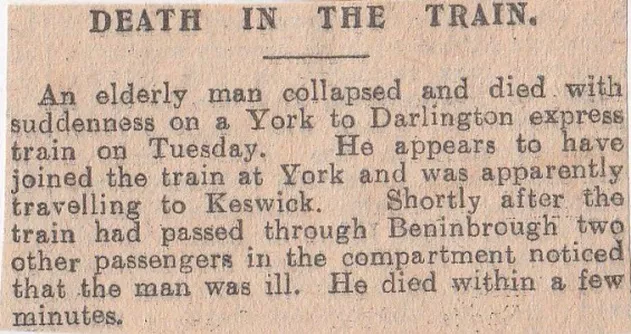
32/ Malton, March 1861 (Lovers Suicide)
A man walking by the bank of the Derwent River, between Old and New Malton, saw some women’s clothing and a bonnet in a bush, along with a Bible with the names of Gill and Preston inside. There was a set of women’s footprints that ended at the edge of the river, suggesting that a young lady had jumped from the bank. This was definitely a suicide. Elizabeth Gill was a domestic servant from Pickering who had started to form a relationship with a lad named Preston, who was from Old Malton. Preston worked at the house where Gill was a servant and he had left on Saturday and he had been followed by Gill. Somewhere along the line they suddenly erupted into an argument together and they both stormed off in opposite directions. She tried to get a room for the night in Old Malton, but failed. She was seen the next morning on the bank of the river reading her Bible. Dragging operations were carried out to find her body and it wasn’t until that evening that she was discovered. She had passed the hair on her head, through her teeth, so she would cover her face before taking the fatal plunge.
33/ River Ouse, York, (Recruits Drowned) October 1869
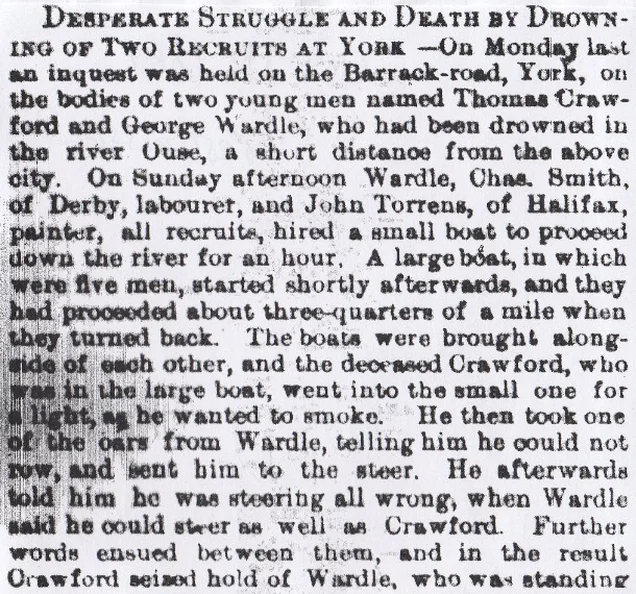
up, then the boat capsized and the two other men, Smith and Torrens, were thrown into the water. Torrens could swim but Smith had to be rescued by the other men. Crawford and Wardle grappled with each other in the river and Torrens tried to part them, but eventually, they drowned. The river was dragged and within an hour both corpses were brought to the surface. The jury’s verdict was that Crawford “Accidentally drowned” and that Wardle’s death was an act of “Manslaughter” by Crawford.
34/ Middlesbrough Murder, May 1908
An inquest was held on the body of Laura Hugh who was found murdered at her home on Saturday night. The mother of Laura identified the body as that of her thirty-year-old daughter who had been married for ten years or so, to Frederick Hugh, who had left her a couple of years ago. The mother didn’t know if she was seeing another man or not but had seen her with a bloke named Harry Holmes. When the mother was questioned as to why the husband and wife had parted, she replied “because of her going out I expect, and coming in late”- apparently, she liked to have a good time and a wee dram at the same time.
35/ Scarborough Boat Fatalities, (Four Dead) August 1868
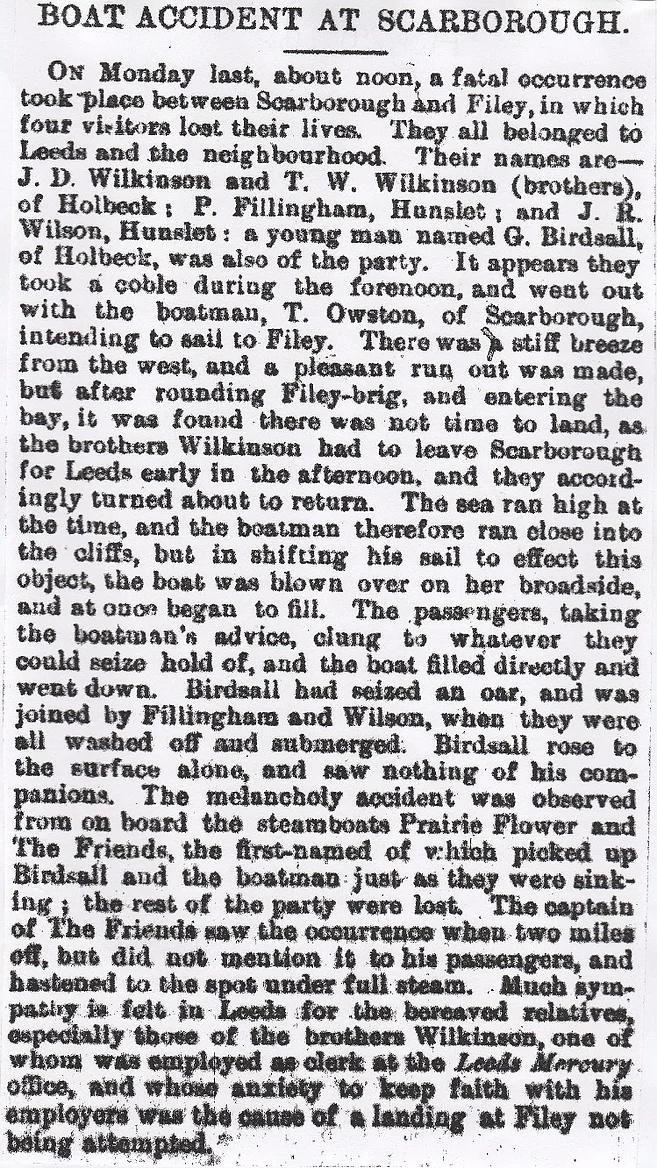
36/ York Double Murder, December 1904
Police are investigating the double murder of an elderly couple named Hewitt, who were found murdered in their house in York. They hadn’t been seen for a while so two blacksmiths apprentices were employed to force open the front door of their house. Mr Hewitt was lying on the kitchen floor with his brains smashed in and Mrs Hewitt was laid on the sofa with a piece of cloth covering her face and head. When removed, it was found that she too had been savagely beaten about the head and her skull had been caved in with a blunt object. The murder weapon has not been discovered but police have a very good idea of who perpetrated the murder. (Who murdered them?)
37/ York Wife Murder, February 1851
John Cooper was arrested and charged with the murder of his wife, Jane Cooper, at the beginning of January 1851. Cooper denies all knowledge his wife’s death by poison, but now the body of Jane Cooper will be exhumed so that an analysis can be made of her stomach contents. The motive for the murder was that Cooper was seeing the daughter of a Wesleyan minister from Alford in Lincolnshire, who he wanted to eventually marry and have kids with.
38/ Lendal Bridge Fatality, York, June 1895 (Not Landel/Its Lendal)
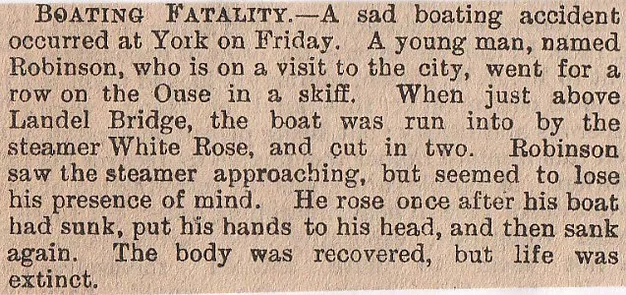
39/ Easingwold, April 1869 (Double Suicide)
If you look a bit further up the list you’ll see one from Malton and that involves another young lass named Elizabeth Gill who killed herself. Just a coincidence, just thought I’d mention it. This one though killed herself with a friend of hers and she was barely classed as an adult, in effect she was just a kid. Elizabeth Gill and Mary Ann Cariss both worked for Mr Haworth, a brewer from Easingwold, Gill being thirteen-years-old and Cariss fourteen-years-of-age. They went to church one Sunday evening with a young lad from Raskelf, named Richard Brough who was seeing Gill at the time. After going missing for a while, the two girls’ hats were found on some railings next to the reservoir, so it was dragged and the two girls bodies were brought in. They had not been molested or beaten up in any way, this was due to lack of bruising or cuts. In the top of their dresses, near the breast, each girl had a prayer book hidden away and evidence suggests that they had threatened to drown themselves on more than one occasion. A witness had seen them testing the depth of another pond nearby with a large stick as though doing a dummy run, but finding this pond not deep enough. Cariss had told someone else that Gill was pregnant and that this could have been the motive for such a rash act. The verdict was one of “Felo de se”.
40/ Scarborough, (Accidental Death) September 1869

verdict of “Accidental death.”
41/ Heslington Family Murder, near York, November 1905
An insurance agent knocked on the back door of the Pinkney’s house at Heslington near York but he received no answer, so he opened the window of the front room and saw Mrs Pinkney lying dead on the floor. He ran to get a policeman and when they entered the home, a truly horrific sight met their gaze. Mrs Pinkney had a child grasped in her arms and next to her was another of the kids, lying in a pool of blood. Mr Pinkney was found with his throat cut and a razor in his hand. Upstairs there was more carnage when they found another small boy lying on a bed with massive head trauma and on the floor of that room lay another girl with her head smashed in. Nearby was a hatchet covered in blood stains and with blood spatter everywhere. That left three children dead, the little one in the mother’s arms was clinging to life was rushed to York County Hospital. The mother died a couple of minutes after being discovered.
42/ Ganton, (Gamekeeper Killed by Poachers) November 1904

43/ Scarborough Suicide, February 1888
William Childerhouse from Hull killed himself in Scarborough under the strangest circumstances. He used to be in well-to-do circles, but lost his position and his money, and ended up on the scrapheap and had to get a position in a household. He tried to rekindle his old fortune by pinching off his employer, who let him off a handful of times but this time there was a warrant out for his arrest. He was found by a detective and when confronted, he locked the door of the room he was in. The door was bust open and Childerhouse dropped into the detective’s arms. He had taken some prussic acid and was already dead.
44/ Malton Teenager Murder, September 1903
A sixteen-year-old domestic servant at Derwent Farm at Scampston near Malton, by the name of Annie Marshall, went to go to the chapel but never arrived. A search of the area found her lifeless body in the River Derwent and in the temple were a couple of bullet wounds. Her mouth had been stuffed with grass to prevent noise or screaming and there were signs that she had been molested and raped. Marshall had been dragged to the river then dumped in the water and already the police have a suspect in detention. (Who was it?)
45/ Rufforth Double Suicide, May 1920
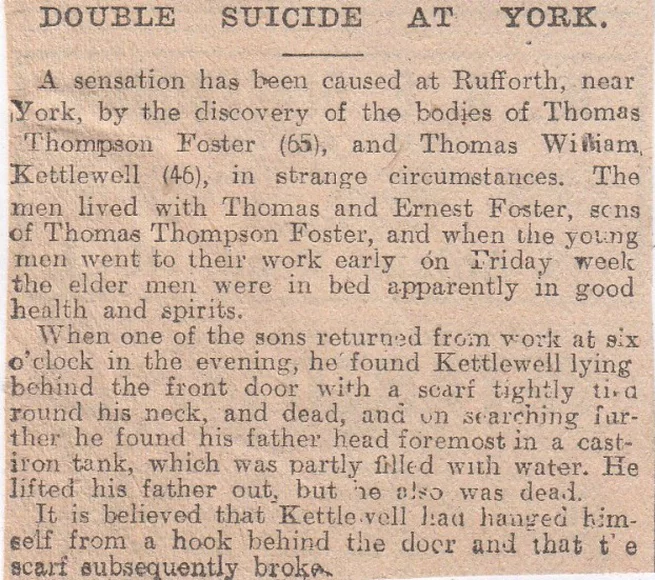
46/ West Sands Suicide, Whitby, June 1871
A young woman named Cooper, who earned a living by keeping a private school, found the pressure of Government inspectors too much to bear and wound herself up to such an extent she committed suicide. A government inspector popped his head in the door of her school in Whitby, purely in a friendly capacity, but Cooper became agitated and told him she worked with kids that long, she had forgotten how to speak to adults. This lingered throughout the day but in the evening she’d calmed somewhat, but sat down and made her will out, wrote a letter to her sister, then stripped off and walked out to sea.The letter read :
“I have enclosed my will in this envelope. I had no idea that I had so many worldly goods to dispose of, but am glad to be able to compensate you all for any trouble you may be put to on my account. Do not fret for me, as I shall be at rest when you read these lines. I could not endure another such a day as today has been. Will you or Barnett be so kind as to lock the doors and take charge of the keys until it is convenient for you to look over closets and drawers. I should not like strangers to turn all upside-down. Give my love to all. Goodbye- Eleanor Cooper, Friday evening, nine o’clock. I am going on the West Sands.”
47/ Beadlam near Helmsley, (Skeletal Remains) November 1881
Some workmen were removing the flagstones from a farmhouse floor, so they could put in floorboards instead when along the wall they discovered some quicklime. Digging in the lime they eventually found a pair of shoes sticking upwards and inside was a pair of man’s feet and some other random bones as well. It all seemed very neat and fresh and the pick-axe used to bury the body was also in the hole. Dr Bell from Helmsley examined the bones and skeletal remains and concluded that it was the body of a very tall man, and the house being more than a century old he thought it could be from that time era. The buttons on the coat were halfpenny sized flat-topped steel kind, used in the late 1700’s or early 1800’s. (Was he ever identified?)
48/ Helmsley Double Murder, June 1895
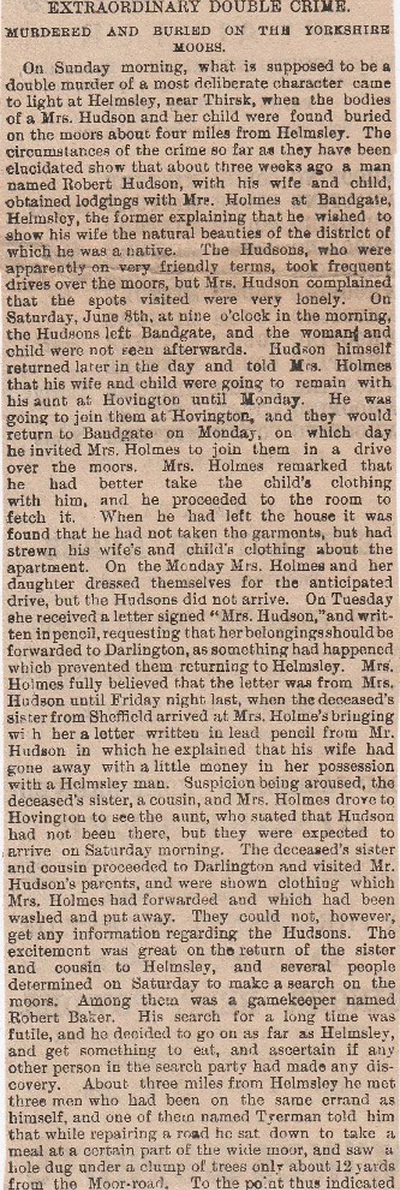

Helmsley Murders, June 22nd, 1895
The alleged Helmsley murderer was removed from Malton to Helmsley today, he was brought before the Earl of Faversham and formal evidence was given. The prisoner was remanded to York Castle for eight days. Exciting scenes were witnessed in Helmsley and along the route. The accused appeared very dejected.
49/ Helmsley Murders, July 27th, 1895
The trial of Robert Hasseltin Hudson on the charge of the murder of his wife and child on Roper Moor on the June 8th took place at York Assizes. Mr Waddy, the prosecutor, said the jury would probably come to the conclusion that a carefully studied plan had been executed by Hudson.He detailed the circumstances of the crime and concluded by calling three lunacy doctors, who having examined the accused, now deposed that he was of sound mind, and knew perfectly well the nature of the act he had committed.Mr Wragge, defending, deposed that they failed to notice any signs of epilepsy in the prisoner.The prisoner’s father said his son was always delicate.Mr Wragge said the jury had listened to one of the saddest and most melancholy tragedies in Yorkshire history.He suggested that the actions of the prisoner on and preceding the day of the murder, were inconsistent with sanity.The prisoner was suffering from the earlier stages of epilepsy.
The judge said there was nothing to show the accused did not know what he was doing- The prisoner was found guilty and sentenced to death.
50/ Warrenby, Redcar, (Fatal Boiler Explosion) June 1895
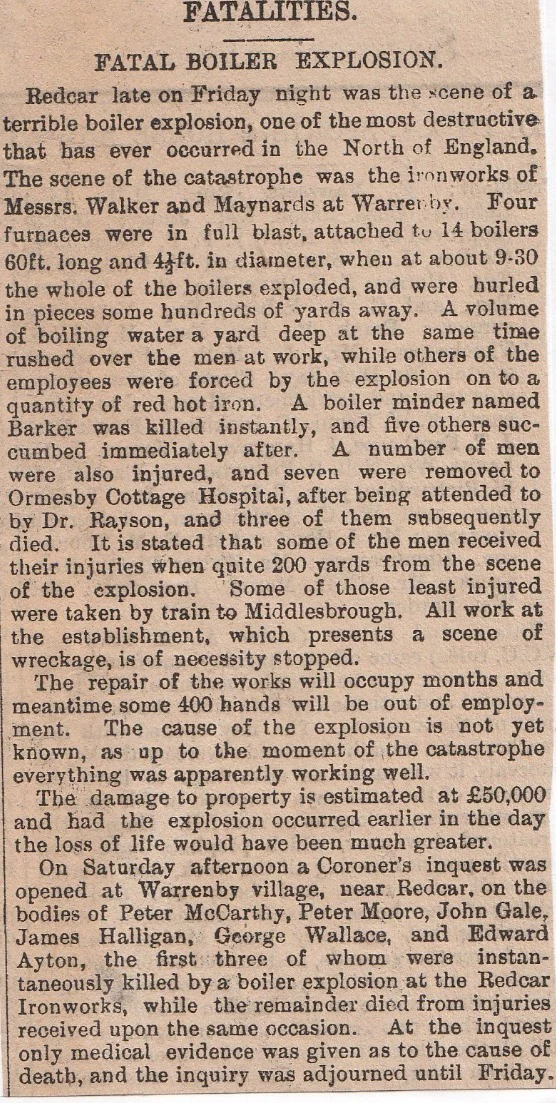
51/ Scarborough, (Seven Dead in Fire) June 1898
A report came through that Mrs Brooks and her six children had been burned to death in a shop fire at Scarborough. The shop (Health and Safety would have a heart-attack) contained bamboo goods and fireworks! Not surprisingly the building was a pile of ashes within three hours and the alarm was raised by a man passing along Queen Street, who noticed flames at the shutters. A man was noticed on the roof of a hotel which adjoined it and this was Mr Brooks. He seemed dazed and had jumped twenty feet from the building, severely cutting and bruising himself in the process. He was incoherent when asked about the fire but the truth came out a couple of hours later. When firemen entered after the fire they found Mrs Brooks and her sixteen-month-old baby burned to death, lying on the floor of the second storey bedroom. They were burned to a cinder and she was still clutching the child in her arms and in the back bedroom were the other five children. The eldest, a girl of fourteen, had tried to escape but the heat and smoke overpowered her and the flesh had been burned from her breast. The other four lay in bed, rather peaceful, probably dying of smoke inhalation before they were burned to ashes. Mrs Brooks was thirty-eight-years-old and she had four girls and two boys, all of whom are deceased.
The lamplighter who gave the alarm said he heard no glass being broken or nobody shouting for help. A witness also said of Mr Brooks “I never saw a man take things more quietly in my life”-(Applause in Court)-“When he came down from the roof, if only he had said something, we should have made an attempt at once to save his wife and children”- Did he do it?
52/ Selby Railway Station, (Fatal Accident)August 1892

severely crushed.
53/ Middlesbrough Railway Station Suicide, May 1880
A 65-year-old man named Metcalf was being moved by a couple of officer’s from Middlesbrough to York Castle when at the railway station, he pulled out a pen-knife and slit his throat twice, dying an hour from his injuries. The verdict was one of “Felo de se” or suicide, and the coroner issued a warrant to the Chief Constable of Middlesbrough and the churchwardens of the parish to bury the deceased within 24 hours of his suicide between the hours of nine and midnight. He was buried at 10-30 on Saturday night at the New Cemetery in Linthorpe, with no mourners present or any service being read. On the contrary, it was a very slap-dash burial with the body in a very poorly made coffin and the grave had not been dug when they arrived with him on the hearse. It was dropped off, with the rest of the grave hastily dug out, then he was dropped in.
54/ Young’s Commercial Hotel Suicide, Rougier Street, York, August 1892

55/ Malton Road, York, (Double Suicide) April 1902
Walter Gurdon was walking his dogs down Malton Road when they started sniffing about a man and a woman who were lying on the ground. When he got there he found they both had their throats cut from ear to ear. The woman was blindfolded. The man was soaking wet, so it is thought that he tried to drown himself first but failed. He is from Huddersfield and was named Carter, but an address in her pocket now suggests that she is the daughter of a Barnsley horticulturist named Bray, but she working in Huddersfield as a barmaid. She had received a telegram from him asking her to meet him in Leeds and the next anyone saw of them was when they found dead. Carter was about fifty years of age and married with three kids, she was only twenty-eight-years old. Her sister got a letter from Carter stating that: “he and Kate would have joined the angels by the time the letter arrived.”
56/ Tadcaster Child Abandonment, July 1889
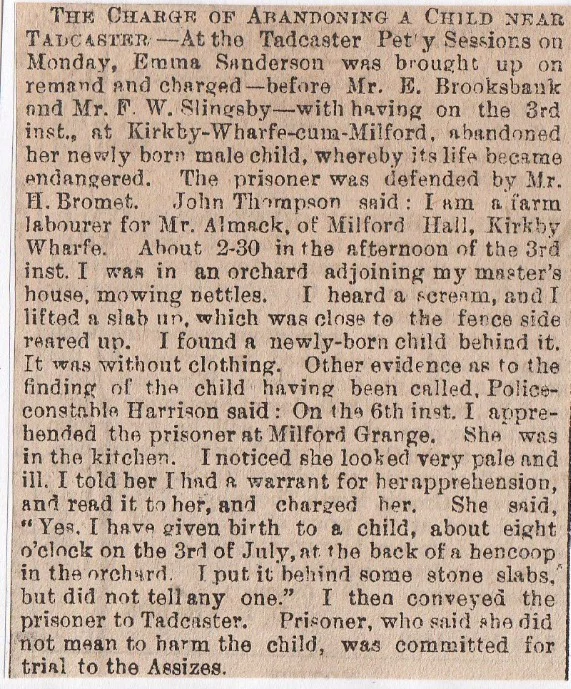
57/ Whitby Vicar Suicide, August 1881
The dead body of the Reverend Francis Augrave, B.A., curate of St John the Baptist’s Church, Peterborough, was found behind a wall of a field beyond the iron shipbuilding premises of Messrs Turnbull and Son, Whitehall, Whitby. The deceased and his brother came to Whitby on a short break and lodged at No 4, Wellington Terrace. He went out the previous afternoon and when his room was checked, they found an account of monies owed plus a list of money owed to him. A note was found addressed to his brother stating his intention to kill himself, mentioning that he had been told by doctors that his consumption was a hopeless case and would be the death of him. In his note, he wrote-“I cannot bear this slow death any longer”. He thanked everyone for their kindness, then put “Goodbye. God Bless you.” Deceased was in his early thirties and ended his life by blowing his brains out with a pistol.
58/ Whitby Beach Drowning, August 1896
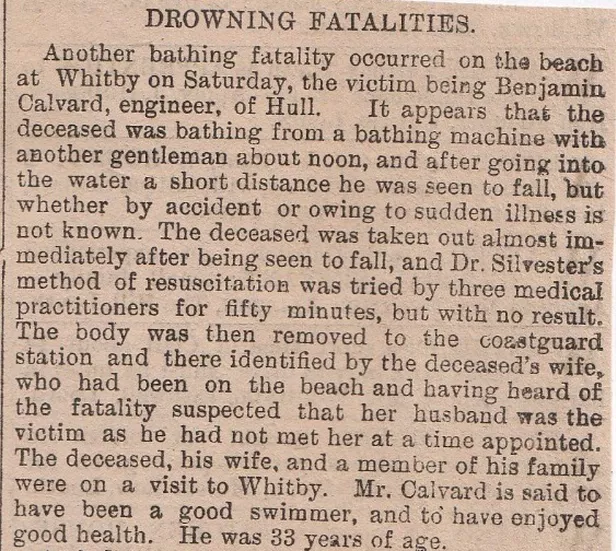
59/ Scarborough, (Accident or Suicide?) November 1898
At the foot of Castle Hill rocks, the mutilated corpse of sixty-seven-year-old Reverend H.H.Wright, late vicar of St Silas Parish in Sheffield, was discovered by some anglers. A marine drive is being built around the base of Castle Hill and the Reverend Wright’s body was about a hundred yards from the construction site. It appears that he had either jumped or fallen the two hundred feet from the top of Castle Hill. The skull was fractured, with both arms broken and one of his legs as well. The Reverend had been suffering from mental debility since giving up his clerical duties and was staying at No.6, Belmont Terrace, Scarborough, with his wife and two sons. The wife said he’d shown great improvement since coming to Scarborough.
60/ Clarence Gardens, Scarborough, (Attempted Murder/Suicide) February 1901
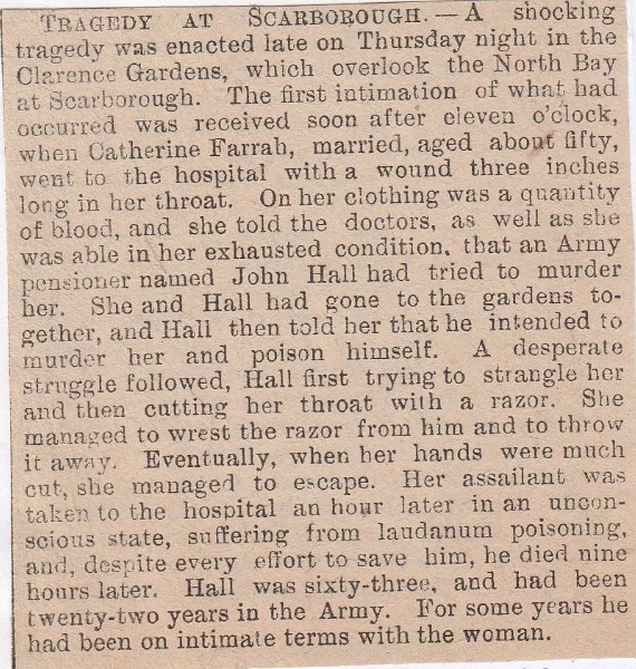
61/ Wheldrake near York, (Boy’s Suicide) September 1880
An inquest was held at Wheldrake on the body of George Edward Allcroft, the fifteen-year-old son of James Allcroft, a gamekeeper of Salt Heath near Stone in Staffordshire. Allcroft was living with his uncle, William Frost, who is the gamekeeper at Wheldrake, and was subject to a fluctuation in his spirits. (Asperger’s or similar?) He had been helping Mr Atkinson harvesting and when it was the men’s dinner break he wafted off on his own, then his cousin, Clara Frost heard the report of a gun at 1-30 p.m. She went to a cabin that he spent his spare time in and found his body on the floor, with a gun underneath his body. There was a piece of twine attached to the trigger which proves that this was a case of premeditated suicide.
62/ Ulleskelf Station, (Driver/Fireman Killed) November 1906
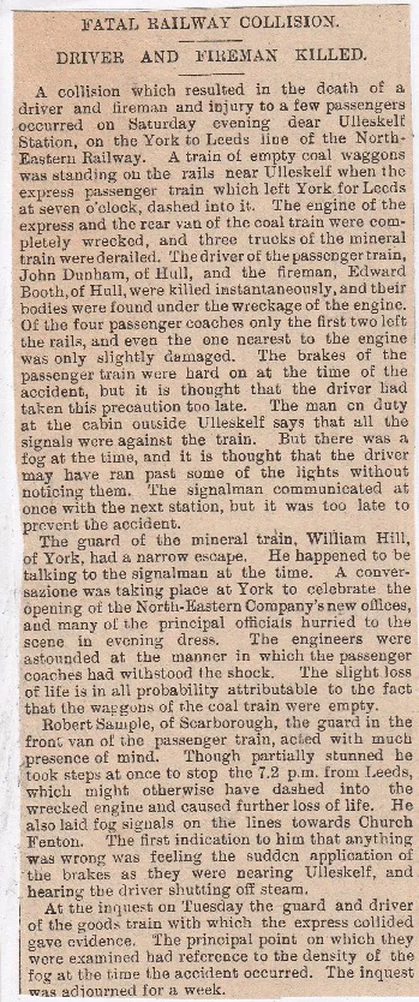
63/ The Strid Drowning, September 1870
64/ Death from Burns, Skelton Street, York. November 1902
65/ Starvation at Malton Workhouse, December 1902
Yorkshire (East)
1/ Brough Railway Station Death, near Hull, April 1883

2/ Goole Bathing Fatality, June 1883

3/ Old Sugar House, Hull, (Building Collapsed- Seven Dead) September 1868
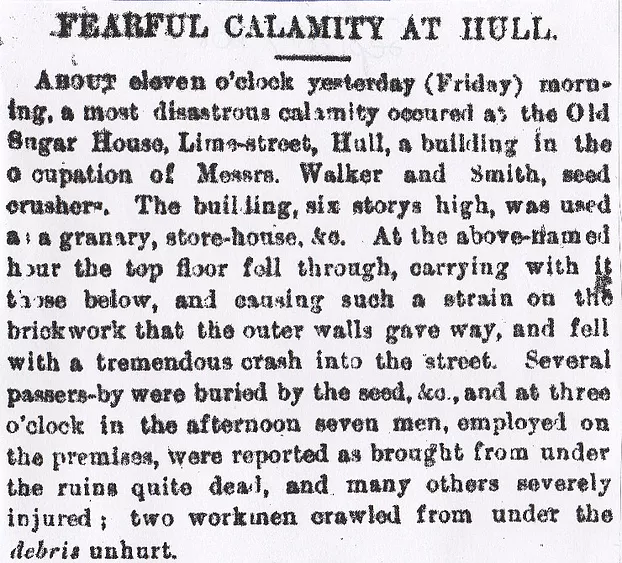
4/ River Humber/Hessle, (Corpse Washed Ashore) June 1859
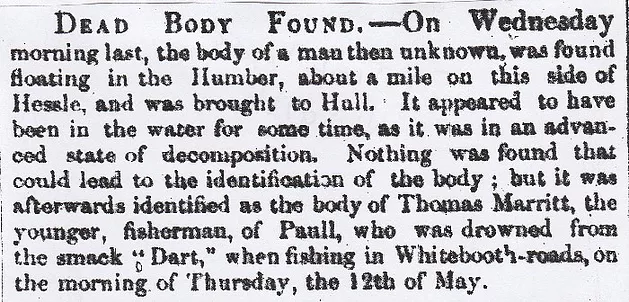
5/ Hull, July 1859 (Man Drowned)
About four o’clock on Wednesday last, a labourer named James Sayers found the body of a man floating in the Queen’s Dock, having been brought to the surface by the motion of a packet in the water. On being taken out it was recognised as that of Joseph Heppastall, moulder of Scott St. He was last seen alive about eleven o’clock coming out the Lugger Inn on the High Street very drunk.
6/ Burton Pidsea Suicide, September 1875

7/ Goole Child Murder, May 1881

8/ Hull December 1876 (Human Remains)
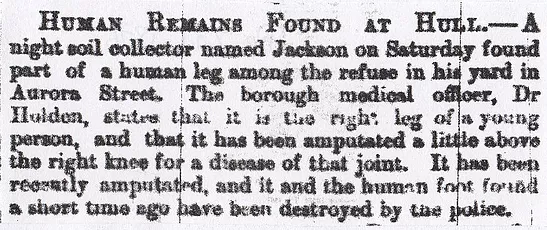
9/ Humber/North Sea, (Hull Steamer- Lady Drowned) July 1866

10/ Wressle Fatal Railway Accident, November 1862

11/ No.4, Elizabeth Place, Peter St, Hull, (Double Fatality) December 1884
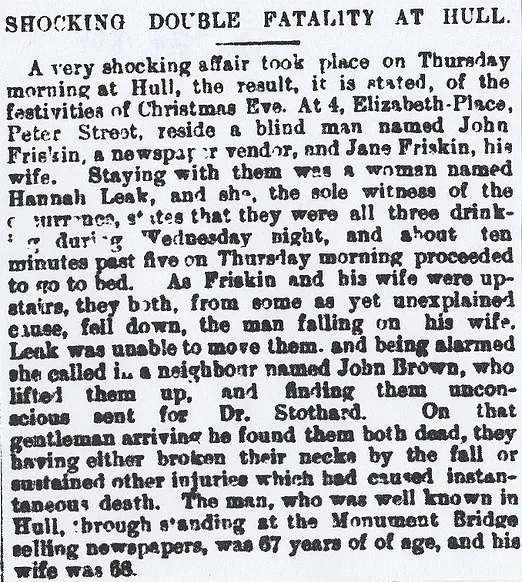
12/ Hull Balloon Fatality, May 1877

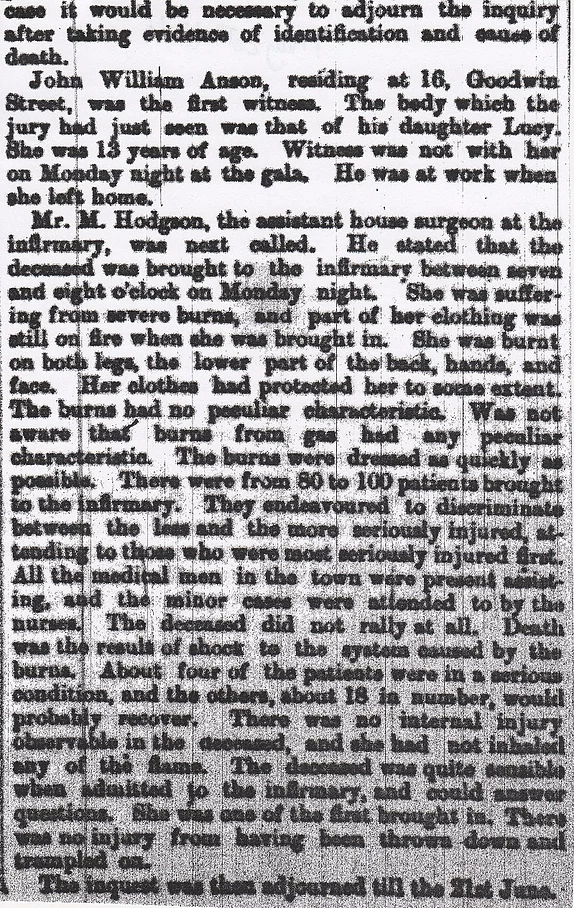
13/ Prospect Street, Hull, (Child Skeleton) June 1891
A child’s skeleton was found in the roof of a house that was having some building repairs done to it, in Prospect Street, Hull, East Yorkshire. The infant was wrapped in some old clothing and a newspaper which had the date of October 1871; more than twenty years ago.
14/ Sutton/Groves Ferry area, Hull, (Twenty Lives Lost?) December 1848
A shocking accident has taken place near the Kingston Cotton Mills, Hull, resulting in the loss of around twenty or so lives. The mills are just above the North Bridge and the workers used to cross the River Hull by means of a boat that kept on the Sutton/Groves Ferry area. At six a.m., around 25-30 stepped on board to make the crossing. The boat was in a poor condition, it was early on a December morning, so fairly dark and the heavy rains had caused the current to be stronger than the norm, so it was asking for it really. The warp parted from the post and the boat was out of control, then she tipped over and the passengers were thrown into the river. The majority were young lasses that worked at the mill and although seven have been brought to land, there are around fifteen still missing. The probability is that the remainder of the missing have been washed into the Humber by the strong current.
15/ The Humber, (Man Drowns) June 1883
On Sunday night six keelmen were returning from New Holland on the Lincolnshire side to Hull in a boat, and whilst on the Humber, the boat capsized and all of them were immersed in the water. The accident was seen from the shore and several boats at once put off and five of the men were rescued. The sixth, whose name was Samuel Attwood was not seen again, and it is believed that he was drowned.
16/ Bridlington Landslip Death, August 1855
Miss Lamplugh and Miss Oxley went for a stroll along the sands at Bridlington quay, when Miss Oxley went to get a drink from the water spring which issued from the cliff at Hilderthorpe, while Miss Lamplugh went back into town. Miss Oxley said she would follow her up but she never returned home. On a search being made, Miss Oxley was found under thirty tons of rock, as a landslip had occurred at the cliff. The rock had fallen on her while she was sat down having a rest and she ultimately died of suffocation. She was only twenty-five years of age.
17/ Victoria Terrace, Stamforth Place, Hull, (Scalded to Death) June 1889
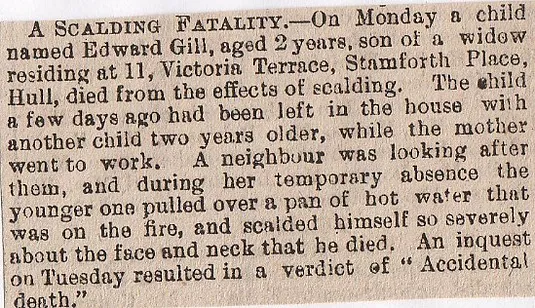
18/ Spurn Head Light-House, December 1861
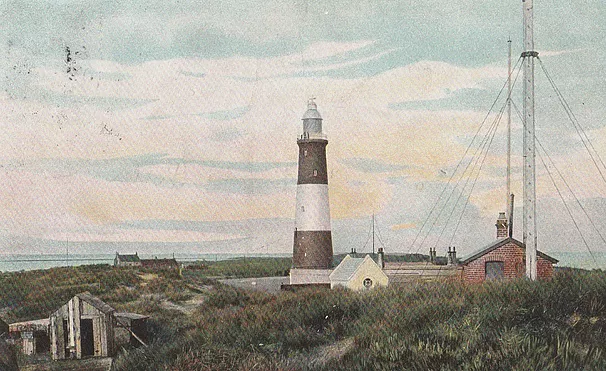
An inquest was held at the Coach and Horses Inn, Cleethorpes, before Mr Marris, coroner, on view of the body of Mr Henry Hammond, fifty-two-years of age who died suddenly on board the light-ship off Spurn. It appears that the deceased had enjoyed uninterrupted good health all his life and had never been known to complain of indisposition until the morning of his death. He seems to have gone to his berth towards evening, where he was shortly afterwards found dead. The surgeon gave evidence that in his opinion the deceased had died from heart disease. The jury returned a verdict accordingly.
19/ Hull Fisherman Suicide, April 1890
George Broadley, a fisherman from Hull, shot himself at that city. He accompanied a woman named Reynolds to her house and wanted to stay the night. She refused, then he pulled out a revolver and shouted: “It’s you or me!”. She scrambled from the building and ran to a police station. She met a copper on the way there and explained what had happened. Broadley saw the policeman and went back to Reynolds’s house with the policeman in pursuit. At the house, Broadley shot at the policeman twice, missing him both times, then put the gun to his temple and shot himself.
20/ Hull Child Murder, 28th May 1885
At Hull yesterday a young woman named Isabella Hewson went to the Central Police Station and stated that she had hanged her son. On visiting the woman’s residence the police found the boy suspended from the ceiling by a piece of clothes-line. He was quite dead. The woman was medically examined but there was nothing to indicate insanity and having been brought before the magistrates, she was remanded for eight days.
21/ Hull Child Murder, May 30th, 1885
At Hull yesterday a coroner’s jury returned a verdict of wilful murder against a single woman named Isabella Hewson who, on Wednesday, hanged her child aged two-years and gave herself up to the police.
22/ Aldbrough Double Suicide, July 1859 (Says Aldborough-but incorrect spelling)

23/ Beverley Murderous Attack, September 1878
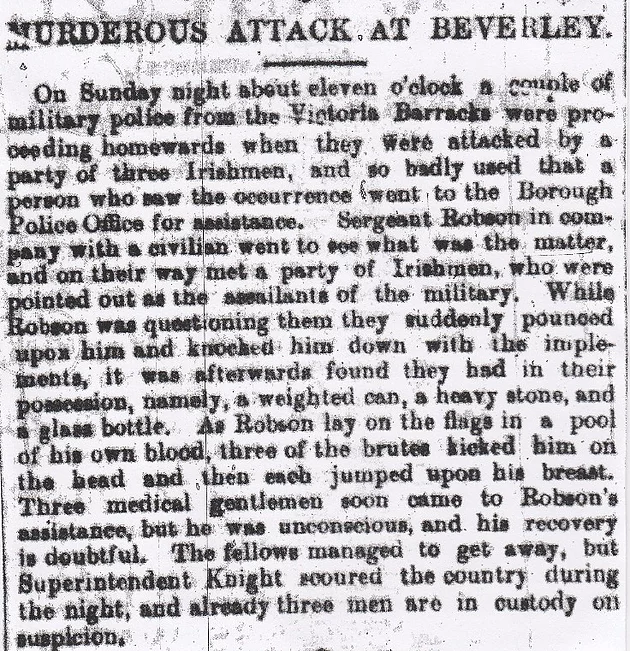
24/ Helperthorpe Suicide, near Driffield, February 1873
The parents of the victim, one Margaret Pickering aged twelve, were the innkeepers at Helperthorpe. The father accused her of nicking some money from the till which she claimed was untrue. Her sister had told the father that she spent money like it was going out of fashion in the village (It was two shillings), so the mother decided to hit her with a leather strap on her shoulders but she still denied any knowledge of the theft. Margaret went to the kitchen and then a scream bellowed out. The father found her on the floor and she garbled some last words to him: “You don’t know what you have done. I have taken some of the poison that mother killed the mice with, and if you look in the oven, you will find the paper”.
When he looked in the oven he found the Battle’s Vermin Killer paper. His daughter died in agony shortly after.
25/ Between Drewton and Weedley Tunnels, (Body on Tracks) August 1889
On Tuesday morning about nine o’clock, the body of a ganger named John Flint, in the employ of the Hull and Barnsley Railway Company and residing in Weedley Springs, was found on the line between the Drewton and Weedley tunnels. It was fearfully mutilated and deceased is supposed to have been run over by a passing train. He was forty years of age and leaves a widow and family.
26/ Walmsley Street, Hull, (Epileptic Found in Fire) December 1915
A terrible burning fatality occurred at Hull on Monday. A milkman called at the house in Walmsley Street and failing to get a response to repeated knocks he entered the house and found the charred body of a widow named Brown lying on the hearth. In the opinion of the medical man, the unfortunate woman had had a fit and fallen with her head in the fire. Deceased’s daughter was at Grimsby visiting friends.
27/ Bear Street, Hull, (Murder/Suicide) July 1895
On Monday night at Hull, Thomas Parkinson, ship’s steward, went to the house of his sweetheart, Miss Ormond, residing in Bear Street. They had a quarrel during which Miss Ormond said that she did not want Parkinson’s attentions. The latter having declared that she should not have anybody else, shot her in the back with a revolver, then shot himself in the breast inflicting a fatal wound. The young woman is expected to recover.
28/ Burton Pidsea Murder Confession, August 1905
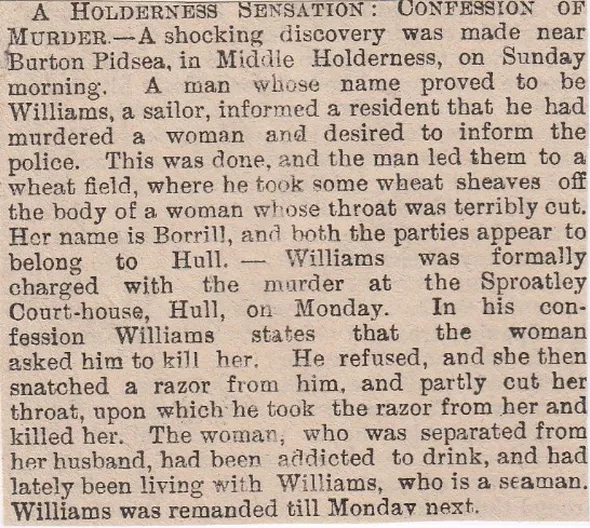
29/ Cross St/West St, Hull, August 1859 (Pub Fatalities)
A fatal accident has occurred at the Lord Durham public house situated in Cross Street, West Street, Hull. The landlord George Taylor had to tap a puncheon of rum so he got a red-hot poker to make the hole bigger because the hole was too small. The spirit ignited, burning him on his hands and arms and his hair was singed off. He ran into the street and people rushed to help him. A fire hose and engines arrived but by now the pub was fully alight. Two of Taylor’s kids were enveloped in flames, they were only four and six years old and were rushed to a hospital. There were another two children in the pub, namely Emily Clifton aged five, the daughter of Henry Clifton of Vincent Street and Mary Stewart a four-year-old whose parents reside opposite the Lord Durham. Clifton was badly burned but not as bad as the Taylor’s and later on that night the three children died the following day. Another body was found in the ashes of the pub, burned to a cinder.
30/ Hull Docks Murder? August 1860
It appears that two German captains were seen on Monday morning in company with a female at the Docks at Hull. A custom-house officer observed them in close conversation, then he heard a violent scream and on looking round he saw the woman struggling in the water. He ran to the two captains and asked them what they had done, but they made no reply. The girl was rescued and brought onto land where she gave one sigh, then expired. The two captains had scuttled off making no effort to rescue the girl. She was later identified as Lucy Gray aged twenty-five. Both captains are now in custody and were taken to the stipendiary magistrate in Hull, who remanded them until today. (What happened to them?)
31/ No.30 Regent Street Suicide, Hull, June 1861
James Akroyd and Charles Brook had been out on the Saturday evening and went back to Brook’s house, 30 Regent Street at 12-30. They went in the backyard and Akroyd was entering the house when he heard the report of a pistol. He saw Brook lying on the floor with a gunshot wound to the head and the pistol next to his body. He was lifted into the kitchen and medical assistance was procured but to no avail, as he died an hour or two later. When examined Brook had another pistol in his other pocket, suggesting premeditation, and the only motive for the rash act is that Brook was addicted to betting on the horses.
32/ Porter Street Suicide, Hull, February 1863
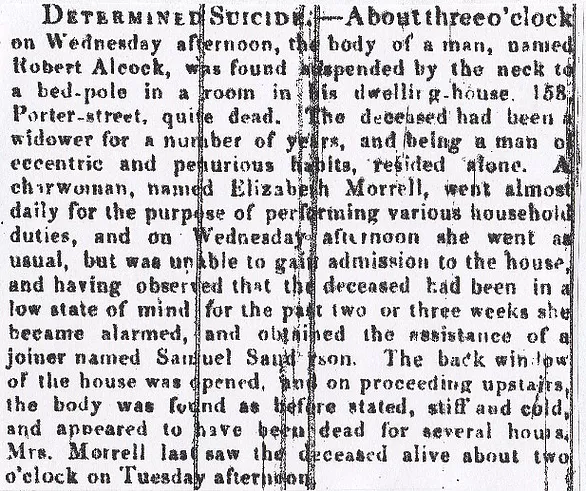
33/ Howden Station Fatality, February 1863
A fatal accident at Howden Station near Hull, to a guard named John Sight, occurred on Thursday. It was his business to act as the guard on the 7-10 a.m. train to Leeds but he overslept and missed it, and came by a later one which arrives at Howden at 11 a.m. intending there to join his own train which left Hull on its return journey to Leeds at 10-40 a.m. On the arrival of this train at Howden at 11-25 a.m. and whilst it was in motion he tried to clamber aboard, but slipped and fell between two carriages which ran over him. Both legs were crushed and he was taken to the ladies waiting-room. He lingered for about four hours then he expired. He was from Leeds and leaves a wife and four children. Verdict-“Accidental Death”
34/ No.8, Arnott’s Square, North Street, Hull, January 1864 (Suicide)
A suicide was committed in Hull, by Thomas Iveson a 42-year-old postman, who lived at 8, Arnott’s Square, North Street, Prospect Street. He had been unemployed for some time and his neighbour, Louisa Dann, found him at about one a.m., at his home. She heard moans and forced open the door and asked him what he was doing. He replied, “I have killed myself”. A surgeon was fetched but he died from the terrible lacerations on his throat and on one of his arms. P.C.Sanders found a pen-knife on the mantle-piece, covered in blood and also a note on which was written “Dear Jane”-meaning his wife. It read:
“I will be a burden to you and my friends no longer. Farewell! Bury me in Hedon, and forgive me”
His wife was out when he did this and he has no family. -Verdict “Temporary Insanity”.
35/ At the rear of the Asylum (Boys Drown) April 1864
Two lads, one aged twelve and one aged thirteen went with three mates to a field at the back of the Asylum, where there is a pond, to bathe. The lads, William E.Connolly and John Fernes, stripped off and entered the water. After a few minutes, their companions saw them sinking, with the depth was greater than any of them had anticipated. Unable to swim to save them they ran to the junction on the railway line to get the pointsman, William Lazenby to help them. He dragged the lads out but they were quite dead and they were taken to their homes, Connolly to West Street and Fernes to Mill Street.
36/ No.19, Mason Street Suicide, Hull, May 1865
On Saturday morning last, an old woman named Ann Eaton was found to have committed suicide by hanging, in the house No19, Mason Street. A servant girl employed there found her body and at once gave information to P.C.Elvin, who was on the beat in the area. Elvin forced the room door open and cut the body down from the bed-post, but she was dead. Ann Eaton was about seventy-four years of age.
37/ Hull Town Hall Fatality, August 1865
An accident occurred at the New Town Hall in Hull which ended with a fatality. A decorator, William Funicane of London, was painting the ceiling of the grand staircase. He walked along a plank which had become displaced at the end, then it gave way and he was thrown down about twenty feet. He had a fractured skull and was taken to the Infirmary. He leaves a widow and three children and the verdict was one of “Accidental death.”
38/ Sutton Drain, (Body Found) February 1866
The body of a young woman was found in the Sutton Drain. It was removed to the dead-house where it was recognised by Mrs Raby, Clean Alley, Witham, as that of her daughter Jane aged seventeen years and who left home about three weeks ago stating that she would commit suicide. An inquest was held on the body and the verdict was “Found Drowned”
39/ Old Harbour Infanticide, April 1867
A young woman, Elizabeth Nelson, who is in custody of Hull police was charged on her own confession with the murder of her infant son. She alleged she had thrown the body in the Old Harbour and the body of an infant was found at Brough Haven. A nurse said she recognised it as that of Nicholas Nelson, son of the woman living at Machell Street, Hull. The mother came in labour to the Union on February 17th last. She left the Union on March 13th, the child being registered but not baptised. The mother took the child while the nurse was having dinner, then left with it fully clothed, but was found naked. The mother was not kind to the child and called it ill-names, but she’ll be charged with wilful murder.
40/ Above story continued, August 10th 1867

Judge passed sentence of Death.
41/ Southcoates Station Fatality, August 1869
A shocking accident occurred at Southcoates Station on the Hull and Withernsea branch of the North-Eastern Railway. John Roe, a porter, had been there a number of years in the service of the company, while fulfilling his duties had occasion to cross the lines about the time the express from Withernsea was due, he did not observe the train coming upon the other side and was run over and terribly mutilated, his arm being cut off and his head fearfully crushed. The surgeon was called for but could offer no assistance, death following within fifty minutes. A verdict of “Accidental Death”.
42/ Passage Street Fire Deaths, Hull, March 1870
A fire broke out on the premises occupied by an emigrant agent named Weber, in Passage Street, Hull. A young woman jumped from a bedroom window into the arms of a policeman and escaped unhurt. Two hours later when the fire had been extinguished, the bodies of Mrs Weber along with a man and a child, were found dead.
43/ Wilberforce Buildings, High Street, Hull, (Body in Chimney) June 1870
A singular discovery was made in a chimney in the office of Mr Norman, Wilberforce Buildings, High Street. Some workmen were engaged in the chimney in that part of the offices when they came across the skeleton of a man, which, by its appearance had been in that position for many years. A considerable time since the office was used as a banking business, at which time an entrance was made by thieves and around £90 was stolen. The only conclusion to this is that the thief while being surprised, made off up the chimney and whilst in such a confined position, had been suffocated.
44/ Dock Street Murder, Hull, March 1871

45/ New South Bridge, Hull, August 1874
Early on Tuesday morning last, a man whose name is unknown, was seen to run towards the new South Bridge which crosses the River Hull to the east side of town and jump over the gate, trying to avoid paying to cross it. The bridge, however, is kept open during the night and a chain put across it to prevent accidents. He jumped over the chain and instead of alighting on the bridge, he fell into the dark abyss of water below in the river where a strong tide was running at the time. A boy heard a splash and a scream and told the keelman, who tried to grapple hold of the man with a hook but found nothing. The river was dragged but up to Thursday morning, no body had been discovered.
46/ The steamer Sappho Murder, March 1875
During the past week, a memorial has been laid in the Town Hall in Hull, and mostly signed in favour of a commutation of the sentence of death passed on Robert Searle, alias Edgely, for the murder by stabbing, of a fellow fireman named McCannell on board the steamer Sappho. He was sentenced at the York Assizes on Friday the 19th inst. and at the time insanity was pleaded, Searle denying all knowledge of the occurrence. The prisoner at the time of the murder, cut his own throat and for some time life was despaired of; and it was stated in evidence that he had tried suicide once or twice before. (What happened?)
47/ The steamer Navarino Death, July 1875
An inquest was held on Wednesday night last, on the body of a man named Walter Martin who was killed on the previous day, on board the steamer Navarino while loading for New York. He fell into the hold and a cask of alum falling upon him, death was instantaneous.
48/ Bank Side Mill, near Sculcoates Gas Works, (Boiler explosion) September 2nd, 1876
A disastrous accident occurred at the Bank Side Mill near Sculcoates Gas Works. As the mill was in full work, the boiler which drives the machinery burst with a tremendous noise scattering the fragments of the building in all directions. As soon as the smoke and dust cleared away it was found that one of the workmen, the engine driver, was literally blown to pieces, while the owner of the mill, his three sons and another workman were dreadfully scalded. All the injured men were said to be in a precarious condition. They are all conscious but suffering horribly and little hopes are entertained for one or two of them.
49/ Bank Side Mill, near Sculcoates Gas Works, September 9th, 1876

50/ Hull Murder, March 2nd, 1878
At the Hull Town Hall on Wednesday, an inquest was held touching the death of Mrs White, who was stabbed on the 18th inst by Vincent Knowles Walker and who died a few minutes afterwards. Several witnesses gave evidence bearing out statements made at the time the act was committed and ultimately the jury returned a verdict of “Wilful Murder” against Walker.
51/ Hull Murder, March 16th, 1878
Vincent Knowles Walker was charged on remand with the murder of Lydia Wills White on the 18th ult. Mr Terry appeared for the prosecution and stated that the prisoner had been remanded in order that a plan of the premises, No 37, Nile Street, where the murder was committed, might be prepared. The prisoner was formally charged after the plan was submitted and he replied “No!” to the question of whether he had anything to say.
A couple of weeks later he was found guilty and sentenced to death, but then a week after that in early April, a petition praying for the commutation of the capital punishment to penal servitude for life, suggesting that he received extreme provocation which would warrant a life sentence.
52/ Sutton-on-Hull Suicide, September 1878
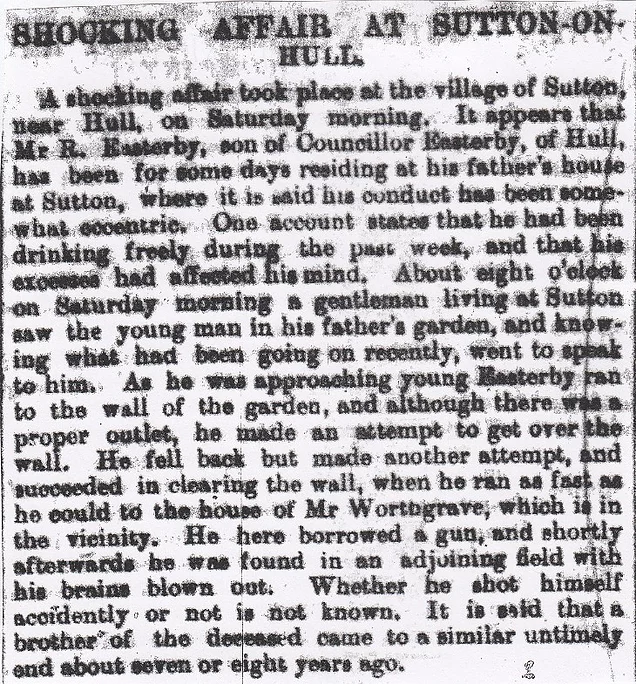
53/ Marfleet Drain Suicide, August 1879
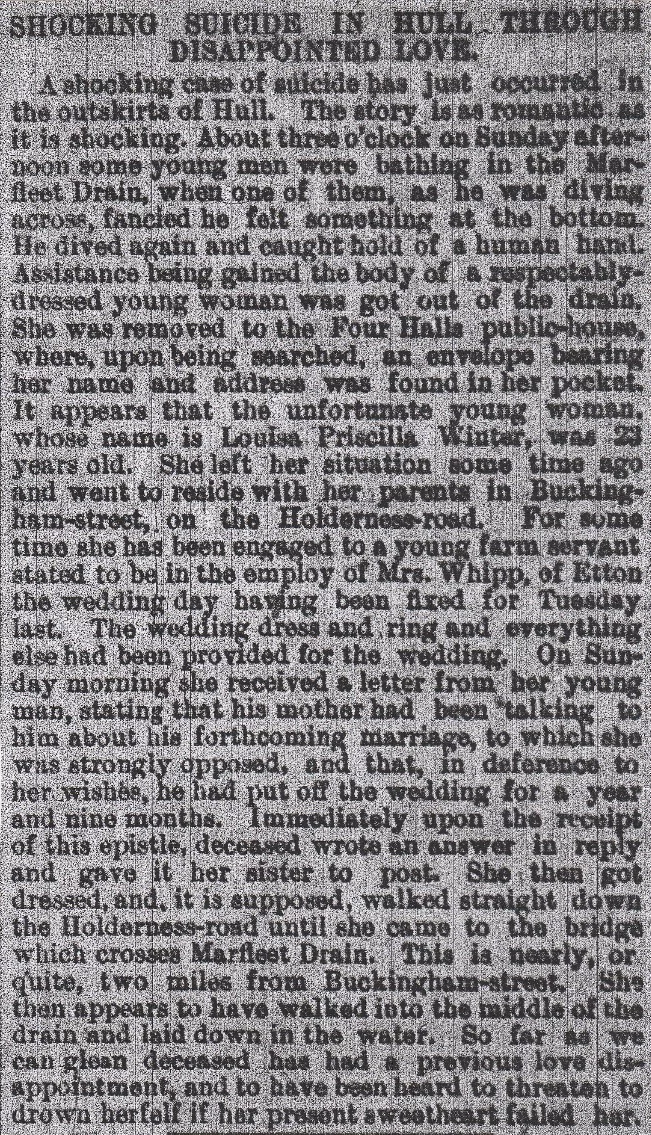
54/ Hull Wife Murder, June 1881
A Hull fisherman named James Ash, gave himself up to the police on Wednesday stating that he had murdered his wife because she had accused him of infidelity. On going to an address given the police discovered the woman lying on the floor quite dead, there being a deep stab in the chest. At seven p.m. the coroner’s jury returned a verdict of “Wilful Murder”, against James Ash for the murder of his wife.
55/ Victoria Docks, Hull, (Child Deaths) September 1882
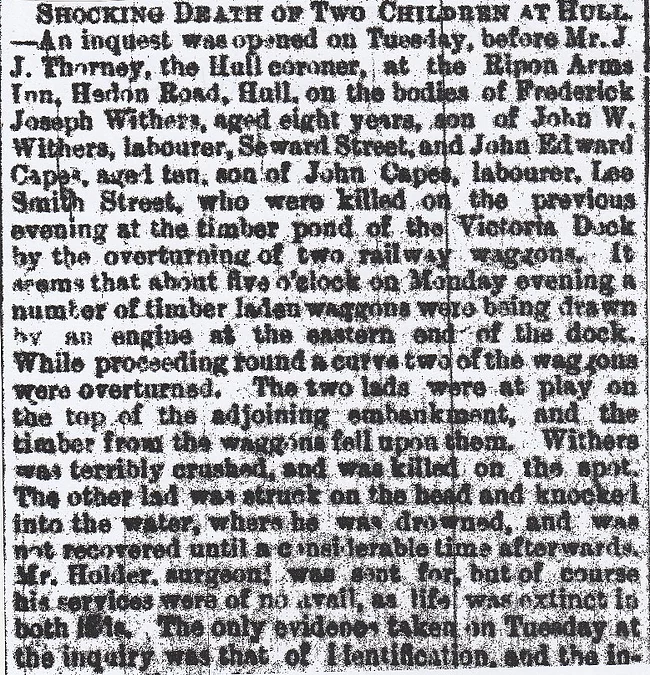
quest was then adjourned until October 5th.
56/ Hull Docks Fatality, October 1885
On Tuesday morning a fatal accident occurred on board the Wilson Liner Marengo, which was lying in the Hull Docks. James Delaney a labourer, was in the hold engaged in receiving bales of wood pulp when the winch slipped out of gear and the bale being lowered fell and struck him on the head. He was picked up by fellow workers, but exclaimed “Oh Dear”, and then expired. He was fifty-three-years of age and resided at 67, North Street.
57/ Chalk Lane Suicide, Hull, May 1886

58/ West Dock, Avenue End, (Railway Death) December 1886
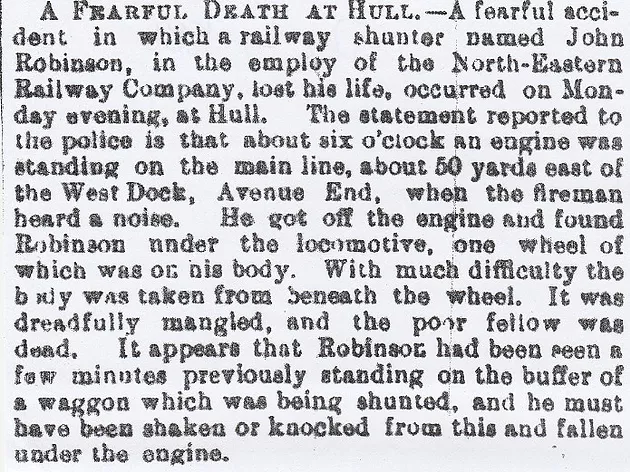
59/ H.M.S.Rupert, Hull, (Fatal Accident) June 1887

60/ Prince’s Dock Child Murder, Hull, July 1888
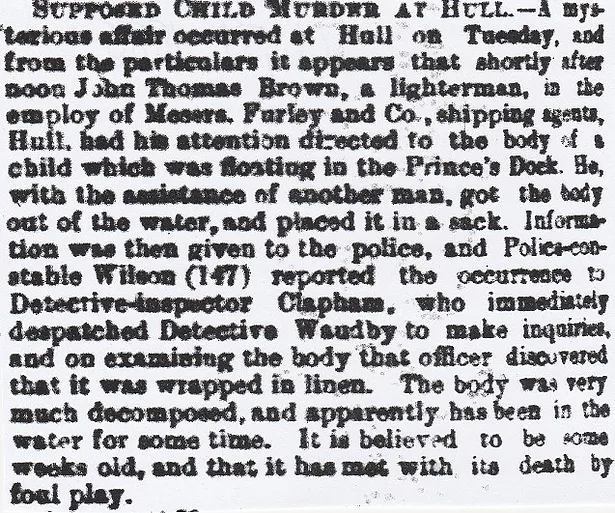
61/ Cherry Burton church Fatality, near Beverley, December 1875
While the service was in flow in Cherry Burton parish church, a clock weight came through the belfry roof and landed on the young housemaid from the rectory. Her injuries are so severe that there is no hope of her recovery and the young chap sat next to her was also badly hurt. The sad part of the story is that the two who were hurt in the accident were getting married this week.
62/ English Street Suicide, Hull, October 1877
Mrs Anderson, the wife of George Anderson, a labourer who works for the North Eastern Railway Company, was cleaning up one of their properties in English Street, Hull, for the purpose of moving in. She went upstairs when a terrible stench hit her nose and checking around she found the corpse of a man hanging from a beam. She ran to get help. The body was very decomposed but it was identified as that of Joseph Smith aged forty-two, beer-house keeper living in Hessle Road who had been missing since August 22nd. It is thought that he entered the house on August 22nd and hung himself immediately.
(English Street- next to Hessle Road and Clive Sullivan Way)
63/ Edward’s Place Murder, Hull February 1886
The body of Louisa Wharan, who is divorced from her husband was found at her house at Edward’s Place, Hull, with the head almost severed from her body. At first, it was thought to have been a case of suicide but it is now certain that she was murdered and a man has been arrested as a result of the evidence.
64/ Hull Pub Murder, May 1885 (What pub was it?)
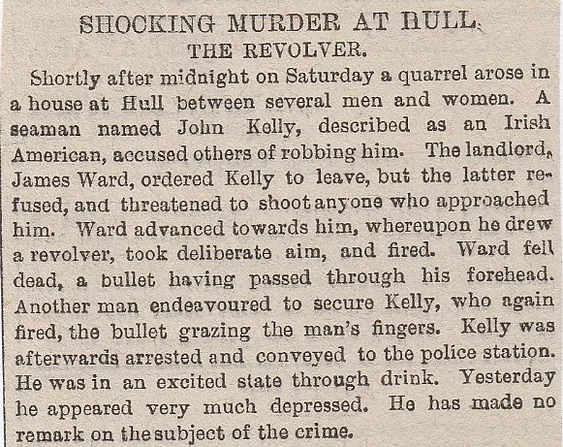
65/ Hull, (Attempted Double Murder/Suicide) July 1885
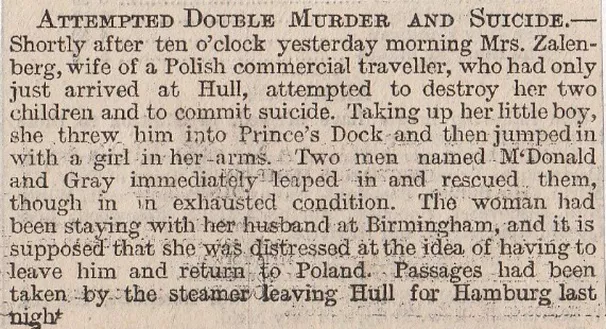
66/ Goole, (Homeless Man Suicide) January 1888
An inquest on the body of Joseph Bedford, seaman, resulted in a verdict of felo de se. Deceased was forty-nine-years-old and had asthma and lived out of a perambulator, which he wheeled about the streets of Goole. One day, fed up with living out of a pram and the sufferings that came with it, he threw himself into the canal and drowned.
67/ North Ferriby near Hull, (Reverend Suicide) June 1891
The body of Reverend Ezra T.Shaw, minister of the United Methodist Free Church in Hull, was found on the bank of the River Humber at North Ferriby. A revolver lay next to him and a gunshot wound was self-inflicted to the side of his head. The Reverend had been in low spirits for some time and is a clear case of suicide.
68/ Wincolmlee Murder/Suicide, Hull, November 1841
A murder/suicide was committed at Wincolmlee, Hull, by Robert Hickson, a deaf and dumb man. He had an argument with Sarah, his wife, when he grabbed a poker and whacked her on the head with it, then killed himself by slitting his throat with a razor.
69/ Humber Bridge Plans, August 1865 (This was being talked about in the 1860’s, same as the Channel Tunnel)
As the survey approaches completion, speculation is rife as to the ultimate object of the promoters. The following hypothesis, founded on well-authenticated data, may be taken as the basis of the scheme:- A bridge from Hessle to Barton at a point nearest to Hessle Windmill, to the cliff formation on the south or Lincolnshire shore, a line of ten miles or thereabouts, connecting the proposed bridge with the existing Trent, Ancholme and Grimsby line, with running powers over the South Yorkshire to Doncaster, and a branch of six miles from Appleby to Santon (both in the same parish) to Kirton, making connection with the Manchester, Sheffield and Lincolnshire Railway in either of the latter parishes, both of which present eligible and easy gradients. The mileage from Hull to Retford would by such a line be reduced by nine miles, and by avoiding a curvature system, a deviation from the Trent and Ancholme in the Appleby Carrs eastward, brings in the hill-side villages; thence to Barnetby, joining the Hull and Lincoln Branch of the Manchester and Sheffield system, thus bringing Hull eleven miles nearer Lincoln and by the Trent twenty-three miles nearer to Doncaster by the North-Eastern and nineteen miles nearer by the Manchester and Sheffield line via Retford, and over the Trent and Ancholme an advantage of twelve to thirteen miles ,thus presenting a prospect of improved mileage in all places.
70/ Withernsea Drowning, August 1864
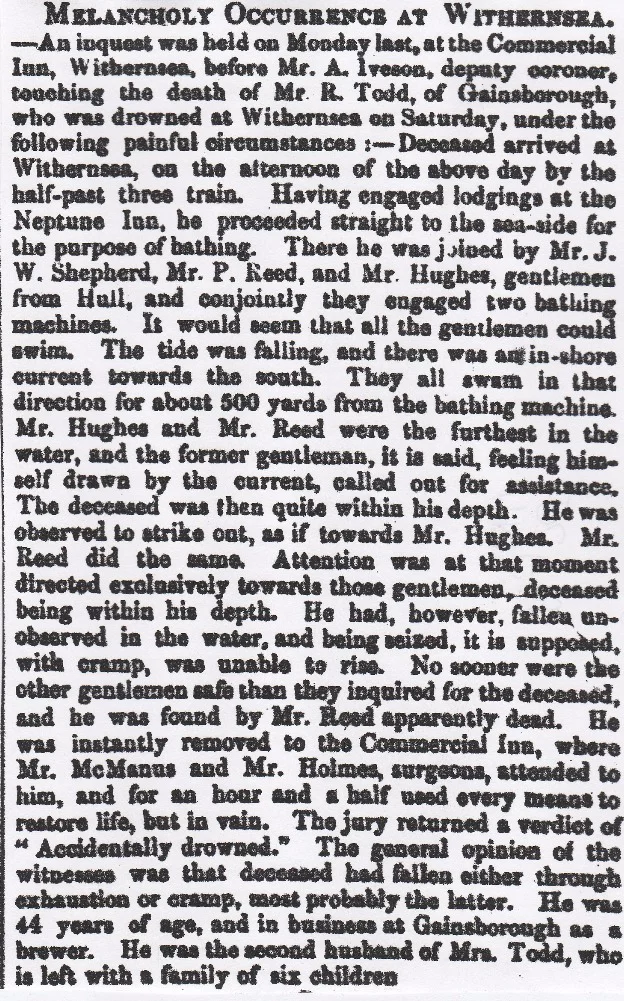
71/ Broomfleet near Brough, (Murder/Suicide) January 1907
A mother, Mrs Arthur Newbourn, got up in the night in her night-dress and carried her baby to the brickyard pond and dived into the water. Both the mother and child were drowned. Since the birth of her child, she had been extremely despondent and she leaves a husband and four other children behind. About two years ago, the mother had one of her children drown in the same place as she did.
72/ Goole, (Attempted Triple Murder/Suicide) July 1908
A married woman named Sawyer got hold of a shilling’s worth of laudanum, which she swallowed most of, then dished out the remainder to each of her three kids. She then got a razor and slit her own throat, severing the windpipe. Sawyer’s life is in the balance, as is that of her eldest daughter who cannot be aroused. (Did they die?)
73/ Beverley Racecourse Manslaughter, June 1910
Charles Brown was committed for trial at the assizes by the Beverley justices, charged with causing the death of Walter Edward Nozedar Rulleyman of Hull, by hitting him on the jaw, on the first day at the Beverley Races. A verdict of manslaughter was returned by the coroner’s jury.
74/ Stamford Bridge near York, (Boating Accident) May 27th, 1899
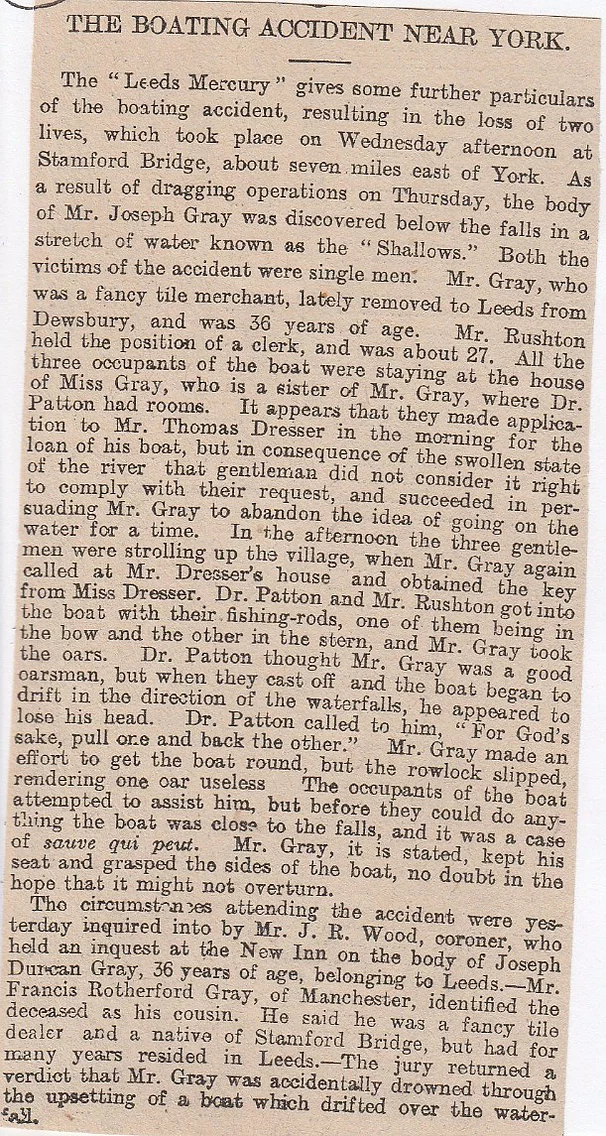
Stamford Bridge Inquest Verdict, May 30th, 1899
An inquest on the body of Albert Rotherford Rushton, Shakespere Street, Manchester, manager of a cotton goods warehouse, who was drowned in the River Derwent on Wednesday last. Along with two companions, Mr Rushton went on the river in a boat to fish. The craft was swept by the swollen current over a waterfall and only one of the occupants, Dr Patton of Stamford Bridge, escaped. The other victim was Mr Gray, a fancy tile dealer from Leeds. A verdict of “Accidental death” was returned.
75/ Temperance Hotel Suicide, Hull, June 1910 (Now the Masters Bar on Jameson St/South Street)
A suicide in the Temperance Hotel, Hull, has caused quite a stir in the city. The body of a forty-year-old man was discovered dead in bed with a revolver by his side and a letter addressed to “whom it may concern”. In the letter, the deceased states that he is the son of Professor Alfred Wahlberg from Stockholm in Sweden. (Was it the professor’s son?)
76/ Flamborough Head Zeppelin Attack, August 1916
The Hull trawler Endymion was fishing off the coast off Flamborough when it was attacked by Zeppelin L 21. The trawler cut her gear and dodged the bombs being dropped by the Zeppelin, which tried a few times but kept missing its target. The trawler eventually crawled back to the Humber but several crew were missing from her, due to the bomb explosions nearly lifting the craft out of the water.
77/ Bromley Terrace, Woodhouse Street, Hull, (Child Murder/Suicide) February 1907
Twenty-eight-year-old Frederick Willingham of Bromley Terrace, Woodhouse Street, Hull, strangled his one-year-old son and then killed himself by hanging. Mrs Willingham had been visiting the dead child of a friend when she came in and found her husband and son. He had been unemployed for some time and had become depressed.
78/ Goole Murder, (Execution of Ellis) August 1896
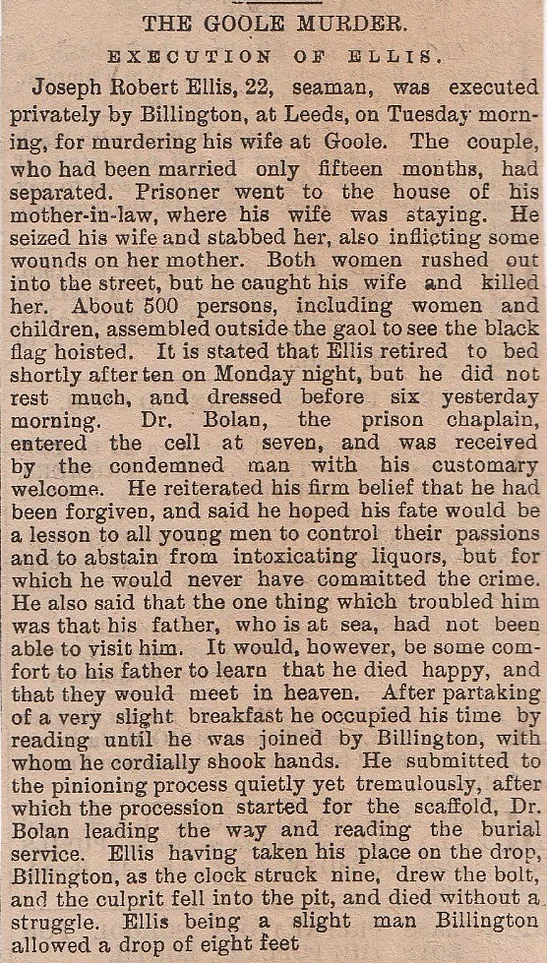
79/ Hull, (Suicide/Attempted Double Murder) May 1891
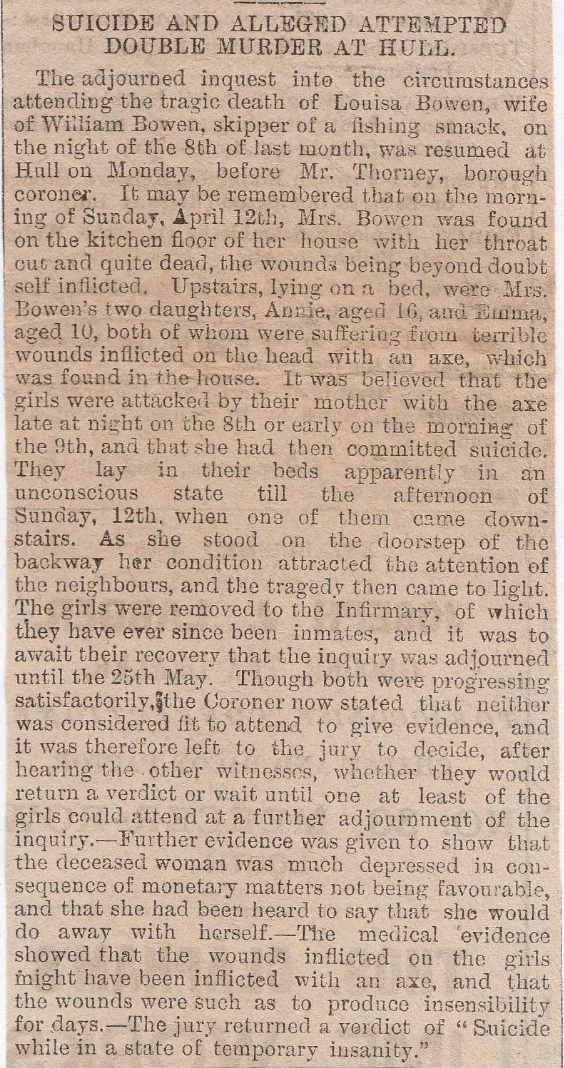
80/ Victoria Timber Pond, Hull, (Three Lads Drown) September 1886
Three lads, named Henry Wildbore aged nine years, Harold Williamson and Harry Salvidge both aged seven, were drowned in the Victoria timber pond, Hull. They climbed on some pieces of timber which formed a frail raft and as soon as they pushed off, the raft disintegrated and the boys sank into ten feet of water. A fourth lad, who stayed on shore, went to get assistance but none of them were visible above the water and after ten minutes or so they were all found, drowned.
81/ Vittoria Hotel Suicide, Hull, December 1877
On the 6th December, a Mr Marmaduke Walter Vavasour, a 43-year-old from Ashby-de-la-Zouch in Leicestershire, checked into the Vittoria Hotel in Hull. He stayed there all the next day and when staff checked on him they found him in a W.C. with a gun in his hand and a bullet hole in his head. He died the next day. The body was identified by the Reverend Vavasour of Snelland in Lincolnshire, as his brother, who said he had suffered from rheumatism for over a decade and was becoming lamer and lamer. He was divorced from his wife and had just had an operation to remove a tumour. All these things had preyed on his mind, plus his son was losing his eyesight and he just decided to end it all. (Where was the Vittoria Hotel?)
82/ Darley’s Court, Hull April 1860
Dr McMillan was in New George Street one morning when he heard a shout of “Stop him!” and he was ushered into Mrs Burnham’s house where he found Elizabeth Ann Parker, sat in a chair bleeding profusely from a wound in her neck. When questioned as to who did it, she replied: “Thomas Kirkwood” and when asked what he does for a living,” A soldier” was the answer. While the doctor tried to stem the flow of blood with his handkerchief torn into strips and giving her tots of brandy to ease the pain, she told him that she had known Kirkwood a month or so but he’d lodged with them for a week. Kirkwood suddenly left one day and his sister told Parker that he was a deserter from the army and she could be held liable to prosecution for harbouring him. He had been gone about a fortnight when he came back yesterday morning, at eight a.m., and stayed till eleven, when he put his arm around her neck and slit her throat. She cried out “Murder!” and died after about an hour or so lingering before she had given important details. Kirkwood was arrested at 12-30 on Spring Bank in front of Minerva Terrace. Kirkwood’s father built the old Adelphi Theatre in Wellington Street (now pulled down) and subsequently the Queen’s Theatre. Parker’s husband died in the Crimea.
83/ River Hull Fatalities, June 1866
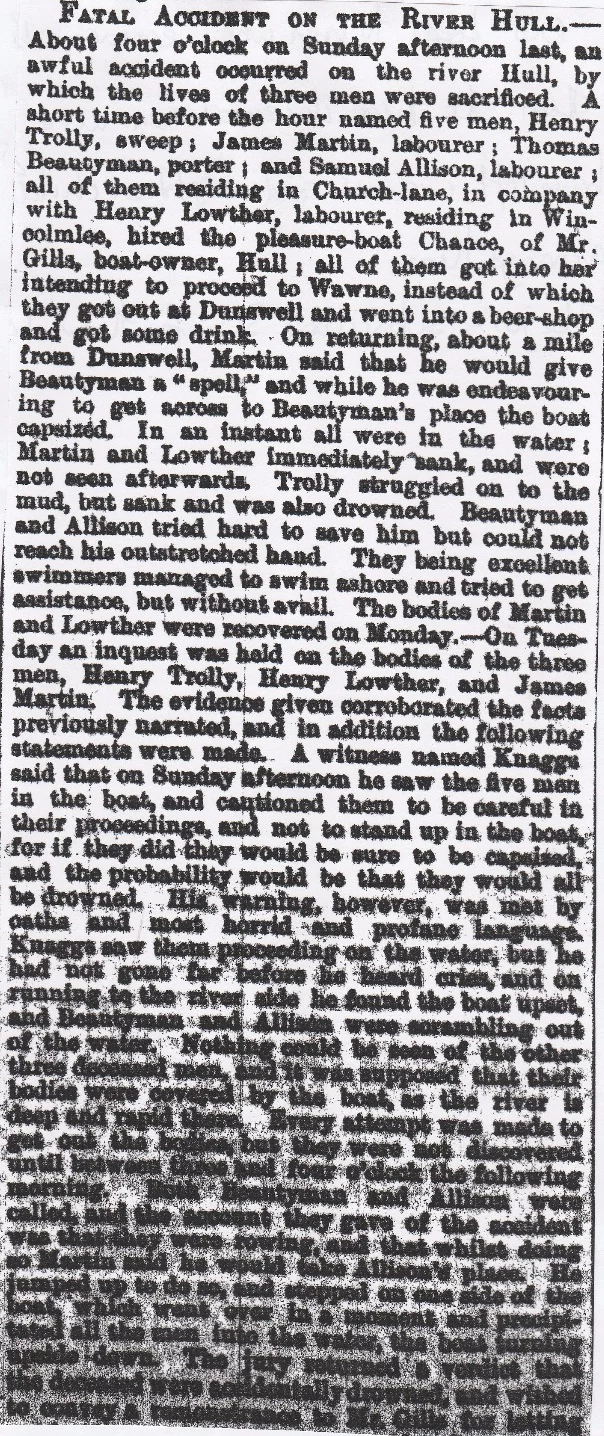
out boats to men who were incapable of managing them.The three deceased men were all married, and have left widows and eighteen fatherless children amongst them.The jury subscribed 30 shillings for the widows and children.
84/ Dock Street Murder, Hull, July 1898
A.G.Stoner, a clerk, was charged with the wilful murder of Emily Hall, who died at the Royal Infirmary last week. Stoner and Hall went to a house in Dock Street and asked for a room. Stoner left the building after an hour or so, leaving Hall behind, and it was the landlady who went up and found Hall in an awful condition. The post-mortem revealed severe internal injuries and the details of this are so gruesome that they cannot be published.
85/ Goole Child Murder, July 1902
Goole police reported a dreadful case of child murder this morning. The wife of a drayman, Anne Morley from Newport Street, Goole, went to bed with her eight-month-old son Walter, at about eleven p.m. At two a.m. she was woken by her father Thomas Ibbetson, who lived with her, entering her bedroom. He had a piece of metal in his hands used for breaking coal, and with this, he threatened to kill his daughter. Ann Morley got free but Ibbetson went to the kiddy lying in bed and struck the child with it. Morley got help and police arrested him, but all too late for the baby who was already lifeless.
86/ Campbell Street, Hull, (Murder/Suicide) October 1902
A woman named Allen was living with a fisherman named Bolton in Campbell Street in Hull. Neighbours got out of bed when they heard screams coming from Allen’s house. They forced the door and found her with knife wounds in her body and she was stone dead. Bolton drew the knife across his throat as they came in and he was later taken to the infirmary, where he lies in a precarious condition. The two of them liked a good drink and were often drunk, but whether this was borne of drink is conjecture at the moment. Bolton is a married man with a large family, and not much hope can be made for his recovery.
87/ Albert Dock, Hull, (Suspicious Death)June 6th, 1885
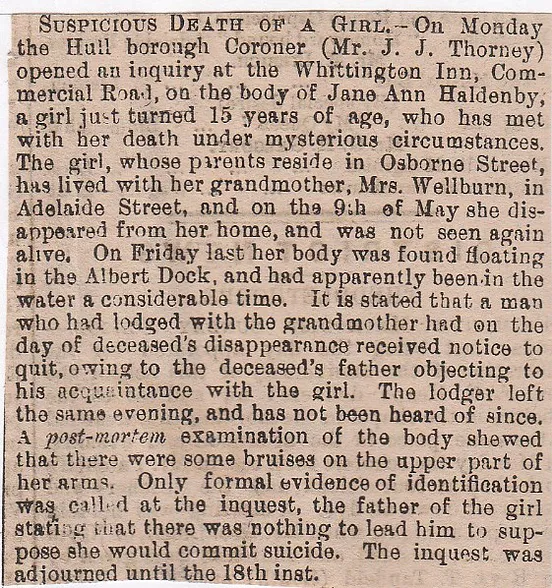
88/ Albert Dock, Hull, July 27th, 1885
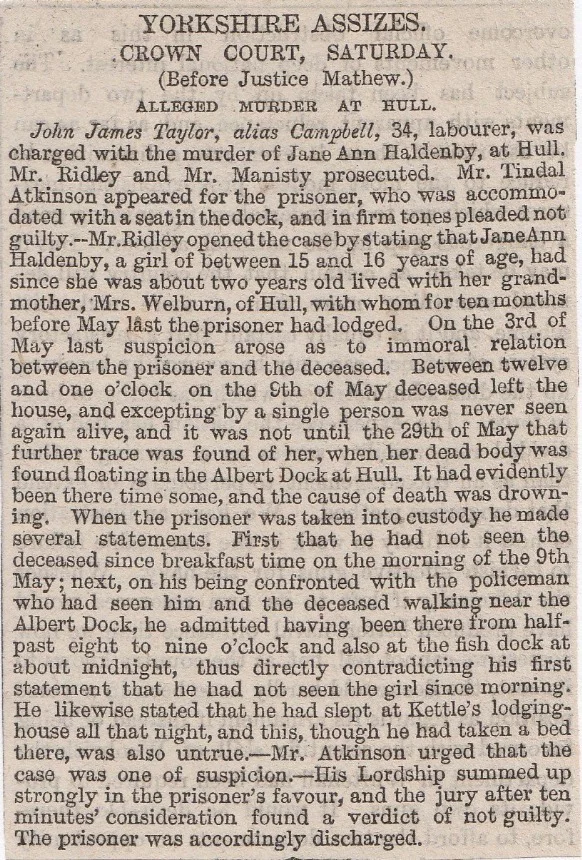
89/ Beverley Child Murders, December 1892
A farmer named George Sowen murdered his two children aged four and six and then committed suicide. Sowen took a farm at Arram near Beverley and on Wednesday night was seen driving towards Hull Bridge. A couple of days later his body was found in the river, with a cow chain around his neck. He also left a suicide note saying that he intended to kill his kids and that his body was to be found in the river. Their bodies have not yet been recovered.
90/ Coniston, (Eaten by Pigs) October 1892
A shocking discovery was made at Coniston, a few miles north east of Hull. Charles Taylor, a gardener who worked for Messrs Dixon and Sons, went to work at daybreak. He must have got to the fold yard then collapsed, because his body was found round about noon. Well, I say body, I mean the remnants of a body, the rest had had been devoured by the pigs. He had been disembowelled and his intestines had been eaten. After the inquest police gave him a decent burial and the whole neighbourhood is in a state of shock.
91/ Hodgson Street Murder, Hull, November 1901
Sarah Hebden, a widow for twenty years, lived on her own in Hodgson Street, Hull. She used to be an insurance agent part-time and one of her clients had been tapping on her door, but getting no answer, so she went to see her sister who lived a couple of doors away. A niece broke into the house through a kitchen window and there she found her Auntie lying face down in a pool of blood, quite dead. The right side of her head had been caved in and nearby was a pair of tongs smeared in blood. The murderer left no clues to his or her identity and the motive is a mystery, as the money and jewellery were left intact.
92/ Hull Revolver Accident, August 1920

93/ Hull Railway Fatality, January 1922

94/ Hull Fish Merchant Suicide, September 1906
A Hull fish and fruit merchant named John Bowen, residing at 101, Walton Street, was found hanging in the kitchen on Tuesday morning. His wife left him about six o’clock to attend the early market and on her return she found him suspended from the bannisters by a piece of cord, tied tightly around his neck. He was cut down immediately but was already dead. Bowen was a well-known man in West Hull and at one time was a bookmaker.
Worcestershire
1/ Kempsey Church Suicide, (Name?) March 1874
An awful suicide took place near the church door of this little Worcestershire village. He shot himself by putting the gun in his mouth and discharging the weapon. His head was shattered and bits of his face were found near the scene.
2/ Kempsey, January 1849 (Lucky Escape)
A sad accident occurred at Kempsey when a young lad fell off a ladder but landed flat on his feet. He then stumbled back and fell into a well. Talk about unlucky!. He was heard moving about and he had managed to grab on to the wall and was eventually rescued. Talk about lucky!
3/ Hadzor Double Murder, near Droitwich, September 1901
A widow named Gordon had moved to Hadzor Wood with her four and a half-year-old son, for the sake of his health. A neighbour was told by Mrs Gordon that her sister was being released from Warneford Asylum and was coming to stay for a few weeks. The sister, Annie McDonnell was picked up at Oxford by Mrs Gordon and went back to Hadzor with her. They were pleased to see each other, but this must have quickly changed at night time, because the following morning the postman named Harris, dropped off the post and saw Miss McDonnell covered in blood and lying on the floor. He ran to get help and when he returned she’d gone from that spot and moved to a well in the garden! When the body was lifted up, she had razor cuts on her arms and legs. Back in the house the bodies of her two victims, Mrs Gordon and her son. Both had their heads smashed in with a hammer, but both were still alive but only just, but neither had the strength to utter a word and died soon afterwards. The evidence suggests that McDonnell was not well enough for a home visit and had gone on a frantic rampage.
4/ Melton Grange Suicide, Malvern, December 1889
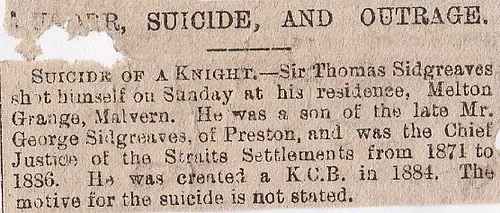
5/ ???, Worcestershire, January 1890
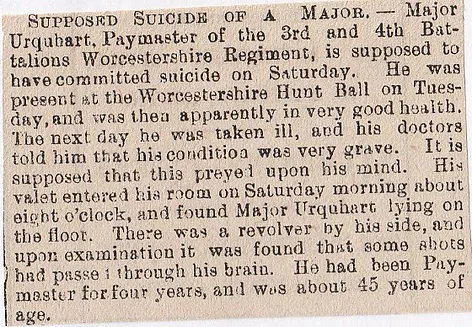
6/ Worcester, August 1854
Worcester was in a state of shock at hearing the news that Dr Grahamsley, the medical superintendent of the Worcester City and County Lunatic Asylum at Powick, had killed himself by taking prussic acid. He was in fine fettle last week when he was in Worcester itself, and there is no reason why he should commit the rash act. He is Scottish by birth and got the position at the Asylum when it was finished two or three years ago. (Did he kill himself in the Asylum?)
7/ Wolverley near Kidderminster, June 1888 (Child Murder)

8/ Shatterford Murder, June 1888
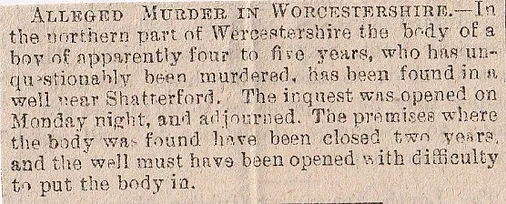
9/ Upper Arley, September 1873 (Human Remains Found)
Human remains have been discovered in the Severn at Upper Arley in Worcestershire. They are male and of an adult and are really disfigured. They have been in the water for three or four months and the corpse has been handed to the surgeon for a proper examination. (Who was it?)
10/ Worcester Cathedral Fatality, January 1857
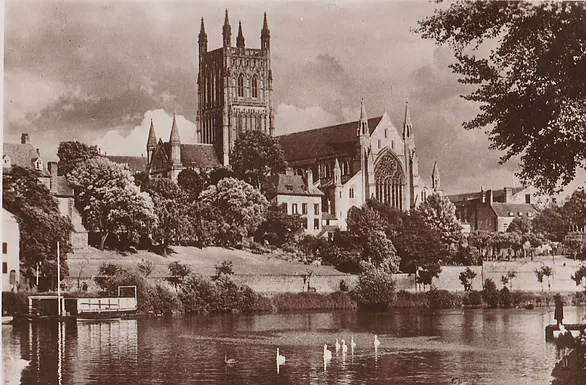
The cathedral at Worcester was under repair and work was being done to restore the sacred edifice. Three men were repairing the south transept, when a fatal accident occurred, the second fatal accident within a few weeks. The names of the men were Charles Ogbourne, Thomas Southern and William Jones, and they were up scaffolding fifty feet high, and fixing poles and planks to make it higher still. Everything was going OK until one of the poles broke and they were precipitated to the stone floor below them. The works foreman, Charles Butt, found the three men lying there and he got help and they were taken to Worcester Infirmary. Charles Ogbourne died after a couple of hours, Jones had a concussion, and a broken leg and shoulder and Southern received serious injuries, but they are not life-threatening.
11/ Worcester/Severn, January 1903 (Mysterious Death)
An open verdict was returned by a coroner’s jury at Worcester on Friday in the case of an unknown man who was found drowned in the Severn with his hands and feet tied together. The tied hands had been caught in a bush growing at the edge of the water.
12/ Bromsgrove November 1897 (Murder/Suicide?)
A man’s body, aged in his mid to late forties, was found by a labourer on the Birmingham Road in Bromsgrove, opposite the gates of All Saints Vicarage. A razor was laid next to the body and the head was nearly severed from the neck.
13/ Worcester, November 1902
George Jakeman, employed by Mr Walter Grundy, a butcher of Worcester, went to attend to the cows and some time afterwards he was found dead in the farm buildings, having received a kick from a cow which struck him over the heart and apparently caused instantaneous death.
14/ Great Malvern Suicide, March 1890

15/ Worcester Teenage Suicide, May 1891
This is a determined effort to commit suicide by a thirteen-year-old girl in Worcestershire. As the express train trundled into Worcester and a young naked girl ran in front of the engine and she was squashed on the line. Police sent a P.C. Williams to clear up the matter and when he got there he was horrified to find that the corpse was that of his niece, Kate Hughes, who lived at Kings Winsford. Her clothes were found under an archway under the main line and they were soaking wet, which suggests that she tried to drown herself first. (She did try at Loughern Brook).
16/ St Cloud Mansion Fire, Powick, November 1902
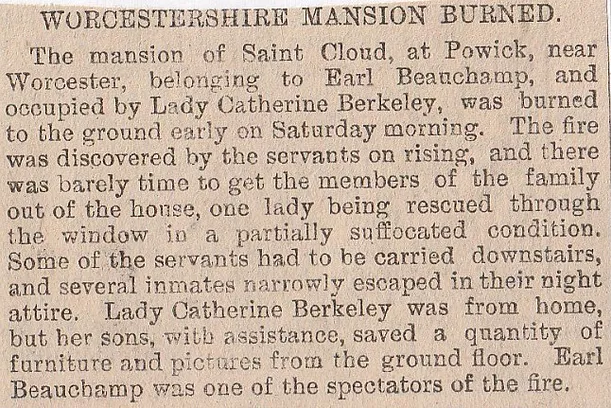
17/ Spetchley/Ravenshill Railway Fatality, June 1847
The drunken antics of three Navvies ended up with fatal results, in between Ravenshill and Spetchley on the Birmingham and Gloucester Railway. They had all been drinking heavily and they stopped next to the railway tracks for a sleep. (This seems to ask for trouble!) During their sleep, they fidgeted about and ended up on the line. A train came through and ran over the head of one, and causing serious injuries to the other two. (Who were they?/Did anyone else die?)
18/ St John’s, Worcester September 1864 (Died of Shock)
A tradesman’s daughter from St John’s, Worcester, saw the dead bodies of a man and woman being taken out of the Severn after they both committed suicide together and she consequently died of the shock of it all. She was walking over the bridge at the time they were fished out and being a delicate creature in the first place, she keeled over and died at the scene. (What bridge?/What suicides?)
19/ Worcester Assizes, May 1885 (Murder Charges)
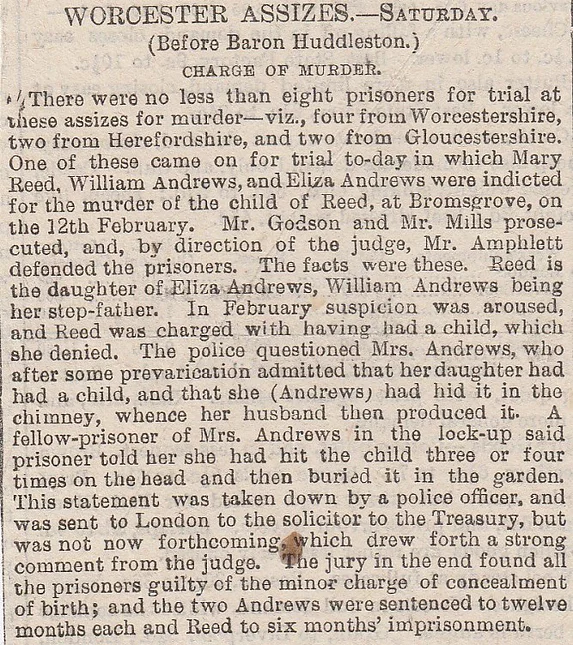
20/ Bromsgrove, August 1885 (Fatal Gun Accident)
On Friday night two boys named Mitchell and Hartle were playing in the house of the latter at Bromsgrove when the report of a gun was heard and a labourer entering the house found Mitchell shot dead through the temple. A gun belonging to Hartle’s older brother, which had recently been discharged, was lying near. Hartle ran away but was arrested soon afterwards.
21/ ——
22/ Norton, (Soldier’s Suicide), March 1895

23/ River Severn Drownings, near Worcester, August 1892
George Reynolds of Buscott near Gloucester and John Stokes of Kidderminster, who were both employed on the Severn improvement works, went to bathe in the river a few miles below Worcester. Suddenly Reynolds was seized with cramp and sank. Stokes heard him cry out before he disappeared and went to his assistance, but he also sank and both young men were drowned.
24/ Arley Drownings, July 1885

25/ Foregate Street Railway Station, Worcester May 1888 (Infant Remains)
A parcel from Reading had been at the booking office for six weeks with no-one claiming it. A foul stench was emanating from the package so they opened it and found the decomposing remains of an infant. It had been wrapped in linen and a paper from March the 25th was underneath. Inside was the inscription:-“April 16th. By goods train to Reading. Mr Green, Foregate Street Station, Worcester. To be called for.” Police are investigating the matter.
26/ Worcester Executions, March 1890
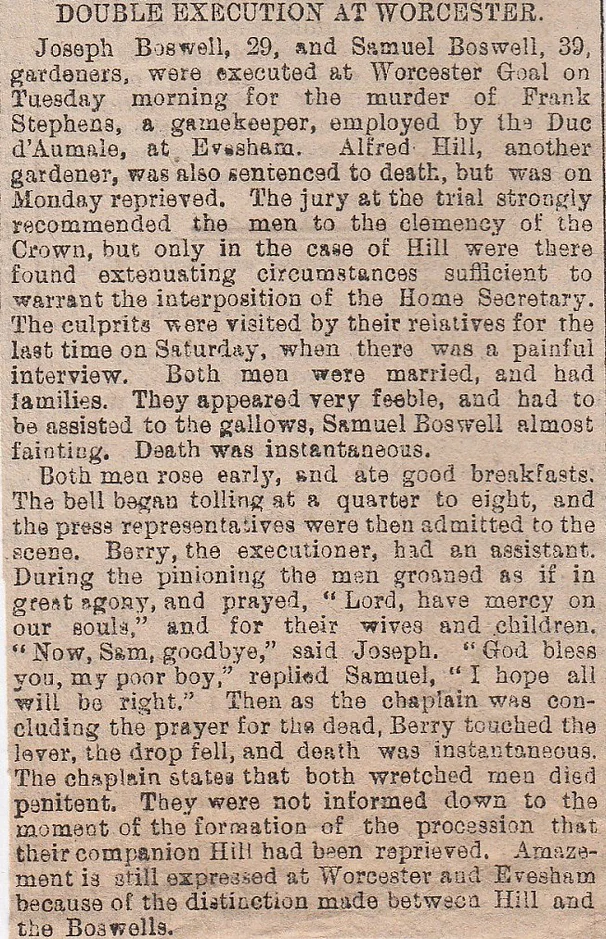
27/ Ombersley Suicide, (Wife Takes Her Time), January 1863
A middle-aged beerhouse keeper named Thomas May was discovered hanging in a hay-loft adjoining the house. Owning a beer-house was not a good move for May, as it fuelled his alcoholism and had been drunk for a fortnight all except three days. May told his wife one morning that he was off to Kidderminster, swigged a couple of pints of cider, then left. His wife was in the garden when she heard some noise from hay-loft, so she went to take a look. Her husband was suspended from a beam. Instead of cutting him down she calmly put on her hat and shawl and walked two miles to get her 15-year-old son to help her. She then walked home and waited for the lad to arrive, after he’d finished his work. At midday, they both entered the hay-loft and the son ran off to get the local constable. On her way to get her son, she met several people but never mentioned her husband, saying that it would cause a furore in the village. Apparently, he was a violent man and had tried to kill himself a couple of times before and the marriage was not a happy one.
28/ Bournheath, September 1885
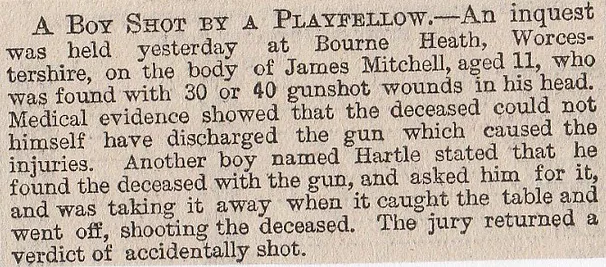
29/ Worcester Suicide, June 1891
William Jenkins a labourer, had a barney with his missus one morning and stormed out in a mood. Several hours passed by and he hadn’t been seen and the wife grew more and worried. She had a look around for him and nearly fainted when she went to the top of the house and found him hanging in a doorway, stark naked. He got undressed, tied the rope above the doorway of the garret stairs and made a noose with other end and swung himself off.
30/ Pershore, March 1898 (Coroner’s Suicide)
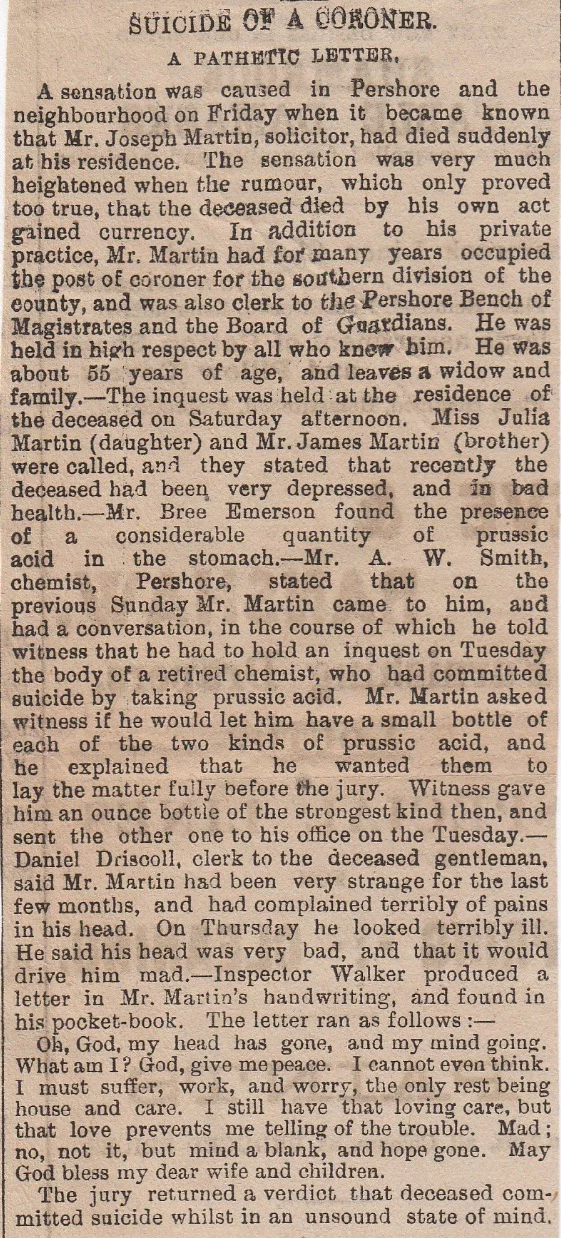
31/ Worcester Child Murder/Suicide, April 1895
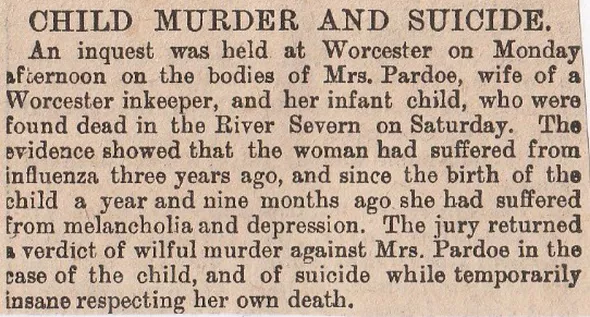
32/ Church Tavern Suicide, Mealcheapen Street, Worcester, January 1859
A woman of about forty years of age walked into the Church Tavern in Mealcheapen Street in Worcester and got a room for the night. A female attendant waited on her and she was not seen until the next morning when the usual story occurred. They knock on the door, no answer, so they force open the door and find a dead body in the room. This unknown woman was hanging from a bedpost and had tied a scarf around her neck, causing her death from asphyxia. Mary Phillips said the deceased had mentioned to her of losing her husband and the woman had left some letters that could throw some light on the matter. They stated that she had lost her husband by death and she was in difficulty financially and she addressed the person as “Eliza” in the letters. One of them read:
” I was walking around my little room all last night, and this man kept by me. I said what shall I do put a knife in the hair if your harm it will soon be over. I said no William, my husband, I come to share your fate, whatever it may be. O, my God, my God have mercy. ” Another piece of scrap paper had the following written on it:-
“Mrs Pardos- do not advertise me for I have no friend in the world, but the mad House, therefore I must trust you as a stranger and the Lord will reward you for taking Charity, I have no power, so you can sell my close and my chain there. Mr Hemmings, 20 High St, Worcester offers me fifty shillings for it. Worth more than that. But I have not the bill with me, C.F.Yarnold”
She had twenty-six shillings in her pocket, a few nick-nacks and a gold chain. She may have come from Liverpool, but other than this information nothing is known about her. Most of the letter contents are somewhat gibberish but it was what she wrote!
33/ Alvechurch near Redditch, March 3rd, 1885

34/ Alvechurch Murder, near Redditch, March 10th 1885
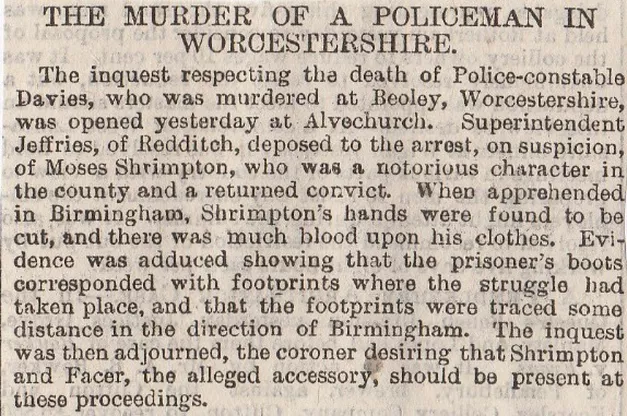
35/ Alvechurch near Redditch May 8th, 1885
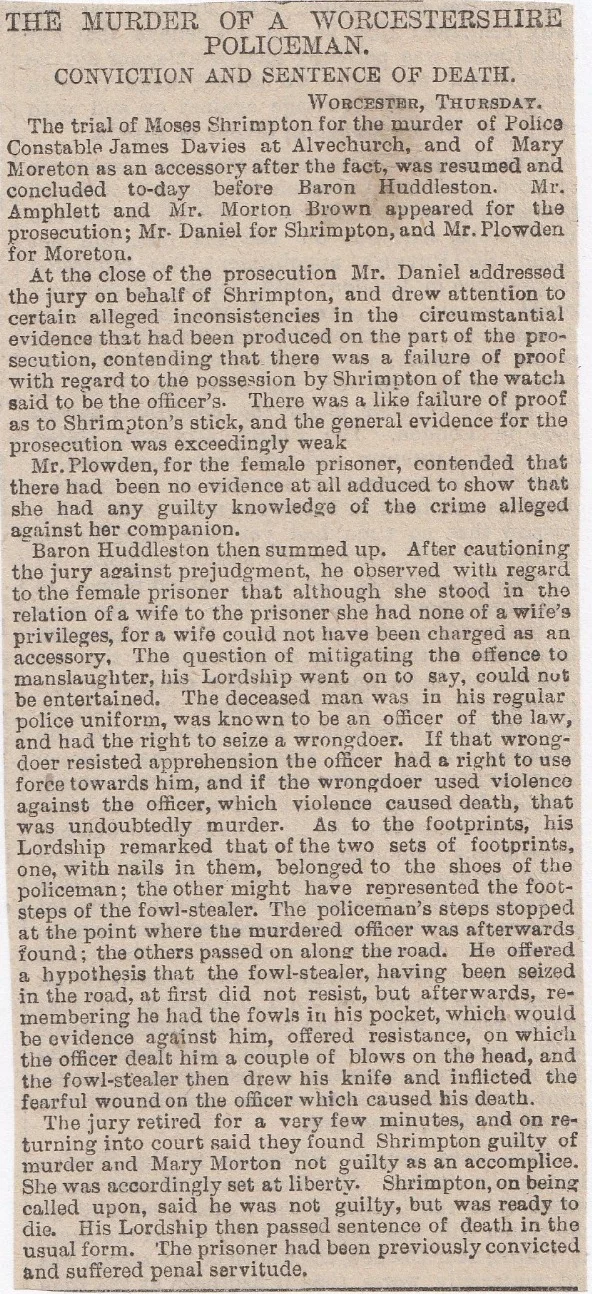
36/ Alvechurch Murder, near Redditch, May 26th, 1885

James Berry performed the hanging and as the fatal bolt was drawn to allow the drop, the black flag announced to outsiders that the hanging was to take place. This hanging went slightly wrong, as the long drop nearly severed Shrimpton’s head from his body and a huge gash appeared in the throat. As a consequence of this b***s up, there was an inquest into what went wrong.
37/ Worcester Murder, June 1899
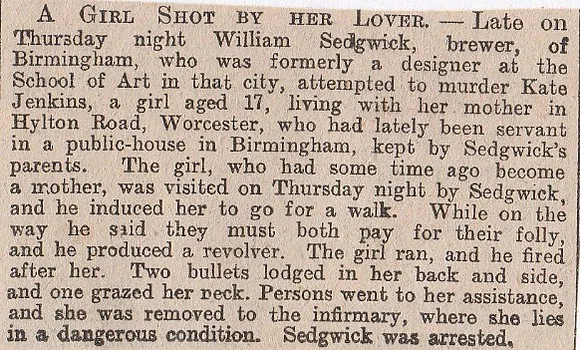
38/ Worcester Railway Suicide, July 1870
39/ Bewdley Drowning, December 5th 1870
The body of a middle-aged man has been found in the Severn, under circumstances of some suspicion. Some children on the riverside near Bewdley noticed the body floating along, and they informed some men of it, and the body was got out. It had all the appearance of a gentleman’s servant. There was no coat on the man and he had several scalp wounds. The body was removed to the adjacent inn, pending an inquiry before the coroner.
December 10th, 1870 (Inquest/ Superstition- wens are boils or growths)
40/ Horrific Death of a Young Boy, Malvern. May 1866
41/ Death in Spetchley Park, near Worcester. June 1866
42/ Fatal Gun Accident at Tenbury, October 1866.
43/ Frozen to Death near Pershore, January 1867.
44/ Kidderminster Murderer Identified in Lincoln Prison, January 1904. (Coincidental Love of Gardening?)
45/ Girlfriend Drowns in River Severn, Bewdley. August 1904
46/ Execution at Worcester (William Yarnold who stabbed his wife, Annie)
Wiltshire
1/ Devizes Murder, January 1840
A man named Freeme committed an atrocious murder near Devizes. He was employed by Mr.Bruges as a gardener and his victim was a young man by the name of Heritage. He was stabbed and died almost immediately. The murderer is in custody.
2/ Spye Park Lake Body, February 1904 (Spye Park is owned by the Enthoven family, who own the Nandos Chicken franchise. Bought in 2005 for £8million)
Thursday, February 25th, 1904. (The Inquest)
3/ Swindon Attempted Murder, June 1953 (Who was the lad?)

4/ Swindon, (Human Remains) October 1901
Some workmen employed by John Lay, a builder of Swindon, were digging in the back gardens of some old properties in Newport Street when they found an old bedstead, but beneath that were the remains of three or four adults. Swindon records showed that nowhere in the area was used for burials, so who or what they are doing there is a complete mystery. One of the skulls had a hole in the temple the size of a six-pence. Normal protocol would be to find out if they murdered but strangely they were put back where they were discovered. (Are they there now? Who were they?)
5/ Holt near Trowbridge, April 1908 (Murder/Suicide)
An inquest was held on the bodies of Mrs Meaden and Charles Kinall, a Royal Artillery pensioner from Portsmouth, who shot Meaden then killed himself. While her husband was away in India, doing his bit for Queen and Country, she had been shacked up with Kinall, but she recently left him and got back with her husband and two children. Mrs Meaden’s nine-year-old son told the coroner what happened and he said that his “mother was putting coal on the fire when the man pulled out a gun and shot her in the head. She screamed and he fired three more times. Then he knelt down next to her and put the gun in his mouth and pulled the trigger, falling across mother”.
6/ Fisherton Delamere, August 1888 (Double Suicide)
Albert Sparey from Warminster and Elizabeth Ann Yates from Wylye committed suicide together at Fisherton Delamere near Wylye. They were discovered in each other’s arms in the stream next to the mill, tied together with a pair of handkerchiefs and Yates’s belt. It was very methodical in its execution, as on the bank there were their hat’s and letters addressed their parents, saying that they both loved each other and wanted to die together as nothing could part them. Albert asked his mother to take care of his book- “Faithful and True”- and a note from Yates stated that they did it because of her sister and his brother. No light was shed on the matter afterwards and the two were questioned as to what she meant but they knew nothing of what she wrote. The verdict was one of “Felo de Se”.
7/ Limpley Stoke Fatalities, January 1885

8/ Amesbury, September 1905 (Father Kills His Six Children)
9/ Fisherton Asylum Suicide, May 1884
An inmate of the Fisherton House Asylum by the name of James Jukes, committed suicide in a most determined manner by throwing himself under a train at the Great Western railway, mid-way between Salisbury and Wilton. He had been at the asylum for four months, when one day he scaled two walls each about ten feet high, then got to the tracks which run parallel to the grounds and killed himself.
10/ Romsey near Salisbury, May 1884
To kill yourself a day after walking down the aisle is incomprehensible, but Fanny Ondman decided it was the best course of action. Her husband went to work one day, then on his return he tried the door, but it was locked. He saw the key was inside so he climbed through a window and kept calling his wife’s name all the while, but no answer was forthcoming, nor was she in any of the rooms. Then he took a peek in the pantry, and to his horror, she was hanging from a nail, with some cord wrapped around her neck. He cut her down but she was dead, but the body wasn’t cold, suggesting she hadn’t hung herself that long ago. The husband said she never talked about suicide, but her granny had killed herself, so it could be a family trait.
11/ Semley, Wiltshire, July 1895

12/ Bemerton Suicide, August 1836
Mr Targett, an elderly gentleman from Bemerton (Now part of Salisbury), started up a fire in his back garden, loaded a gun barrel, put the muzzle to his temple and the other end in the fire, then an explosion occurred and the barrel burst. A part of the contents passed through his skull and he was killed instantly. His suicide note was found under a brick saying that he was tired of life and wanted to die as Castlereagh had done. (Castlereagh was a British Foreign Secretary from 1812-1822, and due to his unpopularity and death of his father etc., he killed himself by cutting his throat with a pen-knife). He used to hand out half a crown to each poor family in the parish, so clearly had no money worries, but he leaves a widow behind.
13/ Bradford-on-Avon, (Boating Deaths) September 1856
A terrible accident took place at Bradford-on-Avon, last Saturday. A Bradford ironmonger, named Tanner, had made an engine that could propel a boat and had been using his steamer as a pleasure boat on the Avon. He decided to take the wife and daughter out for for a boat trip to Staverton, just down the river. They made it OK, but on the return journey, near the Wood, about three-quarters of a mile from home, Mrs Tanner fell overboard. Mr Tanner tried to grab hold of her, and after a lot of toing and froing, the boat capsized throwing them all into the water. A young shepherd boy saw the whole incident but was too young to be of any assistance, and all he could do was watch as all three drowned. They screamed for help before they went under, and a shooting party nearby rushed to help them. Again, they were too late to provide any assistance. The bodies were fished out and brought back to their home. Mr Tanner was only about thirty years of age and had another little one, about four months old. What was worse was that his friends had told him to take swimming lessons before he went out on his pleasure trips.
14/ Salisbury Murder, September 1886
A domestic servant, Margaret Furnell, only nineteen-years-old, was shot in broad daylight on a public road by a twenty-year-old painter named House, who had travelled from Warminster to commit the deed. The two used to be an item when she lived in Warminster, but she dumped him and then he promised revenge and to do her injury. There was no other fella in her life, but House thought otherwise. Furnell left her master’s house at 6-10, to go to church and as soon as she got around the corner House stood there and fired a revolver at her. A butcher, Mr Lywood, heard the gunshot, and ran out to help, and found Furnell lying on the pavement. Lywood ran towards House, but he just stared at the girl and fired the gun again at her. He tried to make a dash for it but Lywood grabbed hold of him and the gun wrenched from his grasp. While Lywood had hold of him, several bystanders asked “Why did you do it?”, but he told them that he wouldn’t answer any questions. One said “you ought to be shot too” and he replied, “I should have done it, only you were too quick on me”. One bullet was lodged in her side, the other in her arm, so his idea of killing her also faded into oblivion and she is expected to recover. (Did she?)
15/ Trowbridge/London, (Workhouse) March 1885

16/ New Swindon Parish Churchyard Suicide, January 1881
Frederick Day who was around fifty-years-old committed suicide in the churchyard at New Swindon. He used to live in Swindon where he kept a beer-house, but his missus died and he sold up the business and moved out of town. He wrote to a friend saying that he was coming to Swindon for Christmas but no-one saw him there. It was one Saturday morning when the gravedigger was due to begin work when he spotted a body lying across a grave. On closer inspection, he had half his head blown off and a pistol in his hand. Day had committed self-destruction on his wife’s grave. A letter found on the body leaves no doubt that he planned all this and his identity was confirmed:-
“New Swindon- I am tired of life and seek rest. My poor old girl died here last April. I cannot live without her and I thought of being a little nearer to her by doing this. I am quite aware that my head is not quite so clear as it might be; at the same time, I should like to be buried in the same grave as she is.”- He then went on to say that his life was insured and gave the name of the man holding the policy and that he’d pay the funeral bill- ” which may not be much. I may as well be buried as you find me. I don’t want a lot of women to mess me about. The sexton can identify me. Relations, I have none that I acknowledge. Friends are scarce, very scarce. Now don’t make a great bother about this little affair. I shan’t-FRED DAY “.
17/ Bradford-on-Avon/Westwood, November 23rd, 1885

18/ Bradford-on-Avon/Westwood (Double Murder) November 25th, 1885

19/ Ramsbury, October 1897
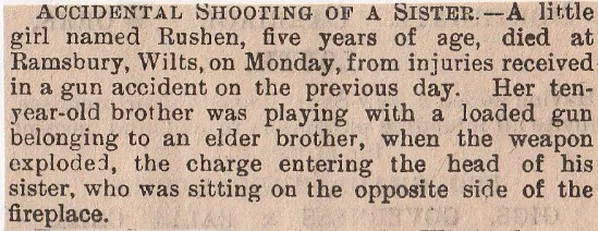
20/ Colerne Suicide, December 1859
Esther Smart was a nineteen-year-old, living and Colerne and from a poor background. It was this poverty that she was forced to steal, plus she was about to be locked up for the night, so she tried to strangle herself. The police officer, in an act of huge kindness for her welfare, took her home with him and stayed up all night keeping an eye on her. During this period she attempted to strangle herself again and failed again. The next morning he gave her some breakfast and before going to the magistrates at Chippenham, she asked if she could go home (which was opposite the officer’s house) to get changed. He took her across the road and he got distracted, he then heard a noise, turned around and saw the girl had slit her throat with a knife she pinched from the breakfast table. The girl lingered for a few hours but eventually died from her injury. The verdict was “Felo de Se”, so she had to be buried between the hours of nine p.m. and midnight.
21/ Warminster Town Hall, April 1885

22/ Salisbury Suicide, June 1883
The inquest at East Harnham on the body of Cerena Florence Hale aged twenty, a pupil at the Salisbury Diocesan Training College. Her body was seen at ten a.m., floating in the river by Mr Russell, a visitor from Sussex who was fishing at the time. The body was taken out, but she was dead. Hale was last seen going to the garden near the river to get some woodruff. Her parents lived at 20 Oakley Crescent, Chelsea and the following note was found in her desk.
“Dear Ma- I am deeply grieved to tell you that I have given way to temptation. You will hear all from Miss Rodwell, our lady superintendent. She has been kind to me through all; oh, so very kind. At the time I write this I feel out of my mind. What to do I don’t know. I feel sure I shall be dismissed from college, and rather than bring disgrace upon you and my vicar. I will get rid of myself. I feel that I have done more than I can expect forgiveness for.”
23/ Ramsbury Poisoning, June 1885
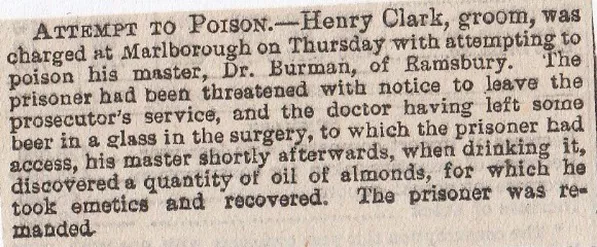
24/ Edward Palmer Execution (Swindon Murderer) November 1903.
25/ Viscount Trafalgar’s Fatal Fall, Braydon Hall, Minety. May 1905
Westminster
1/ Drury Lane Theatre Death, Covent Garden, July 1883
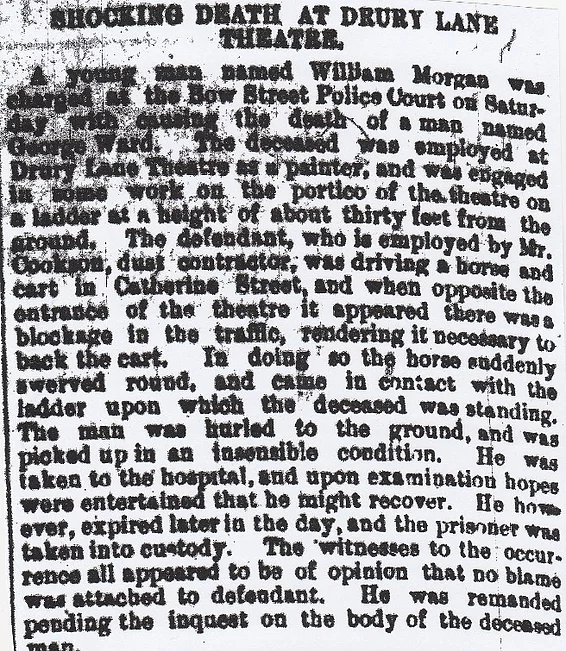
2/ Scotland Yard, (Superintendent Kills Himself) March 1896

Superintendent of New Scotland Yard has committed suicide at his residence at Stockwell, by shooting himself with a revolver. Mr Cutbush was also resigning his post as Superintendent. At present no reason is assigned for the act.
3/ Hotel Cecil Suicide, Strand, September 1915
Private John Halt was found in a bedroom at the Hotel Cecil with a gunshot wound to the temple, suspected attempted suicide. He was a member of the Army Veterinary Corps and came from Oxfordshire. (Did he live?)
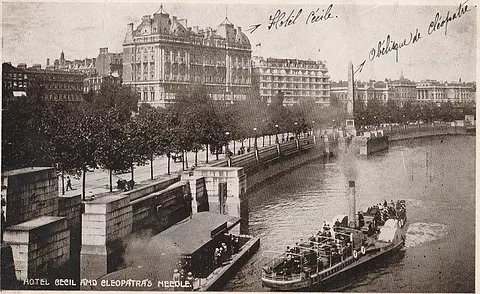
4/ Hotel Cecil Poisoning, November 1896

5/ Foreign Office Suicide, October 1894
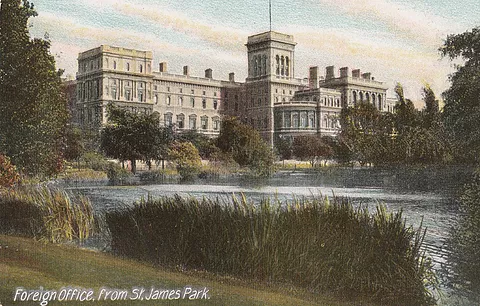
Mr Patrick Henderson was the British Consul in Cadiz in Spain. A friend at the inquest said he was fifty-two-years-old, not in good health, who had heard him threaten suicide quite a few times. Henderson was prone to hysterical outbursts and one of these occurred one day when a Mr Foley came to see him in regard to a letter he had written to him on behalf of Lord Kimberley about an appointment which Henderson wanted to obtain..Foley said he couldn’t get the said appointment, to which Henderson replied: “There’s but one thing for me to do”. He then began to laugh hysterically then started sobbing, Foley turned away for a moment, then he heard a gun-shot. He saw Henderson on the floor with a hole in his head. Apparently, he had sort of planned his suicide because he left a note in his pocket addressed to the coroner- it partly read:
“God help my poor children; they are orphan’s, friendless in London. I enclose a sovereign. It will pay their cab fare to Barnardo’s or an orphan asylum. God help my poor children. PATRICK HENDERSON”
Death was obviously due to a self-inflicted gunshot wound, but the note about being poor and orphans was a load of crap. He had money and property, as you would expect working in the Foreign Office. (Does his ghost roam the halls of the F.O.?)
6/ No.11, Regent Gardens Wife Murder, October 1888
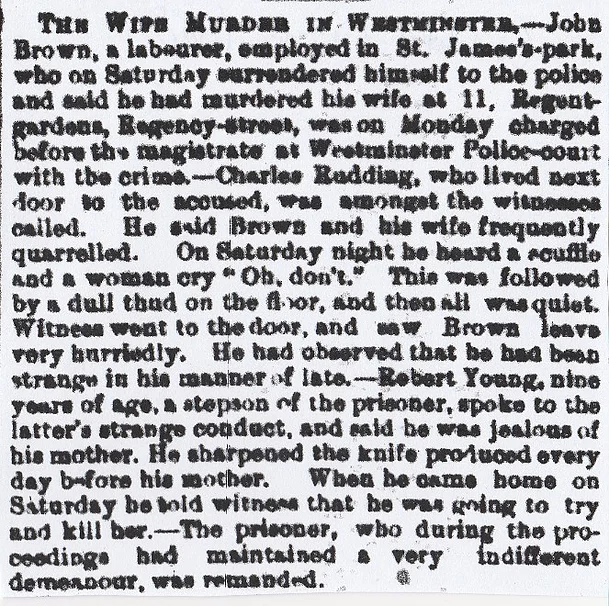
7/ Great Western Hotel Suicide, Paddington, January 1903 (Is it now the Hilton at Paddington?)

8/ Marylebone Shooting, August 1890
At the Old Bailey on Monday, Francois Manteau aged fifty-one was sentenced to death for shooting Francis De Grave in Marylebone. Prisoner and deceased were Belgians, and the prisoner was jealous because a woman named Dupont, who came from Belgium left him to live with the deceased.
9/ Buckingham Palace Suicide, November 1837

Henry Fricker, who for thirty years was a footman in the royal household, decided suicide was the best way out and hung himself in one of the harness rooms. He tried to kill himself first by hanging himself with his handkerchief, but that failed when he tore it due to his weight. Fricker was one of the oldest servants working there. He was the driver for George IV (1820-1830) and also to William IV (1830-1837) and Queen Victoria was just pronounced Queen in 1837.
Later on in Victoria’s reign, another of her footmen would kill himself at Caxton Street in Westminster at the Town Hall Chambers. Charles Pammel Ambrose aged thirty-one, whose father also works in the Royal household at Windsor stables, said his son had never had suicidal tendencies. He was told to go and wait on a table but didn’t. His superior gave him a good telling off and said he was being reported. This is surely the only thing that could have triggered his suicide attempt.
10/ Houses of Parliament Death, November 1854
The Victoria Tower is the big one on the left-hand side and the Elizabeth Tower is the one with “Big Ben” in it. A twenty-eight-year-old carpenter named George Wright was fitting a piece of wood into one of the windows of the Victoria Tower when he lost his footing and fell over eighty feet and fell on an iron-beam. He was instantly killed and left a widow but no children. The Tower itself is over 320 feet high, so he was only about a quarter of the way up it and I presume, it was inside.
11/ House of Commons Fatality, August 1853
In the lobby of the House of Commons, was where Henry Bellingham shot the British Prime Minister, Spencer Perceval in 1812. This was the last time that Britain had a Prime Minister assassinated, so there has been a murder in there! This little story is about an old lady involved in a singular accident. The lady, named Sadler, from Eubury Street in Pimlico went on a tour of the Houses of Parliament. She was going up the stairs leading to St Stephen’s Hall when a door swung back and smacked her full in the face and she fell to the floor. The old dear was rushed to Westminster Hospital but she died shortly after.
12/ House of Lords Fatality, March 1834
This is regarding the sad death of the housekeeper of the House of Lords, Mrs Jane Oakleyaged seventy-eight, who lived on the premises and provided the MP’s with food and drink and kept the place tidy. Early one morning her body was discovered at the rear of the House of Lords, lying dead on the floor with a fractured skull, with fractures in both legs and a simple fracture of her thigh as well. Evidence suggests that she fell from a gallery (Approx.50 feet) while trying to water some flowers. (Does she haunt the House of Lords?)
13/ War Office Suicide, November 1860 (The one on the left)

On the premises of the War Office in Pall Mall, a messenger by the name of George Stiller killed himself by hanging. It was in a part of the building known as the “lower back room” and he was found hanging from one of the book-shelves. They tried to revive him, but sadly he was already dead. He had managed to hang himself with a thin piece of string, which was tied to the book-shelf and passed through an opening that was used to brush the dust through. (This postcard was early 1900’s and the War Office moved to Cumberland House, Pall Mall, for the last half of the 19th Century)
14/ Charing Cross Station Suicide, August 1869
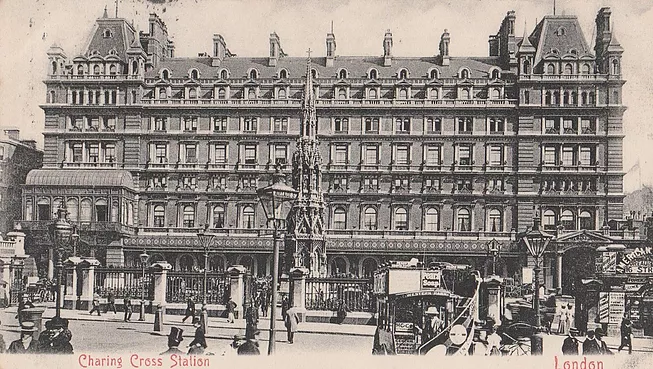
Looking at the above postcard from 1905, the suicide in 1869 jumped from one of those windows. One Saturday afternoon a man threw himself from the balcony in front of the smoking saloon which overlooks the interior of the station and onto the platform below. He expired on the spot, with his head being smashed to atoms. A letter found on his person suggests that his name could be Captain Frederick Bowker.
15/ Charing Cross Station, February 1882 (Dead child found)
A deceased baby boy was discovered in the waiting-room at Charing Cross Station. A plumber named James Pontie was checking the plumbing in the toilets at the waiting-room when he found the child, stark naked and forcibly wedged into the place he was found. The little chap had been there all night. The surgeon revealed that three of his ribs were broken and had a laceration on his side. Apparently, he believes that he never breathed at all as his lungs weren’t expanded.
16/ Charing Cross Station Underground Fatality, May 1899

17/ Charing Cross Station Suicide, May 1867
A water closet door had been closed for ages and when an attendant tapped on the door to get a response and received no reply, they broke it down. The found a fully-dressed gentleman sat down, but not moving and with no blood anywhere. A stomach pump was used on him and lots of laudanum was drained out, but it was too little too late. In his pockets were four bottles marked “Laudanum” and a few betting slips on him as well. The suicide had written to his parents before he did this, stating his intention to kill himself and they later turned up at the hospital to identify the body.
18/ Trafalgar Square/Nelsons Column, September 1852
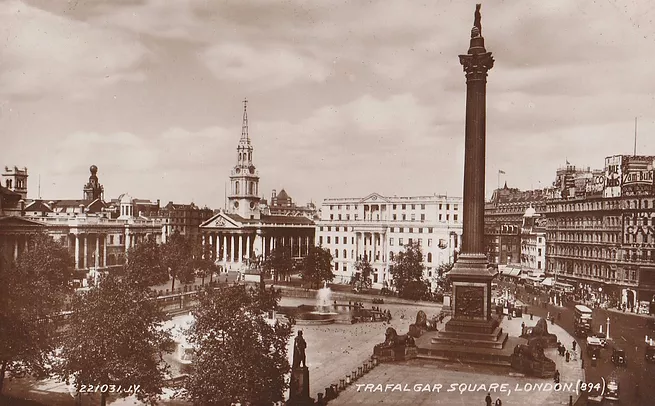
As you can see in the above postcard, at the base of Nelsons Column just above the steps are giant bronze tableau’s, and it was a workman putting one of these into place that ended up with him dying horribly. The man’s name was Daniel Allmond and he was with a group fixing the bronze into place, the one on the west side facing Cockspur Street (if you want to see it) and the bolts were being fastened in with molten lead, with Allmond manoeuvring it into place. It was about twelve pounds in weight and it was after ten pounds had gone when a noise was heard and the molten lead fell on him, straight into his face and mouth. He was horrifically burned and rushed off to hospital. It was thought that some water in the cavity, met with the boiling lead, causing the instant steam power to cause a mini-explosion. Allmond’s sight was partially gone and his face will be the scarred for life.
19/ Trafalgar Square Riot, December 1887
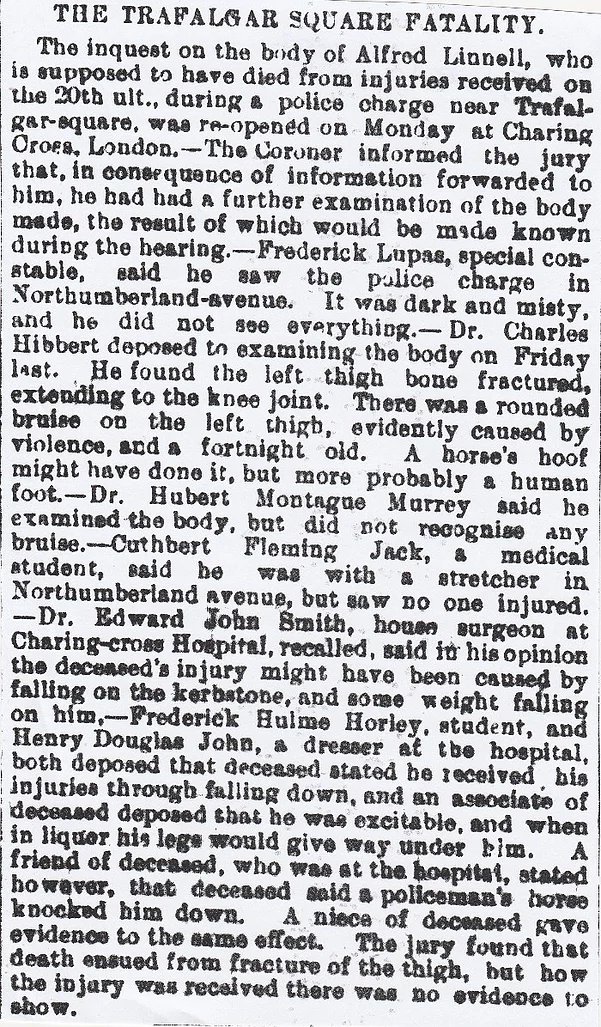
20/ Horse Guards Suicide, May 1852
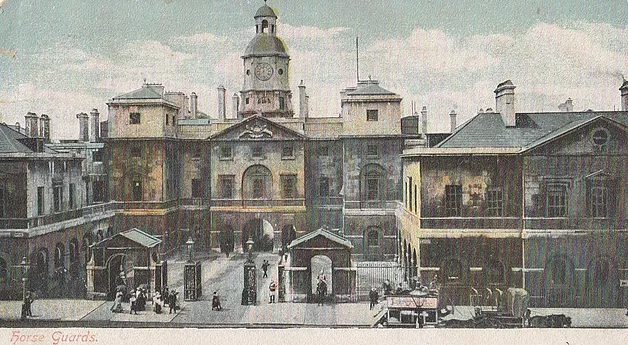
A suicide was carried out by a Grenadier at Horse Guards by slitting his own throat. He had been on guard duty all night and was relieved from duty in the morning. He went to have a nap in the “Black Hole”, which was normal practice for the soldiers when there were no prisoners in confinement. He was not seen for ages and when someone went to get him, they found his bed drenched in blood and him with his throat cut from ear to ear. Medical assistance was procured but he’d been dead for quite a while. (Anyone know his name?)
21/ Paddington Green Police Station Suicide, December 1888
On Christmas Day a woman entered the Paddington Green Police Station and in an excited manner told the inspector on duty that she had taken poison. The divisional surgeon was at once sent for and on his arrival gave the woman an emetic. She, however, died within a few minutes. She has since been identified as Elizabeth Foulkes, a housekeeper to a cab proprietor.
22/ Carlton House Terrace Lift Death, (near Pall Mall/Trafalgar Square) May 1902
The inquest began on the death of the housemaid who was fatally injured by the luggage lift at 18, Carlton House Terrace. She had placed the breakfast articles in the lift, then started it to go up another floor, when her chin got wedged and drew her into the lift-shaft and she was hung by the neck. The poor woman literally had the life throttled out of her.
23/ Marylebone/Westminster, June 1843 (Three Wives Married to One Husband Commit Suicide)
The inquest was held at the Seymour Arms in Bryanston Square, so I presume that it was nearby, that all this happened. Forty-four-year-old Mary Salmon had left her husband and had lived a crappy existence, so she took some laudanum. Not an unusual story you might say, but Salmon was the fourth wife of the husband and another two of them had also committed suicide while with him.
24/ Stanhope Street, Euston Road, February 1899
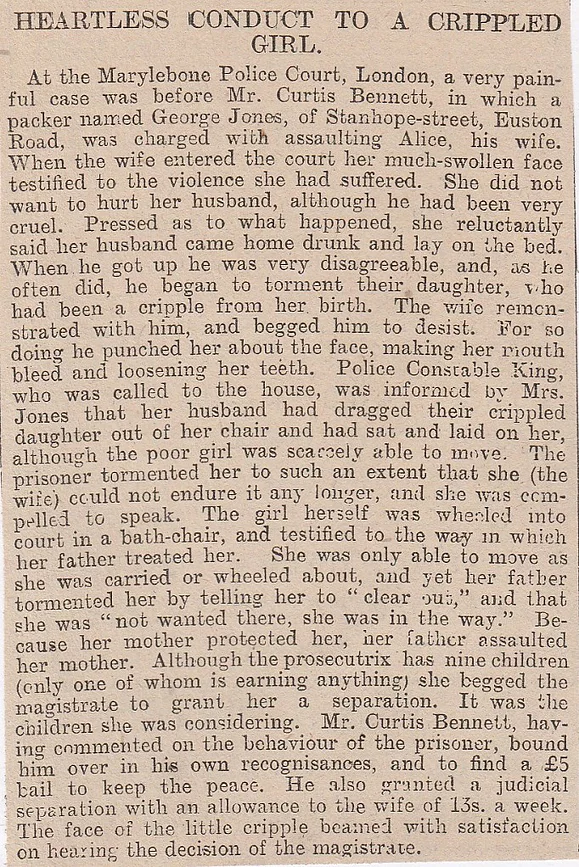
25/ Portland Place, Marylebone, (Child Corpse) December 1878
The corpse of a baby girl was found in the gutter at Weymouth Street, Portland Place. The face and body were mutilated and its legs had been tied together with twine. It was wrapped in a man’s shirt and police are trying to find the perpetrators of the crime.
26/ Crawford Street Suicide, Bryanston Square, July 1835
A seventy-two-year-old servant to Miss Smith, of 129, Crawford Street, named Elizabeth Burrows, committed suicide. She had been in their service for twenty years but had been given her walking orders, making her ultra depressed. When she was in the locality, she told a pin-cushion seller that she was going to end her life by drowning herself. She went to bed as usual and when a family member entered her room the next morning, she saw a pair of feet sticking out of the cistern. The thought of losing her job had been the sole reason for her committing suicide. (129, Crawford Street is still there, now a photo business).
27/ Connaught Terrace Suicide, May 1836
This is the suicide of one the upper classes of Victorian London society. The Honourable Berkeley Craven aged sixty, killed himself at his home in Connaught Terrace in Paddington. His losses on the Derby were an estimated £30,000, which is a huge amount today let alone one hundred and eighty years ago. Understandably he was slightly perturbed by losing such a vast amount and he was left alone to calm down. A servant found him lying prostrate in the parlour at six a.m., with a pistol in his hand and a gaping hole in his head.
28/ Portland Road Station, June 1888 (Re-named in 1917 to Great Portland Street Station)

29/ Burwood Place, (Theft while Dying) February 1854
A dreadful accident happened to Mrs Goddard of Queen Street, Edgware Road, Paddington, when she was crossing the road near Burwood Place and collided with an omnibus, with the wheel of it passing over her head. Understandably, she never survived the accident but the gold watch that she wore, was nicked by some ruffian who pretended to be helping her.
30/ Soho Square Suicide, March 1845
The inquest was at the Cock Tavern in Grafton Street off Soho Square, so I presumed it was somewhere nearby. It was concerning the death of Sophia Margaret Thompson, a thirty-six-year-old cook, who poisoned herself by taking essence of bitter almonds, which is used to flavour cakes and puddings. The reason for the suicide was the most common in all of Britain and that was that her fiance had dumped her.
31/ Bedfordbury Infanticide, Charing Cross, September 1901
In the early hours of the morning, a salesman killed his two-year-old son while his wife was out of the house. This happened at No3, Bedfordbury, and had several cuts gashes around the face and had its throat slit. He was arrested at the scene of the crime. He was John Thomas Richardson aged forty-one, a salesman in Covent Garden. His excuse was that he did it for the child’s own good, also stating that he had a nerve. He bit the child’s mouth and head and a policeman found a piece of the infant’s lip at the crime-scene.
32/ Church Street Fire, Soho, April 1899
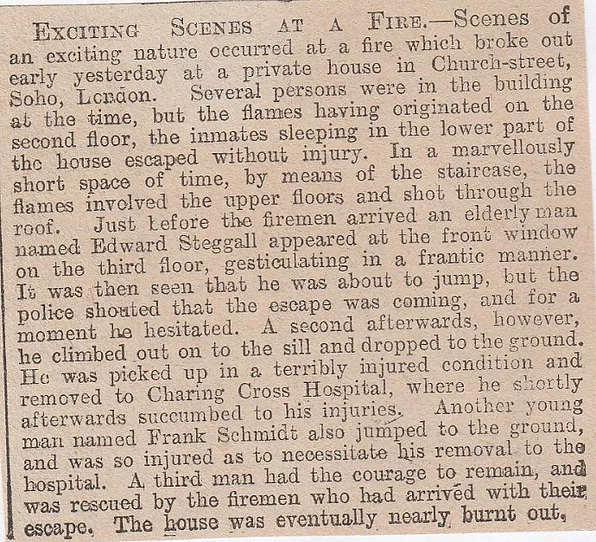
33/ Grosvenor Hotel Suicide, December 1910 (Announces His Own Death)
It could have been a scene from an Agatha Christie novel. Mr John Scott from Worthing in West Sussex aged fifty-nine, who was an agent for a metal firm, checked into the Grosvenor Hotel and shot himself while there. He wrote his own obituary, which he had published in various papers. He was thought to acting weirdly at work, he was up S**t Creek as far as money was concerned and asked friends and family to lend him some cash, but to no avail. He left a letter for the coroner, saying that he was worried and also his sight was fading fast.
34/ Baker Street Station Suicide, February 1910
An elderly man threw himself in front of a passing train at Baker Street Station and was instantly killed.
35/ Baker Street Tunnel Suicide, April 1895
One morning on the Underground Railway near to Baker Street Tunnel, a smartly dressed gentleman was discovered. He was sliced into two by the rails and wheels of one of the engines running over the body.
36/ West Street Fire, Soho, March 1899
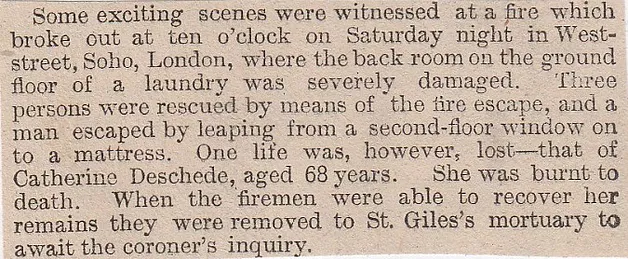
37/ Metropolitan Music Hall Suicide, Edgware Road, December 1885
This is an amazing story of a suicide during a performance. The man in question was Thomas Arring, who was a footman to a posh family in Cavendish Square. As the people were watching the act, Arring pulled out a gun and pointed it at his forehead, then as spectators tried to stop him, he pulled the trigger. The women were greatly distressed by what they had witnessed.
38/ Pimlico/Yalding Child Murder, February 1882
At the end of December in 1881, a little girl named Georgina Moore vanished from her house in Pimlico. She was only seven years of age, with blond hair, dark clothing and white straw hat on. A body that fitted her description exactly was dragged from the Medway at Yalding in Kent. There were strangulation marks around the neck and the body had a firebrick attached to it with wires.(Was it her body?)
39/ Harrow Road, Paddington, (Human Head Found) May 1875
A human head was found in a dust-heap next to Chippenham Road off Harrow Road. Basically, it is a refuse tip or small land-fill area, and a cart was dumping off some garbage when some children, who sifted through the rubbish found a parcel of rags. They undid the rags and a human head dropped out, still bleeding and fresh. Thank God there was a logical explanation for this, and police found out that it was to be used in a dissection at University College Hospital and had been mistakenly thrown away.
40/ Blenheim Terrace, St Johns Wood, (Attempted Murder/Suicide) August 1905
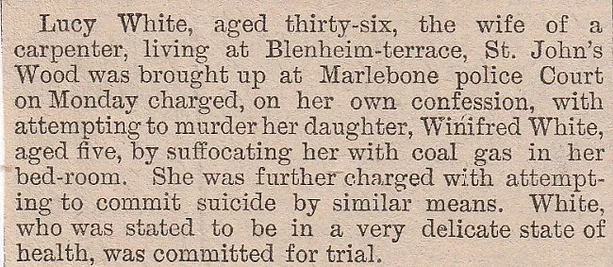
41/ Hamilton Terrace, St Johns Wood, (Cook’s Body Found) August 1891
A cook had been missing from No 3, Hamilton Terrace in St Johns Wood and no trace of her was ever found in the neighbourhood, but a couple of days ago the mistress of the house was looking out of an upstairs window and thought she saw something in the cistern. When it was checked, it was found to be the decomposed remains of the cook who had been missing for ages.
42/ Coburg Row, November 1891
A baby girl was discovered buried in the front garden of a house at Coburg Row in Westminster. The much-mutilated corpse of the infant belonged to Richard Bennet, a stableman and Maria Tickridge, a house-keeper. They maintain that the child was stillborn but the state of the body leaves that theory open to debate.
43/ Paddington, January 1866 (Double Suicide)
Normally when you see the phrase “Double Suicide” it is usually a couple of love-sick teenagers who think they can’t live without the other, but this is strange because this is a mother and son suicide pact. A Frenchman named DeCalnive, apparently some sort of French nobleman, and his Mum, rented an apartment and had people come and visit but they never paid the rent to the landlady. She gave them notice to quit but let them stay another night as they had nowhere to go, then the next morning when she went to turf them out she found them both hanging from either end of a “cornice-pole” (I think this could be curtain rail?) They had premeditated this and had left letters, both stating how they wanted to be buried.
44/ Adelphi Theatre Assassination, December 1897
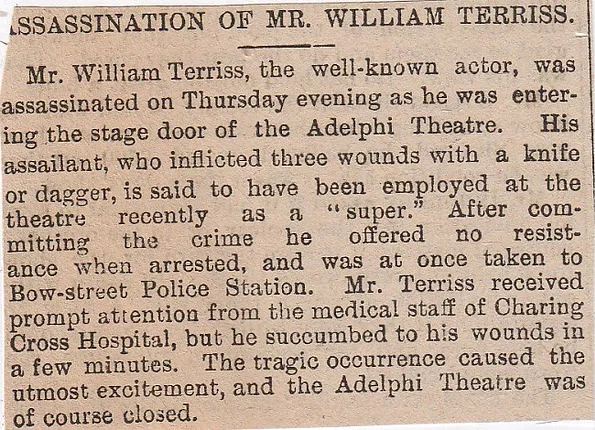
45/ Ritz Hotel, (Arches Death) December 1910
An unknown man died suddenly in the colonnade of the Ritz Hotel. Apparently, the Ritz Arches are a gathering place for the homeless and tramps, and in the early hours of the morning, the window sills were used as benches.The Coroner said: “I don’t suppose it was built for that purpose. A comfortable resting place for tramps- the Ritz! ”
46/ Windmill Public House Suicide, Windmill Street, Mayfair, July 1865 (Pub Suicide)
William Braddock aged thirty-four, a man who had lost his marbles but previously done a lot of his army service abroad, was discovered in a closet at the Windmill pub in Windmill Street. The pub is still there. He had slit his throat with a knife, which was by his side.
47/ Great Windmill Street, Soho, (Female Body Parts) December 1900
On Christmas Day in the seedy streets of Soho, a butchers assistant was cleaning out a cart in Hamyard off Great Windmill Street when he discovered a brown paper parcel. He opened it and found it contained a piece of a female’s body. Police were called for and the grisly remnant has made its way to the mortuary for analysis.
48/ Suspension Bridge Suicide, Pimlico, May 1858
The bizarre tale of a Chelsea pensioner who trundled over the new Suspension Bridge at Pimlico and then threw himself into the River Thames. He was swept away by the current before he could be helped. The Royal Humane Society dragged the river-banks and his body was found later on that afternoon.
49/ Empire Hotel, (Leicester Square) April 1892

50/ Soho, November 1893 (Choked on a Billiard Ball)
A strange accident occurred at a public-house in Soho when a group of blokes were in the billiard room, when one of them fuelled by drink, thought it would be a great idea to shove a billiard-ball in his gob. He’d done the trick before but on this occasion, it went horribly wrong and it became lodged in his throat. He was whisked off to the hospital in a cab but died on the way.
51/ Grosvenor Gardens Infanticide, Eaton Square, April 1876
This gruesome discovery was made at the mansion of Sir Lawrence Palk, No 1, Grosvenor Gardens in Eaton Square. A domestic servant found a package wrapped in paper and told the milkman, then he got a copper to open it and inside was a newly-born child, dead as a dodo. A housekeeper to a gentleman in Bayswater thought that the eighteen-year-old housemaid looked pregnant shortly before going on holiday. When she got back she was questioned and it turned out that she was correct. She had given birth to the child, then wrapped it in the parcel and thrown the infant into the area where it was discovered later on.
52/ Morley’s Hotel Suicide, Strand, August 1892
The suicide of a General at Morley’s Hotel got the staff and customers in a frenzy. The suicide was that of Brevet Brigadier-General Henry Prince of the U.S.Army. Long since retired, as he was now eighty-two years of age, shot himself in the temple. He left a letter addressed to “All my Friends” stating in it that he was going to shoot himself and it would be “A relief which ought to be brought about by the physician when the life of an individual became wasted by nature”. You can go to Dignitas in Switzerland now, if that’s what he meant!
53/ Stockbridge Terrace,Pimlico April 1892 (Over-enthusiastic with scissors!)
The first line reads;-A fire resulting..
early on Tuesday
Stockbridge Terrace
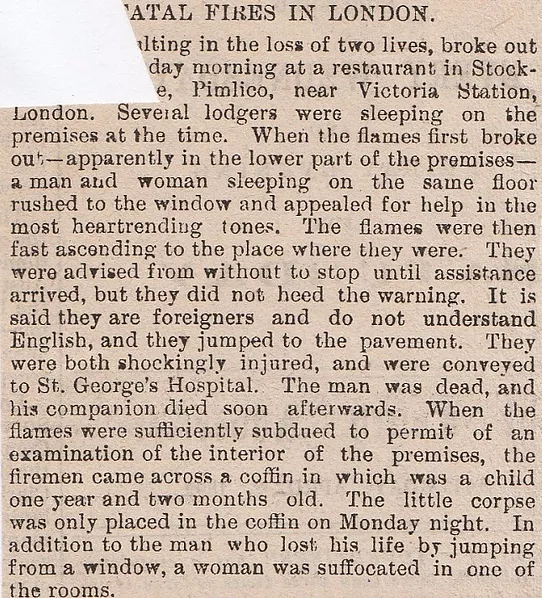
54/ Eccleston Square, Belgravia, (Corpse in Cellar) January 1880
Labourer John Lacey was working at a house in Eccleston Square when he had to make a trip to the basement area, which at one time was a coal-cellar. While down there he thought that he spotted a coconut and pulled it out, only to find that it was a human skull. Police were draughted in and a search of the cellar led to the discovery of the skeleton. The position the body was in leaves no doubt that someone bent the body in half to make it fit into a small recess down there. The vertebrae were doubled over and the thigh and arms had been broken. Police examination revealed that the body was not an adult, but that of a teenager. The family had lived at that property for seven years and had complained about the awful stench on a regular basis.
55/ Temple Station Suicide, March 1875
Not a very salubrious place to breath your last, in a bog at a train station, but this guy had problems. George Richard Moyes aged fifty-eight, had been the cashier at solicitors in Gray’s Inn for thirty years and was, some would say, a workaholic. He was methodical in the workplace, hardly ever took a holiday, but recently had been showing signs of mental aberration. This could have caused him to go into the toilets at Temple Station and blowing his brains out.
56/ Princess Theatre Suicide, June 1857
The glass-collector, Joseph Gallick, who worked at the Princess Victoria pub on Castle Street, off Oxford Street, would tidy up the glasses and pots left in the Princess Theatre also. When two members of staff entered the Theatre later on that morning, they discovered him hanging by a rope. No reason for the act can be assigned.
57/ Lees Street. Piccadilly, January 1885
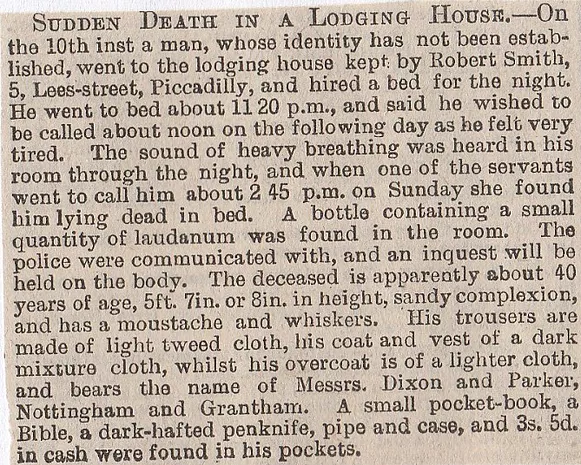
58/ Danish Embassy? No 39, Grosvenor Place, December 1833 (near to Buckingham Palace)
When it says that the Danish Minister’s establishment, I presumed it meant the Embassy, but could be private living quarters. The body of Dorris Jessin, a twenty-nine-year-old nursery maid was found in Beron Blome’s (Danish Minister) establishment. Late on one evening, a staff member noticed some kind of liquid trickling under the door of the dining-room. When they opened the door, Miss Jessin was sprawled out on the floor, with her throat cut and the razor by her side. She was already dead. Miss Jessin was also found to be pregnant when the autopsy was performed, with the father unknown. Back in Denmark, she had two illegitimate children, so she had a bit of a history of this type of thing. Other staff members had found her on her own and crying, on many occasions. (Could the Danish Minister have been the father?)
59/ Harley Street, (Human Remains in Cellar) June 1880
No 139, Harley Street, the property of Mr Enriques, has been the scene of great excitement in the locality when human remains were found in the cellar. They are of a female about forty years old, with decomposition so bad that her facial features are unrecognisable. There were various articles with the corpse that may prove useful in identifying her, but one strange part of the case is that her hair had been cut from the head and she had burns all over, from the quicklime she had been buried in. The cask she was in, is an American meal tub and was covered in lumber. (Was the identity ever discovered?)
60/ Little Marylebone Street, Marylebone, March 1897 (Childs Body)
While the workmen were busy demolishing some houses in Little Marylebone Street in Marylebone they stumbled across the dead body of a young child. It was badly decomposed and was thought to be aged about seven or eight years. Also, it was wrapped in a newspaper dated November 1879, so it could have been buried nearly twenty years ago.
61/ Haymarket, (Restaurant Tragedy) June 1888
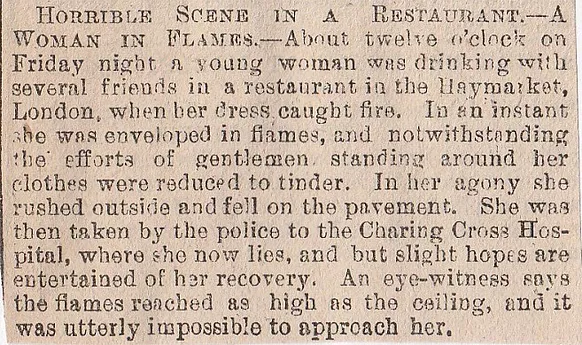
62/ Vigo Street, Soho, March 1885

63/ Charlotte Place, Fitzroy Square, September 1850
A restaurant owner (eating-house) in Charlotte Place off Fitzroy Square, committed suicide by drowning himself in a water-butt. He had recently become a gambling addict and had mentioned to people that if “Voltigeur” won the St Leger he would have lost all his money. It did, so he killed himself.
64/ St Johns Wood Suicide, April 1891
John Richard New of 24, Norfolk Road, St John’s Wood, left a suicide note outside his bedroom door for his house-keeper. She went into the room and saw him laid in bed, with a phial (which contained cyanide) and an empty glass on the bedside table. He was inconsolable about the death of his wife and couldn’t get over it. The note read:-
“Dear Phyllis-I do not want to shock you, but be prepared for some very bad news. When you have got this something terrible will have happened to me. Let Mr Houghton know as quietly and quickly as you can. Telegraph to my father to come here, and also Mr Gaskell. Take care of the enclosed key. It opens the drawer in the parlour, where my account books are, as well as my other keys, and some letters.”
65/ Portland St/Baker Street Stations, (Fatal Accident) July 1889
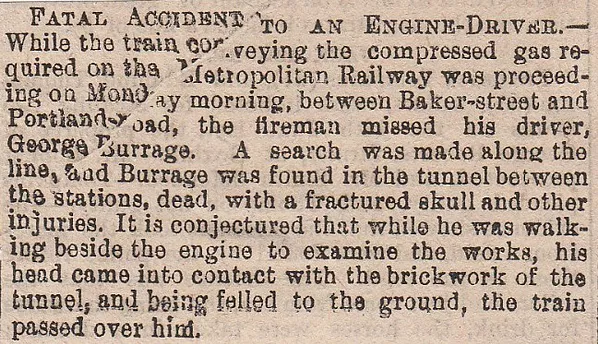
66/ Marylebone, December 1830
14-year-old William Ageat hung himself in his uncle’s stable, when he feared what the consequences would be when he found out that he had ridden his favourite horse and thrown it down, breaking both its knees.
67/ Piccadilly, (Gambling Suicide) September 1848
21-year-old Norman Howard worked in a tailors shop in the West End, but he liked a flutter on the horses so he had money worries. He got into a cab at Regents Circus in Piccadilly, then after a couple of minutes travel, he shot himself in the temple. He had been living up the past few days and had seemed in a despondent mood recently, this was because of his large losses on the horses on the Doncaster St Leger. Similar to Fitzroy Square story above.
68/ Pimlico Pier Child Remains, May 1880
A package was fished out of the Thames near to Pimlico Pier containing the arms and trunk of a five-year-old child. It appears to be the remainder of the body to the head that was found by some lads in Battersea. That was discovered a couple of days ago and the head had curly hair and had been in the river for less than a day. The rest of the body is still missing in the water.
69/ Pall Mall Accident, January 1885

70/ Marshall Street, Golden Square, Soho, (Gored by Bull) August 1839
One afternoon John Williams, a butcher from Marshall Street (next to Carnaby Street), was in the process of “knocking down” a bullock. Being a butcher I think this means to kill it or knock it out! The bull retaliated and its horn went straight through his cheek, just below his eyeball, and tore it to shreds. Chances are that Williams died from the injuries he sustained.
71/ Kensington Gardens Suicide, July 1836
Ralph Worsley, a thirty-eight-year-old who worked for a saddler in Mayfair, drowned himself in the water opposite Kensington Palace. He took out the contents of his pockets and laid them all on the bank. This included a quick suicide note to a friend of his, and it said :
“I have committed suicide in Kensington Gardens. Come as soon as you can, for I prance to the alligators. Farewell, Ralph Worsley.”
72/ Rupert Street Child Kidnap, Soho, September 1885 (Off Brewer St)
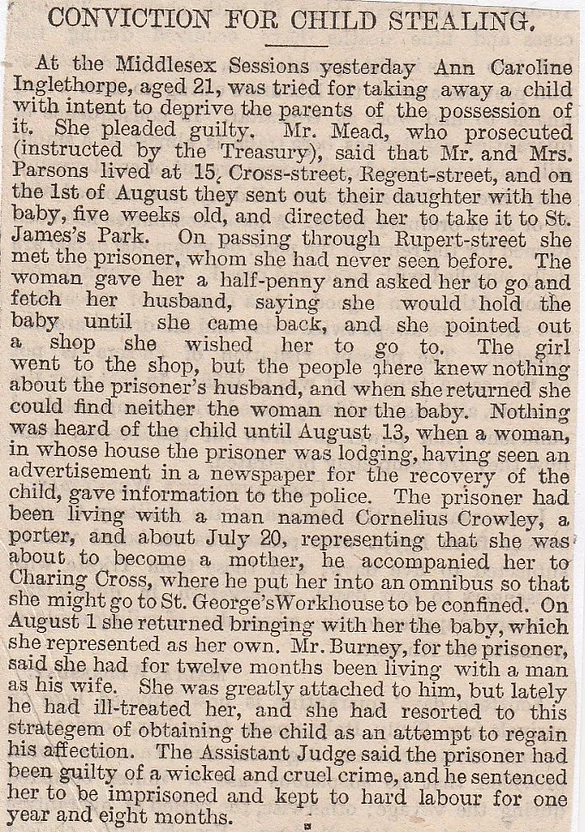
73/ Devonshire Street, Portland Place, (near Regents Park) November 1870
The domestic servant, Miss Sophia Wingfield, committed suicide at 1a, Devonshire Street, by hanging herself from a beam in the kitchen with a piece of clothes line. When they cut her down she was already dead. Interestingly she was sacked from her other job for trying to slit her throat.
74/ No’s 18-20, St James Street, (Hidden Treasure) May 1884
An underground passage was discovered when workmen were digging in St James Street, in it was a strong-box which when opened, was found to contain antique plate, some of it extremely rare. Also among other things were 1700 gold and silver coins and an antique harp, which is considered to be of great value and is at least a hundred years old. (Any more dug up, it says there is a lot more down there in the article?/Passage still there?)
75/ Charing Cross Pier, June 1872 (Dead Match-Girl)
As a London and Woolwich steamboat was approaching Charing Cross Pier, someone on the pier shouted out that something was in the paddle of the steamboat. The captain ordered the bundle to be taken out and it was revealed to be the dead body of a ten-year-old girl. It was taken to the mortuary where an autopsy uncovered the fact that around her neck was a bag containing matches. It is thought she was a match-girl, but how she came to be there was a complete mystery.
76/ Charing Cross Pier Suicide/Lambeth Bridge, January 1890
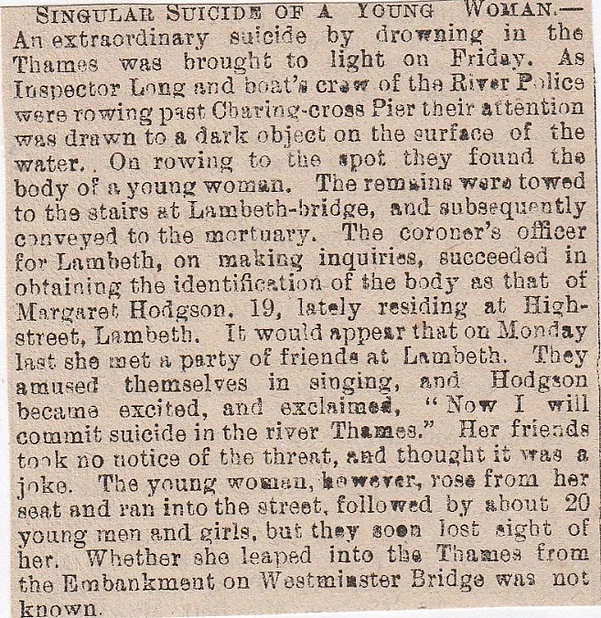
77/ Drury Lane Theatre Fatality, December 1844
A dreadful accident occurred at the Drury Lane Theatre, during a performance of the “Revolt of the Harem”. In the second act of the ballet, the ladies of the harem are found bathing and among those is Zulica, the royal slave. The gas light caught the dress of Miss Webster and she was soon in flames and as she was running about screaming in agony for somebody to help her, she was pushed away by others to prevent them from catching fire. A carpenter on the prompt side of the stage, rolled over her to try and put out the flames. Miss Webster was taken to the Green Room but her burns were said to be life-threatening.
Later on, she died of her burns and Miss Clara Webster, aged twenty-one was buried at Kensal Green Cemetery.
78/ Ebury Street, Pimlico, (Freak Accident) August 1858
This is a million to one accident if ever I heard of one. Sarah Winter, was the cook to Mr Woodly at Ebury Street in Pimlico and she was in the process of hanging a venison in the larder, when she fell from the stool she was balancing on and impaled herself under her chin on a spare meat-hook. She hung there, unable to free herself or indeed to call out. The struggles were heard by another servant and she was rushed to the hospital, but it is said her chances of making it, are slim to none.
79/ Charing Cross Hospital Suicide, September 1906
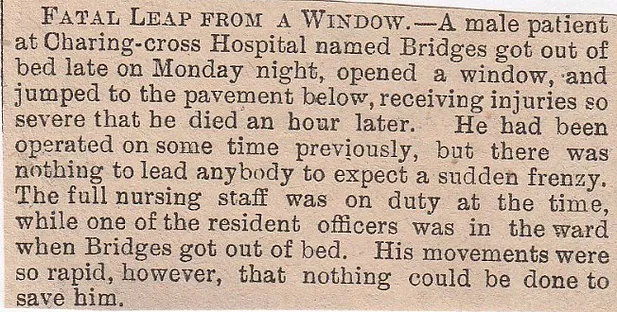
80/ No.18, Grosvenor Mansions, Victoria Street, October 1887
A lady by the name of Witt living at 18, Grosvenor Mansions, threw herself from the top window of the seven-storey building, which is about a hundred feet high. She collided with a balcony on her way down and this deflected her path onto the railings that surround the property. The force of this snapped them in her body and she landed on the pavement. The surgeon who examined the corpse said most of her bones were shattered. Mrs Witt was married to a barrister who was out of town on business. Everybody who knew her said she has been in a really good mood of late.
81/ Royal Orthopedic Hospital Death, Oxford Street, July 1870
Adam Leonard, just a young lad, was sent to the top floor with a pot of tea for one of the patients. On delivering it he made his way down the stairs, when he thought it would be quicker to slide down the bannister. He overbalanced and fell onto the basement floor. There was blood and brain matter coming from his crushed skull and he was pronounced dead on the spot.
(Royal Orthopedic Hospital-was 297-315 Oxford Street, it is still there but now a London gift shop and perfume shop etc.)
82/ Marshall Street Murder/Suicide, Golden Square, April 1885
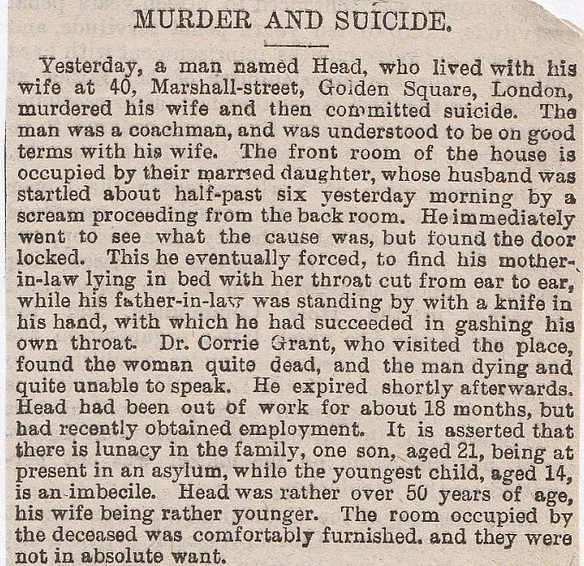
83/ Soho, (Human Body Parts) February 1894
In a yard adjoining St Anne’s School in Soho, a group of school-kids found a brown paper package behind a door. They decided to have a game of football with it and its contents were revealed after a while when a piece of a human skull protruded. Police were summoned and the rest of the parcel was uncovered and they saw two human hands as well as the skull. They are thought to be those of a female.
84/ Little Newport Street, Soho, January 1890
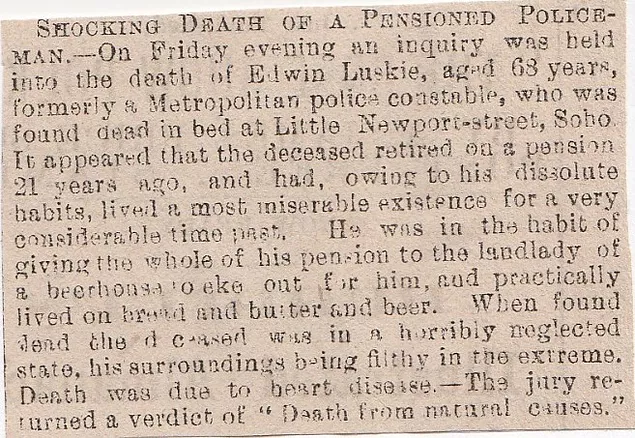
85/ Paddington Station Suicide, May 1873
A gentleman killed himself in a waiting-room at Paddington terminus of the Great Western Railway by shooting himself in the forehead with a revolver. The shot was heard and railway staff rushed to the spot but found the man dead. In his pockets were a handkerchief with the initials “E.P.W.R.” stitched into it and “Major Ripley” on his vest. A check on the Army List revealed a Major Edward P.W.Ripley, so chances are it was this gentleman that shot himself.
86/ No 7, Charles Street, Lisson Grove, (Tragic Accident) March 1835
A man named Crawley who lived at No 4, Oxford Buildings, Cavendish Square, had a terrible accident at his girlfriends’ house in Charles Street, Lisson Grove. He went for a sneaky visit and when finding the door locked he climbed the shoulders of his friend to open the first-floor window. A policeman was on his beat and coming his way, when he lost his hold and fell onto some railings, one of which punctured his thigh and another entered the abdomen. The policeman and his friend managed to remove him from the iron spikes and blood spurted all over the place. He was taken to the hospital, but his chances of survival are slim.
87/ Broad Street, Golden Square, August 1885 (Fatal Ignorance)
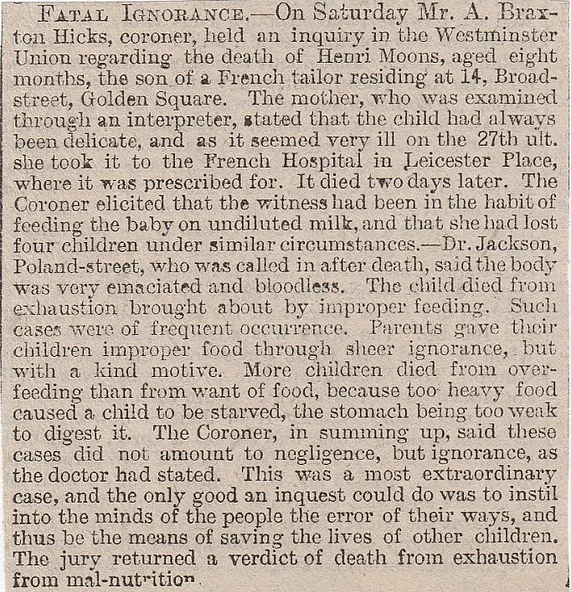
88/ Bow Street Pub Suicide, June 1855
Johnny Broom, a top pugilist, committed suicide by slitting his own throat in the Wrekin Tavern, Broad Court in Bow Street. He had an attack of delirium tremens (the shakes you get when you stop drinking alcohol) and did it in a full pub in the afternoon.
89/ Westminster, July 1917 (Lady Artist’s Strange Suicide)
Doris Church aged twenty-six and a female artist committed suicide in her studio. She was found by a nurse lying on the floor with a gas tube in her mouth. She was rather theatrically dressed in a kimono and her head lay on some cushions which were strategically placed around the room. There was a glass and an empty champagne bottle next to her and also her cigarettes and a pack of cards. The father said she had a neurotic temperament but she was given a generous allowance by him, and her husband who was on the front, also gave her money. The cards were used for a game of patience. She had been treated by her doctor for depression. It is also feasible that she used the cards for fortune-telling. Something happened, whilst also being drunk and highly strung, that made her kill herself.
90/ Barnsdale Road, Paddington, (Orton Mystery) September 1885
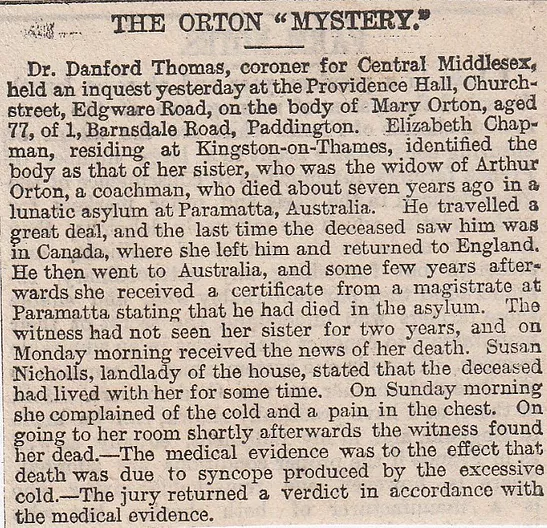
91/ Albion Tavern Suicide, Paddington April 1870
A smart gentleman named Lawrence thought to be from Ramsgate in Kent, committed suicide by shooting himself in the head at the Albion Tavern on Dudley Grove in Paddington. He’d been going there for a couple weeks, drinking and conversing with the locals. When the sound of a gunshot was heard in the pub, the locals and landlord found him lying there with only half his head remaining, while the other half was stuck to walls. He left a letter, addressed to a lady in Ramsgate. It read:
“Hyde Park, April 7th, 1870- Dear Sally, I fired at myself twice last night at Deptford, but missed fire both times, so I must do it tonight in the park, God bless you all. W.L.
It is all through my wife being misled by Tom and others. I knew they meant to get me out. I hope they will always prosper. Mind the children. If the pistol is found I wish Oliver Clarke to have it. Dear Sally, it is now four o’clock. I have just put the cap on the pistol. Goodbye”
92/ Charing Cross, (Child in Parcel) August 1898
Found n the roof of an omnibus at Charing, the dead body of a fully-developed boy which had been born that long. The conductor, Arthur Nice, said that the omnibus arrived at Charing Cross from Cricklewood at midnight and he went upstairs to check the top deck and there he found the brown paper parcel wedged behind a seat. In the package was an alpaca shirt and the child was wrapped in that. He stated that he had not seen anyone get on with such a parcel, but he says it wasn’t there when he checked the top deck at Cricklewood. The coroner suggests that the child should have survived, even being wrapped up as it was.
93/ Westminster Pier/Thames, (Admiral Drowns) May 1888
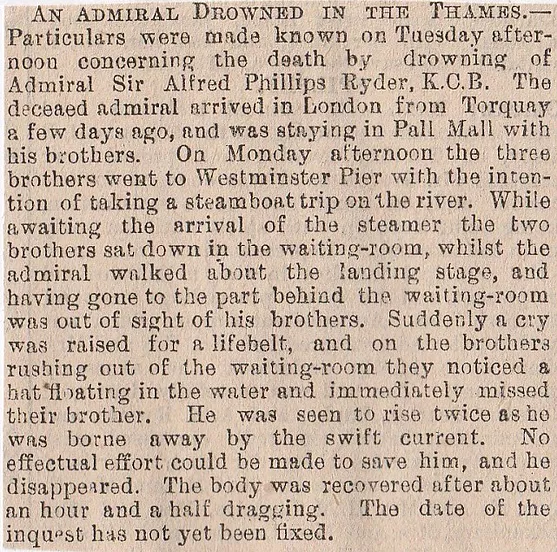
94/ Haymarket, (Dodgy Story about Pregnancy) August 1845
Here’s a sad tale of Emma Whale, a twenty-five-year-old bootmakers wife who lived in Upper Rupert Street, Haymarket. She killed herself by taking oxalic acid. Her husband had left her in Winchester with friends on May 28th, as he had got a job in London. He sent for her six weeks ago and she went down to the Smoke to see him. Several days later it was proved that she had been faithless to him and she admitted as such to her husband. Apparently, she had been coaxed to Portsmouth by a woman named Lynch and as soon as she got there was taken to a pub run by a woman named Day. They had dinner and a glass of wine and then she was introduced to a navy captain, who got her drunk. Emma went to bed when the captain entered her room and had forced sexual intercourse with her. After the sex he told her his name was Edward Stewart and asked her to live with him, then, later on, he would take her to India. He also told her to write to him at “Miss Louisa Edwards, Post Office, Hull”. The husband swallowed the story and forgave her, but the disgrace and gossip preyed on her mind and she thought that suicide was the best way out.
95/ Swiss Hotel, Compton Street, Soho, (Fatal Accident) August 1895
A young lad was walking past Wardour Street when he heard groans coming from the garden at the back of the Swiss Hotel in Compton Street. Police were summoned to the spot and there they discovered a man suspended on some spikes by his arms. He was semi-naked. He was whisked off to Charring Cross Hospital where he died the next day. While in the hospital he managed to tell them his name was Joseph Galvoni and it was established that he had been stabbed, then thrown from the window. He was a waiter at the Swiss Hotel. He had fallen from the fourth storey onto the railings.
96/ Claverton Street, Pimlico, March 1895 (Errant Lovers Suicide)
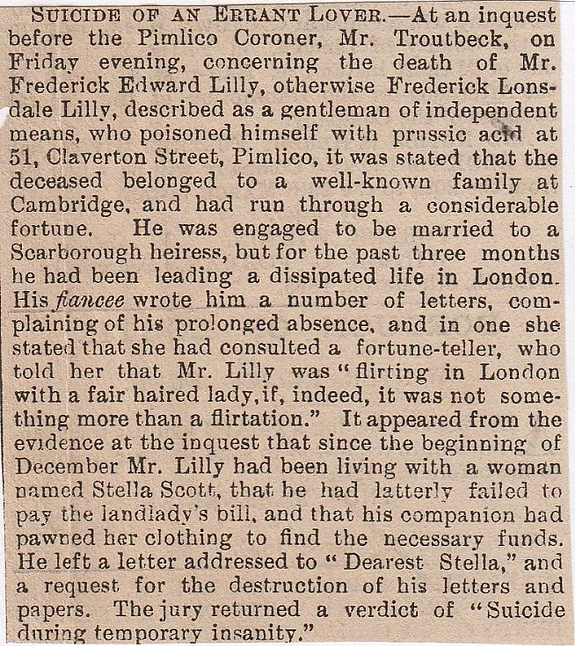
97/ Manchester Square, Marylebone, (Child Remains in Chimney) May 1879
An inquest into the death of a child discovered in a chimney at No 3, Dukes Mews, Duke Street, Manchester Square. The chimney sweep at the property, John Edward Sparks, went up the chimney about two feet or so, in the third back room of Dukes Mews, when the old “brown paper parcel” was spotted. Inside were the remains of a dead child wrapped up in a three-year-old newspaper and the child was barely a skeleton. When the autopsy was performed it was found that it had its skull smashed, but whether this was before or after death, cannot be ascertained. The tenants who lived there said they had hardly used the fireplace it was discovered above. (I believe Duke Mews are still there, off Duke Street, down the side of the Devonshire Arms Pub.)
98/ Bedfordbury, (Boys Body in Skip) October 1881
Ten-year-old Charles Nurse, who resided with his Mum at No 1, Charles Buildings, St Martin’s Lane, was discovered in a dustbin in Taylors Buildings in Bedfordbury. The bin was akin to a modern day skip and was used for the rubbish from the workshops and the brass and copper factory outside whose door it was placed. Police were called for when the lad was found and his body was taken to St Martin’s Mortuary. The surgeon said that he had been dead for a long while. The mother (and this gives you an insight into Victorian parenting), said he would stay away for a couple of days at a time, in a bid to avoid school. It is thought he used to sift around the bins for scrap copper and he might have fallen in accidentally.
99/ River Thames/ Westminster, (Suicide Letter to Son)March 1885
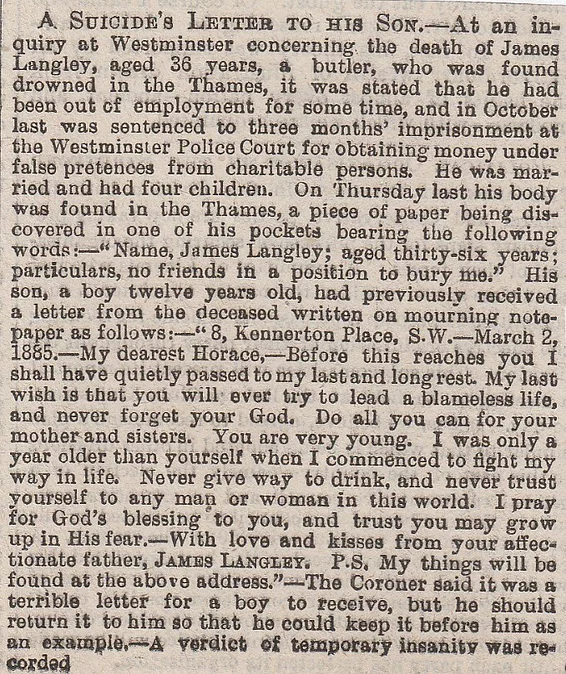
100/ Cirencester Street/Grand Junction Canal December 1860 (Missed Her Brother)
26-year-old single female, Susan Boutcher of No 7, Brindley Street, Harrow Road got some bad news from Jamaica saying that her brother had passed away. At a party at her stepfather’s house, she left friends and family at around one a.m., then was spotted by a policeman running down Cirencester Street (Still there), towards the Grand Junction Canal. The police and family searched the area that she suspected of being in, and sure enough, she was found at the foot of the street where she was last seen alive.
101/ Upper Marylebone Street, (Body in a Trunk) March 1894
A grisly discovery was made by police at Upper Marylebone Street. A slapper from Austria by the name of Hermann, had just moved to the house at the above address and with her luggage was a huge trunk. She used to live at Grafton Street, Tottenham Court Road. The trunk caught the attention of Mrs Hutchins who rented rooms there. Mrs Hutchins said that she came home with an older fella last week and she heard an argument break out between the two of them. The next day there was blood in the sink and then she moved out pretty sharpish. Police searched Hermann’s room, but when asked about the trunk she said it had books in it. They demanded that it was to be opened and when it was, lo and behold, there was the old gentleman with his head smashed in. The body was later identified as that of Charles Stephens of Albany Street, Regent’s Park, aged seventy-six-years-old.
(Upper Marylebone Street-name changed to New Cavendish Street)
102/ Osnaburgh Street, Regent’s Park, March 1899

103/ Millbank Prison (Warder’s Suicide) January 1857
John Jackson aged forty-five, head infirmary warder at Millbank prison, committed suicide by taking prussic acid. The medic sent James Higgs, a prisoner, to get Mr Jackson, and when he received no reply to his constant knocking, he peeped his head round the door and saw him lying on the bed. He thought he was fast asleep, so he tugged him by the coat. A little bottle was in his hand and this was the prussic acid. Staff intimated that Jackson had liked a drink or two, but he was never drunk on duty. The stomach pump was used but all too late. He could get whatever drugs and poisons he wanted as he worked in the dispensary. The wife of Jackson said that he left a short note before he went to Millbank that day, and it said :
“William owes you fifteen shillings and a book. Turner five shillings. Adieu”.
(Millbank was a holding facility for convicted prisoners who were to be transported to Australia Opened 1816/Closed in 1890.)
104/ Stafford Place, Pimlico, (still there) March 1852
This is a calculated suicide if ever there was one. Mr Wakeling of No 2, Stafford Place in Pimlico, (near to the Palace) had a dinner party at his house one evening. The guests left at one a.m. and the Wakeling’s prepared for bed. He rather calmly kissed his five-year-old son, put him on his knee and put his gold watch on a chain around his neck. He then walked out of the room and after a few minutes, Mrs Wakeling heard the report of a gun. She ran downstairs and found Mr Wakeling covered in blood on the floor. The servants came to her aid and called for the surgeon to attend. The gun was in his right hand and he had shot himself under the right ear, with the bullet lodged in the brain. Life at home was a happy one and he had no financial worries, so why he did this is a complete mystery to all.
105/ Albany Street, Regent’s Park, (Murderous Attack) October 1897 (Could be in Camden also!)
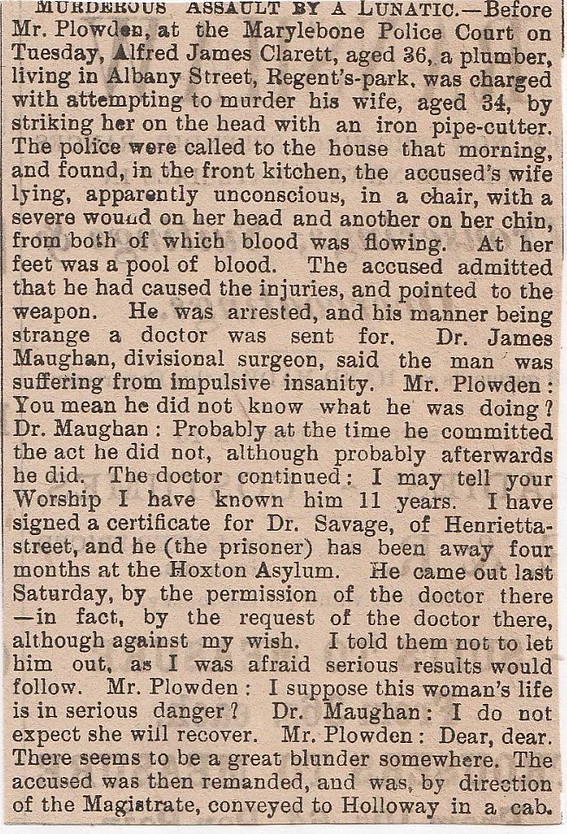
106/ Montagu Square, (Stable Death) July 1857 (North of Marble Arch)
Edwin Dupe, a coachman in Montagu Street, Montagu Square, was taking the horse to the stables when they reared up and appeared to be scared by something. He dragged the horse to the feeding trough where a large rat was feasting. The rat was the cause of the horses being afraid and agitated, so in his infinite wisdom, Dupe tried to kill the rodent. The rat dodged and weaved and finally landed on a horses back, which made it rear up on its hind legs, knocking Dupe over in the process. Dupes jaw was shattered to pieces and even hospital treatment could not save the life of him. He left a widow and six children.
107/ Crown and Sceptre Suicide, Great Titchfield Street, May 1847
Frederick Cruso, the landlord of the Crown and Sceptre pub, ended his life by swallowing some prussic acid. Recently he had become addicted to gambling on the horses and his own business had gone downhill as a result. He had told his missus quite recently, that he wanted to die and asked her to get some charcoal so that they could all die together, the children as well. The last Derby, he lost a hell of a lot of cash and when asked to pay his betting tab, he was unable to pay it. Cruso left home one morning and came back, then went up to his bedroom. It was on the floor in that room, she discovered his dead corpse.
108/ Marylebone Fatal Accident, April 1899

109/ Upper Charlton Street, (Alcoholic’s Acid Suicide) November 1862
Barbara Dent aged thirty-three, committed suicide at No 22, Upper Charlton Street, Fitzroy Square, by drinking sulphuric acid or oil of vitriol. The husband, Robert, identified his wife and said she had become addicted to drinking of late and was always on a downer when she did drink, and on one of these binges, she threatened to slit her throat. He went to her aunts about a week ago and saw her down four glasses of alcohol, then pull out a hip-flask with gin in it and said she have one more drink. When a doctor was called to see her, she was vomiting and her lips were scorched with the burning of the oil of vitriol. Dent was obviously insane and died shortly afterwards.
110/ Bond Street Station, (Accident or Suicide?) August 1901
A train bound for Shepherd’s Bush was stopped when pulling out of Bond Street Station. Workmen removed the front plank of that end of the platform and found a man in a huddled position between the engine wheels and the platform wall. He had been terribly mutilated, with cuts to his face, his skull fractured and his right leg severed off and his left foot also cut off. He was still alive, but only just and was rushed to Middlesex Hospital, but expired when he got there. Who he is, is not yet known.
111/ Piccadilly Fatal Accident, August 1896
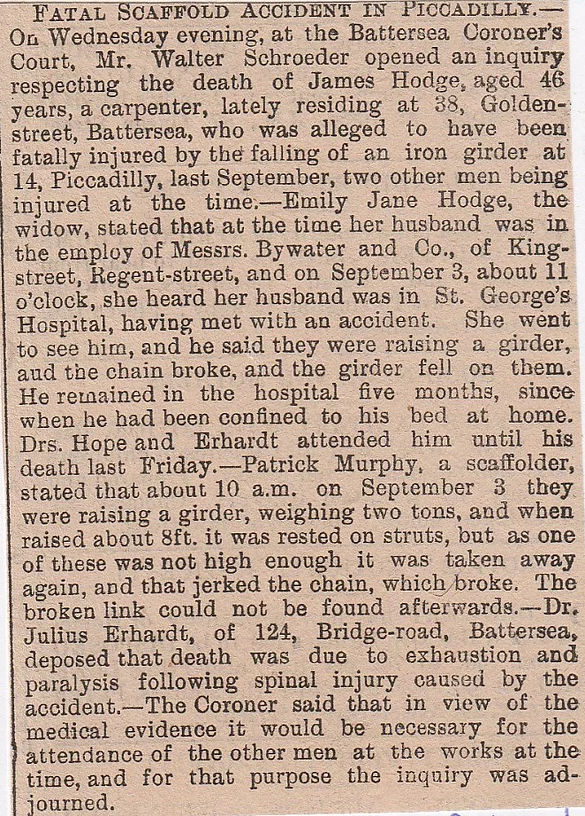
112/ Whitehall Human Remains Discovered, October 1888
The inquest on the human remains discovered at Whitehall a week ago, say that the head had been sawn from the trunk, as well as the pelvis and lower portion of the body. The arms had been removed with great skill and dexterity and with a medical instrument. The parts missing from the victims of the “Whitechapel Murders”, are also missing from the trunk. An arm found in Pimlico on September the 11th, fitted the trunk exactly.
Later on, information came through that the woman’s trunk was found in the new police buildings in Whitehall. A police sniffer dog found another leg, which had been severed below the knee and a piece of material thought to be a stocking, was left on the limb. Police had supposed to have thoroughly searched the area, when the body was found, but the dog found the leg about five feet from where the trunk was discovered.
113/ Compton Street, Soho, October 1894 (Priests Body Found)
The body of a man thought to be Spanish and wearing priest’s garb, was found hanging to the bed-post in a house in Compton Street, Soho. He had rented a room with a companion. The remains are badly decayed and as he paid all his accounts last week, it is thought it could be from that time. The companion is at present, missing.
He was identified as Louis Caceres, a fifty-year-old Spanish priest and the companion was called Eugene, and they both arrived about three weeks ago. Eugene has disappeared off the face of the earth. Caceres hung himself with a silk handkerchief and by his side was a revolver and a letter addressed to the Chief of Police. The letter said he was disgusted with his own family and that he was tired of life. He also stated that he was a Peruvian national. The autopsy revealed he had been hanging in the room for at least three days, and the elusive Eugene is still evading the police radar.
114/ Edinburgh Mansions, (Murder/Suicide) July 23rd, 1885
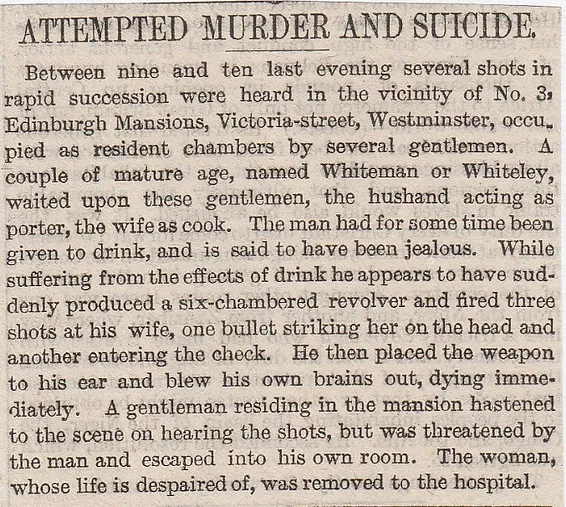
115/ Edinburgh Mansions, July 27th, 1885
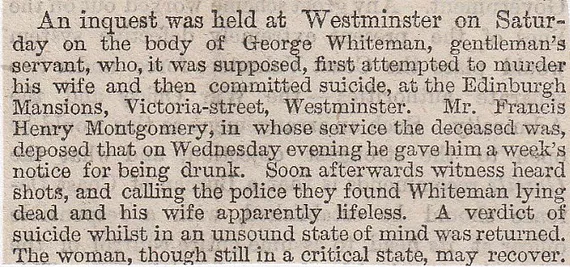
116/ Duke of Yorks Column Suicide, May 1850
Albert Stephan, the saxhorn player at Her Majesty’s Theatre committed self-destruction by jumping off the Duke of York’s Column which is just off The Mall. He paid his six-pence to go up and see the view from the top and was looking around for about twenty minutes or so, then when he was virtually all alone and straight after the Horse-Guards clock struck 10-30, a woman was heard to scream. The attendant went to see what was wrong and just as he was about to climb the stairs, when he spotted the man’s body sprawled out on the stone pavement. He came down feet first and when his feet impacted with the ground, his boots burst from their soles and smashed his feet. He had some loose change on him, a handkerchief with the initials “S.T.” on it. He was single and in his fifties. (He landed on the west side, facing Carlton Gardens/Carlton Terrace)
117/ Wellington Barracks Murder? August 1890 (Near Buckingham Palace)

118/ Great Pulteney Street, Soho, March 1871 (Double Suicide)
At first, this considered to be a murder/suicide but was later revealed to be a double suicide instead. Mr Longnon of 27, Great Pulteney Street in Soho and his wife died from self-inflicted gunshot wounds, with her putting the gun in her mouth and firing, then he pointed it into his chest and shot himself in the heart. This can be certain as a neighbour heard a noise from the back room first, which is where she was found, then the front room, which is where Mr Longnon was. He had a letter on him, asking that the mother-in-law take care of the children, but as to the reason for the double suicide as yet nobody knows.
119/ Queen Street, Soho, (Child’s Mystery Death) September 1885

120/ St Martin’s Hall, Long Acre, (Four Deaths) January 1862
A catastrophic accident at St Martins Hall, Long Acre has resulted in two deaths and more are expected.Tthe Hall burned down in 1860 and has been rebuilt, and Mr DeFries was the contractor in charge of operations at present. Seven of his men were fitting a chandelier to the ceiling and they were stood on a plank in order to get up there. In today’s world with health and safety officials round every corner, they would have been shut down immediately, as in most Victorian operations, that involved people balancing on bits of wood etc. I think you can guess where this going! The cross poles which held up the plank suddenly gave way under the strain and they were thrown forty feet down on to the floor below. The problem in the Victorian era was that word got around very quickly and a large crowd had then gathered outside the Hall to see the dead and injured. Patrick Coglan died in hospital, as did a chap by the name of Wood. Two others died during the night, making four deaths and the other three are in a dangerous condition and may not make it. (How many died in the accident?)
121/ Pimlico, (Barrister’s Wife Death) August 1890

122/ Tottenham Court Road Mystery, March 1899

123/ Holles Street Fire, Clare Market, January 1885

124/ Horse Guards, January 1916 (Lt-Colonel Suicide)
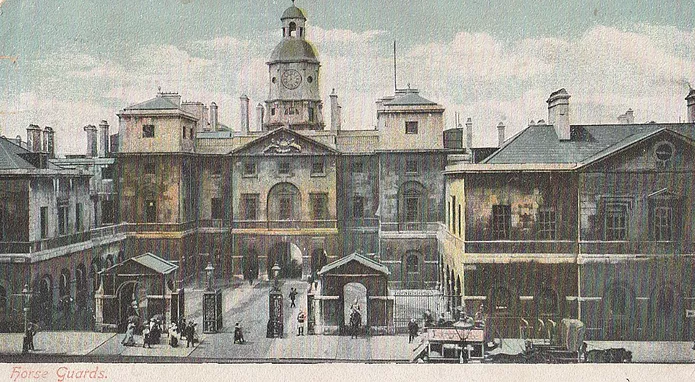

125/ Westbourne Street, Pimlico, October 8th, 1885 (Father Manslaughter)
A letter carrier named Charles Goulding, who resided in Westbourne Street, Pimlico, met with his death under peculiarly shocking circumstances yesterday. Just as he was finishing his dinner, his son Joseph aged thirteen provoked him and on a sudden impulse, he threw a plate and knife at the boy. The boy, in retaliation, picked up the knife and stabbed his father in the thigh, severing the femoral artery and the unfortunate man expired in a short time. The boy was apprehended at Waltham Green.
126/ Westbourne Street Parricide, Pimlico, October 13th, 1885
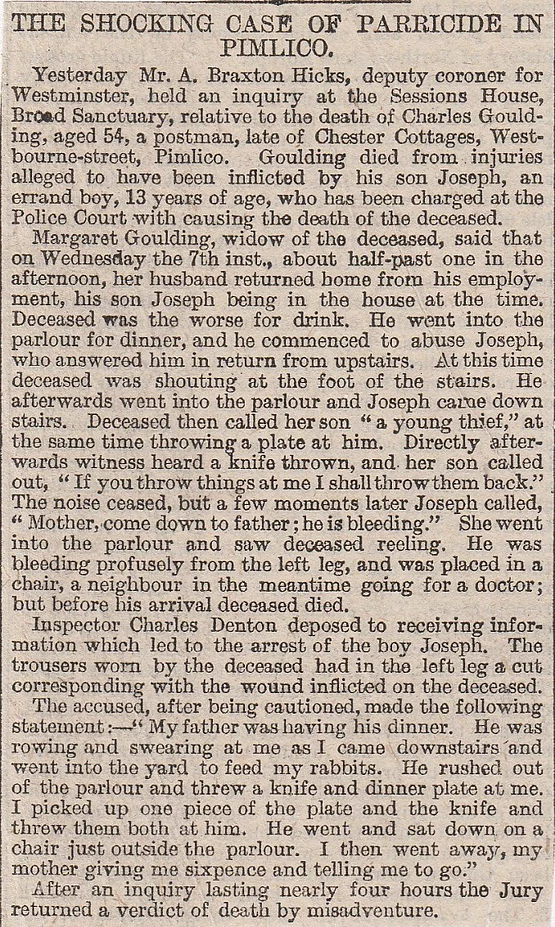
127/ Upper Bond Street, Mayfair, (Love Tragedy) May 1899
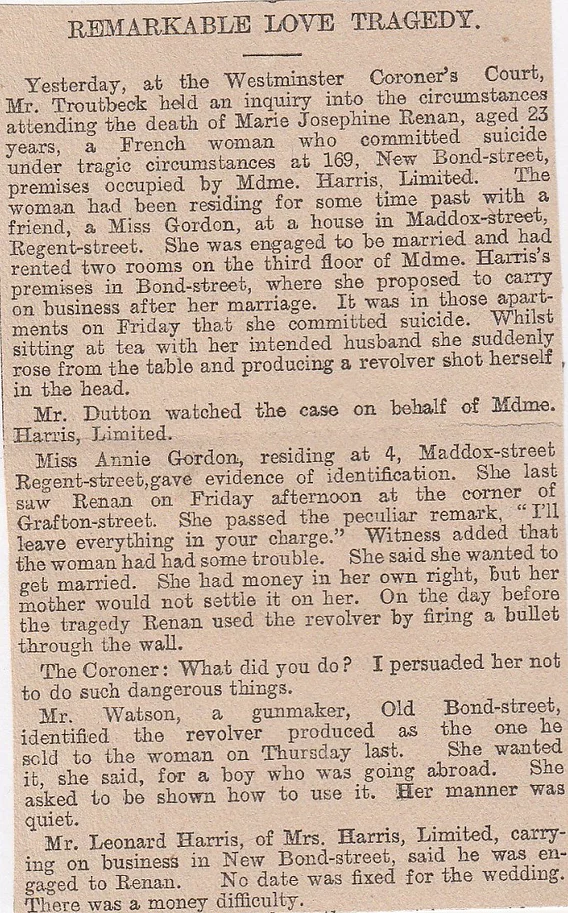

128/ No 50, Strand, (London Mystery) December 1885

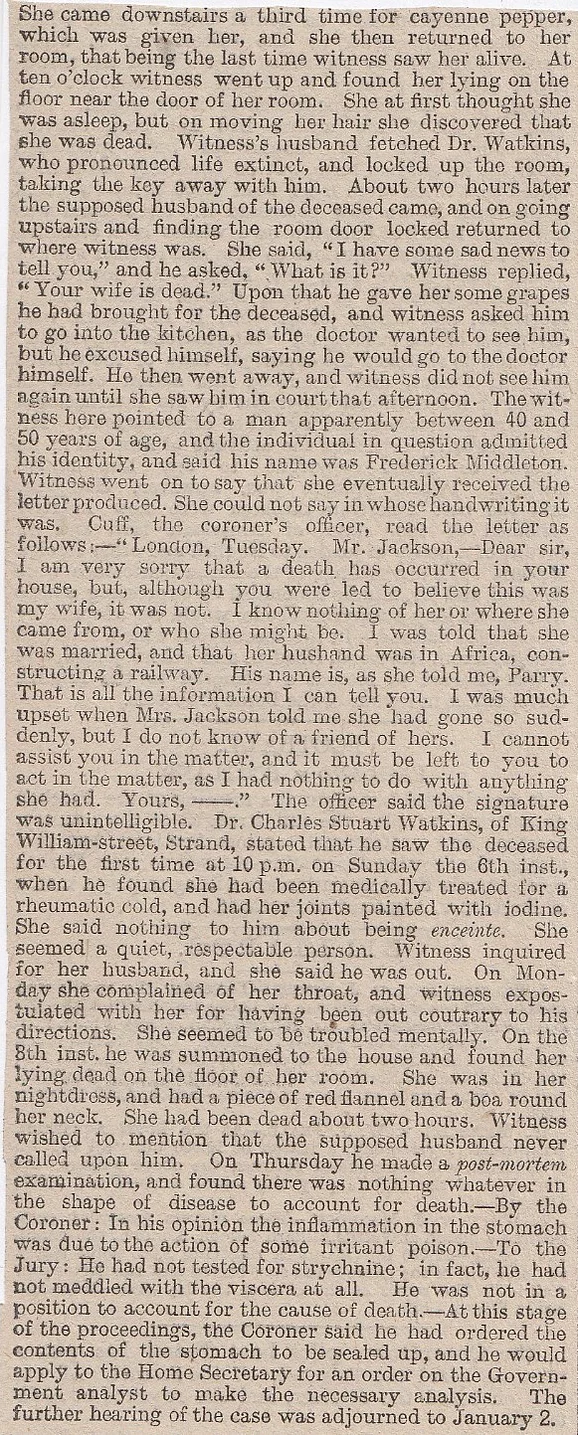
129/ National Portrait Gallery Murder/Suicide, Trafalgar Square, February 1909
A murder/suicide in a national museum is an unusual occurrence, but it happened at the National Portrait Gallery in Trafalgar Square. The victim and murderer are Mr and Mrs John Tempest Dawson who resided at 31, Brunswick Place, at Hove near Brighton. It happened in Room 27, in the east end of the gallery, which fronts onto the church of St-Martins-in-the-Fields. They entered the gallery at around 2-30 p.m. when it was a bit sparse with customers, and when John shot his missus there were only two young lasses stood in the vicinity. They were Miss Saybine and Miss Gladman, who saw him whip out a revolver and shot his partner point blank in her temple. She dropped to the floor with a pool of blood trickling from her head, then he put the gun in his mouth and pulled the trigger. With the sound of gunfire, it was panic stations. An attendant ran to Mrs Dawson, who amazingly was still breathing, but unconscious. They tried to revive her but she died at Charing Cross Hospital a couple of hours later. John Dawson had a great deal of money on his person and some gold, along with his gold ring and watch. It would seem that they were extremely well-to-do. A letter also found would indicate that the whole act was premeditated and it was written on a typewriter, with certain lines mentioning that he was being blackmailed and that he couldn’t take it any longer, and his friends had now found out about it. The gallery officials closed the room in which the murder and suicide were committed, until further notice. There was no fighting or arguing before the fatal shots were fired, so the motive for his actions are as yet unclear. Their address in Hove was a boarding house in Brunswick Place and they had lived there for about a decade or more.
130/ Edgware Road Fire Deaths, June 9th, 1888

131/ Cornwall Terrace Suicide, Regent’s Park, June 1863
The butler to Valentine Knight Esq., a magistrate, has hung himself in the pantry of the gentleman’s property. Thirty-year-old William Richards had been in his employ for a few months and was well-liked by all in sundry. When the cook found a note on the pantry door one morning, with “you better get a policeman to cut me down, as you will find me dead inside”, written on it she became nervous of what was about to meet her gaze. A policeman was summoned and the door was forced open and sure enough, inside was Richards hanging with a fourteen-pound weight in one hand. There were several letters found and one thanked his master for being so kind to him, plus a £10 note for Young Men’s Christian Society, to help the poor in Brighton. His shady past had come back to haunt him as he committed a robbery at Brighton some time ago and was banged up for three months and this preyed on his mind. He wrote down that he only did the robbery to see how well he could do it.
132/ Drury Lane Murder, April 1899
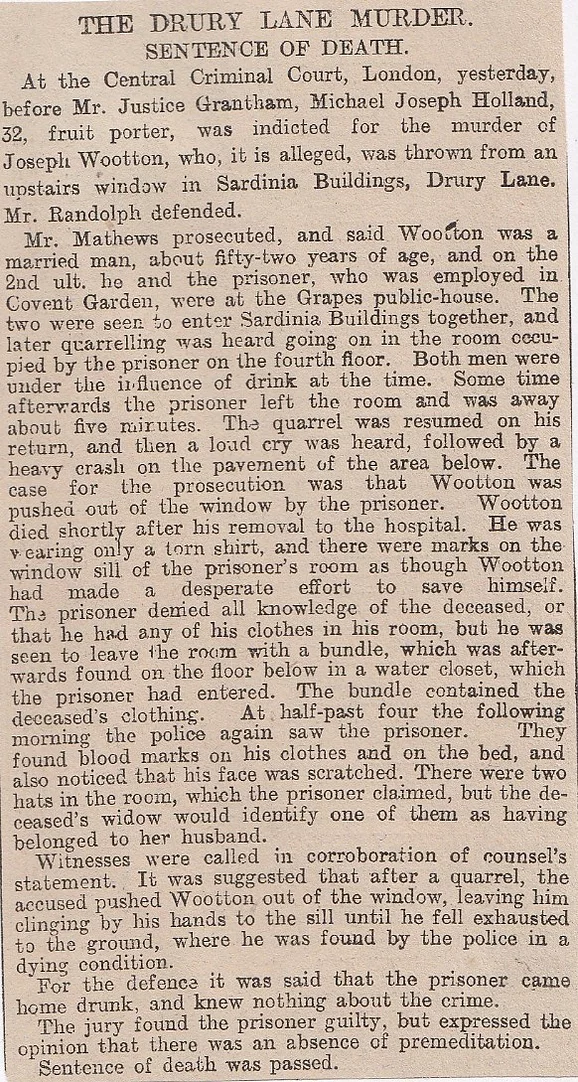
133/ Drury Lane Murder, April 25th, 1899
Joseph Holland, condemned to death at the Old Bailey for the murder of a man named Wootton, by throwing him out of a window near Drury Lane, has presented a petition to the Home Secretary praying for commutation of the sentence. He urged that the occurrence was the outcome of a drunken brawl and that he had no intention of taking life. The execution is fixed for a week today.
134/ Grosvenor Road Station Fatality August 1870 (Just below Victoria Station, near Thames, Grosvenor Road)
135/ Bloomfield Square Fatal Fight July 1870
136/ Regent Circus Omnibus Accident, August 1870
Last evening Mr Bedford held an inquest at St James’s Workhouse, Poland St, on the body of William Arnold, aged 56, for many years the manager to Messrs. Stagg and Mantle, linen-drapers, in Leicester Square. On Sunday evening the deceased, who was in company with his brother, was getting down from the outside of an omnibus at the corner of Regent Circus when his foot slipped on the first step, and he fell headlong and with great violence to the pavement. He was picked up insensible and conveyed to his brother’s residence at 349, Oxford St. when a medical man was sent for. The deceased remained in a semi-conscious state until Tuesday evening last, when he died. Medical evidence suggests he died from a fracture of the skull, a broken right collar-bone, and several fractured ribs, with one of the bones having penetrated the upper part of the lungs. It appeared the omnibus was stationary at the time of the accident. “Accidental Death” was returned.
137/ Millbank Suicide, July 1870 (Millbank- over Vauxhall Bridge, past the MI6 building)
138/ Unknown Woman Drowns in the Thames, July 1870 (Villiers behind Embankment Station)
139/ Embankment Fatal Accident, August 1870 (Next to the Tattershall Castle steamer)
140/ Fatal Accident at Paddington Station, October 1870.
141/ Fitzrovia Murder, November 16th, 1870. (Later on, Edward Searey was tried and the jury gave a verdict of manslaughter and given 10 years penal servitude)
142/ Tufton Street Fire Fatality, December 1870.
143/ Child Murder, Grand Junction Canal, November 1870.
144/ Frozen to Death in Westminster, December 1870.
West Midlands
1/ West Bromwich Murder, April 1859
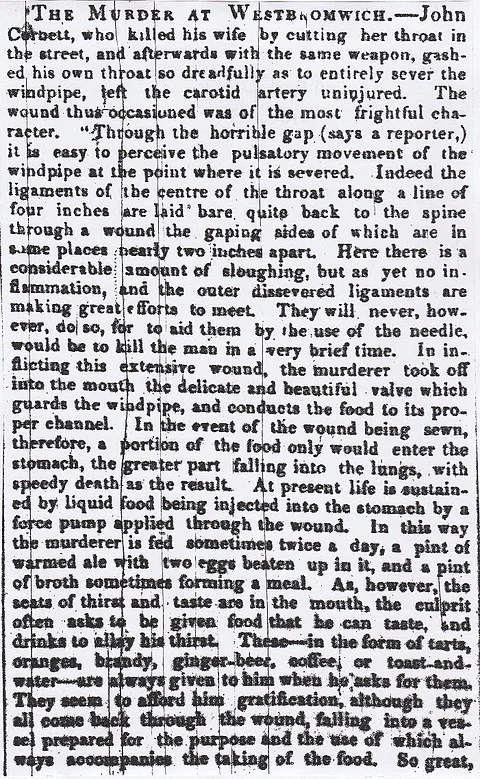
2/ Aston, Birmingham, January 1884 (Body in Room For Twenty Years)
William Owen was a Japanner, who was living hand to mouth in Aston, now a suburb of Birmingham. Authorities were alerted to his situation and when they arrived at the hovel they also found the mummified corpse of his sister. The problem was she’d died in Islington Workhouse in 1863, a full twenty years ago. Her body was in a metallic coffin with a glass panel viewing panel on the lid and all this was in a large iron chest. Islington parish council were going to bury her but he didn’t trust them so he had it brought to Birmingham. Friends and family had no money to chip in to inter the woman properly, so he just kept her in his home. When friends entered his house and saw the chest he just passed it off as having household items in it. He eventually got married as well. (Twenty years? The smell?)
3/ Day’s Concert Hall Fatality, Birmingham, November 1870
The famous “Fritz Brothers” were trapeze artists, and one of the group, Alfred Smith, met with his death at Day’s Concert Hall, Birmingham. Part of the act had gone wrong and he fell onto the ground and died from his injuries.
4/ Canterbury Music Hall Manslaughter, Birmingham, April 1890
The manager of the Canterbury Music Hall in Birmingham was beaten to a pulp by some ruffians whom he refused to give free passes to. He was taken to hospital but died later on, so now police had a murder hunt on. They managed to find out that Alfred Rutter and Agnes Cullies were responsible. (Managers name?)
5/ Wolverhampton Tragedy, February 23rd, 1899
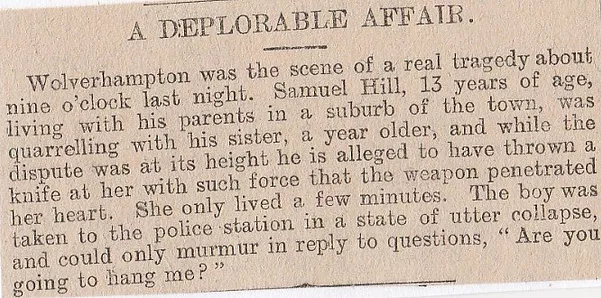
Wolverhampton Tragedy, February 24th, 1899
The 13-year-old youth, Samuel Smith, who killed his sister on the previous night by throwing a knife which penetrated her heart, was placed in the dock on the capital charge. The charge was reduced to manslaughter. The youthful prisoner’s head just reached the top of the dock rail. He was remanded until tomorrow.
Wolverhampton Tragedy, February 28th, 1899
The inquest on the body of Esther Marshand aged fifteen, who was killed on Wednesday by her little brother throwing a knife at her, resulting in a verdict of homicide by misadventure. The two children quarrelled and the girl hurled a fork at the boy who retaliated by throwing a bread-knife, which penetrated her lung. The jury expressed the opinion that the brother had received great provocation.
Wolverhampton Tragedy, March 1899 (Sorry bits missing)
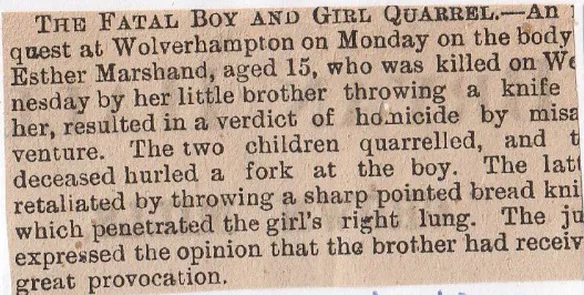
6/ Coventry Suicide, December 1900
7/ Oldbury? August 1889 (Starving a Child)

8/ Birmingham Asylum Murder, December 1858
A religious lunatic at Birmingham Asylum by the name of John Bailsford, killed another inmate at the institution just before Christmas, with the insane object of dipping his hands in the victim’s blood.
9/ Dudley Suicide, May 1899
At Dudley, a man named Aquilla Wallis stood opposite a cemetery (Dudley?) and sliced his throat with a knife, nearly severing his head from his body. Before his suicide, Wallis spent all of his cash.
10/ Birmingham, (Cemetery Suicide), October 1893
Oswald Barber Adams aged forty, the manager of a firm of provision merchants, was seen hanging around the old cemetery for several days. He said he had relatives buried here, then he quietly crept into the chapel basement and took some carbolic acid. He had £40 in cash on his person and when questioned, family and friends said he was given way to mood swings and he was turning into an alcoholic. (What cemetery?/ Is cemetery chapel still there? )
11/ Bournbrook, (Killed at a Football Match) June 1885
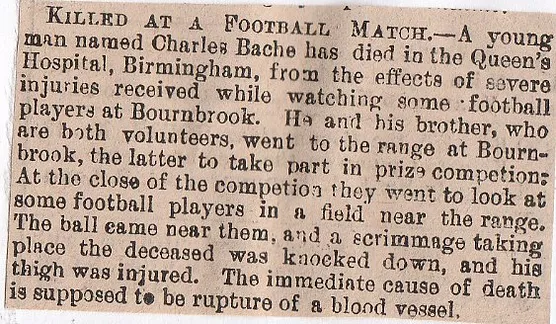
12/ Brierley Hill, Dudley, December 1872 (Wedding Error)

13/ Victoria Park Suicide, Birmingham, July 1897
Charles Bannister, assistant park-keeper at Victoria Park in Birmingham, discovered the dead body of a man hanging from a piece of rope from a tree in the park grounds. It was cut down and sent to Small Heath Mortuary. Police found out that his name was John McDermott aged thirty-nine, a bedstead maker by profession who resided with his missus at 173, Darwin Street. The theory is that he hid in a little-used part of the park and then committed suicide. The body had been there for some time so he must have carried out the deed when the gates were closed for the night. A letter found on his person suggests that the reason for his suicide was down the female of the species, and how he had been wronged by this woman. (His wife?)
14/ Sedgley Ice-Skating Tragedy, January 1885
An inquest at Sedgley respecting the death of James Hyde, stonemason. The deceased was skating with twenty others on New Pool, the previous day, and was precipitated into the water through the breaking of the ice and drowned. A verdict of accidental death was returned.
15/ Princes End Murder, Tipton, June 1859 (In 1859 it was in South Staffs)
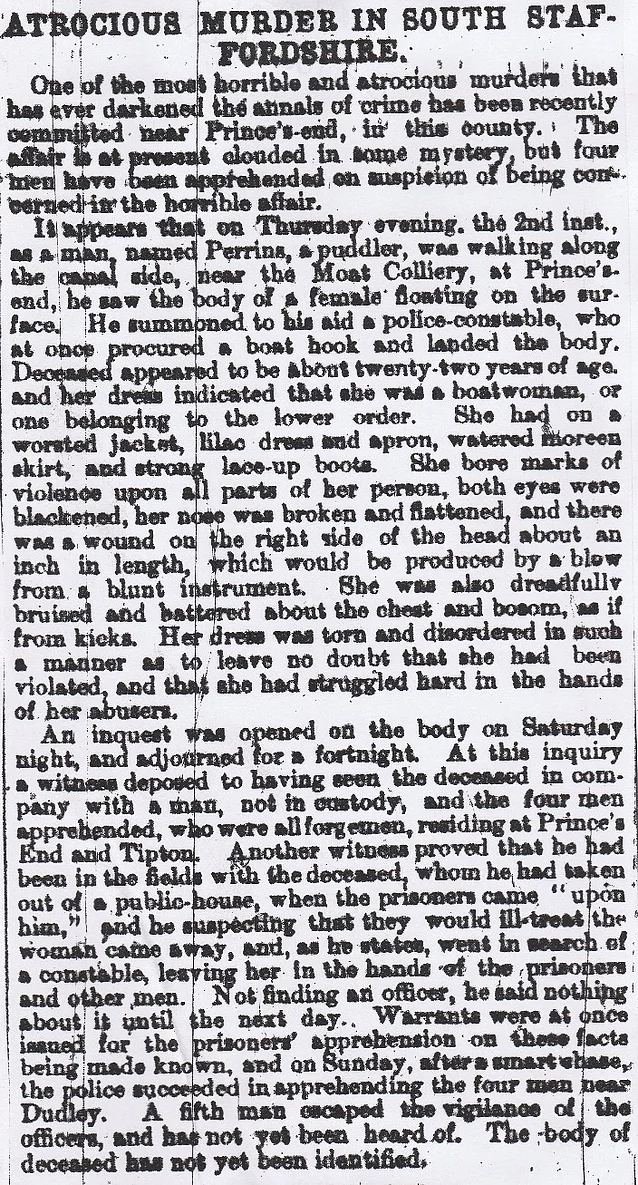
16/ New Street Station, Birmingham, April 1898 (Child Thrown in front of Train)
The 10-15 trundled into New Street Station when William Greaves Edwards picked up his 9-year-old daughter and threw her in front of the train. The London jeweller was arrested straight away and medical attention was given to the child. She lost both arms and one of her legs. He had come to Birmingham to visit the child as she lived there with her Mum, but when asked why he did it, he replied: “I don’t know what made me do it”. The girl is in a dangerous condition and may not survive the ordeal and if she dies, he will be charged with murder and not attempted murder as it stands. (Did she die?)
17/ Birmingham New Street Suicide, October 1875
45-year-old Reuben Roe decided to meet his maker and shoot himself at New Street Railway Station in Birmingham. He had been to his brother’s house with his family, and they pointed out to each other about his strange behaviour. His brother took him out for a stroll at about seven p.m..and they went into the station and while his brother stayed behind for a minute, Rueben shot himself in the chest. A card was found on him, saying: “I have done wrong. God have mercy upon my poor wife and children”.
18/ Bull Ring, Birmingham, June 1889

19/ Coventry, (Baker Bakes Himself to Death) December 1899
Frank Morris a master baker from Coventry, decided on suicide, but he only had to utilise what was at his disposal, so he popped himself into one of his ovens in his bakery. Nobody could find him after the dinner break and when one of the lads went to put some water in an oven, he saw his boss’s body in there. He had literally baked himself to death as the door was locked on the inside, and obviously, the body was extremely charred.
20/ Messrs Joyce and Son, Birmingham, October 1907
A labourer by the name of Benjamin Palmer was accidentally caught in the spokes of a fly-wheel of a new engine and was crushed to a pulp, at the works of Messrs Joyce and Son in Sparkbrook, Birmingham, who made steel tubing.
21/ Wolverhampton Child Remains, April 1887
Two labourers at work in an old colliery came across the remains of a human arm which was found sticking out of the ground. They exhumed the rest of the corpse and found it was a young girl, and it was badly decomposed and it’s left arm was missing. Police surgeons examined the body and came to the conclusion that she was no more than a year old when she was killed. Now police are treating this as child murder. (What colliery?)
22/ Christ Church, Birmingham, February 1899

23/ Birmingham Cemetery Suicide, February 1904
Harry Lea, a chemist at Witton, poisoned himself in the city cemetery but left a strange suicide note in the post, sent to his daughter. Firstly, he got her to leave her job, saying that he had £14,000 coming his way, then left this letter:
“When you read this, and see how cruelly I have deceived you, you will say I have deserved the fate of death. Sooner than meet you and Harry, who, God knows, I love too well, I have decided to leave this earth. I cannot face you or Mr Littler, who is a man of honour, and who I have disgraced by my deception. But I have myself been misled. I did think that I had come into some wealth and property until I went over to Ellesmere this week. At the same time, I had no business to have kept such deception up so long. Oh, Maggie, try to forget your father, who has loved you sincerely. May God in Heaven look down on you and preserve you from evil.” – The gravedigger told how Lea prayed in a loud voice and kept kissing a photo, the verdict was not unsurprisingly “Suicide whilst temporarily insane.”
24/ Wednesbury, (Fatal Argument) October 1896
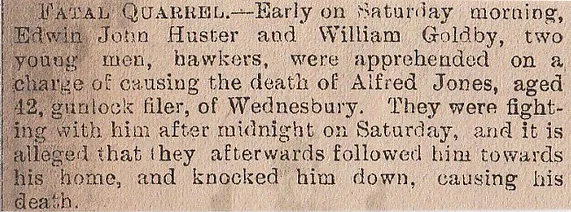
25/ Windmill-End Station Suicide, near Rowley Regis, March 1887
A sixteen-year-old butcher’s assistant named Heaton Pearce was discovered on the train tracks near Windmill-End Station, dead as a dodo. He sent his Mum and Dad the following letter:
“Dear Parents. I write this letter to you under very painful circumstances. I had to leave my place yesterday morning, for using bad language, and I lost my character. I was afraid to come here, so I thought I would write to you and make away with myself because I am ashamed of myself”. The engine-driver said that human flesh and blood was found under the coal-box, and P.C. Salt said that he had been fired from his job in West Bromwich.
26/ Birmingham, May 1901 (Thirty-One Infants Found)
Early one morning police visited a widow who also ran an undertaker’s. They discovered the remains of thirty-one dead infants, all in various stages of decomposition. They were in common or garden soapboxes and should have been interred long ago. They were removed to the Mortuary to await a proper burial and its thought she took the money for burying them, but just kept it and left them there.
27/ Dudley Canal Drownings, August 1890

28/ Walsall, September 1874 (Mob at a Funeral)
Mrs Sadler committed suicide and her funeral was to be on Saturday, but when hundreds of mourners turned up to his house, the White Hart at Caldmore, the gossiping women and the men thinking that she killed herself because of him, they were all baying for blood. The inquest of her suicide was adjourned or incomplete, so the crowd put two and two together and got five. This was mob rule at a funeral and seeing the crowd were after him he decided not to be in the cortege. When he wasn’t seen in the cortege the crowd went looking for him, hoping that there would be “some fun”. The vicar managed to calm things down to some extent and he pleaded with them to abandon the drink. Eventually, she was buried and a wreath placed on the coffin. (What happened afterwards?)
29/ Walsall – 1870 White Hart Inn, Caldmore Green, (See Above)
A mate of mine read about the White Hart in the Readers Digest book of British Myths and Legends, and it reads:-
In 1870 the mummified arm of an infant and a Cromwellian sword were found in the attic of the White Hart at Caldmore Green. The arm, thought to be a relic of witchcraft, became known, incorrectly, as the “Hand of Glory”. Both the arm and the sword became associated with the ghost of a girl who killed herself in the inn about a century before. The landlord has reported strange happenings at the inn, in the last twenty years. A handprint would appear in the dust on a table in the attic, though impossible for anyone to get up there, while the manager spoke of phantom footsteps bumping across the attic floor.
30/ Canal Co.Reservoir, Titford, July 1889

31/ Tividale Murder, July 1902
Two men named Shakespeare and Richards were on their home when they stumbled upon the blood-soaked body of a woman, her head was nearly severed from her body. Just a few yards away they spotted a man with blood on his hands. When they asked him his name he replied “William Lane”, and told them he was an ex-policeman and had slit her throat with a shoemaker’s knife. They took him to police at Rowley and he was charged with the wilful murder of Elizabeth Doson, a woman who he co-habited with. He told police “I have killed her, and have contemplated it for some time”.
32/ Dudley, February 1876 (Romantic Suicide)
Frederick Hooker was a chemist from Kingswinford near Dudley, and he killed himself through grief from the loss of his wife. She died on a Sunday, and when he went to see the sexton about the grave he specified that he wanted one big enough for two people. Hooker then went home and poisoned himself with prussic acid. (What cemetery is Hooker in?)
33/ Darlaston Drowning, June 1899

34/ Wolverhampton Incest, June 1878
Nuneaton labourer, Thomas Harbour, was charged with having sex with his wife’s illegitimate daughter who was aged just fifteen, and even more weird was that she stated that she had had sex with four other blokes, one of them was her natural father!
35/ Wednesfield (Wolverhampton), February 1874
An inquest on the body of Lemontinia Smith, who was found dead in a gipsy camp, was resumed at the Summerhouse Inn in Wood Hayes. Evidence was put forward that the man with whom she cohabited, a man named Lovell, used to beat her up on a regular basis. She committed suicide by taking strychnine and had done it to escape the treatment that Lovell would dish out. She also had a lot of vermin powder in her possession.
36/ Birmingham Suicide, October 1897
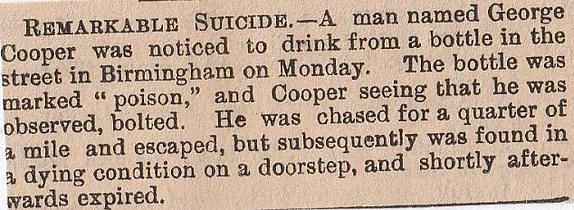
37/ Birmingham Canal, Wolverhampton, November 1899 (Infanticide/Suicide)
The body of Catherine Phillips aged thirty-three and also that of her infant child were found in the Birmingham Canal at Wolverhampton. She went out on Sunday night saying she was off to see her mother and she was taking the little one with her. A couple of days later their bodies were found. Phillips had been suffering from terrible migraines and headaches recently, whether that was the cause is unknown.
38/ Berkeswell Rectory Skeleton, February 1866
Some workmen were taking up a hearthstone in the servant’s hall at Berkeswell Rectory when they uncovered a human skeleton. It was full sized and laid face side downwards with its arms behind its back. They were about four feet from the fire-grate and had other skull fragments were nearby. The bones were decayed and as soon as they came into contact with the air and daylight, most of them crumbled to dust. (Who or what were they?)
39/ Tipton, (Corpse Discovered) April 1896
After a gas leak at the Park Lane Wesleyan School in Tipton, two workmen crawled between the ceiling and the roof and found the lifeless corpse of William Sheldon. He was a caretaker at the Wesleyan Chapel which was next to it and had vanished about three months ago. It was terribly decomposed and it is believed that he killed himself, but in what way he carried it out is unsure.
40/ Tipton, March 1892 (Victorian Football Hooliganism)
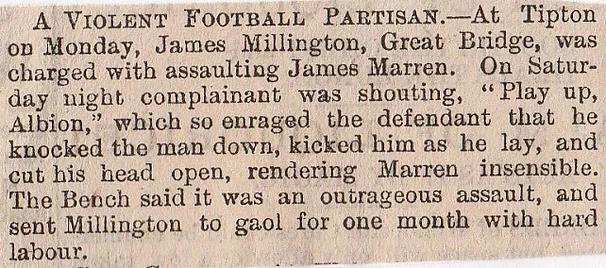
41/ Moxley/Wednesbury, January 1885 (Ice-skating Fatalities)
Two girls named Henry and Hanson were skating yesterday on a sheet of ice between Moxley and Wednesbury when the ice cracked, and before they could escape, they fell into the water, ten feet deep. Their bodies were not discovered until about an hour afterwards.
42/ Darlaston, January 1885
Two girls named Lydia Owen and Martha Wetton, each sixteen-years-of-age, residing at Darlaston and employed at a factory in the neighbourhood, went on Wednesday night to skate. Whilst they were moving about hand in hand together, the ice gave way and both girls were drowned.
43/ West Bromwich, January 1885
David and Archibald Hill, aged six and nine years respectively, were drowned yesterday while sliding on a pond at West Bromwich.
44/ Foleshill Tram Fatality, April 1885
Henry Gilbert, seventy-three years old, was knocked down and killed at Foleshill near Coventry on Wednesday night, by a tram engine running between Bedworth and Coventry.
45/ Spring Vale Ironworks Deaths, Wolverhampton, August 1889
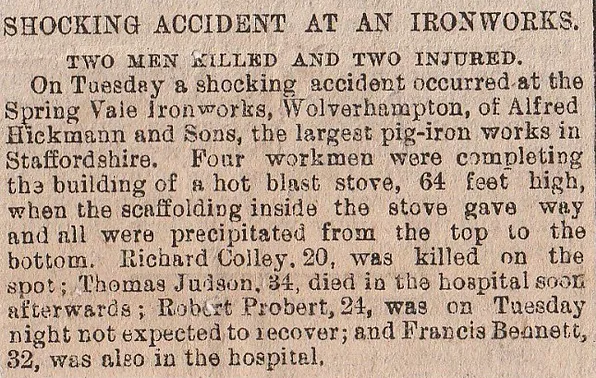
46/ Knowle Hall Double Suicide, (Solihull) May 1865
Mrs Eliza Prentice walked into a police-station at Moor Street and asked them to look for her eighteen-year-old daughter, also called Eliza Prentice, as someone had found a note under a stone and given it to her as it had her name and address on it. It was left on the road leading to Knowle Hall where she worked, along with another girl named Mary Ann Phillips. They seem to have had a disagreement with their mistress and were not to be found at Knowle Hall the next morning. The letter read as follows:-
“We have gone into the water, goodbye. We shall never see you any more. You will see the grave where I die, you will find them now see the grave where I die. You do find them now my life is past. My love to you so long I did last though I know you took his body and loved him for my sake, dated the 2nd of May. The misses called for all the devils and rogues out of the room. She is a bad one, but she has no cause for it. Goodnight. God Bless you dear Edward and to John, and the Devil take the rest for these are the only two we love. We are in the Springfield pools, we will swim to the middle of the pool and there we will stay, and I hope the Misses Moore lies she will go to the Devil in Hell. MARY ANN PHILLIPS and ELIZA PRENTICE”. She thought that the two had drowned themselves but the police told her to go the local police station and they would make a search.
Knowle Hall- Kenilworth Road/Springfield Pools (Springfield Farm on Cuttlepool Lane?) (Did they find them?)
47/ Tipton, (Fatal Accident) August 1885
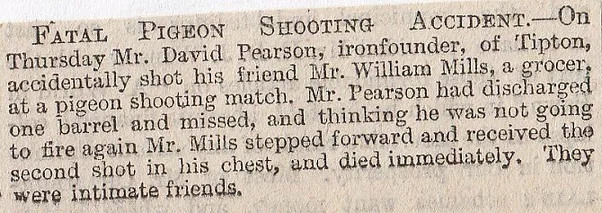
48/ Great Hampton Row, Birmingham, September 1868 (Human Remains)
Some council workmen were digging a new sewer at Great Hampton Row when they came upon the remains of a human in a coffin. It was several feet down and the following explanation is the probable one. A few days before the digging up of the coffin an old man told workmen while passing, that they were not to be surprised if they came across a coffin with a body in it as half a century ago, a man who hanged himself was buried at the crossroads which were there and was known locally as “Hangman’s Lane”. Another scenario was that sixty odd years ago, a bloke murdered his missus in Weaman Street in “Cut-throat Passage” and that when he was hanged for the murder, then he was buried at the place known as “The Four Crossings”.
49/ West Bromwich, (Child Murder/Suicide) September 1882
Thomas Jutson was walking past the Birmingham Canal at West Bromwich at 6-20 a.m. one morning when he spotted the body of a 15-month-old girl floating in it. He got the police to intervene and they searched the canal. About an hour and a half later a woman’s body was discovered about a hundred yards from the baby. She was approximately twenty-five to thirty years old, five feet two inches, light hair, black dress and a white apron on. She also had a gold wedding ring on and the kiddie was dressed in a black velvet coat and cape. They’d been there a few hours at most.(Who were they?)
50/ Dudley, July 1895 (Cricket Death)
Samuel Bunn a licensed victualler, died at Dudley on Saturday from the effects of injuries received through being struck by a cricket ball on July the 8th, while watching the match.
Waterloo Street Suicide, Birmingham, March 1895

51/ Bilston Infanticide, August 1885
At Bilston yesterday, Sarah Betsy Hill a single woman aged eighteen was charged with the wilful murder of her newly-born illegitimate child. The child was found at the back of the house where the prisoner lived, and medical evidence showed that it had died from suffocation. The prisoner said its death was accidental. She was committed for trial.
52/ Coventry Canal Suicide, August 1877
The dead body of James Craney was found standing up in the canal near to the cotton factory at Coventry. When he was fished out it was found that his hands and feet were tied together, while the head was cut. Neighbours had noticed his behaviour had got a little strange recently and occasionally he wandered about for an entire night.
53/ The Council House Fatality, Birmingham, November 1885
As His Royal Highness was about to leave the Council House, Mr R.D.Bennett, of Edgbaston, J.P., director of the Birmingham Joint Stock Bank, met with a fatal accident by falling through a sheet of glass in the floor on the floor of the corridor onto the pavement fifty feet below. He was killed on the spot and was fifty-seven years of age.
54/ Wolverhampton, March 1890

55/ King’s Norton, Birmingham, March 1892 (Teacher Suicide)
The body of Amy Bakewell, a twenty-year-old teacher who worked for the Birmingham School Board, was discovered in the reservoir at King’s Norton near Birmingham. It is being treated as a suicide. It is the second such case of a lady teacher killing herself in the past week, as another young lady teacher committed suicide in a pool in one of the public parks in the city. She also was employed by the Birmingham School Board.
56/ Wolverhampton Child Murder, June 1885
At Wolverhampton yesterday a coroner’s jury resumed an inquiry as to the death of Edith Jones only four years of age, who was last week found drowned in the canal with her mother, Ann Jones, being at the same time found in the water in an exhausted condition. The woman died on Sunday. The jury returned a verdict of wilful murder against her.
57/ Workhouse Lane, Tipton, September 1885 (Burned to Death)
An old woman named Sarah Cole was found burned to death in a house in Workhouse Lane, Tipton, yesterday. The old woman was dropsical and being unable to get upstairs, a bed was made for her in the kitchen. Yesterday morning she was found dead, her body presenting a shocking appearance. The bed was also destroyed. It is supposed that the bed clothing became ignited by the kitchen fire.
58/ Birmingham, July 1889 (Held Head in Molten Metal)

59/ Dudley, February 1878 (Castle Mill)
The half consumed body of an unknown man was discovered in a lime-kiln at Castle Mill, the property of the Earl of Dudley. The face showed signs of suffocation and when moved the legs dropped off the body. Apparently, he is a local man, but that just guesswork at the moment. (Who was he?)
60/ Smethwick, (Body at House-viewing) February 1895
One afternoon in Smethwick, a couple were looking over a house when they came across a dead body of a man in one of the rooms. He was about forty-ish, five feet five tall, brown hair, sandy moustache, and had a tooth missing. The house had been unoccupied for some time and it is presumed that he took shelter from the weather and was frozen to death. Police do not suspect foul play, put it down to natural causes.
61/ Birmingham Constable Murder, March 1898
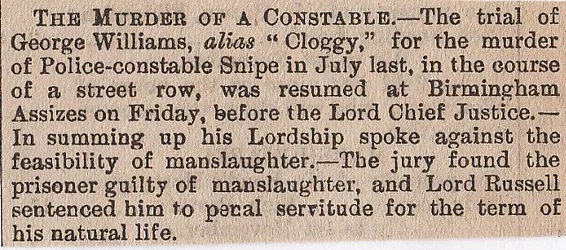
The twenty-year-old Williams threw a brick a the officer and killed him accidentally.
62/ Walsall Railway Station Death, October 1885
Yesterday morning Mr William Thomas, formerly a solicitor in practice in Walsall and at one time the mayor of that borough, was walking over a level-crossing at the Walsall Railway Station when he was knocked down by a train that was entering the station and was killed instantly.
63/ Birmingham Pub Manslaughter, October 1885
A young man named Marney was remanded yesterday at Birmingham charged with causing the death of Thomas McGuire. The men quarrelled in a public-house on the previous night and Marney threw a glass which struck him in the neck, cutting the jugular vein and causing him to bleed to death. (What pub was it?)
64/ Coventry, (Frightened to Death) July 1889
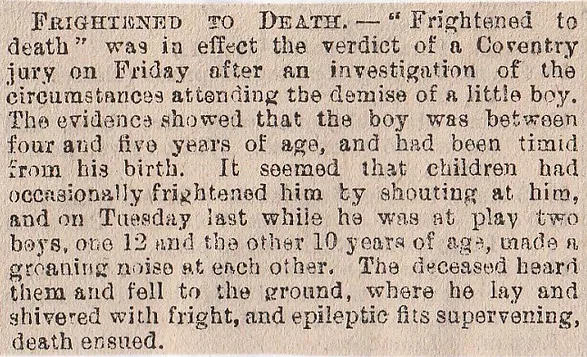
65/ Oldbury Suicide Pact, July 1889
21-year-old Joseph Harvey, who was a brickyard labourer and lived at 2, Titford Road, Oldbury, along with Elizabeth Bates aged twenty, living at 56, Eel Street, Oldbury, have been found dead in the canal near Titford Pool, with all the signs suggest it was some kind of suicide pact between the two. Enoch Hadley was walking along the canal side when he spotted a couple of hats laid near the edge. He contacted police, and when they dragged the canal they found the two of them tied together with a cord. It went around the bodies several times and the knot position seems to point to the girl had tied it. Harvey’s watch had stopped at 2-20 and despite seeing each other for three years, his Dad objected to them being a couple. A letter was found saying that they did this on purpose and because of family grievance’s they wanted to go together.
66/ Gibbet Wood Suicide, Stourbridge, October 1882
The body of an old woman was discovered in Gibbet Wood, a couple of miles from Stourbridge. Three men, David Fletcher, Edwin Highway and Frederick Bent, found the remains while going through the woods. Her undergarment was pulled over her chest and her hat and skirt were a few yards away, but despite this, there were no signs of a struggle. Deceased had three rings on her left hand and a shilling next to her, She has laid in the woods for about a week.
67/ Bilston, Wolverhampton, July 1885
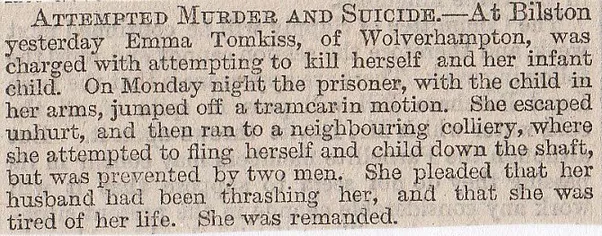
68/ Commercial Street, Birmingham, September 1892 (Head Squashed in Press)
A press-worker named George Sutton aged thirty-five killed himself in a horrible manner at Messrs Wynn, steel stampers in Commercial Street. Some workmen who were about to start work on a Saturday morning found Sutton, who had stayed behind from the previous night. He had put his head under one of the presses, which weigh about four hundredweight, released the hammer which descends at about one ton of pressure and let the machine squash his skull to smithereens. He had taken to drink recently as his he had only become a part-time employee at the works.
69/ Aston Train Death, Birmingham, September 1892
Some lads were playing in Aston New Town when a train came in to view. They all got out of the way except eight-year-old Alfred Faulkes, who was struck with fear and became the proverbial rabbit in the headlights and the train ploughed into the poor lad, decapitating him and badly mangling his frail body.
70/ Birmingham Manslaughter, April 1892
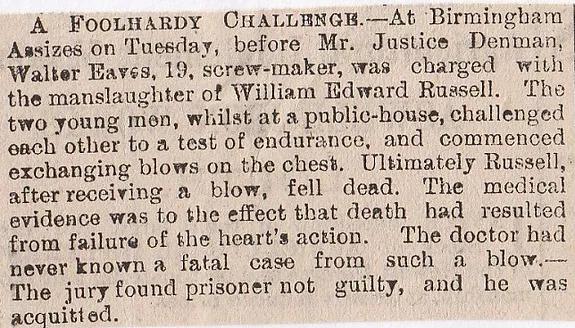
71/ Coventry, (Suicide in front of Wife) December 1887
This is a f****d up way to end your days! George Moss, a watch finisher aged thirty-nine, called his missus into his workshop in Hood Street and announced to her that he wanted to die. She passed it off as him feeling sorry for himself and told him not to talk like that. With those words, he pulled out a revolver and put it to his forehead and blew his head off. His wife is in severe shock and has managed to tell police that Moss had been ill for quite a while, but never showed suicidal tendencies.
72/ Tyburn, Birmingham, March 1887 (Decapitated Baby)
At Tyburn, three miles from Birmingham, a boat was chugging along the canal, when it struck a large parcel. They pulled it to the surface and discovered it was the remains of a three-month-old child. Its head and limbs had been chopped off and the doctor who did the post-mortem on the trunk of the baby said it had been cut to bits with a sharp knife, possibly a scalpel. Police are dragging the rest of the canal to try and find the limbs or head.
73/ Bordesley, (Man Buried Alive) August 1892
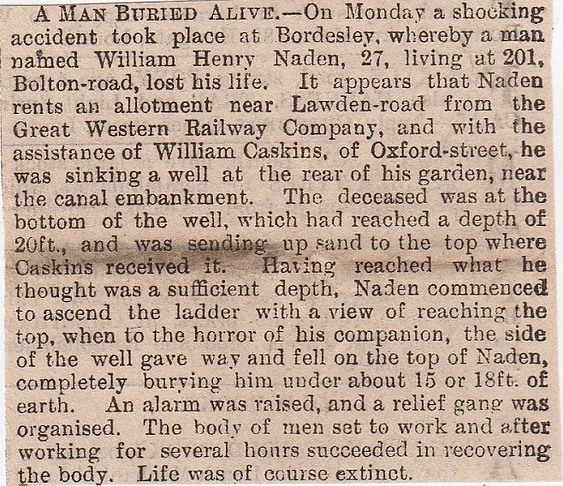
74/ Halesowen, (Child Burns to Death) July 1897
Thomas Ray aged thirteen was found deceased in horrific circumstances. At eight p.m. Saturday he was sent out on an errand but wasn’t found again till a search party discovered his smouldering remains on a heap of coal dust near the ovens at Witley Pits, Halesowen. The limbs were burned off and the rest of him was burnt to a cinder. A post-mortem found his intestines were completely destroyed and his bones were calcined. On asked to identify the body of his son, the father only made him out due to a small patch of hair on the top of the head which resembled his son’s. How he got there is a mystery, but it could be that he laid down on the ashes for warmth, then noxious gases made him unconscious and then he was slowly burnt to death. A case similar to this happened to a tramp who slept near a lime-kiln and had his feet burned off, and did not realise until he got up to leave.
75/ Queen’s Hotel Suicide, Wolverhampton March 1885
A young woman was found dead in her bedroom at the Queen’s Hotel in Wolverhampton and it is feared that it was an act of self-destruction. When the body was being removed, a laudanum bottle fell on to the floor. She has been identified as Adelaide Perks, a servant who was fired from her job on Monday.
76/ Birmingham Canal Suicide, Halesowen, December 1885
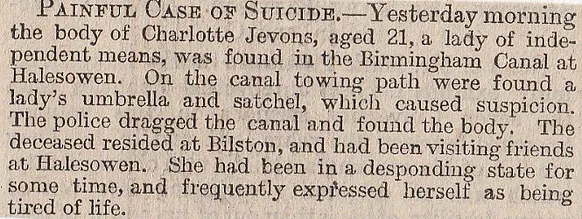
77/ Wolverhampton Murder, December 1902
A woman’s body was found on the tow-path on the canal at Wolverhampton and judging by the looks of the corpse, she had been kicked and battered to death. She was raped first, then beaten and left face down in the mud. She wasn’t smartly dressed, so chances are she was from the lower classes. Another strange thing was that she had her legs tied together.
—A few days afterwards she was identified as Jane Daley, a thirty-year-old housewife.
78/ Arthur Street, Birmingham, June 1899 (Child Corpses in Cellar)
A foul smell was emanating from the cellar at a house in Arthur Street in Birmingham. When found, it was discovered it was the rotting remains of nine children, with each one in a soapbox carefully enveloped in padding. The woman who used to reside there, named Bowen, is now in a critical condition at the Workhouse Infirmary and hardly any information can be gleaned from her. Mrs Bowen was a midwife to the poor people of the area and her two sons said they never ventured into the cellar until Monday night when the bodies were found. Bowen left the house a week or two ago.
79/ Birmingham Canal Suicide, Wolverhampton, December 1885
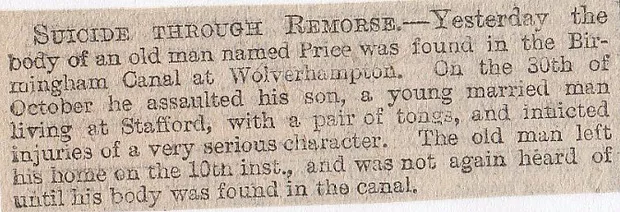
80/ Brierley Hill, June 1900 (Death by Dynamite)
John Jackson, the publican at the Brockmoor House in Brierley Hill, killed himself in an extraordinary manner. A loud explosion was heard in the top half of the house, with a window in one the rooms shattering and on inspection, it was found like a scene from a horror movie. Jackson had put some dynamite in his shirt and lit the fuse and the result was that tiny little portions of flesh and his innards covered in blood, were on the ceiling and walls. Jackson had some financial difficulties and the fact that some mining operations had caused his house to become unsafe; he had forty poles holding it together.
81/ Church Lane, Aston, August 1904 (Child Remains)
An awful discovery was made at 190, Church Lane, Aston, when D.I.Jackson and D.S. Whitcroft went to check the rancid odour coming from the back of the premises. In a rainwater cistern, they found the carcass of a female child, which had supposedly had been put there eleven months ago. Despite the terrible condition of the body, they narrowed it down and later arrested Eleanor Baker, a married woman who had been separated from her husband.
83/ Birmingham Attempted Murder, February 1895

84/ Rowley Regis, Dudley, April 1859 (Tree Falls on Boy)
Twelve-year-old Thomas Baker met with a terrible accident at the premises of Mr Lees, a farmer from Cogg Green in Rowley Regis. Some men were chopping down trees when they nearly cut through one tree, they left it to get some rope to tie around it and pull it over in a particular direction. While they were gone, young Baker, who had been watching them while leaning against a wall, when suddenly the tree collapsed and smashed the poor boy to atoms.
85/ Spedwell Road Suicide, Edgbaston, October 1856
This a sorry story of a young domestic servant named Elizabeth Barton who was employed by Charles Smith at Spedwell Road in Edgbaston, who killed herself by drowning in a water cistern at the back of the house. She became distressed when she heard that her ex-boyfriend, with whom she had a child, had got married to someone else. Barton had been seeing him for six years, then he left and then returned to take the child of theirs to London. All these things accumulated as pressure on her mind, so she ended it all by drowning.
86/ Wolverhampton Skeletons, May 1881
Under the flooring of a cellar in Wolverhampton, the remains of an elderly man and a young person were discovered. The man’s skull was fractured and the younger skeletons skull had been cut down the middle. Both were buried in lime and neither skeleton was complete. The house was being cleared as part of a condemned area and used to be a marine store dealers, but both remain unidentified as of now. (Were they Identified?)
87/ Sugar Loaf Farm Shooting, Stourbridge, October 1885
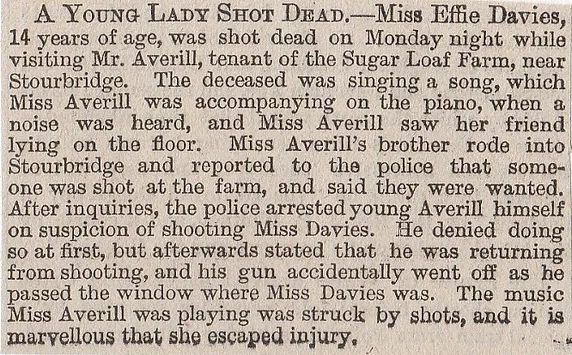
88/ Kings Norton, June 1897 (Suicide Writes own Epitaph)
A chap named Frederick Barton was wandering through a field at Broveley near Kings Norton, when he noticed a man sat upright and apparently asleep. When he got to the body, the head was nearly severed from the neck and his right hand had a razor in it. Police were called to the scene and the body was of a man aged 35, light tanned jacket, dark trousers, black hat, silk umbrella and a silver watch on a brass chain. He was about five feet seven inches tall, brown hair brown sideburns and moustache. In his pockets was a fiver plus other change and oddments and a notebook with the following epitaph:-
Here lies the body of W.W., Who no longer will trouble you, trouble you, Where he has gone, and how he fares, Nobody knows and nobody cares. Signed-Walcot.”
89/ Birmingham Teenage Suicide, April 1891
George Herbert Monk was a fifteen-year-old suicide victim. No wonder, when his mother pawned his best overcoat for cash and then his best clothes went to them as well; he got so distressed by it all, he hung himself in his bedroom. On the day of his destruction, he gave his younger brother a ball as a keepsake of him and told him he’d be out of his misery soon. Next to the body was an open Bible.
90/ Wolverhampton, May 1876 (Skeletal Remains of Kids)
One evening a man named Carey had a row with his missus and when police intervened, she demanded that he be arrested. She got down from a shelf, a parcel with bloodstains on it, and when opened it was found to contain the skulls and leg bones of two children. The post-mortem revealed that one frontal bone (forehead section of the skull) was fractured. Mrs Carey stated that she had sixteen kids and she can account for nine at the time of writing.
91/ Rowley Regis Station Fatality, December 1885
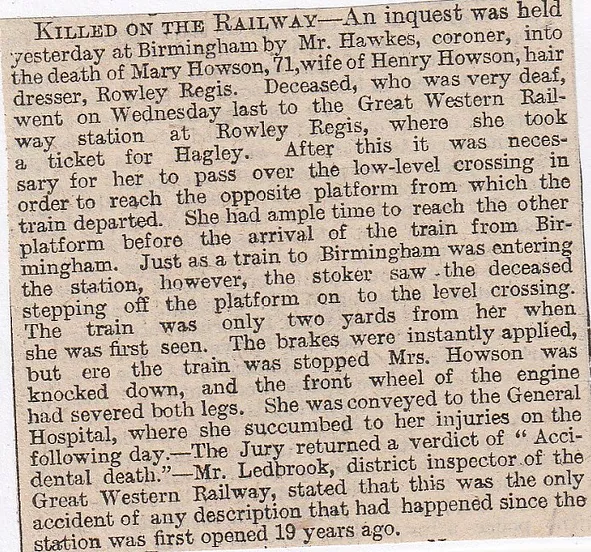
92/ West Bromwich Bride Suicide, June 1888
A twenty-year-old lass named Phillips killed herself at West Bromwich. She had been seeing a chap named Scott for around three months and they were to be wed this week. Tragically she was stood at the altar for over two hours and he never showed. He had suddenly got cold feet and totally disappeared from the town. She went home “heartbroken” and poisoned herself with laudanum and died that night.
93/ Dudley Road, Birmingham, September 1898
Police went to a house on Dudley Road to arrest William Woodhead on a charge of stealing coffin furniture. An awful stench forced police to search the premises and the result was the dead bodies of six children. Woodhead had been given the bodies to be buried and taken the money but left them to decompose.
94/ Birmingham Canal (Filicide/Suicide), Wolverhampton, September 1909
The tiny body of a baby girl was discovered in the Birmingham Canal, dressed in her night clothes. She was identified as fourteen-month-old May Screen, an iron-workers daughter from Bradley near Wolverhampton. Further dragging of the canal brought the mother to the surface. She had left home in the night and picked her daughter from her cot and walked to the canal, then jumped in, killing them both.
95/ Birmingham Murder, February 27th, 1885
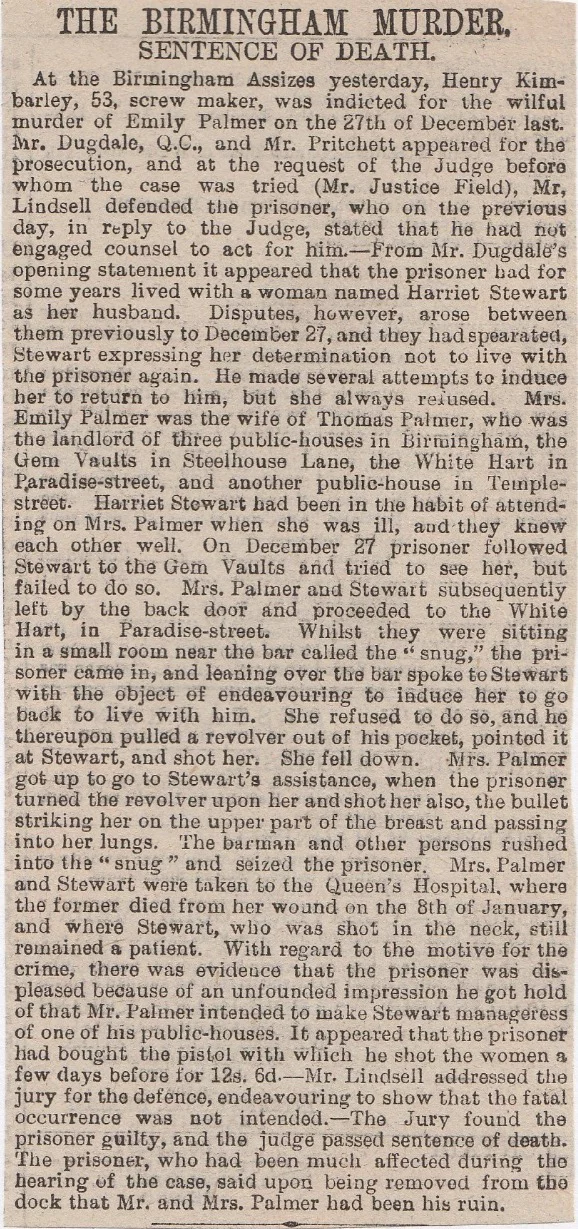
Birmingham Murder, March 18th, 1885
At Winson Green Prison yesterday morning, Henry Kimberley was hanged for the murder of Mrs Palmer in Birmingham last December. Berry was the executioner and did his work most expeditiously.
96/ Park Lane Triple Murder, Aston, Birmingham, December 1910
A triple tragedy took place at the home of William Pope, who resided at Park Lane, Aston. A daughter of Pope’s landlord called in for the rent but saw Pope sat in a chair with a huge gash along his throat. Police forced entry and found the man dead. His wife was also lying dead near the hearth and the two kids, a four-year-old girl and a boy of eighteen months, were laid out on the table with their throats cut. Furniture was overturned, ornaments and vases on the floor which suggest there was a great struggle before they met their maker. Rigor-mortis results showed they had been dead for around twelve hours or so, and the kids in their nightclothes, it seems he got them out of bed to kill them. A letter addressed to the coroner said: “Let no man think I am insane”. Also added was a sentence saying that he wanted to kill himself, but couldn’t bear to leave his wife and kids behind. The wife had put up one hell of a fight against her husband and despite the twenty-seven-year-old Pope having a good job and marriage, he wiped out his family in a supreme act of selfishness.
97/ Bilston Witch Hunt, August 1859
A disgusting event took place at Highfields near Bilston. An old lady named Poll Powis lived in a cottage in Spring Vale and she was locally known as the Spring Vale Witch. This is how Matthew Hopkins became the Witchfinder General in 17th century East Anglia, through the locals victimising an old woman of the village who lived alone and no relatives to visit and of slightly eccentric habits. They were deemed to be witches and drowned or hung in public. ( Burned is the popular misconception). Powis was seen near the canal one day when she suddenly leapt into the water from the bridge. She was rescued by some boatmen on the canal, then it states she was “exhibited in a most beastly way”. A gentleman appeared and put a stop to their antics, but poor old Poll died a short while after and when examined, her body was painfully thin and under-nourished. What the men did to her, God only knows.
98/ Dad’s Lane Suicide, Highbury, Kings Heath, December 1897
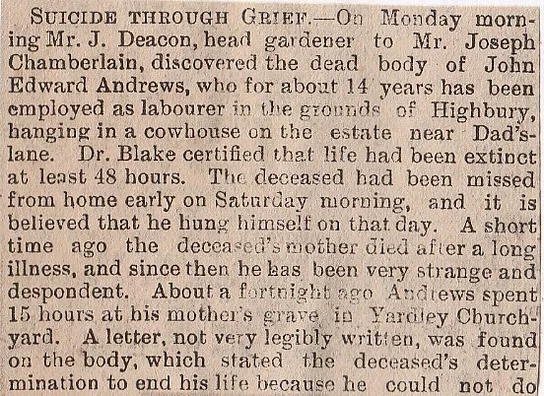
without his mother to whom he was very much attached. The deceased was thirty-eight-years of age.
99/ Snow Hill Station Suicide, December 1908
This one is so common in Victorian England it defies belief. A man was on the platform at Snow Hill Station in Birmingham, when he flung his arms up and jumped in front of an approaching train. The engine and coaches trundled over the body and cut him in half. His sister identified him as William Raymond, a thirty-one-year-old actor from Kidderminster. The sister had gone to ask about the luggage when William went to the other platform and performed his final act. The two of them had been at the Kings Hall in Birmingham rehearsing a pantomime and now she was on her own, as the mother died three months ago.
100/ Snow Hill Station, (Child in Box) January 1896
A square-shaped parcel lay unclaimed at Snow Hill parcel office, so officials contacted police. When unwrapped, it was found to contain the corpse of a newly born baby boy. He was dressed and was put in a little box with a small piece of cloth over his face. Every conceivable effort was made to prevent identification of the child and where he came from. It was addressed to “Miss Jones, Market Square, Birmingham, to be left till called for”. There is no railway mark on it so it was put among the luggage secretly by the mother and then she left the station. It has been dead at least a week or so.
101/ Blews Street, Birmingham, March 1893 (Steam-roller Suicide)
At 4-40 one afternoon, a council steam-roller was on it’s way down Blews Street to the wharf, when a man jumped in front of it and laid down. The driver managed to stop the hulking great mass of metal from going over him entirely but it did partially run over him. It rested on his chest and he was quickly dragged from under the roller and taken to the General Hospital. His injuries were so severe that he died a couple of hours after being brought in. The rib-cage was smashed in and his arm flattened. One witness said he had been walking alongside the steam-roller for quite a distance, checking it out before he dived in front of it.
102/ Lancaster Street, Birmingham, June 1895 (Acrobat Suicide)

103/ Lye Station Suicide, near Stourbridge, July 1871
A shocking suicide occurred at Lye Station near Stourbridge, and there are circumstances with this one which link them with three others of the same family who have died mysteriously in a week or two. Two children were killed at Lye Station in a dreadful accident, then their cousin Arthur Wooldridge, drowned a few days later while taking a dip in the water. Then there was this one. Twenty-two-year-old George Wooldridge, who had been seeing a girl but they had a disagreement in Stourbridge one evening. He got in a cab and asked to go to his father’s house, but stopped the cab near Lye Station and ran towards the tracks. The following day his headless corpse was discovered by the side of the tracks. He appears to have laid down on the line and let the engine run over him. His right leg was also cut off in the act of self-destruction.
104/ No.40 Vauxhall Road, Birmingham, June 1880 (Child Corpses Found)
When a group of bailiffs entered the chemist shop of a fifty-eight-year-old man named Garlick in number 40 Vauxhall Road, they found the bodies of three newly-born children under the counter, each one was in a state of decomposition. He was arrested and later told police that a couple of months ago the kids had been brought to him for burial but he left them because of his ill-health. They were taken to Duke Street Mortuary.
105/ Wolverhampton Shooting Accident, September 1885
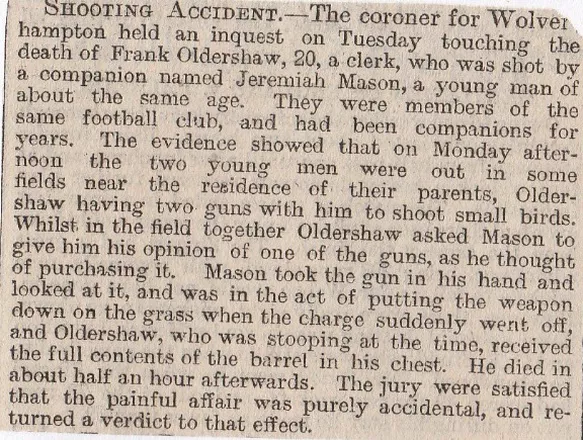
106/ Ladywood Road, Birmingham, August 1872 (Decomposed Body)
A decomposed corpse was discovered in Ladywood Road area of Birmingham. A bloke by the name of Thomas Latham lived in Ivy Cottage at the back of number 207, Ladywood Road. He was semi-retired and used to have his own building business and was comfortably well off. His wife died just over a year ago and they were childless, so he was on his own in his twilight years. Friends popped in to see him but hadn’t come across him for a fortnight or so and they were getting a bit worried. He was going away for a few days, so they thought he’d extended his stay and gone somewhere else for a little break. After a period of a week or two, his nephew got really worried about him, so he went to the house and asked neighbours of his whereabouts. They thought he was inside, so they scanned the building to check if all was well. While up a ladder and looking into his bedroom, an object was seen lying on the bed. Police were involved and they broke in and found him upstairs, on the bed in a dreadful state of putrification. It is thought he died from drinking too much.
107/ Handsworth Murder, April 22nd, 1885
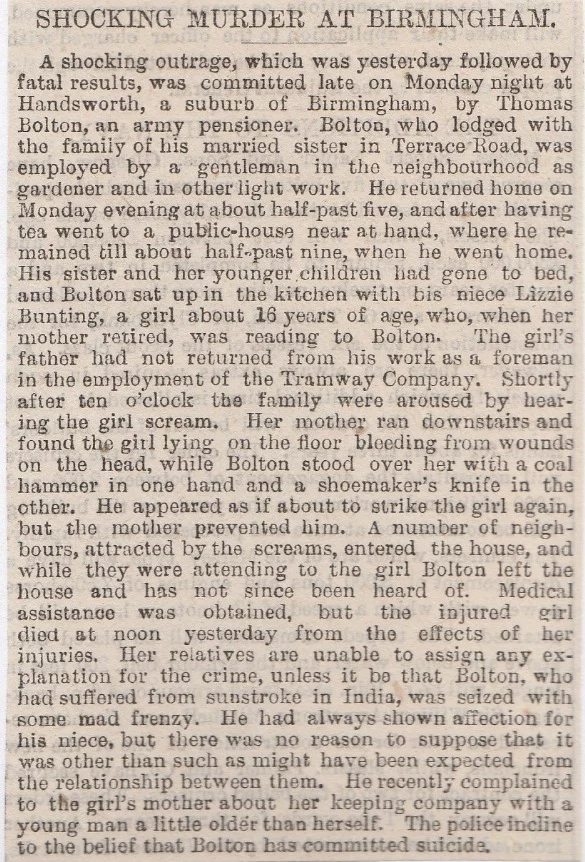
Handsworth Murder, May 2nd, 1885
The murder at Handsworth, Birmingham, by a pensioner named Boulton of his niece, has had a melancholy sequel. The mother of the murdered girl has since become insane. She is continually raving on about the murder and has had to be placed under restraint.
108/ Handsworth Murder, August 1st, 1885

109/ Spread Eagle Inn Deaths, Speed Street, May 1855
An awful accident happened at the Spread Eagle Inn in Speed Street, Birmingham. In the Inn was a concert room which was attended by the poorer members of Birmingham society, when at 9-30 p.m. someone shouted “Fire!”, after a small gas leak had occurred and mass panic ensued. Dozens were clambering to get out, some fell downstairs and others trampled on by people trying to get to the exits and three people died, one of them a policeman. Others went to Hospital and several remain in a critical condition. (How many died?)
110/ Montague Street/Hazeley Street, December 1871 (Human Remains)
Workmen digging a new road between Montague Street and Hazeley Street found three skulls and several other human arm and leg bones. They were all facing the same way and the skulls differ in size from an adult to a slightly smaller one, to the last which is obviously that of a child. The place where they were dug up, is of “new made” ground, which was the earth that was put there by the Ely Company in 1853 or 1854. There is no record of a burial site being there or cemetery, but the coffin handles were left near the bodies, so they were given a decent burial. (Who were they ?)
111/ Navigation Street, Birmingham, March 1877 (Murder/Suicide in Brothel)
This chap comes from a town near where I live, so holds more interest than most for me. His name was John Nicholson from Louth in Lincolnshire (lovely little town, like stepping back in time!), and he was lodging with a young lass called Minnie Fantham who was the wife of an innkeeper. Anyway, Minnie started to show an interest in other blokes in the house and he became viciously jealous. She had a concert trip with two other blokes planned and Nicholson was having none of it. He asked to see her in his room at four o’clock and she went up to see him. Nobody heard anything from her till 8-30 p.m. when the landlady found her on the floor with a huge gash in her throat. He was sat in a chair with his throat also slit from ear to ear. He died in hospital just five minutes after being admitted.
112/ Wednesbury Fatal Accident, January 1885

113/ Birmingham Suicides, May 1893
John Redman a fifty-year-old actor, and at present on tour in Birmingham, killed himself at his lodgings. His fellow lodgers were off on a day-trip. He opted out instead, going up to his room supposedly to have a shave and then off to bed again. He was found with a slashed throat several hours later on. His wife had died a few years ago and he missed her dreadfully, so he took his own life. Apparently, he was a superb singer and a very good actor and was highly thought of by fellow professionals.
On the same day as Redman’s suicide, another took place not a million miles away. It was a servant girl, Ethel Millard, who was accused of improper conduct by her mistress and when told of this she flew into a rage and swallowed some rat poison, dying soon after in great agony.
114/ Sherlock Street Skeleton, Birmingham, October 1889
The skeleton of an infant was found up a chimney at 140, Sherlock Street in Birmingham. John Jackson had been living there for three years and the rooms in the top of the house were unoccupied and the chimney bunged up with paper. Miss Jackson was clearing it out when a child’s skeleton dropped down, and when police got in contact with the previous tenant, they denied any knowledge about it. It was believed to have been secreted up there by a servant girl who was employed at the property at some point. It is thought to be that many years ago since the child was put up there. The chance of anyone accounting for the dreadful crime is minimal.
115/ Birmingham Library Suicide, August 1878
Tradesman H.Hill committed suicide in the Birmingham Library by swallowing some poison. His brother said he had been suffering from depression recently and he left a couple of notes to explain his reasons for his suicide:-
“My poor dear Wife- In spite of all your good and noble efforts to drive me from this terrible, mad, mad despondency, I cannot resist it. Good God have mercy on you.”-On the back, he wrote “Look in my desk for letters -H.Hill”. The desk was searched and the following letter was discovered.
“Birmingham 1878- Dear Stone- For the love of all you hold dear, I pray of you to give the enclosed note to Mr W.Wills, Coach and Horses, Bell Street, and of Moseley; do not fail. My poor dear Wife! Protect and guide her for her good as much as you possibly can. Do this for her-the best, truest, and most worthy of wives man ever had. I am mad; have been in a state of suppressed madness on and off ever since I have been out of business, some inexplicable, some irresistible power seems to have been always forcing me to the wrong course since that fatal mistake. Dear old friend, forgive this trouble I put upon you; forget the wretched madman that cannot resist this horrid desire to die. God have mercy on my soul! God guide and protect my poor unfortunate wife-H.Hill”. (Why in the public library?)
116/ Hampton Road, Handsworth, August 1896
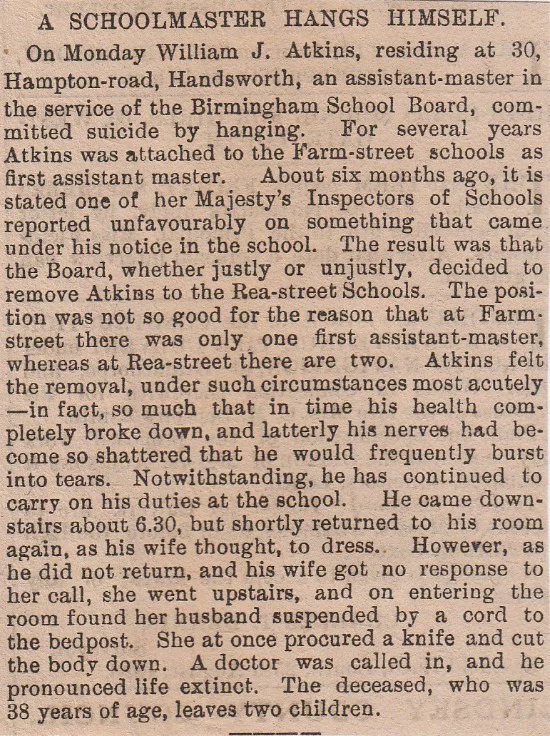
117/ Cambridge Street, Birmingham, August 1898 (Suicide by Circular Saw)
Forty-three-year-old William Davis had a workshop in Cambridge Street in Birmingham. In the workshop was a circular saw and according to the testimony of a lad who worked there, named Diach, Davis simply walked up to the saw and plopped his head in front of it and let the saw do its best against human skin and bone. The lad, who is only twelve and must be traumatised by that sight, told John Kempson what had happened. He rushed across to get Davis from the saw and he managed to a certain extent, but ultimately Davis won the battle and went back for some more of the same. His throat was slashed across and his arm nearly cut in two, as well as a torrent of blood everywhere. Not surprising that he died from injuries sustained.
118/ Minerva Iron & Steel Works, Wolverhampton, May 1875
Samuel Herrard had worked at the Minerva Iron and Steel works in Wolverhampton for fifteen years and had been drinking like a fish over Whitsuntide. One night he woke up, went to the steelworks and threw himself in a water cistern in which the steel is tempered. His son found the body in three feet of water at five a.m. He left a wife and seven kids.
119/ Northbrook Street, Birmingham, March 1898
A young lad named William Pickard was walking along Northbrook Street, which runs parallel to the Birmingham and Wolverhampton Canal, when he spotted what he thought to be a dead pig floating on top. It turned out to be a badly decomposed body of a man with a rope around its neck. When the rope was tugged, it snapped and it sank along with bricks that were attached to it. The body was in a state of putrification, flesh fell off the face and other portions eaten by the water-dwellers. He had a brown tweed suit on, oxford shirt, grey socks, and lace-up boots. As yet he remained unidentified.
120/ Wolverhampton Wife Murder, November 1885

121/ Tame Valley Canal, Perry Barr, June 1887
Marion Lilly Whatton aged eighteen committed suicide at the Tame Valley Canal at Perry Barr in Birmingham.The reason, was that she had been told that her boyfriend was out with another lass. She asked her Mum for some note paper and then she walked out of the door. She was spotted near the canal at Perry Barr, with her hat was found there on Monday morning by a copper walking his beat. The note was pinned to her jacket, also found nearby and it asked that the finder give her mother the note, with her address printed on it. It was short and sweet to say the least, and it said:-
“I leave this note letting you know where I am, I have drowned myself. Give my love to -, goodbye and God bless you.”
122/ Tame Valley Canal Double Suicide, Witton, September 1886
This is quite a romantic story if ever there was one, but it ends in a double suicide of two young girls. Various items of women’s clothing were found on the bank of the Tame Valley Canal at Witton. When the canal was dragged the bodies of two young girls were fished out, both tied together with a silk scarf around their waists. They were Hannah McDonald and Bertha Taylor, both sixteen-years-old who both lived at Aston, and had been missing for two days. A note read:-
“Goodbye, Mrs McDonald forever”. They had both been fired from their jobs at Kynocks and Co’s Ammunition works due to business being slow, but they couldn’t find a job elsewhere. McDonald’s parents had taken care of her, but Taylor was rather skinny and was suffering from lack of nutrition and it’s this that they are thought to have come up with the suicide pact rather than leave one another.
123/ Birmingham Wife Murder, August 1890
At Birmingham Assizes on Wednesday, Frederick Davis a gunsmith of Summer Lane in Birmingham was found guilty of murdering his wife. The prisoner having been reproached by his wife for intemperate habits, shot at her with a gun as she was standing in the kitchen. The bullet pierced her lung and on running into the yard she fell down dead. Justice Hawkins passed the sentence of death upon Davis.
124/ Shirley Shooting Accident, September 1885
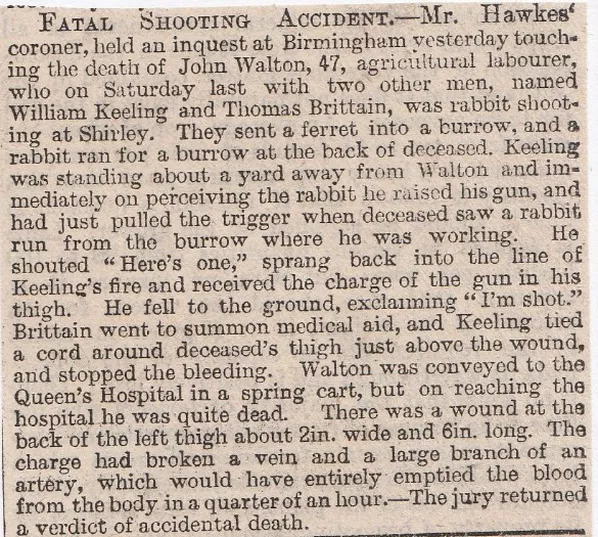
125/ Bilston, (Case of Starvation) June 1887
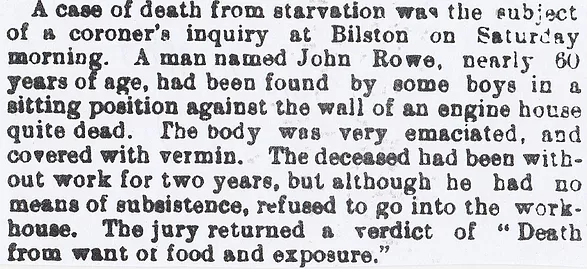
126/ Queens Hotel, (Detective Suicide), Birmingham, April 1883

127/ Edgbaston Street Murder, Birmingham. July 1870
128/ Oldswinford Brewing Tragedy, September 1870
A publican named John William Yardley, residing at Oldswinford near Stourbridge, met with a shocking accident on Monday. Brewing was going on, and Yardley stepped on a stool with a bag of malt on his shoulder, intending to empty it into the mash tub. The stool slipped, and he fell backwards into the scalding wort. Though immediately rescued he was so frightfully injured that he died the same evening.
129/ Stourbridge (Strange Story) July 1870
130/ Bilston, (Man Boiled to Death) September 1870.
131/ Explosion at Birmingham, December 13th, 1870
132/ Fatality at the Birmingham Riot, January 1902 (Manslaughter by a Constable)
Warwickshire
1/ Coleshill Suicide, June 1865
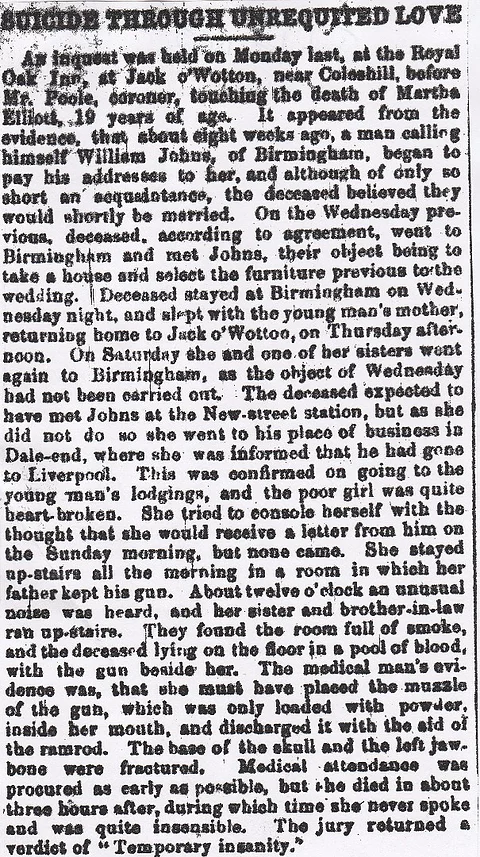
2/ Coton Church Death, December 1882
A peculiarly distressing case of sudden death occurred at Coton in Warwickshire. The Rev.G.R.Pennington, the vicar of the parish, had just finished a more than usually impressive sermon when he sat down and expired. His wife, who was present at the service, witnessed his death and was first to reach the pulpit after the sad event. Deceased had suffered from heart disease.
3/ Kenilworth Murder/Suicide, December 1872
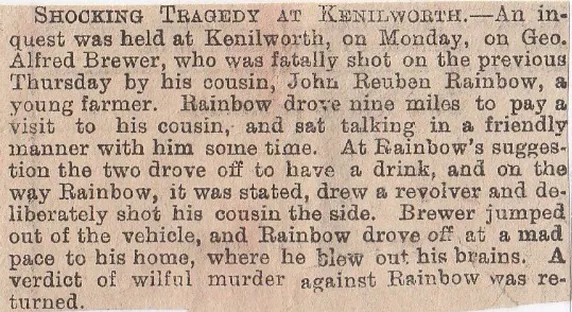
4/ Mill Bath, Leamington, February 1895

5/ Leamington, Warwickshire, January 1890
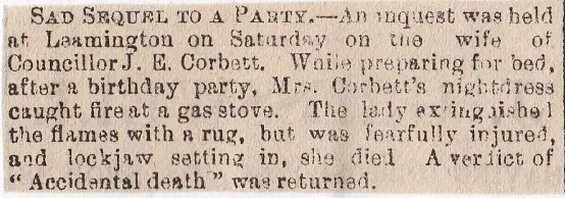
6/ Chilvers Coton, Nuneaton, May 1855 (Suicide on Wife’s Grave)
William Moore of Attleborough, known as the “Smoking Butcher”, was found on his wife’s grave in Chilvers Coton church-yard with terrible self-inflicted razor cuts. He did it in full view of the public, so much so, that he was stopped by civilians from doing any further damage. Moore was carted off to the workhouse and had his wound sewn up. (Did he survive?)
7/ Whiteacre Station, Coleshill, February 1861
This really is stomach-churning in its deliberation and calmness of the suicide. It was at Whiteacre Station, Coleshill, and a chap called Cotterill, about twenty-seven, saw the train coming into the station, he laid himself full length on the rails and let it ride over his body. There were witnesses and they observed the head of the deceased fly off when he was struck. It ended up twelve yards away, showing the force with which he was hit. Obviously, he didn’t survive.
8/ River Cole, Coleshill, May 1882 (Drownings)
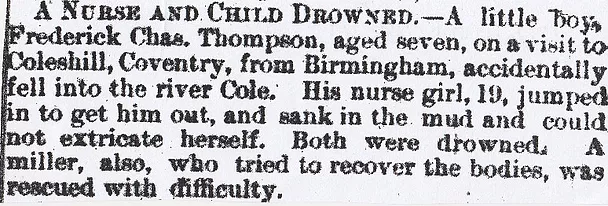
9/ Warwick Murder, December 1875
At Warwick Assizes, James Haywood, a labourer, was charged with the murder of seventy-year-old Hannah Tenant. Prisoner confessed to the crime and said that Tenant was a witch and had given him the evil eye and caused him to become ill. He was acquitted on the grounds of insanity and ordered to be confined at Her Majesty’s pleasure.
10/ Leamington Servant Shooting, March 1871
Mr Thomas Umberts of Weston Hall near Leamington has accidentally shot his female servant. (Weston Hall still there?)
11/ Warwick Suicide, January 1889
The suicide of a school-girl has caused quite a stir in the town of Warwick, where she attended the Girls High School. Elizabeth Chandler was the daughter of a Leamington jeweller. She left school on Friday but never went home, so her father went looking for the 12-year-old. He saw two men with her dead body in a wheelbarrow, they had fished her body out of the canal when he found her clothing on the bank. Elizabeth also left a note on her desk telling her Mum she was going to die. It stemmed from the deceased getting some stationary in another girl’s name and she feared the consequences so she stripped off and dived into the canal.
12/ Foleshill (Attempted Murder) April 1885
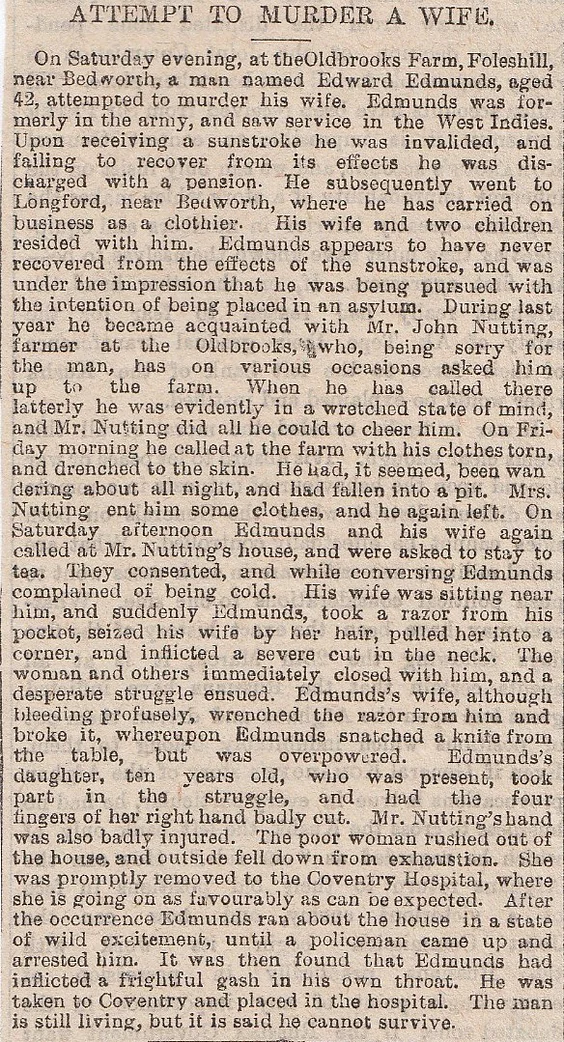
13/ Rugby, May 1873 (Human Head Found)
The Irish mail arrived from London at Rugby at 10-25 p.m .on Saturday, when the fireman went to rake out the fire-box and recoiled in horror when he saw a human head inside. It was fairly recognisable but had singe marks on it. Mr Livock, the station-master, instigated a search further up the line. A mile and a half back, at Willesden Junction, was the trunk. It is believed it was the remains of a gentleman who was returning from a cricket match. The head has yet to be identified and was sent to Willesden. (Who was it?)
14/ Leamington (Concealment of Birth) January 1901
A young girl named Ellen Cartwright, a domestic servant at Leamington was arrested at Shifnal (Shropshire), by Det.Sergeant Ryder and brought back to Leamington. This was down to information police gleaned from a search of a garden at a house that she was working at. The remains of an infant were discovered and she is the prime suspect in the concealment of the birth.
15/ Nuneaton Station Fatality, March 1899

16/ Bentley near Atherstone, March 1910 (Murder/Suicide)
Sixteen-year-old Edward Mitchell from Preston Bagot, used to work for William Lane, a 79-year-old farmer from Bentley. He was accused of being cruel to his cattle and words were exchanged which ended with the threat from Mitchell that he would “get his own back”. Mr Lane was sat reading a paper by the fire with his wife then Mitchell shot him through the window, then ran off and blew his own brains out in a stable near the house.
17/ Rugby Suicide, February 1858
Mary Over was an elderly married woman, who committed suicide by hanging herself at Rugby. She was reminiscing about her days when she was a matron at Rugby School and missed her “Tom Brown’s Schooldays”. She had become sullen and depressed as she hankered for the old days and the jury agreed with medical evidence stating that “Deceased destroyed herself while in a depressed state of mind arising from monomania”. ( Monomania- An exaggerated or obsessive enthusiasm for one thing)
18/ Leamington, March 1860
Mrs Mary Ann Dale, formerly of Dorset Square, London, went to visit a cousin in Leamington, at Mrs Wood’s, Upper Parade. One morning she was seen by Dr Morgan and had breakfast and all seemed well. What the Doctor didn’t know was that she had got all the love letters and keepsakes from her husband, and torched them all. Then she climbed up to the top floor of the building and jumped out of a window, and landed the thirty-five feet onto the ground below. The pavement outside is one of the busiest in Leamington and quite a crowd witnessed the suicide of Mrs Dale.
19/ Warwick Murder, July 1885 (Murder committed in a pub in 1880 in Warwick)

20/ Brook Street Murders? Warwick, November 1896
This is an awful tale of two elderly women who ended up dead in a house in Warwick. Miss Hannah Clarke, an 80-year-old and Mrs Smith, by comparison, a sprightly seventy years old, were both found dead at their home in Brook Street. A relative of their’s couldn’t get an answer and when looking through the window, saw them lying there. There were signs of struggle with furniture overturned and broken crockery everywhere. The pair were used to arguing and a neighbour had heard screams but did nothing about it. On searching upstairs the police discovered a pair of fire-tongs, and Mrs Smith’s nightcap drenched in blood. One theory is that Clarke attacked her sister and killed her, then killed herself as she was prone to sudden fits of anger and liked a tipple as well.
21/ Leamington, October 1872
John Hart, a builder, killed himself in an unusual manner at Leamington. Firstly he cut his jugular vein then tied a cord around his neck and then twisted it, forming a tourniquet. Hart had a paralytic seizure (stroke?) about five years ago, and since then he had been badly balanced. The doctor said that without the cut to his neck he would just have passed out but the loss of blood as well, all contributed to his death.
22/ Warwick, August 1907 (Mother Cuts Throats of Three Children)
Alfred Southam, a tailor from Warwick, stuck up for his wife when she was accused of attempted murder of a child in 1904. She was acquitted. Three years later, she was caught attempting to murder three kids by slitting their throats in a passage upstairs. The youngest was killed outright, the second, a girl of three and a half years, was terribly gashed and may recover and the other girl, five years old, was attacked frantically by the mother and has several cuts to her face. Neighbours ran around when they heard the kiddies screaming and were met with the mad housewife with a carving knife in her hand, begging for someone to kill her. The little one that was killed was only two months old and it is widely known that she is of weak intellect.
23/ Warwick County Asylum (Kidnap Attempt) June 1885
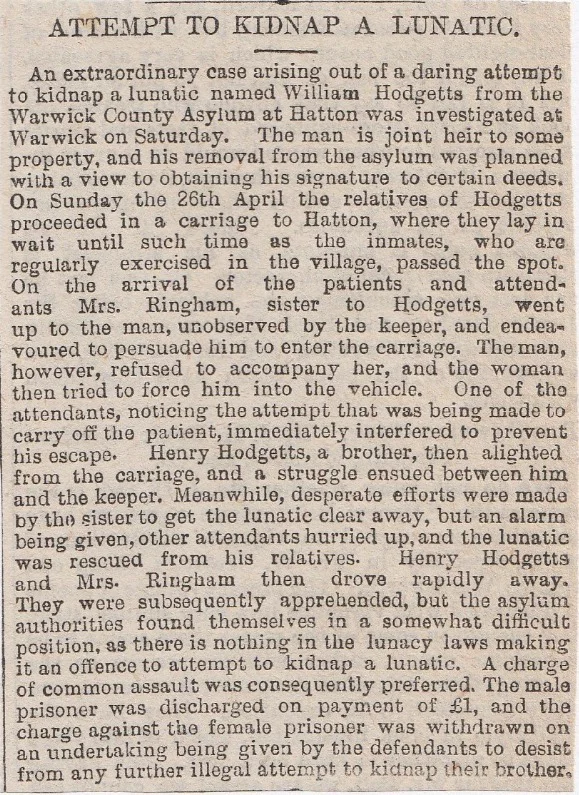
24/ Clifton near Rugby, September 1889
This is the story of G.F.Woodward aged thirty, a Worcester commercial traveller who committed suicide at Clifton near Rugby. About four month’s ago Woodward’s wife found a love letter in his pocket from a young lass from Cardiff. She put pen to paper and wrote and told her that the man she proclaimed to love, was indeed a married man with four kids and asked the young woman to send her any letter’s he had sent. The lass from Cardiff didn’t send them but wrote back to her saying that she would not see him anymore and to accept her apologies. The husband returns home one weekend and there was a huge row and they decided on a trial separation. What makes the matter worse was that Mrs Woodward was pregnant at the time and as a result of all this, she lost the child. Amazingly they got back together again and there was bad blood between the two. His mind seemed very unstable to those around him. Woodward left one day and put a pistol to his head and fired. His wife and children were left unprovided for.
25/ Stratford-on-Avon Double Murder/Suicide, August 1889
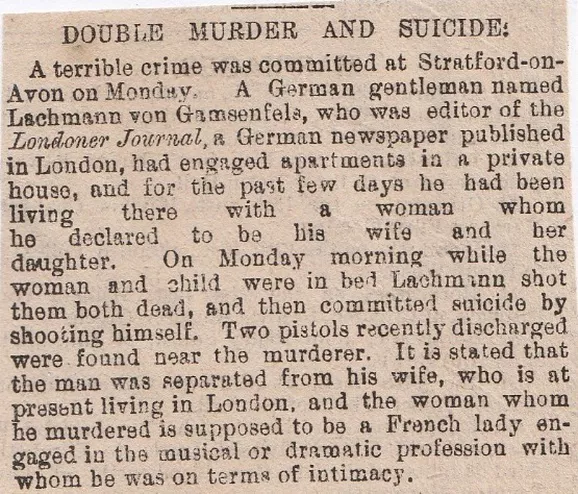
26/ Warwick, December 1896
Dr George Wilson, the Medical Officer of Health for Mid-Warwickshire went off to London for a little break and left his housekeeper, Mary Hawkes, in charge of the house. While in London Wilson asked his housekeeper to forward the mail to him, but none arrived and neighbours hadn’t seen her for a while, so police were called in to investigate. Her decomposed remains lay on one of the beds with twenty empty bottles of port next to her and a bottle of poison. The coroner stated she had been dead for a week and was not known to be a big drinker or of suicidal tendencies.
27/ Warwick Racecourse Suicide, September 1870
28/ Triple Murder at Baddesley Ensor, December 1902.
29/ Death on Warwick Castle Grounds, July 1903.
30/ Edghill Car Crash, August 1903. (On the Oxfordshire border)
31/ Murder at Compton Verney, Kineton. November 11th, 1903. (Compton Verney, 18th Century mansion near Kineton. Now houses an art gallery)
Murder at Compton Verney, December 9th, 1903. (The Verdict)
32/ Mother Slit Throats of Three Children, Warwick. August 1907
33/ Matricide at Leamington ( Burned to Death) March 1907.
